AUCTION





December
2022 www.TheSwissAuctioneers.swiss
CLASSIC CAR
in the Festival Tent Thursday December 29th 2022 Viewing
28th & 29th
Always about 100 classic cars and motorcycles from various makes and periods.
5 minutes from Berne Airport.
Open Monday to Sunday 10:00am to 6:00pm Closed on first Weekend each month!
Classic Car Auction December 29th 2022, Gstaad

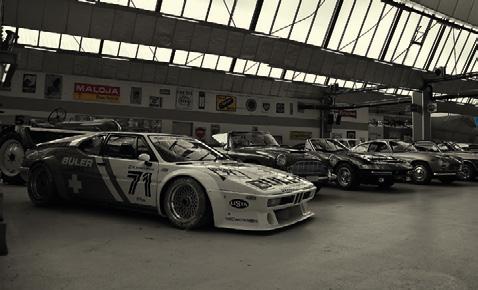
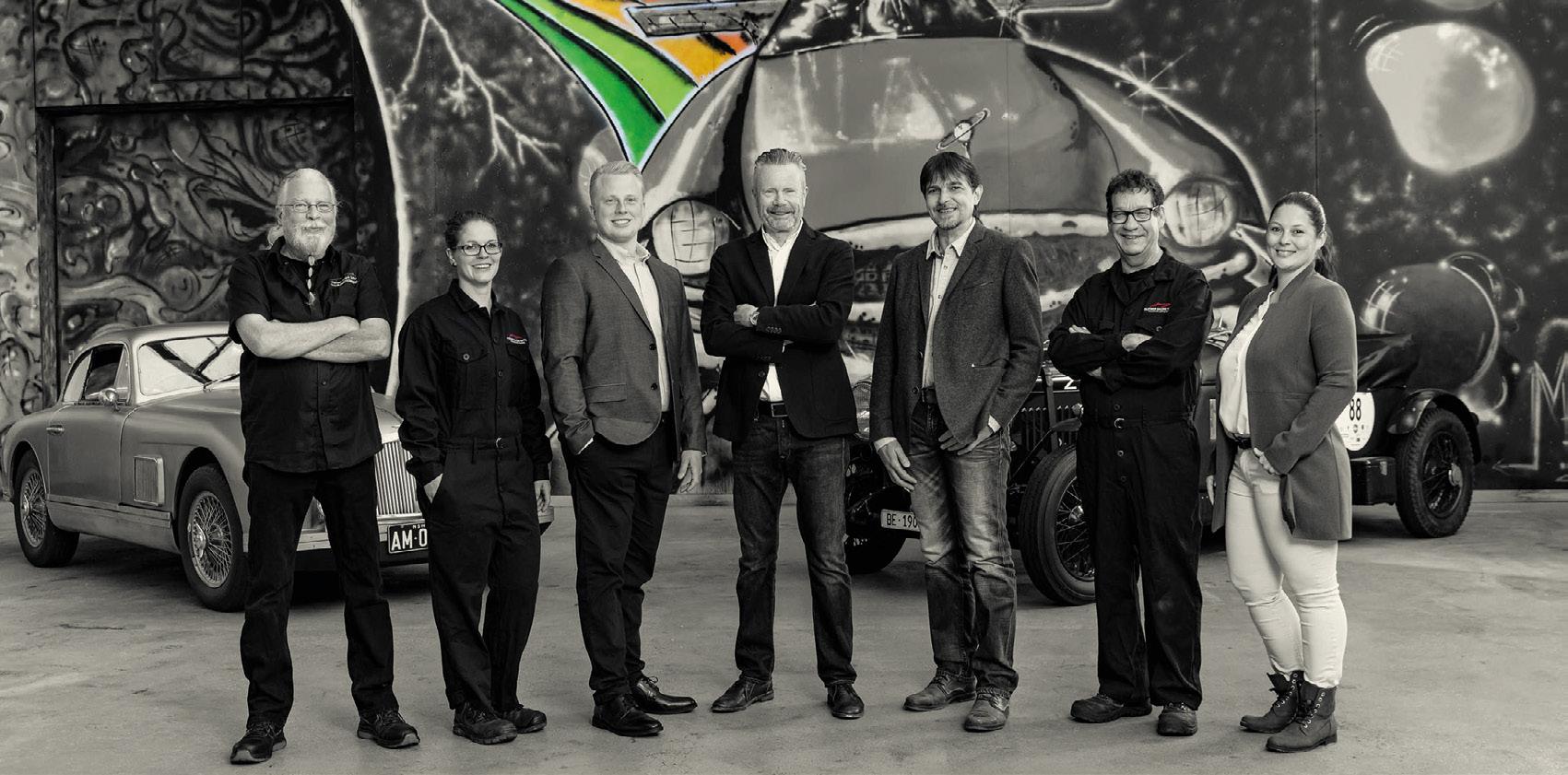
Further Auctions: March 25th 2023, Toffen June 3rd 2023, Swiss Classic World Lucerne October 14th 2023, Toffen December 29th 2023, Gstaad
Consignments and catalogue orders are possible at any time!
Seasonal à la

menu – also with thai food. Aperitifs, family celebrations, club excursions and events up to 400 people in the exhibition rooms.
Large parking lot, 120 seats, terrace. Phone +41 (0)31 819 99 90 mail@restaurant-event.ch www.restaurant-event.ch
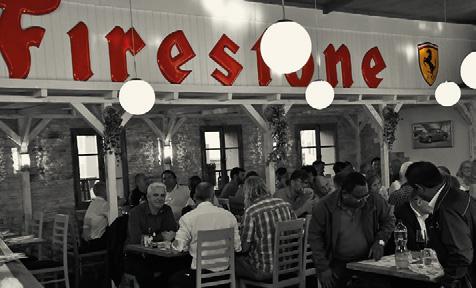
carte
SALES EXHIBITION RESTAURANT AUCTIONS OLDTIMER GALERIE INTERNATIONAL GMBH Gürbestrasse 1 | CH-3125 Toffen Phone +41 (0)31 819 61 61 info@oldtimergalerie.ch www.TheSwissAuctioneers.swiss Passion
1984
since
CLASSIC CAR AUCTION in Gstaad
Thursday December 29th 2022 | 4:00pm
Viewing:
In the Festival tent of the Sportzentrum in Gstaad
Wednesday December 28th 10:00am - 7:00pm Thursday December 29th 10:00am - 4:00pm
The vehicle descriptions are based on the owners indications!
Additional pictures, complements as well as late entries you will find on www.TheSwissAuctioneers.swiss
Ask to see the vehicle documents!
Auction day schedule:
Viewing from 10:00am
Auction
Automobilia & Collectibles Lot 1 - 26 4:00pm Classic Cars Lot 101 - 148 5:00pm
Auction day access:
Catalogue including admission for one CHF/EUR 40.00 Single entry CHF/EUR 20.00
Catalogue payment: Valiant Bank , CH-3001 Bern Swift: VABECH22 IBAN: CH31 0630 0016 6018 2620 8

Oldtimer Galerie International GmbH, Gürbestrasse 1, CH-3125 Toffen
Terms and conditions of auction:
Any participation in our auction is the recognition and unconditional acceptance of the present Terms & Conditions as printed on page 97 of the catalogue and shown on www.TheSwissAuctioneers.swiss.
To all bidders:
· Your bidders paddle is ready at our front desk - for registration you need a valid ID and a credit card
· Telephone bids are taken by the following numbers: +41 (0)31 8196161, +41 (0)79 4060141 and +41 (0)79 7447865.
· Written bids are accepted with complete filled in form (page 100 in the catalogue) until December 28th 2022 at 8:00pm at the Oldtimer Galerie in Toffen - best sent by e-mail to info@oldtimergalerie.ch
· Online bidding is possible on invaluable.com and swissauctioncompany.com, please register in time on the relevant site!
Viewing and auction:
Festival tent of the Sportzentrum Gstaad
Sportzentrumstrasse 5 | CH-3780 Gstaad
Host: Oldtimer Galerie International GmbH Guerbestrasse 1 | CH-3125 Toffen Phone +41 (0)31 8196161 | Fax +41 (0)31 8193747 info@oldtimergalerie.ch | www.TheSwissAuctioneers.swiss
1
CLASSIC CAR AUCTION in Gstaad
Donnerstag 29.Dezember 2022 | 16.00 Uhr
Vorbesichtigung:
Im Festivalzelt des Sportzentrums in Gstaad
Mittwoch 28. Dezember 10.00 - 19.00 Uhr Donnerstag 29. Dezember 10.00 - 16.00 Uhr
Die Fahrzeugbeschriebe erfolgen gemäss Besitzerangaben!
Weitere Bilder, Ergänzungen und nach Katalogschluss gemeldete Fahrzeuge finden Sie auf www.TheSwissAuctioneers.swiss
Verlangen Sie Einsicht in die Fahrzeugunterlagen !
Ablauf am Auktionstag:
Besichtigung ab 10.00 Uhr
Auktionsbeginn
Automobilia & Sammlerstücke Lot 1 - 26 16.00 Uhr Automobile Lot 101 - 148 17.00 Uhr
Zutritt am Auktionstag:
Katalog inklusive Eintritt für eine Person CHF/EUR 40.00 Nur Eintritt CHF/EUR 20.00
Bezahlung des Auktionskataloges:
Valiant Bank , CH-3001 Bern
Swift: VABECH22
IBAN: CH31 0630 0016 6018 2620 8
Oldtimer Galerie International GmbH, Gürbestrasse 1, CH-3125 Toffen
Auktionsbedingungen:
Die Teilnahme an der Auktion erfolgt mit Anerkennung und vorbehaltsloser Annahme der Auktionsbedingungen welche auf Seite 98 des Kataloges oder auf www.TheSwissAuctioneers.swiss nachgelesen werden können.
An alle Bieter:
· Ihre Bieterkarte liegt für Sie bei uns bereit – für die Registrierung benötigen Sie einen gültigen Ausweis sowie eine Kreditkarte.
· Telefonische Gebote werden unter den Nummern +41 (0)31 8196161, +41 (0)79 4060141 und +41 (0)79 7447865 entgegen genommen.
· Schriftliche Gebote sind bis spätestens 28. Dezember 2022, 20.00 Uhr mit dem Kaufauftrag auf Seite 100 des Kataloges bei der Oldtimer Galerie in Toffen - idealerweise per E-Mail an info@oldtimergalerie.ch - einzureichen.
· Online mitbieten ist auf invaluable.com und swissauctioncompany.com möglich, bitte registrieren Sie sich rechtzeitig auf der entsprechenden Seite!
Vorbesichtigung und Auktion:
Festivalzelt des Sportzentrum Gstaad Sportzentrumstrasse 5 | CH-3780 Gstaad
Veranstalter: Oldtimer Galerie International GmbH Gürbestrasse 1 | CH-3125 Toffen Tel. +41 (0)31 8196161 | Fax +41 (0)31 8193747 info@oldtimergalerie.ch | www.TheSwissAuctioneers.swiss
2
www.TheSwissAuctioneers.swiss
CLASSIC CAR AUCTION à Gstaad
Jeudi 29 décembre 2022 | 16 h 00
Visite préliminaire:
Au Tente Festival du Sportzentrum à Gstaad
Mercredi 28 décembre 10 h 00 - 19 h 00 Jeudi 29 décembre 10 h 00 - 16 h 00
Les déscriptions des véhicules resultent des informations des propriétaires!
Plus de photos, compléments ainsi que les véhicules inscrits après la clôture du catalogue vous trouvez sur www.TheSwissAuctioneers.swiss
Prenez connaissance des dossiers des véhicules!
Déroulement du jour de la vente:
Visite préliminaire dès 10 h 00 Vente aux enchères Automobilia & pièces de collection Lot 1 - 26 16 h 00 Voitures Lot 101 - 148 17 h 00
Entrée le jour de la vente: Catalogue avec l‘entrée pour une personne inclus CHF/EUR 40.00 Entrée seulement CHF/EUR 20.00
Versement pour le catalogue:
Valiant Bank , CH-3001 Bern
Swift: VABECH22
IBAN: CH31 0630 0016 6018 2620 8
Oldtimer Galerie International GmbH, Gürbestrasse 1, CH-3125 Toffen
Conditions des ventes aux enchères:
La participation à la vente aux enchères implique l‘acceptation inconditionnelle des conditions de vente qui se trouvent à la page 99 du catalogue ou sur www.TheSwissAuctioneers.swiss.
Pour tous les enchérisseurs:
· Votre carte d‘enregistrement sera prête chez nous - vous avez besoin d‘une pièce d‘identité valide et d‘une carte de crédit.
· Les offres téléphoniques sont prises en considération aux numéros: +41 (0)31 8196161, +41 (0)79 4060141 et +41 (0)79 7447865.

· Les offres écrites doivent parvenir - de préférence par e-mail à info@oldtimergalerie.ch - à l‘Oldtimer Galerie à Toffen jusqu‘au 28 décembre 2022 à 20 h 00 avec l‘ordre d‘achat à la page 100 du catalogue.
· Enchérir en ligne est possible sur invaluable.com et swissauctioncompany.com, veuillez vous inscrire à temps sur la site correspondante!
Visite préliminaire et vente aux enchères:
Tente Festival du Sportzentrum Gstaad Sportzentrumstrasse 5 | CH-3780 Gstaad
Organisateur:
Oldtimer Galerie International GmbH Guerbestrasse 1 | CH-3125 Toffen Tél. +41 (0)31 8196161 | Fax +41 (0)31 8193747 info@oldtimergalerie.ch | www.TheSwissAuctioneers.swiss
3
Ermässigter Einfuhrtarif für historische Fahrzeuge welche 30 Jahre oder älter sind:
7% Einfuhrumsatzsteuer, kein Zoll
9% BTW, geen invoerheffing
13% Einfuhrumsatzsteuer, kein Zoll Zertifikat eines Fachbetriebes nötig um die Originalität des Fahrzeuges zu bestätigen
Réduction de tarif à l’importation pour les véhicules historiques de plus de 30 ans:
5.5% TVA, pas de droit de douane
Reduced import taxes for historic vehicles containing 30 years or more:
5% VAT, no duty
Import taxes for cars:
Duty – 2.5% based on the invoice value of the car Merchandise Processing Fee – 0.3464% based on the invoice value of the car ($485.00 max) Harbor Maintenance Fee – 0.125% based on the invoice value of the car
Customs Bond – 0.4% based on 3 x times the value of the car, plus the duty amount and users’ fees
Note: if the invoice value is more than $66,000.00 we recommend buying an annual bond with US Customs for $800.00. It will cover this import and any import, of any commodity, that the client has over the next 12 months.

Actual situation - provided by:
Full Importation services to Switzerland. Exporting vehicles from Switzerland or other countries. National and international shipping of vehicles.


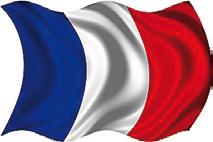
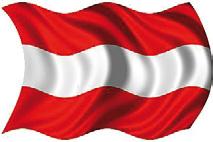

Due to ongoing changes by the authorities, no responsibility is taken for the correctness of the information above!

4 www.TheSwissAuctioneers.swiss
! WICHTIG / IMPORTANT / IMPORTANTE !
Year Make & Type Body Lot
1951 Alfa Romeo 1900 Berlina Abarth Sedan 127
1971 Aston Martin DBS V8 Convertible by Banham Convertible 122 1984 Aston Martin Lagonda Saloon 146 1996 Aston Martin Vantage V550 Coupé 144 1994 Audi-Porsche RS2 Avant Break 145 2001 Bentley Continental R Le Mans Coupé 130 1996 Bentley Continental T Coupé 107 1961 Bentley S2 Continental Drophead Coupe Convertible 139 1939 BMW 327 Sportkabriolett Convertible 123 1957 BMW R26 Motorcycle 114
1956 Cadillac Series 62 Sedan de Ville Sedan 109 1962 Chevrolet Corvette C1 Fuel Injection Convertible 128 1966 Chevrolet Corvette C2 427 Sting Ray Convertible Convertible 131 1986 Citroën 2 CV 6 «I fly bleifrei» Sedan 101 1957 Facel Vega FV3 Coupé 111 1982 Ferrari 308 GTBi Coupé 102 1964 Ferrari 330 GT 2+2 Series 1 Coupe 2+2 118 1969 Ferrari 365 GT 2+2 Coupe 2+2 124 1987 Ferrari 412 Coupé 2+2 110 2008 Ferrari 430 Scuderia Coupé 121 1991 Ferrari Testarossa Coupé 126 1992 Fiat Panda 4x4 Trekking Sedan 104 1957 Ford Thunderbird Convertible 117
2015 Harley-Davidson FXDL 1690 Dyna Low Rider Motorcycle 113 1992 Honda NSX 3.0i 24V Coupé 143 1969 Jaguar E-Type 4.2-Litre Series 2 Roadster Roadster 119 1973 Jaguar E-Type V12 Roadster Roadster 141 1989 Jaguar Sovereign 4.0i Saloon 106 1938 Jaguar SS 100 2 1/2-Litre Roadster Roadster 137 1953 Jaguar XK 120 SE Drop Head Coupe Convertible 108 1987 Lamborghini Countach LP5000 Quattrovalvole Coupé 138 1996 Lamborghini Diablo VT Coupe 129 1961 Lancia Flaminia 2500 GT Touring Coupé 133 2006 Land Rover Defender Td5 SoftTop Off-Road 105 1971 Maserati Ghibli 4700 Coupé 135 2020 Mercedes AMG G63 SUV 142 1950 Norton Manx 500 Motorcycle 115 1989 Porsche 911 (930) Turbo Cabriolet Convertible 125 2016 Porsche 911 (991) GT3 RS Coupé 120 1975 Porsche 911 2.7 Coupé 103 1970 Porsche 911 T 2.2 Coupé 116 1988 Rolls-Royce Corniche II Convertible Convertible 147 2009 Rolls-Royce Phantom Coupé Coupé 140 2007 Rolls-Royce Phantom Drophead Coupe Convertible 134 1963 Rolls-Royce Silver Cloud III Drophead Conversion Convertible 136 1939 Talbot-Lago T 150 C Competition Racecar 148 1963 Volvo P1800 Aston Martin DP208 Coupé 132 1979 VW Käfer 1303 Cabriolet Convertible 112
Changements and supplements possible! Änderungen und Nachträge möglich!
Changements et suppléments possibles!

5
INDEX
Confection since 1948
Zwahlen-Hüni
Dorfstrasse 50/52 · Saanen
Zwahlen-Hüni · Cigares & Tobacco / Le Trésor Promenade 65 · Gstaad
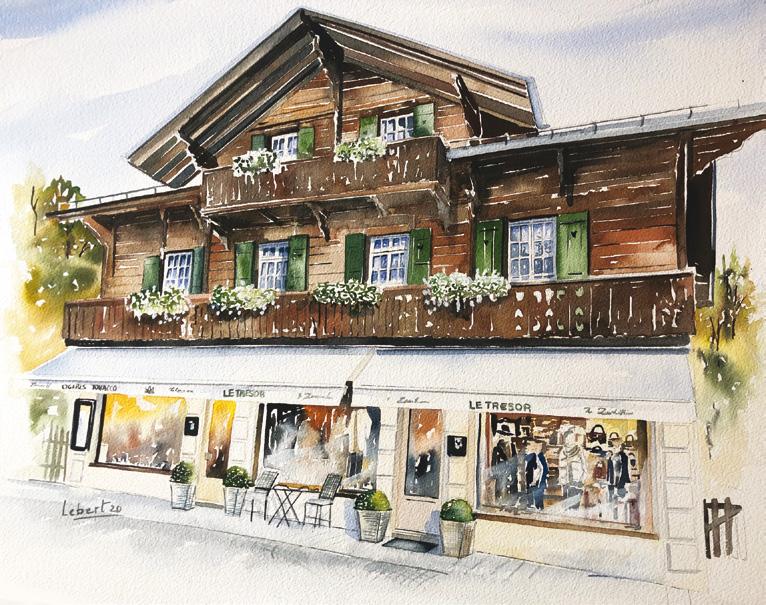
www.zwahlenhueni.ch | info@zwahlenhueni.ch

6 www.TheSwissAuctioneers.swiss
Lot 1: 1957 Mercedes-Benz 300 SL Roadster
CHF 950 - 1‘200
Highly detailed 1:12 scale model of a 1957 Mercedes-Benz 300 SL Roadster, limited edition # 046/999, built by GTS-Models, sold out by factory, including showcase.
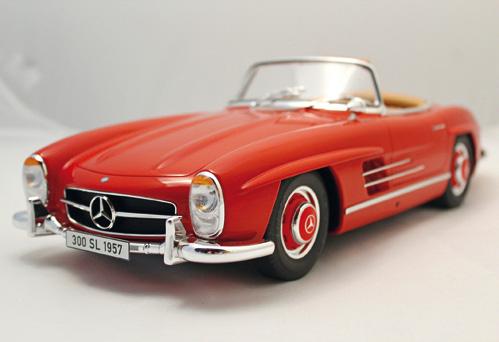
Lot 2: 1932 Duesenberg Model SJ Tourster Derham
CHF 1‘500 - 1‘800
Highly detailed 1:12 scale model of a 1932 Duesenberg Model SJ Tourster Derham in yellow/black, unique edition, built by PremiumClassiXXs, sold out by factory, including showcase.
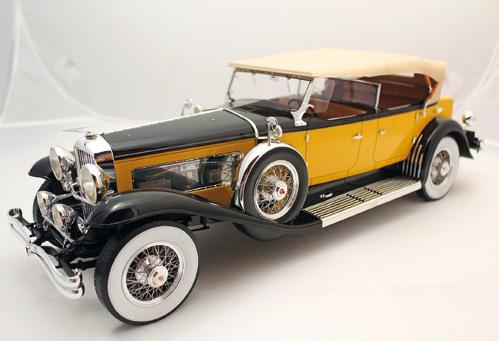
Lot 3: 1984 Ferrari Testarossa
CHF 1‘200 - 1‘400
Highly detailed 1:8 scale model of a 1984 Ferrari Testarossa by Pocher, with leather interior, the dashboard with visible stitching, sold out by factory.

Lot 4: 1985 Rallye Set VW LT / Audi S1, Röhrl/Geistörfer CHF 850 - 1‘150

Highly detailed and famous 1:18 scale model rallye set (3 pieces), VW LT + Audi S1 + trailer, Rallye Portugal 1985 HB Röhrl/Geistörfer, limited edition, built by OTTO-Mobile, sold out by factory.
Lot 6: Rolls-Royce Ghost Radiator Grille
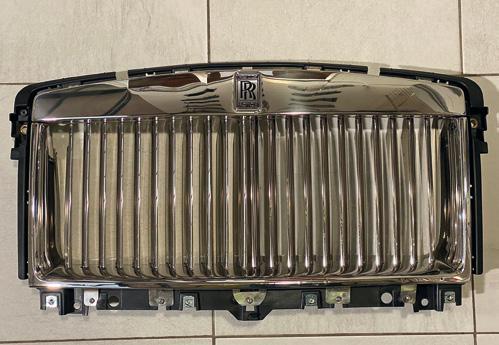
Lot 5: 1973 Porsche 911 Carrera RS 2.7
CHF 800 - 1‘200
Highly detailed 1:8 scale model of a 1973 Porsche 911 Carrera RS 2.7, limited edition by DeAgostini, sold out by factory, in very good condition and including showcase.
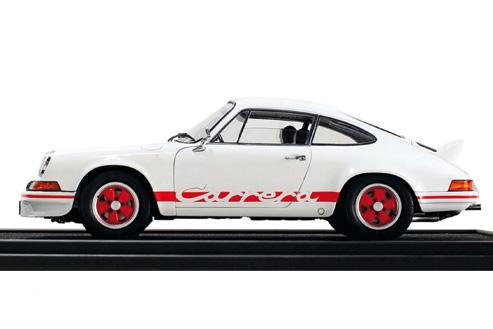
CHF
1‘500 - 2‘500
Original radiator grille of a Rolls-Royce Ghost - model 2009-2020 - with some small dents. The original price for this great wall or garage decoration is CHF 13‘950.- !!!

7
Lot 8: Wooden Bear „Mascha“
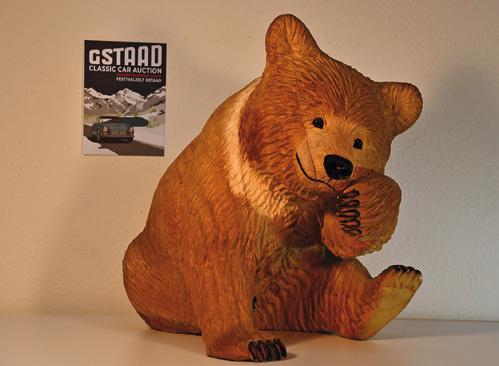
Lot 7: Michael Schumacher Ferrari F1 2000 Wheel
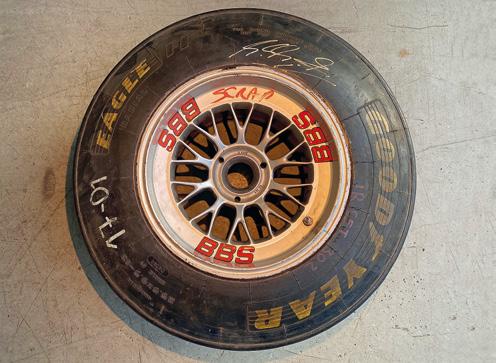
CHF 3‘500 - 4‘500
This original Ferrari F1 2000 wheel with Michael Schumacher‘s signature was a gift for a mechanic of the Ferrari Formula 1 team at the end of the 2000 season - the one with Schumacher‘s first world championship title for the brand. Extremely rare to find and historically significant collector‘s item from the Maranello brand.
CHF
2‘500 - 3‘000
A hand-carved bear with loving details. Made of limewood, approx. 38 cm high, glazed in brown. As each object is made from a single block of wood, it is a unique piece of art!
Lot 9: Ferrari Memorabilia
CHF 800 - 1‘200
A set of Ferrari memorabilia with signed Formula 1 postcards from Michele Alboreto (signed on the back by Enzo Ferrari on 16 June 1985), Stefan Johansson and Gerhard Berger (also signed on the back by Enzo Ferrari, dated 3 November 1987), as well as Enzo Ferrari‘s obituary which was sent to selected friends of the Maranello brand.

Lot
10: Mercedes-Benz Workshop Manuals
CHF 1‘250 - 1‘750
Two original Mercedes-Benz workshop manuals in German. One for the Type 300/Type 300 S vehicles and one for the Type 300 SL - including the supplements of 23 February 1961 and 3 April 1963. Very good condition.
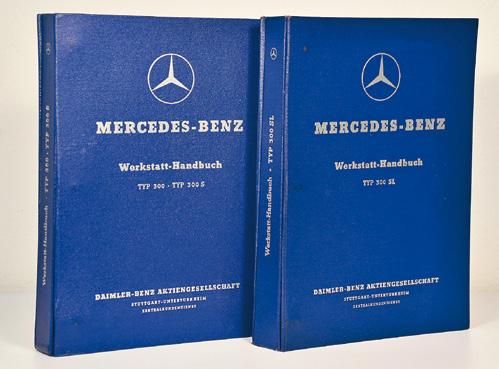
Lot 12: Ferrari 250 SWB Lithograph


Lot 11: Mercedes-Benz brochure folder
CHF 300 - 500
This is a Mercedes-Benz brochure folder with sales brochures of the models 10/40 hp, SS and SSK, 540 K, 260 D, 170 and 300 SL as well as a folding brochure of the Daimler Motoren Gesellschaft Cannstatt. Reprint from 1975 by the printing house Courier in Ingolstadt. Very good condition.
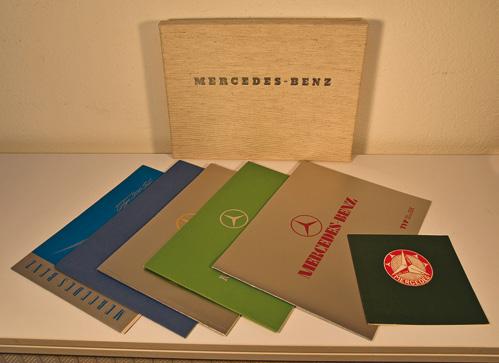
CHF 300 - 500
Lithograph by the Belgian artist Danielle Dessart from the early 80s. Signed, approx. 70 x 50 cm, behind glass and in wooden frame.
8 www.TheSwissAuctioneers.swiss
Lot 14: Ferrari Logo Neon Sign

Lot 13: Mercedes Logo Neon Sign
CHF 2‘000 - 4‘000
An illuminated Mercedes-Benz wall sign with its three pointed star logo in excellent condition. For easy installation and optimum effect, either illuminated or not, the sign, measuring 100 centimetres across, is backed by a colour matched rear panel and works on 220 Volt.

CHF 2‘000 - 4‘000
An illuminated Ferrari wall sign with logo in excellent condition. For easy installation and optimum effect, illuminated or not, the sign, measuring 105x80 centimetres, is backed by a colour matched rear panel and works on 220 Volt.

Lot 16: Porsche Logo Neon Sign

Lot 15: Lamborghini Logo Neon Sign
CHF 2‘000 - 4‘000
An illuminated Lamborghini wall sign with its famous logo in excellent condition. For easy installation and optimum effect, illuminated or not, the sign, measuring 90x80 centimetres, is backed by a colour matched rear panel and works on 220 Volt.
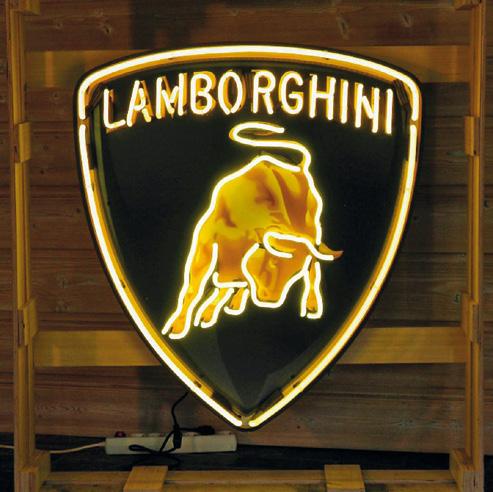
CHF 2‘000 - 4‘000
An illuminated Porsche advertising wall sign in excellent contdition. For easy of installation and optimum effect, illuminated or not, the sign, measuring 100x80 centimetres, is backed by a colour matched rear panel and works on 220 Volt.
Lot 17: Indycar shaped Go-Kart
CHF 3‘500
- 7‘000
This is a great Indycar shaped go-kart with Dr. Pepper branding in very good, working condition. Tecumseh engine, Goodyear tires. The little racer is 322 cm long, 96 cm wide and 50 cm in height.
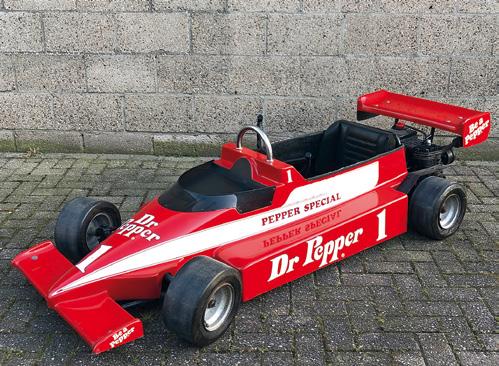
9
Lot 19: 1994 Ferrari F40 LM
Lot 18: Ford Cosworth DFV 3.0 V8 Scale Engine
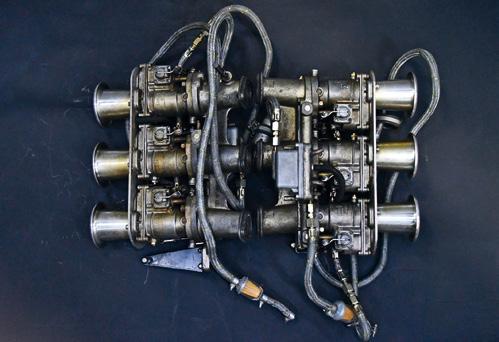

CHF 15‘000 - 18‘000
The story behind this working 1:3 scale Ford Cosworth DFV engine is that it was time to give car and F1 enthusiasts the opportunity to acquire a working scale model engine. It took over 3 years to work it all out in solid works, to have the molds made for making all casted parts, to produce all other machined parts and including all bolts and nuts. Finally, the engine is made of about 1’200 parts.
The engine has a capacity of 76cc can rev up to 10’000 and produces about 9hp @ 9’000 RPM and off course it sounds like a true V8, the sound is music to your ears! It runs on methanol same as the radio-controlled airplanes/cars and comes with a starter kit. Limited production only - so make sure to not miss this opportunity!
CHF 2‘000 - 3‘000
Highly detailed 1:8 scale model of a 1994 Ferrari F40 LM, limited edition # 262/499, built by GT Spirit, sold out by factory, including showcase.

Lot 20: 1971 Ferrari 512 M Sunoco Scale Model
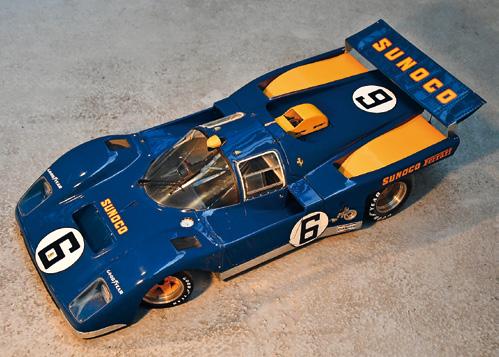
CHF 15‘000 - 20‘000
Scale Model of the 1971 Ferrari 512 M Sunoco - Chassis #1040. This incredible 1:4 scale model was painstakingly handcrafted by Daniel Stöckli for the then owner of the original car. The exact copy of the Penske 512 M shines with fantastic details. The tubular frame was measured and made to the correct scale - suspension, struts, radiator, oil hoses and exhaust system all correspond to the original and even the countless rivets on the body were placed in the correct positions to scale. No wonder the price for this model was the equivalent of a VW Golf GTI. This absolutely unique model is in very good condition and is an excellent eye-catcher in any Ferrari collection.
Lot 21: „Fangio“ Bronze sculpture by Chris Davis


CHF 8‘000 - 10‘000

To celebrate the launch of the new long-awaited Maserati Spider in September 2001, Maserati S.p.A. organized a model exhibition that was the most comprehensive display of Maserati models and Maserati-related works of art ever assembled. The exhibition was centered around a competition that Maserati had organised, ‚Modellismo Maserati‘, for the best models/ works of art in different categories. One of the entries for this competition was this superb sculpture by Chris Davis that depicts Juan Manuel Fangio‘s epic drive to victory at the wheel of a 250F in the 1957 German Grand Prix at Nürburgring. A limited edition of only five worldwide has been produced and this is the number one. So, this is the opportunity to acquire one of these incredible rare sculptures - a great piece of art and history.
Lot
Lot 22: Dellorto DHLA 40 twin-choke carburettor
CHF 300 - 500 A NOS Dellorto DHLA 40 twin-choke carburettor. The carburettor is suitable for engines up to approx. 1‘500 cc and also fits VW Beetles or classic Harley-Davidson motorbikes.

23: Solex 40 PI carburettors for Porsche 911
CHF 3‘000 - 5‘000
A rare and complete set of Solex 40 PI carburettors for Porsche 911 of the years 1964-68. No longer available as a new part and extremely sought after for restorations true to the original!
10 www.TheSwissAuctioneers.swiss
Lot 25: Kristall „Leo Amberg“ race bike
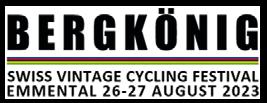
Lot 24: Allegro Special “Champion du Monde” race bike
CHF 1‘000 - 1‘500
This gorgeous Swiss built vintage race bike was built approx. 1952 by the Allegro cycle company in Neuchatel. It has a 8-Speed Le Simplex gear change and a Brooks saddle. The bike is in top original condition but comes without recent service. Frame-size 57, Frame #107364
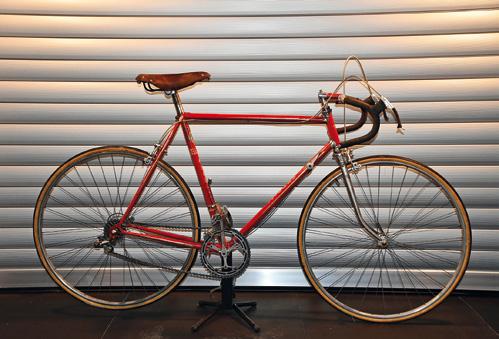
CHF 4‘000 - 5‘000
Built by the Kristallwerke Degersheim approx. 1935. This great vintage race bike with wooden rims, 3-speed Egg gear changer and Brooks Saddle is in top original condition, but without current service. Frame-size 56, Frame #1883

Lot 26: Tour de Suisse race bike


CHF 1‘200 - 2‘000

This Tour de Suisse race bike was built by the so named factory of the Gschwend Family in Zürich (today the factory is in Kreuzlingen) at approx. 1965. The vintage bike has a 10-speed Campagnolo gear shift, Weinmann “Weltmeister” type wheels and a Brooks saddle. It is in top original condition but comes without recent service. Frame-size 57.
Sie finden die Beschreibungen der Lots 1 bis 26 auf unserer Website. Veuillez trouver les descriptions des Lots 1 à 26 sur notre site www.TheSwissAuctioneers.swiss
11



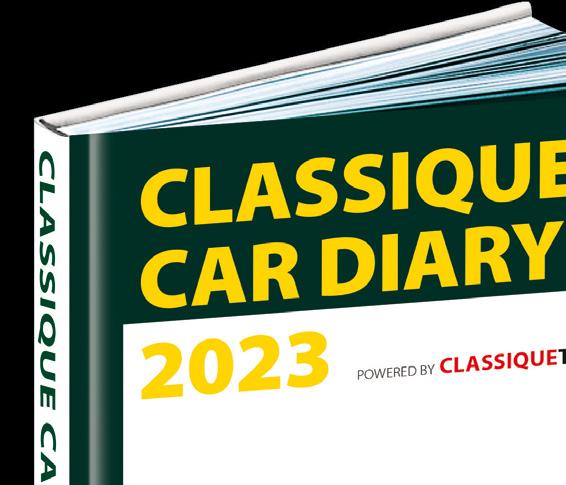

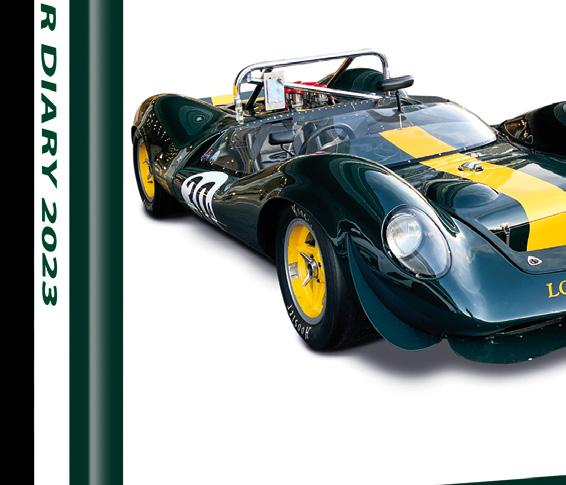
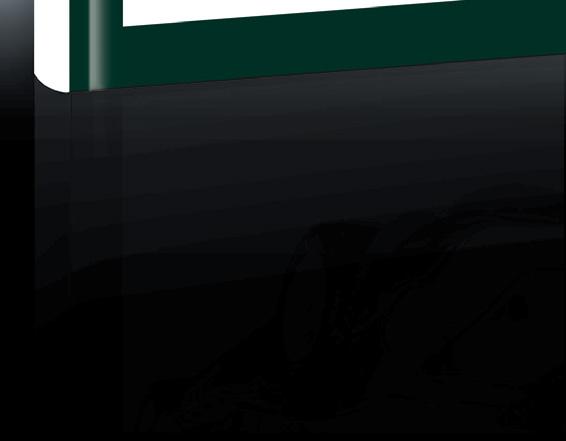

12 www.TheSwissAuctioneers.swiss • Über 300 internationale OldtimerRallyes, Messen und Auktionen • 208 Seiten im praktischen DIN A5 Pocket-Format • 52 Wochenseiten für Ihre persönliche Planung • Hotel- & Museumsempfehlungen • Adresssammlung von Racetracks und Markenclubs www.infact.digital POWERED BY CLASSIQUE TIME Ein MUST für jeden Oldtimerliebhaber! 21,95 Jetzt bestellen unter: www.classiquecardiary.de
1986 Citroën 2 CV 6 «I fly bleifrei»
Chassis # VF7AZKA00KA240475

The Citroën 2CV is an air-cooled front-engine, frontwheel-drive, economy family car, introduced at the 1948 Paris Mondial de l‘Automobile, and manufactured by Citroën for model years 1948–1990. Conceived by Citroën Vice-President Pierre Boulanger to help motorise the large number of farmers still using horses and carts in 1930s France, the 2CV has a combination of innovative engineering and straightforward, utilitarian bodywork. The 2CV featured overall low cost of ownership, simplicity of maintenance, an easily serviced air-cooled engine, and minimal fuel consumption.
finden lassen. Die Karosserie wurde neu lackiert und mit neuen Aufklebern versehen, die Innenausstattung erhielt neue Sitzbezüge und es wurden neue Felgen mit neuen Michelin Reifen montiert. Mit seiner pfiffigen Farbe und den witzigen Aufklebern widerspiegelt dieser Citroën den Zeitgeist Mitte der 80er Jahre und überrascht mit dem typischen, sehr komfortablen Fahrgefühl der französischen Legende. Die letzte MFK als Veteranenfahrzeug erfolgte im Oktober 2022.
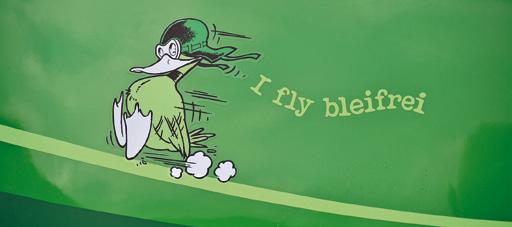
This Citroen 2CV is one of only 2’000 special edition “Green Duck” examples ever built. It is very unlikely that a second example in a comparable condition will be found! The coachwork was repainted and decorated with new graphics, the interior was restored with new seat covers and new rims with new Michelin tyres were fitted. With its cheeky colour and those funny stickers, the Citroen perfectly embodies mid 80’s Zeitgeist and still manages to surprise with its typical - and most comfortable - road manners for which the little French legend has become so famous. The last Veteran MOT was successfully completed in October of this year.

Bei diesem Citroën 2 CV handelt es sich um ein restauriertes Exemplar der seltenen «Ente grün. Von den nur 2‘000 gebauten Fahrzeugen dieser Sonderedition dürften sich nur noch wenige in Vergleichbarem Zustand
Cette Citroën 2CV est l‘un des 2‘000 exemplaires de l‘édition spéciale „Canard vert“ jamais construits. Il est très peu probable qu‘un deuxième exemplaire dans un état comparable soit trouvé ! La carrosserie a été repeinte et décorée avec de nouveaux graphiques, l‘intérieur a été restauré avec de nouvelles housses de sièges et de nouvelles jantes avec de nouveaux pneus Michelin ont été montés. Avec sa couleur insolente et ces autocollants amusants, la Citroën incarne parfaitement l‘esprit du milieu des années 80 et parvient encore à surprendre avec son comportement routier typique - et des plus confortables - pour lequel la petite légende française est devenue si célèbre. La dernière expertise vétéran a été effectuée en octobre de cette année.
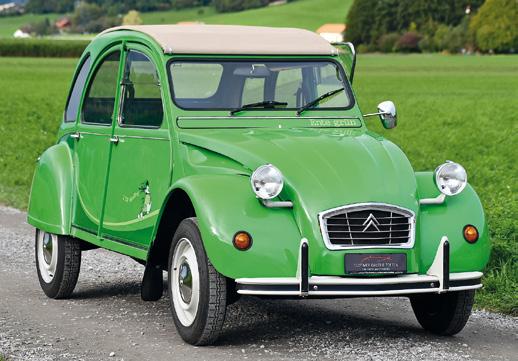
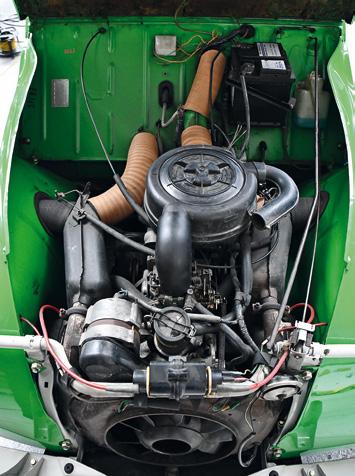
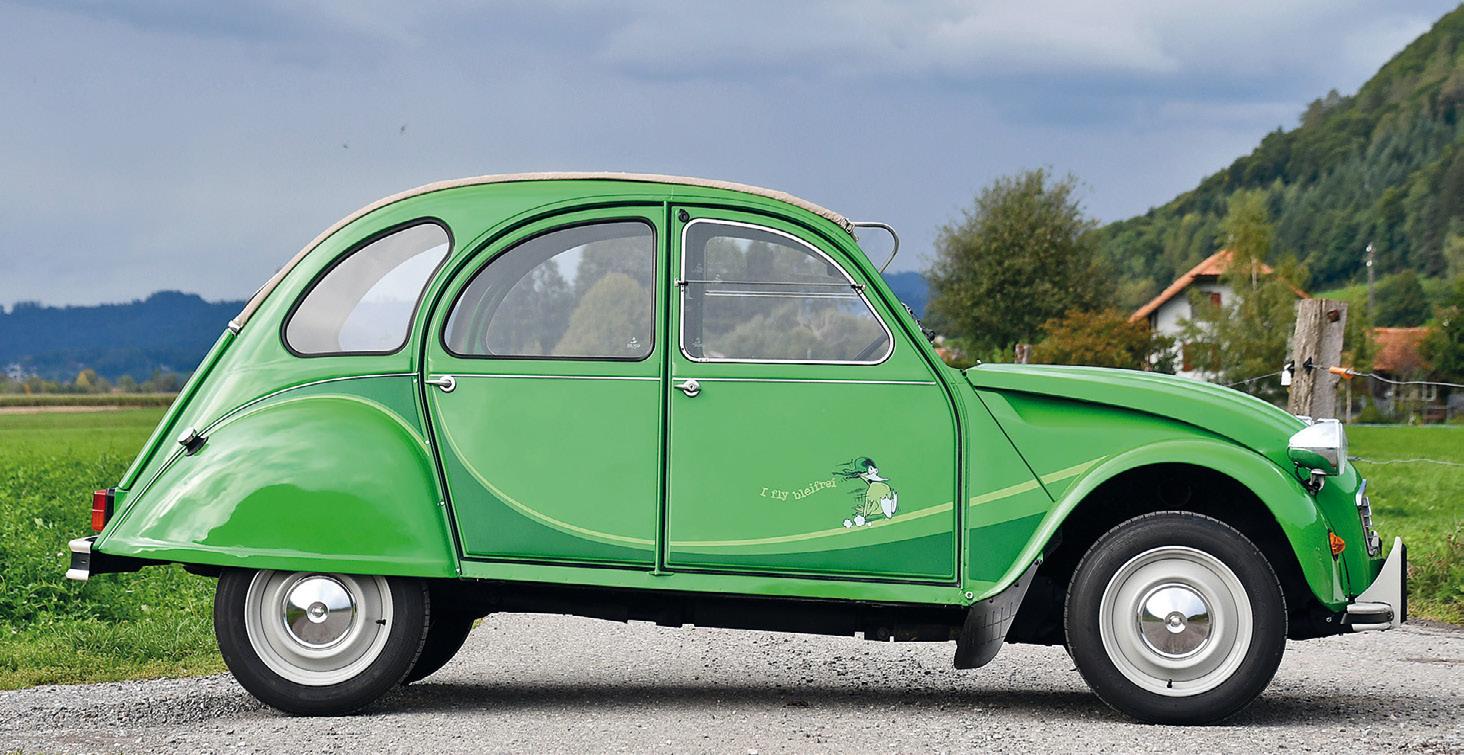
13
Lot 101 2‘000 cars (I fly bleifrei) 2 cylinder flat-engine 602 cc 28 hp at 5‘750/min Estimate CHF 18‘000 - 22‘000 at no reserve Story
Photos Oldtimer Galerie
wikipedia.org
1982 Ferrari 308 GTBi
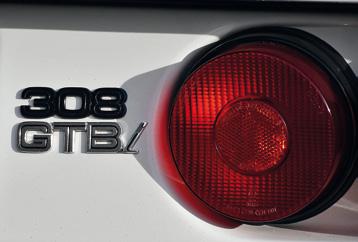
Chassis # ZFFHA01B000040809
The Ferrari 308 GTB berlinetta and targa topped 308 GTS are V8 mid-engined, two-seater sports cars manufactured by the Italian company Ferrari from 1975 to 1985. The 308 replaced the Dino 246 GT and GTS in 1975 and was updated as the 328 GTB/GTS in 1985. The similar 208 GTB and GTS were equipped with a smaller, initially naturally aspirated and later turbocharged, two-litre engine, and were sold mainly in Italy.
The 308 had a tube frame with separate body. The 308 GTB/GTS and GT4 were mechanically similar, and also shared much with the original Dino. Both 308s sit on the same tube platform, however the GT4—being a 2+2—has a longer wheelbase. The engine was a V8 of a 90 degree configuration, with two belt-driven overhead camshafts per cylinder bank. It was transversely mounted in unit with the transaxle transmission assembly, which was below and to the rear of the engine‘s sump. All models used a fully synchromesh 5-speed „dog-leg“ manual gearbox and a clutch-type limited slip differential. Suspension was all-independent, comprising double wishbones, coaxial coil springs and hydraulic dampers, and anti-roll bars on both axles; four wheel vented disc brakes were also fitted. Steering was unassisted rack and pinion.
The 308‘s body was designed by Pininfarina‘s Leonardo Fioravanti, who had been responsible for some of Ferrari‘s most celebrated shapes to date such as the Daytona, the Dino and the Berlinetta Boxer. The 308 used elements of these shapes to create something very much in contrast with the angular Bertone-designed GT4. GTS models featured a removable roof panel with grained satin black finish, which could be stowed in a vinyl cover behind the seats when not in use.
The Pininfarina-styled Ferrari 308 GTB was introduced at the Paris Motor Show in 1975 as a supplement to the Bertone-shaped 2+2 Dino 308 GT4 and a direct replacement for the two-seater Dino 246.
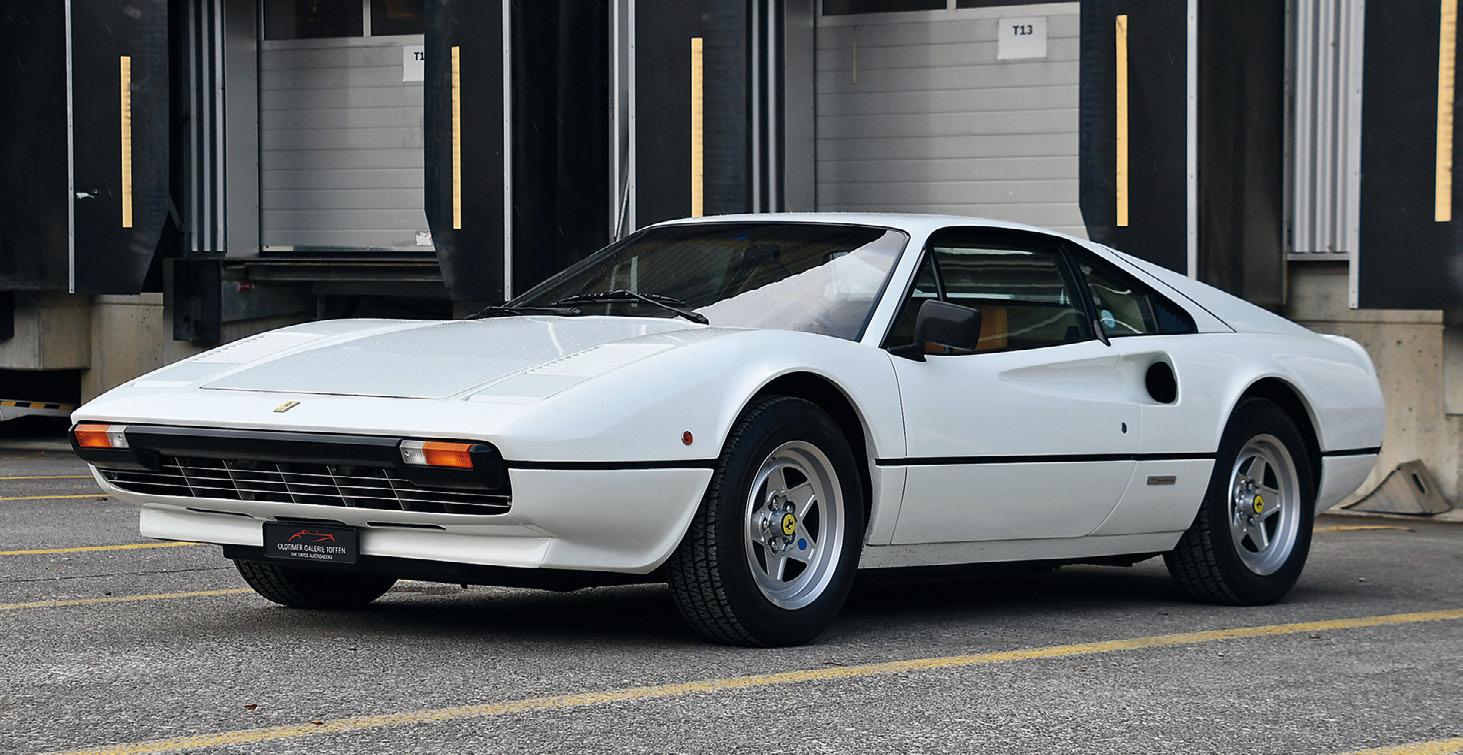
Its F106 AB V8 engine was equipped with four twinchoke Weber 40DCNF carburettors and single coil ignition. European versions produced 255 hp at 6‘600 rpm (7‘700 rpm redline), but American versions were down to 240 hp at 6‘600 rpm due to emissions control devices. European specification cars used dry sump lubrication.
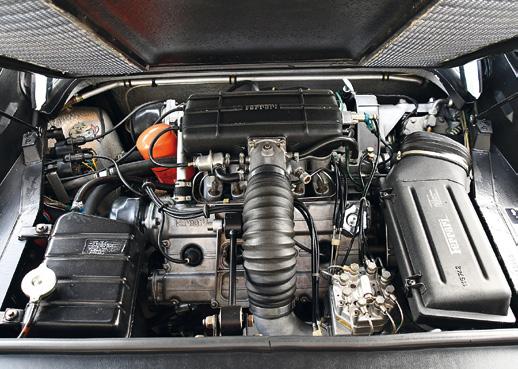
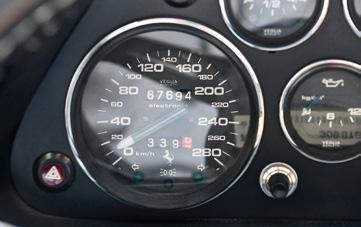
A notable aspect of the early 308 GTB was that, although still built by Carrozzeria Scaglietti, its bodywork was originally entirely made of glass-reinforced plastic (GRP), allowing a very light weight of 1,050 kg (2,315 lb). This lasted until June 1977, when the 308 was switched to steel bodies, resulting in an overall weight increase of approximately 150 kg.
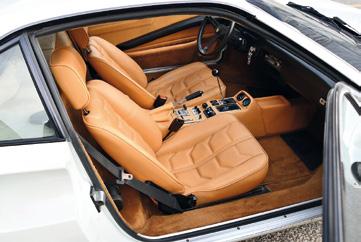
14 www.TheSwissAuctioneers.swiss
Lot 102 494 cars V8 2‘927 cc 214 hp at 6‘600/min Estimate CHF 65‘000 - 75‘000 Story wikipedia.org
Photos Oldtimer Galerie
Five-spoke 14-inch alloy wheels were standard, while 16-inch wheels were made available later as an option together with sports exhaust system, high compression pistons, a high lift camshaft and a deeper front spoiler. In 1980 Bosch K-Jetronic mechanical fuel injection was offered, leading to the 308 GTBi and GTSi; emissions decreased, at the price of a power drop to 214 hp on European models and 205 hp on federalized models. The fuel injection was coupled to a Marelli MED 803A Digiplex electronic ignition, incorporating a coil, distributor, and ignition module for each bank of cylinders.
Outside, the car was identical to the 308 GTB/GTS, save for metric sized wheels of a slightly different design, fitted with Michelin TRX radial tyres—Michelin XWX on 16-inch wheels were optional. Inside, the clock and oil temperature gauge were moved to the centre console; there were also a new black steering wheel with three perforated spokes, and seats of a different pattern.
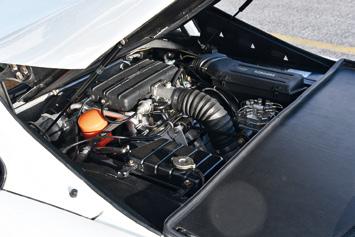

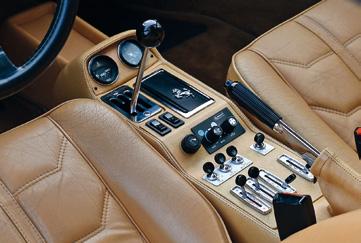
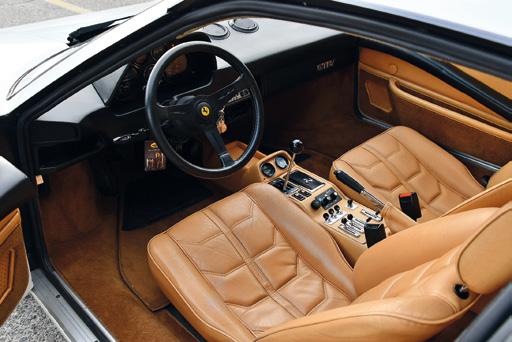

Dieser Ferrari 308 GTBi, eines von nur 494 gebauten Coupés mit 2-Ventiltechnik und Benzineinspritzung, wurde am 31. Mai 1982 durch die Garage AD Autodiffusion in Meyrin ausgeliefert. Der 308er in seiner eleganten Farbkomposition von weiss mit hellbraunem Leder hatte vermutlich drei Vorbesitzer, bis er 2017 in die Privatsammlung eines Garagisten aufgenommen wurde. Das Serviceheft belegt die gewissenhafte Wartung des Sportwagens aus Maranello und der letzte Zahnriemenwechsel erfolgte im Januar 2020 bei 66‘068 Kilometern. Der Ferrari hat knapp 68‘000 gefahrene Kilometer auf der Uhr, befindet sich in sehr gutem Zustand und erhielt kürzlich neue Bremsscheiben vorne und hinten sowie einen Satz neuer Michelin TRX Reifen. Die letzte MFK als Veteranenfahrzeug erfolgte im April 2015.
This Ferrari 308 GTBi, one of only 494 Coupés with fuel injection and two valve heads was delivered to its first owner on the 31st of May 1982 by the Garage AD Autodiffusion in Meyrin. The 308 in its elegant combination of white with a tan leather has had most probably only three owners by the time it was acquired by the vendor, a garage owner, and entered into his collection in 2017. The service booklet testifies the diligent maintenance the car has enjoyed, and the last cambelt change was completed in January 2020 at 66’068 kilometres. The Ferrari has now covered 68’000 kilometres and is in very good condition. Recently new brake discs to the front and rear, and a new set of Michelin TRX tyres were installed. The last veteran MOT was completed in April 2015.

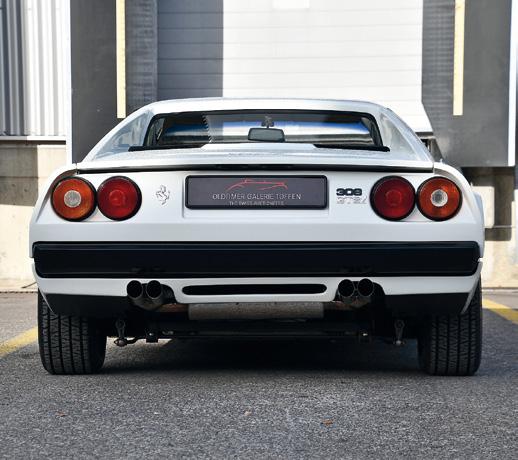

Cette Ferrari 308 GTBi, l‘un des 494 coupés avec injection et deux soupapes, a été livrée à son premier propriétaire le 31 mai 1982 par le Garage AD Autodiffusion à Meyrin. La 308 dans son élégante combinaison de blanc avec un cuir fauve n‘a très probablement eu que trois propriétaires au moment où elle a été acquise par le vendeur, un garagiste, et entrée dans sa collection en 2017. Le carnet d‘entretien témoigne de l‘entretien diligent dont a bénéficié la voiture, et le dernier changement de courroie a été effectué en janvier 2020 à 66‘068 kilomètres. La Ferrari a maintenant parcouru 68‘000 kilomètres et est en très bon état. Récemment, de nouveaux disques de frein à l‘avant et à l’arrière et un nouveau jeu de pneus Michelin TRX ont été installés. La dernière experitse vétéran a eu lieu en avril 2015.
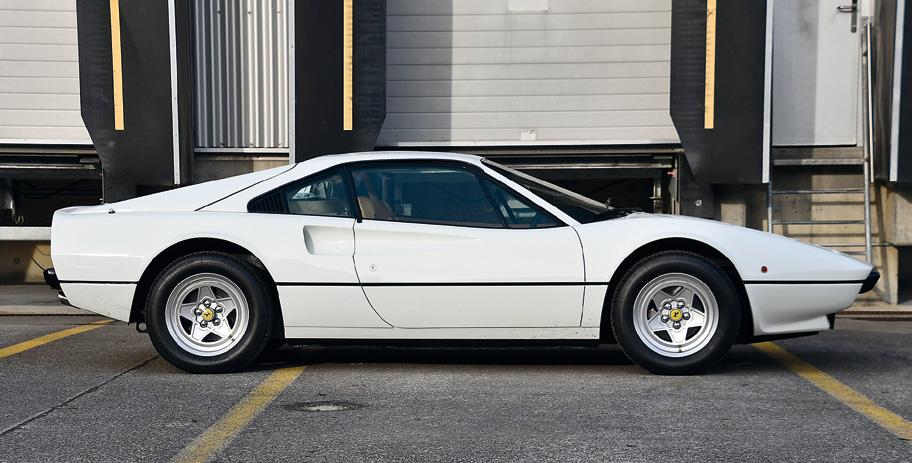
15
1975 Porsche 911 2.7
Chassis # 9116300531
The first of many upgrades to the Porsche 911 came in 1966 with the introduction of the 911S. The ‚S‘ featured a modified engine developing 160 horsepower and was externally distinguishable by its Fuchs five-spoke alloy wheels. In 1969 the wheelbase was lengthened resulting in improvements to its handling. In 1970 the air-cooled ‚flat-six‘ underwent the first of many enlargements - to 2.2 liters. In 1974 all Porsche 911 variants were fitted with the 2.7-liter unit, hitherto reserved for the Carrera when the latter went to 3.0 liters. The non-Carrera tuned 2.7-liter unit offered 175 bhp which was slightly less power than the previous ‚2.4,‘ but developed significantly more torque over a much wider rev range which greatly improved acceleration. When fed with low-lead petrol, and having an increased tank capacity, the new 911 was superior to its predecessor in every way as a high performance, long-distance tourer.

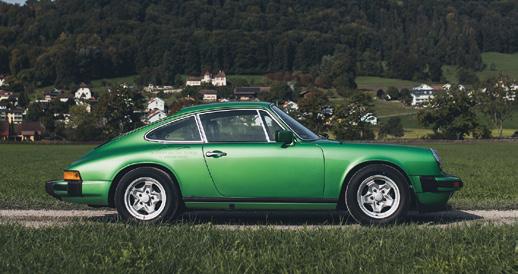
The Coupe version was introduced in 1964 followed two years later by a convertible 911 known as the ‚Targa,‘ named in recognition of Porsche‘s numerous victories in the Sicilian classic. In compliance with U.S. safety legislation, the soft-top 911 received a hefty roll-over bar to protect the occupants in the event of an inversion, together with removable roof and rear hood sections, which were stowed in the boot. A few years later, in 1969, a quieter and less leak-prone fixed rear window replaced the rear hood, and the Targa would continue in this guise well into the 1990s, receiving numerous mechanical and styling developments along the way.
This classic, aircooled 911, model year 1976, is a Swiss delivery and comes from many years of previous ownership. It has completed 169‘500 kilometres so far. In 2017 the car was repainted in its original colour “Viper green metallic”. All maintenance receipts since 1990 are available. Good and fastidiously maintained condition. The latest Veteran MOT dates from September 2019.


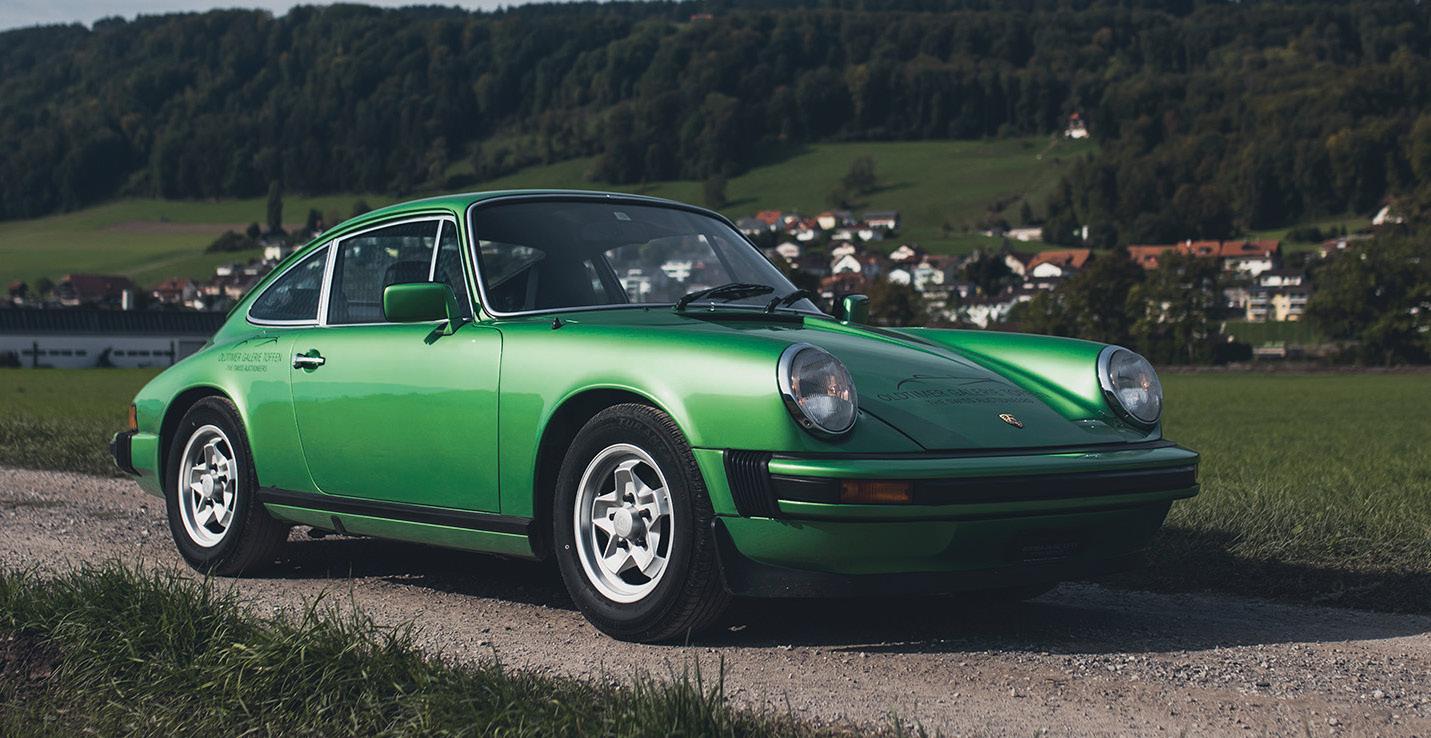
Dieser 911er Modelljahr 1976 ist eine Schweizer Auslieferung, stammt aus langjährigem Vorbesitz und hat 169‘500 km gefahren. 2017 wurde der Wagen in der Originalfarbe „Vipergrün metallic“ neu lackiert. Sämtliche Belege seit 1990 sind vorhanden. Guter und sehr gepflegter Zustand. Die letzte MFK als Veteranenfahrzeug erfolgte im September 2019.
Cette 911 classique, refroidie par air, modèle 1976, est une livraison suisse et provient de beaucoup des années de propriété précédente. Elle a parcouru 169‘500 kilomètres à ce jour. En 2017, la voiture a été repeinte dans sa couleur d‘origine „vert Viper metallisé“. Tous les reçus d‘entretien depuis 1990 sont disponibles. Bon état et entretenue avec soin. La dernière expertise vétéran date de septembre 2019.
16 www.TheSwissAuctioneers.swiss
Lot 103 1‘868 cars (1976 MY Coupé) 6 cylinder flat-engine 2‘687 cc 165 hp at 5‘800/min Estimate CHF 55‘000 - 65‘000 at no reserve Story conceptcarz.com Photos Daniel Zizka
1992 Fiat Panda 4x4 Trekking
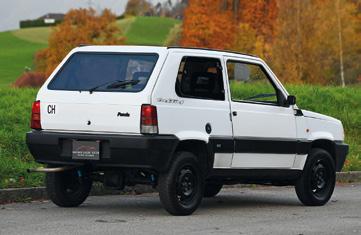
verhilft dem Panda zu ungeahnten Kletterfähigkeiten. Frisch ab Service, mit rund 77‘500 Kilometern auf der Uhr und der letzten MFK im Juli 2022, befindet sich der Wagen in gutem bis sehr gutem Zustand. Die kompakten Abmessungen und der zuschaltbare Allradantrieb machen diesen kleinen Fiat zum idealen Begleiter in den teils engen und steilen Strassen des Berner Oberlandes.
Lot 104 Production numbers unknown

This cute Panda 4x4 in “trekking” edition was delivered to its first owner by garage Bösch in Solothurn on 30th of October 1992. As shown in the service booklet and the emission control document, he remained faithful to the Fiat until 2013 at which time the car had covered 52’000 kilometres. In the last 9 years a further owner added another 25’000 kilometres. The little one litre 4 cylinder with its 45 hp is running faultlessly and provides a little Panda with surprising off road capability. Freshly serviced, with now showing 77’500 kilometres and the last MOT completed in July 2022, the car is in good to very good condition. The compact dimensions and the ability to select all-wheel drive make this little Fiat the ideal companion on the often narrow and steep roads of the Bernese mountain region.


Dieser knuffige Panda 4x4 mit «trekking» Ausstattung wurde am 30. Oktober 1992 durch die Garage Bösch in Solothurn an den Erstbesitzer übergeben. Wie das Serviceheft und das Abgaswartungsdokument vermuten lässt, blieb dieser seinem kleinen Kraxler währen 52‘000 Kilometern und bis 2013 treu. Währen der letzten 9 Jahre legte der letzte Besitzer weitere 25‘000 Kilometer mit dem kleinen Italiener zurück. Der kleine 1-Liter 4-Zylinder mit seinen 45 PS läuft einwandfrei und
Cette jolie Panda 4x4 en edition „trekking“ a été livrée à son premier propriétaire par le garage Bösch à Soleure le 30 octobre 1992. Comme le montrent le carnet d‘entretien et le document de contrôle des émissions, il est resté fidèle à la Fiat jusqu‘en 2013, date à laquelle la voiture a parcouru 52‘000 kilomètres. Au cours des 9 dernières années, un autre propriétaire a ajouté 25‘000 kilomètres supplémentaires. Le petit 4 cylindres d‘un litre et ses 45 cv fonctionne sans problème et offre à la petite Panda des capacités surprenantes en tout-terrain. Fraîchement sortie du service, avec maintenant 77‘500 kilomètres et la dernière expertise complétée en juillet 2022, la voiture est en bon à très bon état. Les dimensions compactes et la possibilité de sélectionner la transmission intégrale font de cette petite Fiat le compagnon idéal sur les routes souvent étroites et escarpées de la région des montagnes bernoises.
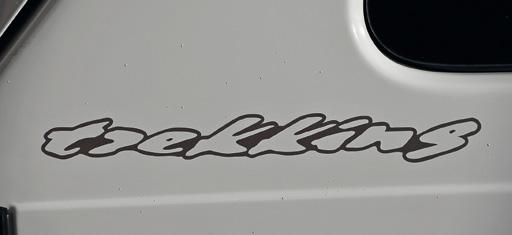
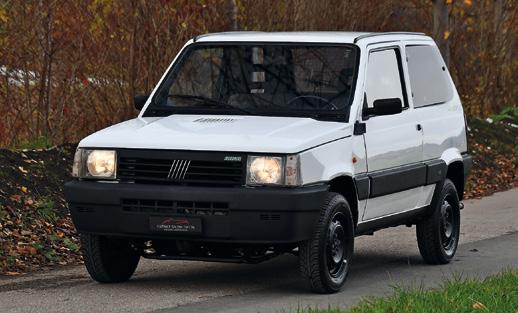

17
Chassis # ZFA141A0004749368
in-line 4 cylinder 999 cc 45 hp at 5‘250/min Estimate CHF 10‘000 - 15‘000 at no reserve
Photos Oldtimer Galerie
2006 Land Rover Defender Td5 SoftTop

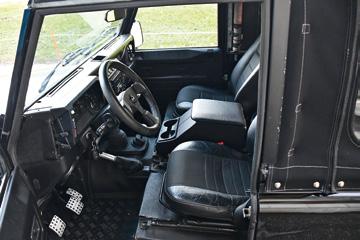 Chassis # SALLDVA586A719299
Chassis # SALLDVA586A719299
The Land Rover Defender (initially introduced as the Land Rover 110 / One Ten, and in 1984 joined by the Land Rover 90 / Ninety, plus the new, extra-length Land Rover 127 in 1985) is a series of British off-road cars and pickup trucks. They consistently have fourwheel drive, and were developed in the 1980s from the original Land Rover series which was launched at the Amsterdam Motor Show in April 1948. Following the 1989 introduction of the Land Rover Discovery, the term ‚Land Rover‘ became the name of a broader marque, and thus no longer worked as the name of a specific model; thus in 1990 Land Rover renamed the 90 and 110 as Defender 90 and Defender 110 respectively. The 127 became the Defender 130.

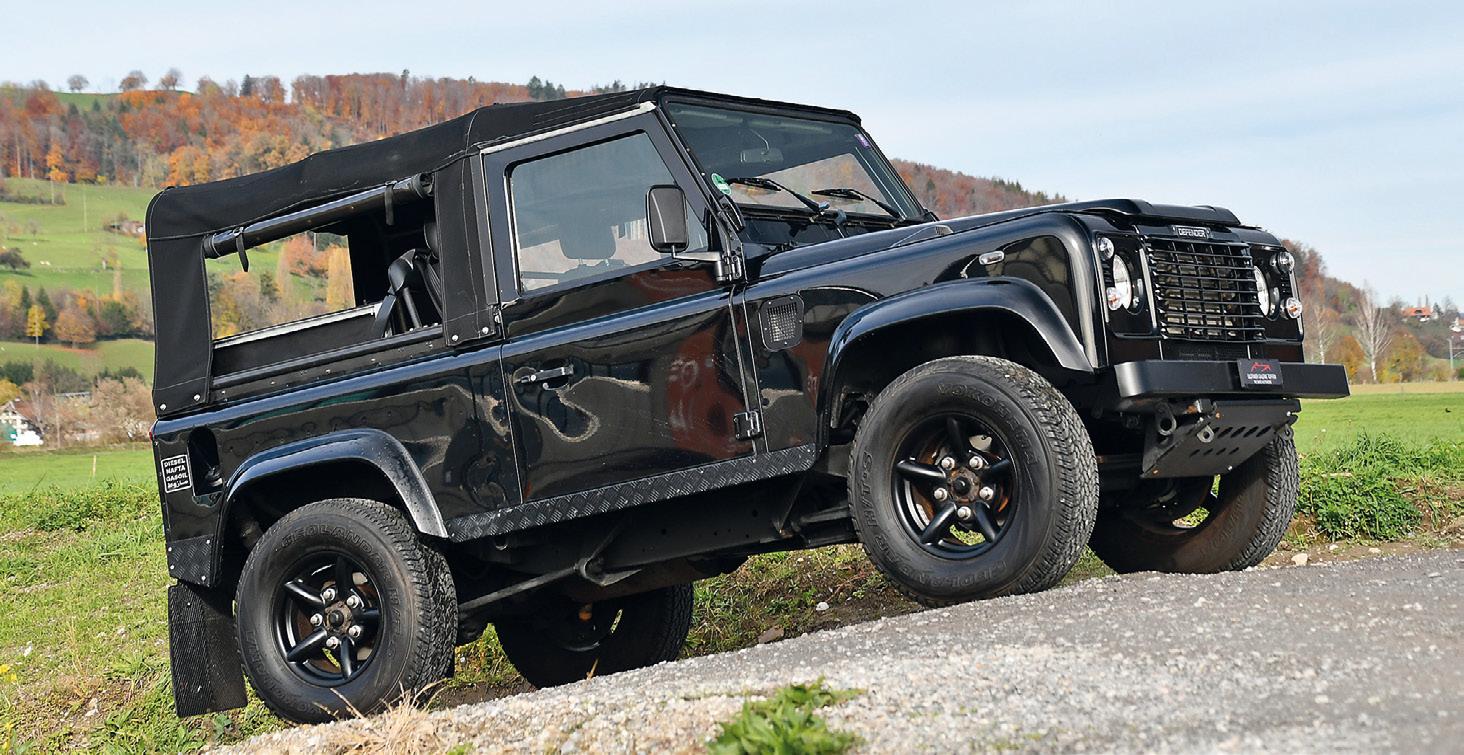
The vehicle, a British equivalent of the Second World War derived (Willys) Jeep, gained a worldwide reputation for ruggedness and versatility. Using a steel ladder chassis and an aluminium alloy bodywork, the Land Rover originally used detuned versions of Rover engines. Though the Defender was not a new generation design, it incorporated significant changes, compared to the series Land Rovers, such as adopting coil springs front and rear, as opposed to all leaf springs on the previous; except for retaining rear leaf springs on high capacity (payload) models. Coil springs offered both better ride quality and improved axle articulation. Adding a lockable centre differential to the transfer case gave the Defender permanent (on-road) four-wheel-drive capability. Both changes were derived from the Range Rover, and the interiors were also modernised.
Externally, a full-length bonnet and full-width integrated grille and headlights, combined with (finally) a single-piece windscreen, plus widened wheel arches
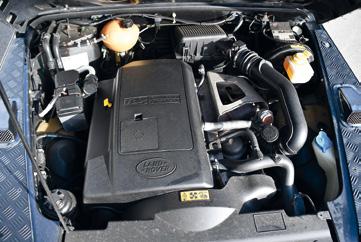
that covered new, wider-track axles were the most noticeable changes. Initially the engineering department conserved a part-time 4WD system, like on previous models, but it failed to sell any longer, and this option was immediately dropped in 1984. While the engine was carried over from the Series III, a new series of modern and more powerful engines was progressively introduced.
After a continuous run of 67 years production finally ended on 29 January 2016, after a total of just over two million Land Rover Series and Defender models had been built. The two millionth unit was assembled with the help of a special team in May 2015, and charitably auctioned for the International Federation of Red Cross and Red Crescent (IFRC) Societies later that year. The last Land Rover Defender, rolled off the production line, with the number plate H166 HUE, a reference to the first ever pre-production Land Rover, registration ‚HUE 166‘. This was the 2‘016‘933rd Defender to be produced.
18 www.TheSwissAuctioneers.swiss
Lot 105 one of a kind in-line 5 cylinder Turbo-Diesel 2‘495 cc 122 hp at 4‘200/min Estimate CHF
55‘000 - 65‘000 Story wikipedia.org
Photos Oldtimer Galerie
A Land Rover Defender represents, to this day, the epitome in off-road motoring. This unique example was completely rebuilt about five years ago and adapted to its then owners’ request. Amongst other things, a height adjustable suspension was installed allowing the car to be stored in garage heights below 2 metres. In addition to that, a Matzker handling kit was fitted. The Defender also received a set of aluminium rims. For very tall drivers the seat adjustment as well as the front scuttle were modified, and the car received Td4 heated seats. An Exmoor exclusive soft top with opening side and rear screens was fitted. The exterior received a menacing look in black powder coating. The five-cylinder diesel engine was tuned to deliver 165 horsepower, no doubt increasing the driving experience considerably. The Defender has been with its third owner since 2017 and has been driven at total of 121’000 kilometres, with only 5’000 kilometres since the modifications were completed. This unique Landy is in outstanding condition and will be sold with the latest MOT from May 2021.
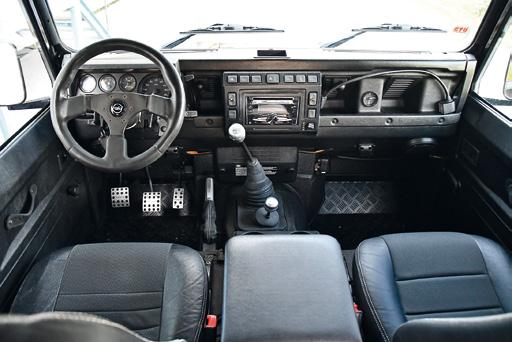

Der Land Rover Defender gilt bis heute als das Nonplus-Ultra in Sachen Geländefahrzeug. Dieses einmalige Exemplar wurde vor ca. 5 Jahren komplett neu aufgebaut und den Wünschen des Besitzers angepasst. So wurden unter anderem ein Fahrwerk mit dezenter Höherlegung – mit Einstellhallentauglicher Gesamthöhe unter 2 Metern - sowie ein Handling-Kit des Landy Spezialisten Matzker verbaut. Zudem erhielt der Defender einen Satz Leichtmetallräder. Für grossgewachsene Fahrer wurden Sitzschienenverlängerungen mit der entsprechenden Anpassung der Schottwand eingebaut und Td4-Sitze mit Sitzheizung montiert. Der Wagen erhielt ein Exmoor Exklusiv-Verdeck mit aufrollbaren Seiten- und Heckscheiben. Und für die sportlich-brachiale Optik wurden schwarz Pulverbeschichtete Riffelbleche im Innenraum, auf den vorderen Kotflügeln, den hinteren Seitenteilen und an den Seitenschwellern montiert. Das 5-Zylinder Dieselaggregat erhielt eine Leistungssteigerung auf 165 PS, was dem Fahrspass sicher zuträglich ist. Der Defender befindet sich seit 2017 in dritter Hand und hat eine Gesamtlaufleistung von rund 121‘000 Kilometer – seit dem Neuaufbau wurden lediglich 5‘000 Kilometer zurückgelegt. Dieser einmalige Landy befindet sich in hervorragendem Zustand und wird mit der letzten MFK im Mai 2021 an einen neuen Liebhaber übergeben.

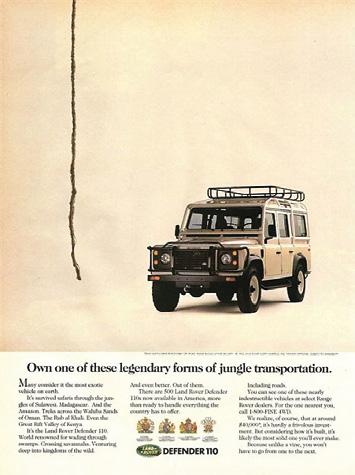

Un Land Rover Defender représente, à ce jour, le summum de l‘automobile tout-terrain. Cet exemplaire unique a été entièrement reconstruit il y a environ cinq ans et adapté à la demande de ses propriétaires de l‘époque. Entre autres choses, une suspension réglable en hauteur a été installée, permettant à la voiture d‘être stockée dans des garages d‘une hauteur inférieure à 2 mètres. En outre, un kit de maniabilité Matzker a été installé. Le Defender a également reçu un jeu de jantes en aluminium. Pour les conducteurs de grande taille, des rallonges de rail de siège ont été installées avec l‘adaptation correspondante de la cloison de séparation et des sièges Td4 avec chauffage de siège ont été montés. Une capote exclusive Exmoor avec vitres latéraux et arrière ouvrants est montée. Et pour un look sportif et brachycéphale, des tôles striées peintes en noir par poudrage ont été montées dans l‘habitacle, sur les ailes avant, les parties latérales arrière et les jupes latérales. La puissance du moteur diesel 5 cylindres a été augmentée à 165 chevaux, ce qui contribue certainement au plaisir de conduite. Le Defender est chez son troisième propriétaire depuis 2017 et a parcouru au total 121‘000 kilomètres, dont seulement 5‘000 kilomètres depuis la fin de la restauration. Ce Landy unique est dans un état exceptionnel et sera vendu avec la dernière expertise de mai 2021.
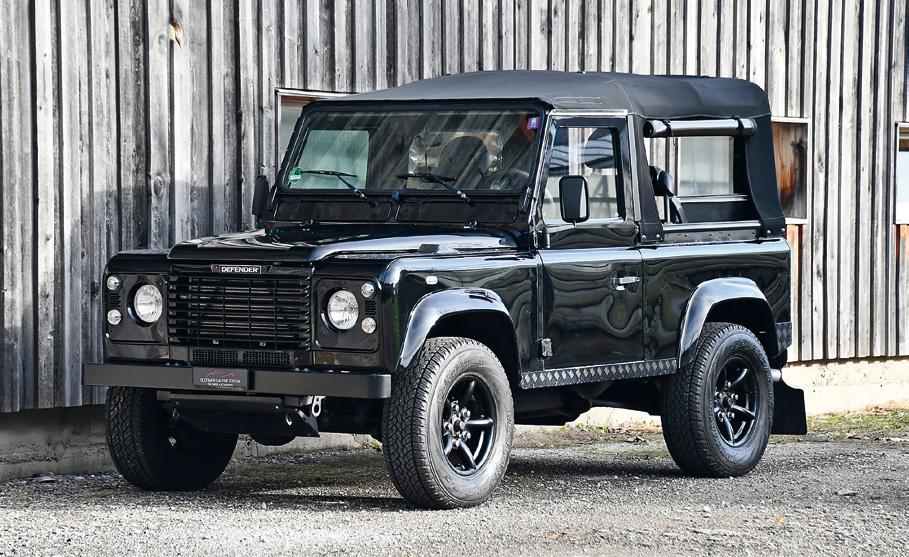

19
JETZT PROBE FAHREN DER NEUE DEFENDER 90
Ab August 2022
Edel-SUV mit Verwöhn-Aroma und Langstrecken-Hybrid
Die dritte Generation des Range Rover Sport kommt mit über 100 Kilometern PHEV-Reichweite. Aber auch V8-Fans kommen auf ihre Kosten. Dazu natürlich: neuer Luxus.
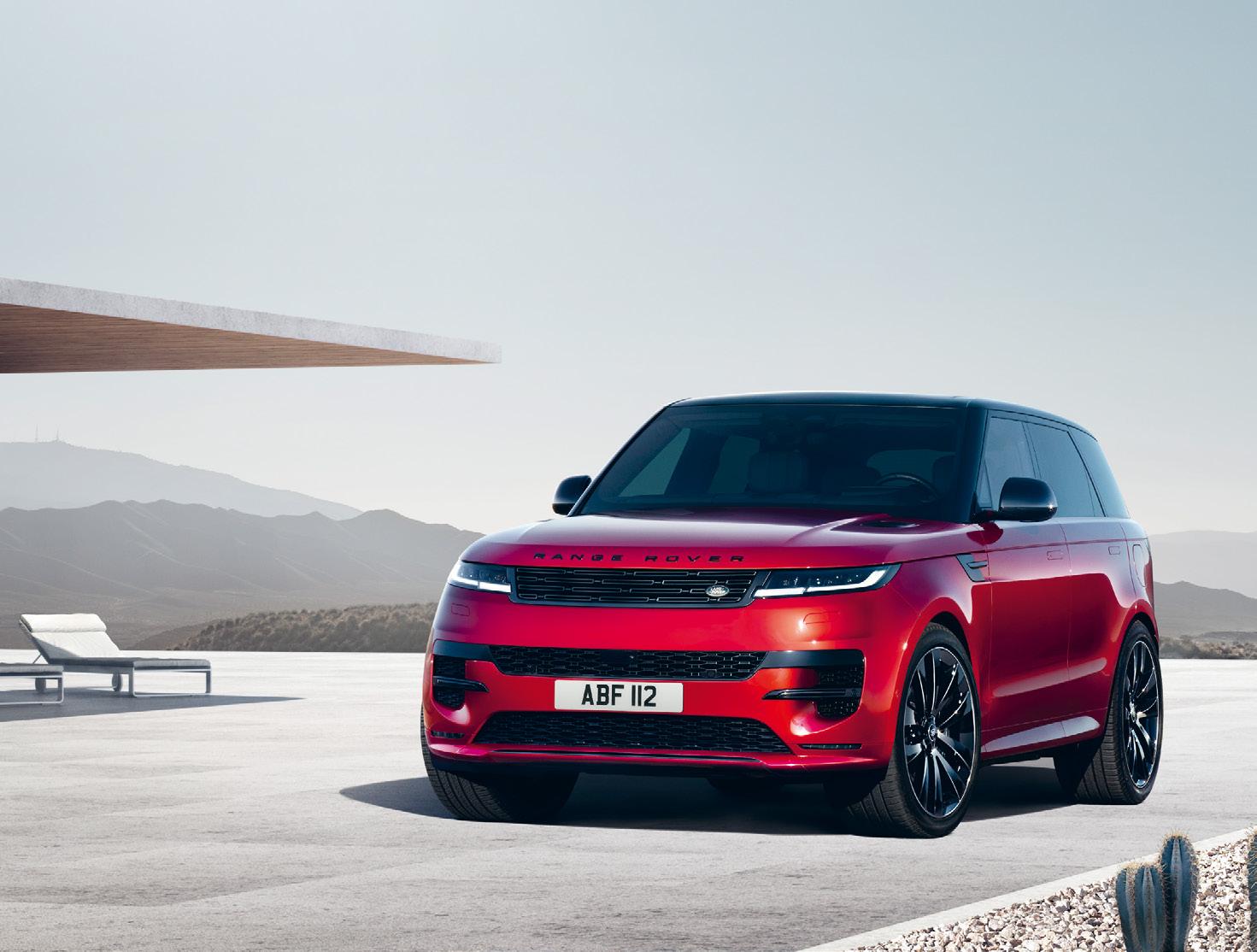
Der neue Land Rover Defender ist so robust, wie er aussieht und setzt hinsichtlich Langlebigkeit neue Massstäbe. Unter extremsten Bedingungen getestet, trotzt er allen Herausforderungen der Natur und jedem Gelände. Auf ihn ist Verlass, egal, wohin die Reise führt. Der Defender – eine Ikone in seiner eigenen Klasse.
Erleben Sie ihn jetzt auf einer Probefahrt.
Gewerbestrasse 18, 3784 Feutersoey-Gstaad Tel. 033 755 85 85 ledi-garage@gstaad.ch
Ledi Garage Feutersoey AG
Gewerbestrasse 18, 3784 Feutersoey ledigarage.ch/
www.gstaad.landrover-dealer.ch

20 www.TheSwissAuctioneers.swiss
www.ledigararge.ch
FEUTERSOE Y
1989 Jaguar Sovereign 4.0i
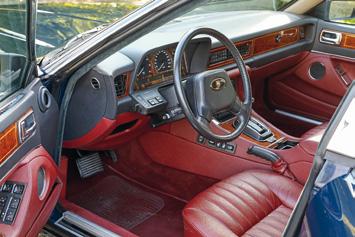 Chassis # SAJJHALD4AJ600716
Chassis # SAJJHALD4AJ600716


This Jaguar of the XJ40 series was delivered to its first owner by Garage Epper in Lucerne on the 30th of October 1989. As shown in the emission control document, the beautiful saloon, having been driven 582 kilometres only, was taken over by its second owner most probably in 1992. He kept the car for more than 20 years until 2013 but used it very little. The Jaguar then spent two years in the collection of a Jaguar specialist before being sold to the vendors family in September 2015. After the sale and despite only 15,000 kilometres driven, the Jaguar received an extensive “refreshing” for around 10’000 (documented) Swiss francs. Forming part of a large collection, the Sovereign was little used over the recent years but always well maintained. For its last Veteran MOT, which was completed in October 2021, the rear (self-levelling) dampers which aren‘t available any longer were converted by Emil Frey Classics to conventional dampers together with new springs. With now roughly 15’800 kilometres driven, this Jaguar is in an exceptional condition, worthy of any quality collection and a similarly good example will most probably be impossible to find.

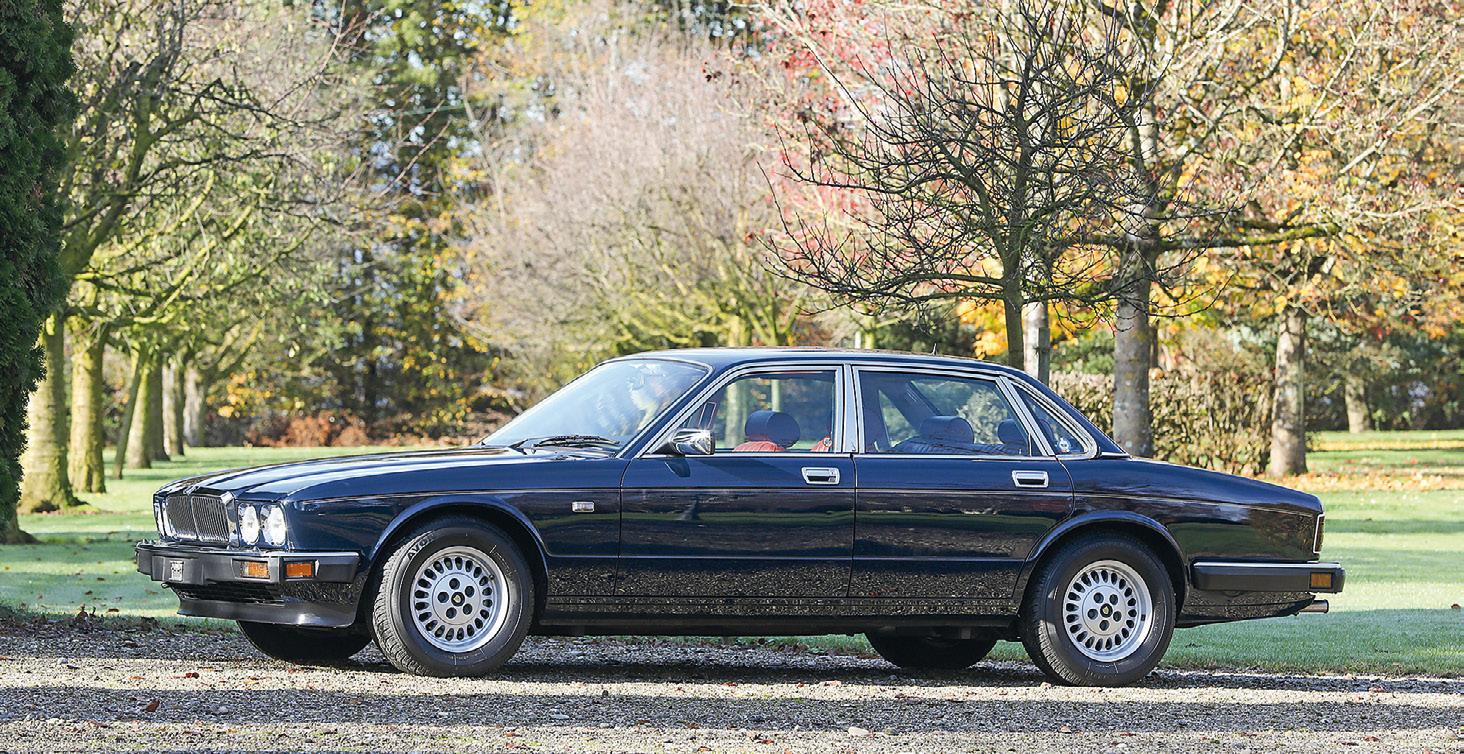
Dieser Jaguar der Baureihe XJ40 wurde am 30. Oktober 1989 durch die Garage Epper in Luzern an den Erstbesitzer übergeben. Wie das Abgas-Wartungsdokument zeigt, wurde die schöne Limousine wohl 1992 – mit damals erst 582 gefahrenen Kilometern – vom zweiten Halter übernommen. Dieser hielt dem Jaguar bis 2013 die Treue, nutzte ihn aber offensichtlich sehr wenig. Anschliessend verbrachte der Wagen rund 2 Jahre im Bestand eines Jaguar Spezialisten, bevor er im September 2015 von der Familie des Einlieferers übernommen wurde. Nach dem Kauf erfolgte, trotz erst gut
15‘000 gefahrenen Kilometern, eine umfangreiche Aufbereitung – Belege für knapp CHF 10‘000.- sind vorhanden. Als Teil einer grossen Sammlung wurde der Sovereign auch die letzten Jahre nur wenig gefahren jedoch stets gut gewartet. Für die letzte MFK als Veteranenfahrzeug im Oktober 2021 wurden die nicht mehr erhältlichen hinteren Stossdämpfer mit Niveauregulierung durch die Spezialisten von Emil Frey Classics auf konventionelle Stossdämpfer mit neuen Federn umgerüstet. Mit erst knapp 15‘800 gefahrenen Kilometern befindet sich dieser Jaguar in einem einmaligen Sammlerzustand und es dürfte nahezu unmöglich sein, ein vergleichbares Fahrzeug zu finden.
Cette Jaguar de la série XJ40 a été livrée à son premier propriétaire par le Garage Epper à Lucerne le 30 octobre 1989. Comme le montre le document de contrôle des émissions, la belle berline, n‘ayant parcouru que 582 kilomètres, a été reprise par son deuxième propriétaire très probablement en 1992. Il a conservé la voiture pendant plus de 20 ans, jusqu‘en 2013, mais l‘a très peu utilisée. La Jaguar a ensuite passé deux ans dans la collection d‘un spécialiste Jaguar avant d‘être vendue à la famille du vendeur en septembre 2015. Après la vente et malgré seulement 15‘000 kilomètres parcourus, la Jaguar a reçu un „rafraîchissement“ complet pour environ 10‘000 francs suisses (documentés). Faisant partie d‘une grande collection, la Sovereign a été peu utilisée ces dernières années mais toujours bien entretenue. Pour sa dernière expertise vétéran, qui a été effectué en octobre 2021, les amortisseurs arrière (autonivelants), qui ne sont plus disponibles, ont été convertis par Emil Frey Classics en amortisseurs conventionnels avec de nouveaux ressorts. Avec maintenant environ 15‘800 kilomètres parcourus, cette Jaguar est dans un état exceptionnel, digne de toute collection de qualité et un exemple aussi bon sera très probablement impossible à trouver.

21
Lot 106 7‘646 cars
in-line 6 cylinder 3‘978 cc 226 hp at 4‘750/min Estimate CHF 12‘000 - 18‘000 at no reserve
( 1989)
Photos zwischengas.com
1996 Bentley Continental T
The determination to leave no gap in their range of luxury high performance cars was the driving force to diversify by adding one more Driving Force. Performance and handling of the 1996 Bentley Continental T were without equal. As regards torque: 590 lb/ft (800Nm; from 1997 650 lb/ft 875Nm) positioned this car at the top. There existed no other passenger motor car in the world which came even near this figure - with one exception, the Bentley Turbo R Sport‘s engine delivered 553 lb/ft. The Bentley Continental T was a 2+2 coupé developed from the Bentley Continental R with a more athletic outward appearance due to a 4 in (10 cm) shorter wheelbase and extended front and rear wheel arches.
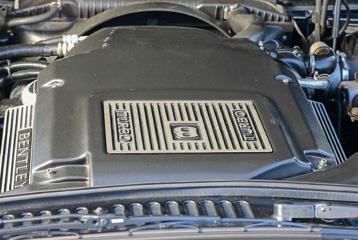
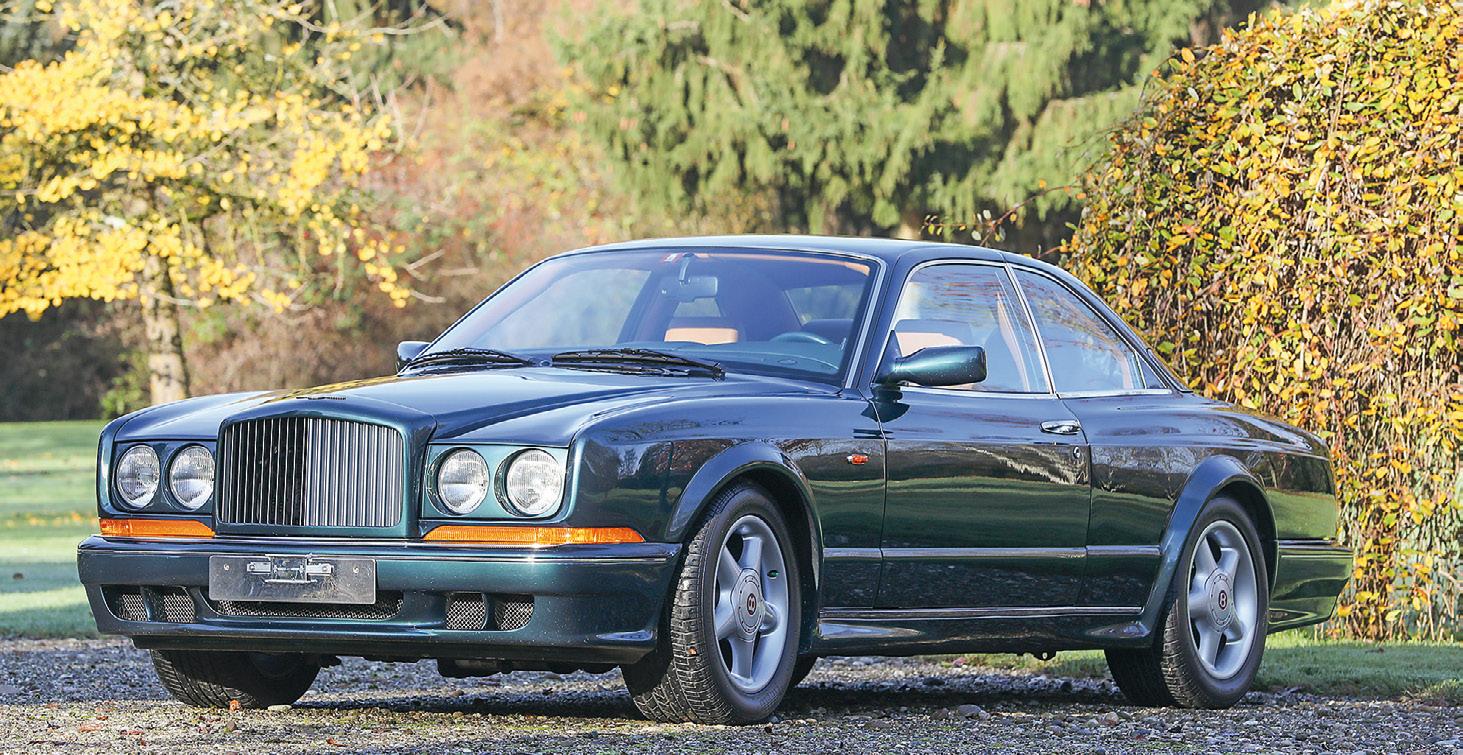
The driver found an engine-turned dash with chrome finish instruments as a delicate reminiscence of the heyday of the British Racing Green Bentleys handled with verve by the ‚Bentley Boys‘ - and as it had been during these heroes‘ time the Continental T‘s engine responded to a separate push-button starter.
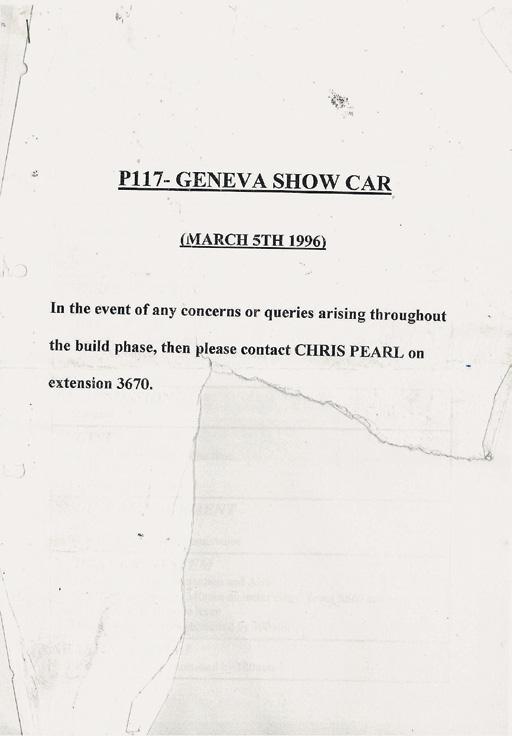
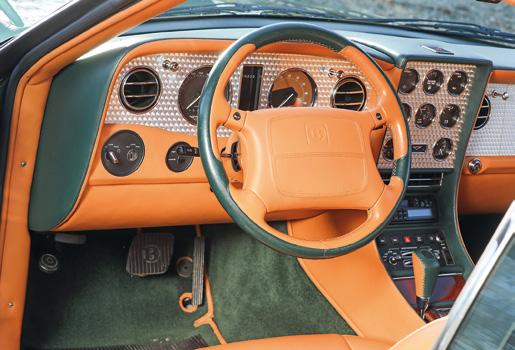
The Continental T, with its 6.75 litre V8 turbo engine delivering a monumental 405 hp and 800 Newton metres torque - no other series produced automobile then delivered more - was, with a new price north of 400’000 francs in 1996, one of the most exclusive luxury Coupés of its time. The car offered, bearing chassis number 53136, was initially assembled as a normal Continental R but converted during production into a T-specification model, (project P117) and consequently displayed at the Geneva Salon in March 1996
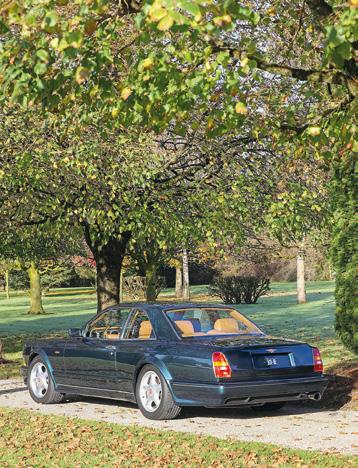
22 www.TheSwissAuctioneers.swiss
Chassis # SCBZB20C0TCX53136
Lot 107 322 cars turbocharged V8 6‘749 cc 405 hp at 4‘000/min Estimate CHF 140‘000 - 160‘000 Story rrab.com Photos zwischengas.com
as a pre-production example. The gorgeous coupe was then delivered to British Motors in Monaco and bought by Peter F. Baumberger from Gstaad who had the Bentley returned to Switzerland and first registered here on the 26th of April 1996. After Baumberger‘s demise, the Bentley was purchased from a dealer in 2010 with just under 63‘000 kilometres on the clock and was subsequently extensively refurbished. In 2016, then showing 65’000 kilometres, the car found its way into the vendors’ family collection. With now 66’000 kilometres driven and the last major service completed in March 2022, the Bentley is in very good and well-maintained original condition and will be sold with the most recent MOT from October 2022. Surely an unique opportunity to acquire an exceedingly rare pre-production example (you could even call it a prototype) of the legendary luxury brand from Crewe.
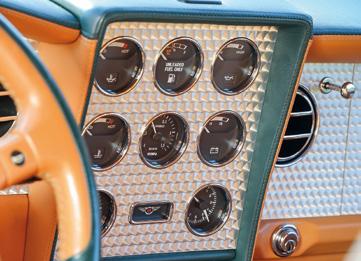
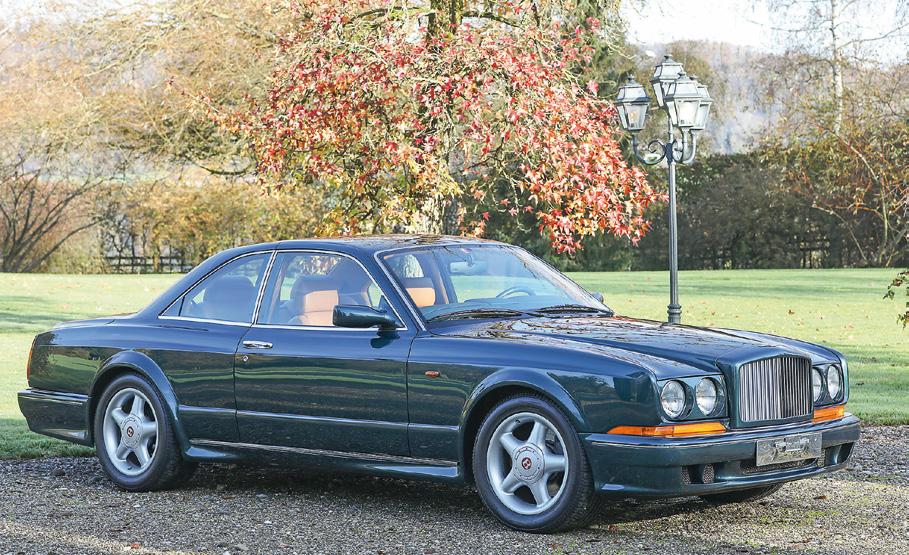


Der 1996 vorgestellte Continental T mit 6.75-Liter V8 Turbomotor, 405 PS und gewaltigen 800 Nm Drehmoment – mehr hatte bis dato noch kein Serienfahrzeug auf die Kurbelwelle gestemmt – war mit einem Neupreis von jenseits der 400‘000 Franken eines der exklusivsten Luxuscoupés seiner Zeit. Das angebotene Fahrzeug mit Chassis-Nummer 53136 startete in der Produktion als «normaler» Continental R, doch noch während der Fertigung wurde das grüne Coupé auf T-Spezifikationen aufgerüstet (Projekt P117) und schliesslich am Genfer Automobilsalon im März des Jahres 1996 als Vor-Serienfahrzeug ausgestellt. Danach wurde das wunderschöne Coupé an British Motors in Monaco geliefert und dort von Peter F. Baumberger aus Gstaad erworben, wieder in die Schweiz gebracht und am 26. April 1996 erstmals zugelassen. Nach Baumbergers Tod wurde der Bentley 2010 mit knapp 63‘000 gefahren Kilometern von einem Händler erworben und in der Folge aufwändig aufbereitet. 2016 schliesslich, mit 65‘000 Kilometern auf der Uhr, wurde der Continental T in die Sammlung der Einliefererfamilie aufgenommen und durfte fortan ein beschauliches Leben in guter Gesellschaft verbringen. Mit nun 66‘000 gefahren Kilometern und dem letzten Service im März 2022 befindet sich das Fahrzeug in sehr gutem und gepflegtem Originalzustand, und wird mit der letzten MFK im Oktober 2022 an einen neuen Liebhaber übergeben. Hier bietet sich die einmalige Gelegenheit ein äusserst seltenes Vor-Serienfahrzeugman könnte es auch Prototyp nennen - der Luxusmarke aus Crewe zu erwerben.

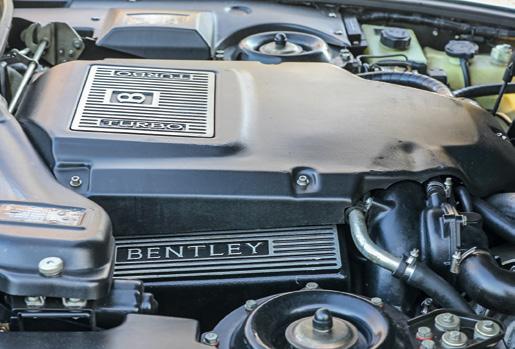
La Continental T, avec son moteur V8 turbo de 6.75 litres délivrant une puissance de 405 ch et un couple monumental de 800 Newton-mètre - aucune autre automobile de série n‘en délivrait davantage à l‘époque - était, avec un prix dépassant les 400‘000 francs en 1996, l‘un des coupés de luxe les plus exclusifs de son époque. La voiture proposée, portant le numéro de châssis 53136, a été initialement assemblée en tant que Continental R normale, mais transformée au cours de la production en un modèle de spécification T (projet P117) et exposée par conséquent au Salon de Genève en mars 1996 en tant qu‘exemple de pré-production. Le superbe coupé a ensuite été livré à British Motors à Monaco et acheté par Peter F. Baumberger de Gstaad qui a fait revenir la Bentley en Suisse et l‘a fait immatriculer ici le 26 avril 1996. Après le décès de Baumberger, la Bentley a été achetée par un concessionnaire en 2010 avec un peu moins de 63‘000 kilomètres au compteur et a ensuite été largement remise à neuf. En 2016, la Bentley, qui affichait alors 65‘000 kilomètres, a trouvé sa place dans la collection familiale du vendeur. Avec maintenant 66‘000 kilomètres parcourus et le dernier service majeur effectué en mars 2022, la Bentley est dans un très bon état d‘origine bien entretenu et sera vendue avec l’expertise effectuée en octobre 2022. Il s‘agit certainement d‘une occasion unique d‘acquérir un exemple de pré-production extrêmement rare (on pourrait même l‘appeler un prototype) de la marque de luxe légendaire de Crewe.
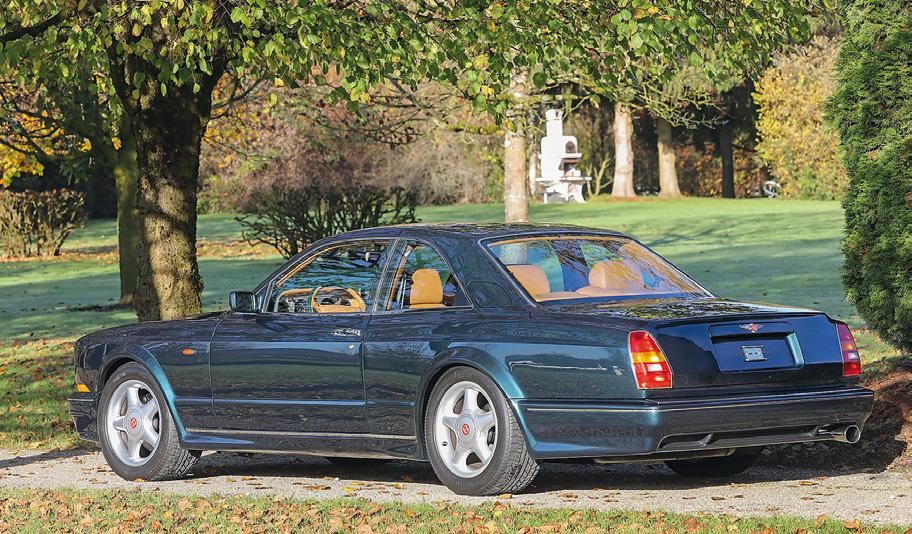
23
1953 Jaguar XK 120 SE Drop Head Coupe
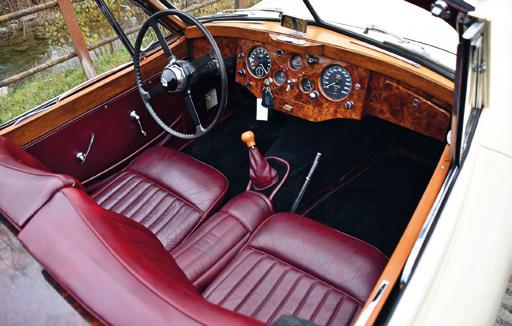
Chassis # S677023
It has been said that for many on hand for the 1948 London Motorshow were simply flabbergasted by the new Jaguar XK 120 that combined jaw-dropping beauty and promised astonishing performance in equal parts. Although the swooping and curvaceous styling—strongly influenced by Jaguar boss William Lyons—showed influences of the prewar BMW 328, it was still fresh and exciting.
The alloy bodywork clothed a sturdy chassis, which mated torsion bar independent front suspension to a live rear axle on leaf springs. It wasn’t revolutionary, but it was up to date, complete with large hydraulic drum brakes at all four corners. What was revolutionary, was the inline double-overhead-camshaft six cylinder engine displacing 3.4 liters and rated at 160 bhp. All that power was channeled aft via a four-speed manual gearbox. Said to be capable of 120mph, the XK 120 moniker was logical. For the day, the new Jaguar was extremely quick, capable of sprinting from 0 to 60 mph in less than 10 seconds.
Priced at $3,940 in the United States, performance was on a par with much more exotic machines costing twice as much. In addition to that undeniably gorgeous coachwork, the Jaguar was opulently trimmed with fine leather and carpet. Weather equipment wasn’t so fine, including a folding convertible top that kept out some of the elements when mated to removable side curtains that stowed when not in use. Standard equipment included steel-wheels with chrome and body color hubcaps and full rear wheel spats that only enhanced the XK 120 Jag’s stunning good looks. Wire wheels were one of the relatively few options.
Originally intended as a limited-production model to raise interest in a new series of sedans powered by the
same XK six-cylinder engine, orders for the Jaguar XK 120 immediately exceeded production capacity. The decision was quickly made to replace the alloy over ash body with an all-steel body sharing the same seductive shape, a change that was implemented after the first 240 cars left Jaguar’s Browns Lane factory.
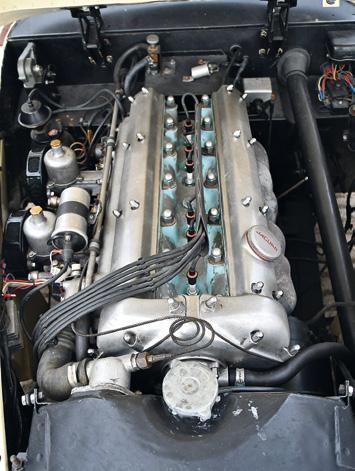

From the very beginning, the new Jaguar was taken racing and rallying with great success. Developments were gradual and subtle, including new integrated parking lights in 1951—the same year a lovely fixed-head coupe joined the family—and footwell air vents in 1952. The following year saw yet another model, in the form of a drophead coupe complete with roll-up windows and a more comprehensive top. Performance wasn’t ignored either, with the introduction of the Special Equipment or “M” model. This performance version used an uprated 180 horsepower engine exhausting through dual pipes and invariably riding on wire wheels.
Fast, beautiful and successful on the race track, to many the Jaguar XK 120 was the ultimate production sports car of the 1950s. The public clearly thought so, as 12,078 XK 120s were sold, which was far beyond the company’s wildest expectations.
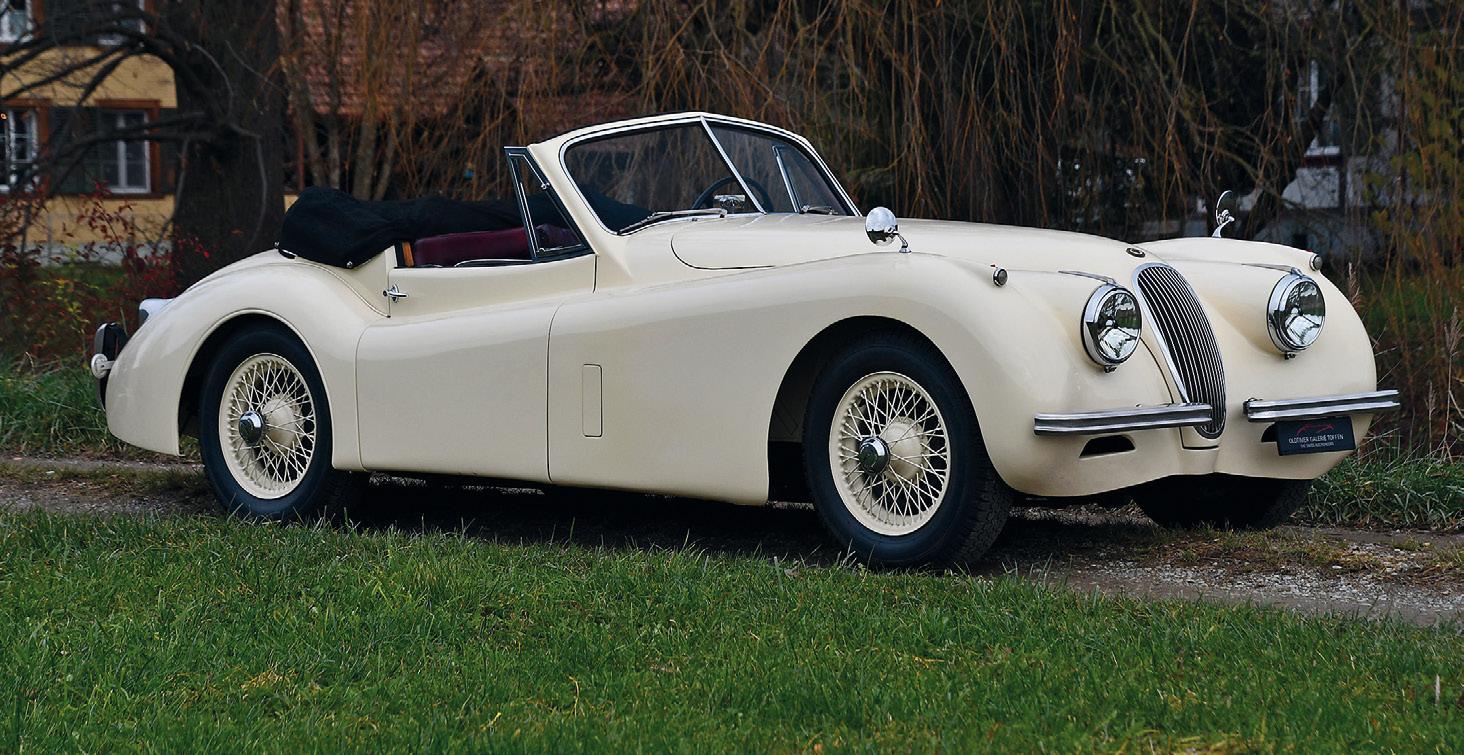
24 www.TheSwissAuctioneers.swiss
Lot 108 1‘472 cars (DHC, LHD) in-line 6 cylinder 3‘342 cc 180 hp at 5‘300/min Estimate CHF 75‘000 - 85‘000
Story hagerty.com
Photos Oldtimer Galerie
As one of 1’472 LHD cabriolets, this XK 120 was completed on the 20th of March 1953 and delivered to Max Hoffman in New York on the 31st of the same month. During its time in the USA, the Jaguar was repainted from the original Birch Grey to the current Beige, and the engine block was replaced with a correct 3.4 litre unit from a Mk1 saloon. In the early 80s the car was imported into Switzerland and, probably due to reading error, registered as a 1951 model. Towards the end of the 1980s the Jaguar was acquired by the vendor and used for occasional excursions. In 1998, he decided to have the lovely cabriolet restored, a task which took four years, until 2002, to complete. The coachwork was completely restored and repainted, the interior received a partial restoration, the dashboard was reworked, the instruments overhauled as necessary, and a new soft top was installed. The engine received new big-end and conrod bearings and the cylinder head was overhauled with new valves and valve guides. After completion, the Jaguar was driven only very sparingly, leading to further repairs necessary to successfully pass the most recent MOT inspection. These included a complete brake overhaul with the replacement of all four brake drums and wheel hubs and an overhaul of the steering system. The carburettors were overhauled, and the suspension received new bushings and new rear dampers. Pictures and receipts of all the restoration work are available. We are happy to offer an XK 120 from a 30-year ownership in very good condition and with the last Veteran MOT completed in October 2021.
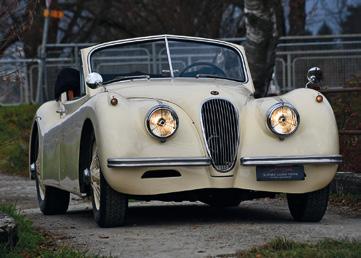
Als eines von 1‘472 gebauten Cabriolets mit Linkslenkung, wurde dieser XK 120 am 20. März 1953 gebaut und am 31. des Monates an Maxi Hoffman nach New York geliefert. Während seiner Zeit in den USA wurde der Jaguar Birch Grey auf das aktuelle beige umlackiert und der Motorblock wurde durch ein baugleiches Exemplar aus einer 3.4-Liter Mk1 Limousine ersetzt. Anfang der 1980er Jahre wurde das Fahrzeug in die Schweiz importiert und bei der Zulassung hier wurde, wohl aufgrund eines Lesefehlers, 1951 als Zulassungsjahr notiert. Ende der 1980er wurde der Jaguar vom Einlieferer erworben und für gelegentliche Ausfahrten genutzt. 1998 entschied sich dieser, das schöne Cabrio restaurieren zu lassen – es wurden 4 Jahre bis zur Vollendung 2002 benötigt. So wurde die Karosserie komplett restauriert und neu lackiert, die Innenausstattung erhielt eine Teilrestauration, das Armaturenbrett wurde ebenfalls restauriert, die Instrumente wenn nötig revidiert, es wurde ein neues Verdeck montiert, der Motor erhielt neue Pleuel- und Hauptlager und der Zylinderkopf wurde mit neuen Ventilen und Ventilführungen komplett revidiert. Nach der Fertigstellung wurde der Jaguar erneut nur sehr wenig gefahren – so bestand für die letzte MFK aufgrund von Standschäden erneut Handlungsbedarf. Die Bremsen

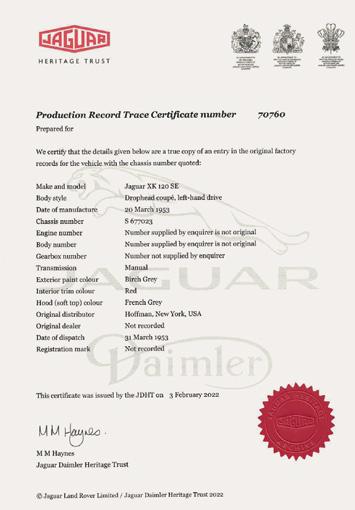
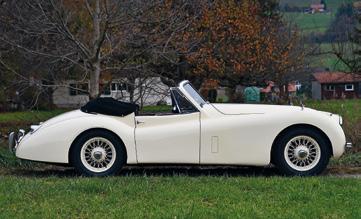
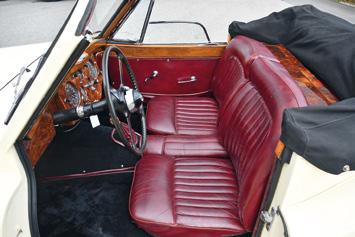

wurden komplett revidiert, alle 4 Bremstrommeln – wie auch alle 4 Radnaben – wurden ersetzt, die Lenkung sowie die Vergaser wurden revidiert und die Aufhängung wurde mit neuen hinteren Stossdämpfern und neuen Lagerbüchsen überholt. Die entsprechenden Belege sowie Fotos der Restauration sind vorhanden. Hier steht also ein XK 120 aus über dreissigjährigem Besitz, in sehr gutem Zustand und mit der letzten MFK als Veteranenfahrzeug im Oktober 2021 zum Verkauf.
Cette XK 120, l‘une des 1‘472 cabriolets avec conduite à gauche, a été produite le 20 mars 1953 et livrée vers Max Hoffman à New York le 31 du même mois. Pendant son séjour aux Etats-Unis, la Jaguar a été repeinte du „Birch Grey“ d‘origine au beige actuel, et le bloc moteur a été remplacé par une unité correcte de 3.4 litres provenant d‘une berline Mk1. Au début des années 80, la voiture a été importée en Suisse et, probablement à cause d‘une erreur de lecture, elle a été enregistrée comme un modèle de 1951. Vers la fin des années 80, la Jaguar a été acquise par le vendeur et utilisée pour des excursions occasionnelles. En 1998, il a décidé de faire restaurer le joli cabriolet, une tâche qui a pris quatre ans, jusqu‘en 2002, pour être achevée. La carrosserie a été entièrement restaurée et repeinte, l‘intérieur a reçu une restauration partielle, le tableau de bord a été retravaillé, les instruments ont été révisés si nécessaire, et une nouvelle capote a été installée. Le moteur a reçu de nouveaux paliers principaux, de nouveaux coussinettes de bielles et la culasse a été révisée avec de nouvelles soupapes et de nouveaux guides de soupapes. Après l‘achèvement des travaux, la Jaguar n‘a été conduite que très rarement, ce qui a conduit à d‘autres réparations nécessaires pour passer avec succès la dernière expertise. Celles-ci comprenaient une révision complète des freins avec le remplacement des quatre tambours de frein et des tous les moyeux de roue, ainsi qu‘une révision du système de direction. Les carburateurs ont été révisés, et la suspension a reçu de nouvelles bagues et de nouveaux amortisseurs arrière. Les photos et les reçus de tous les travaux de restauration sont disponibles. Nous sommes heureux d‘offrir une XK 120 provenant d‘une propriété de 30 ans en très bon état et avec la dernière expertise vétéran effectuée en octobre 2021.
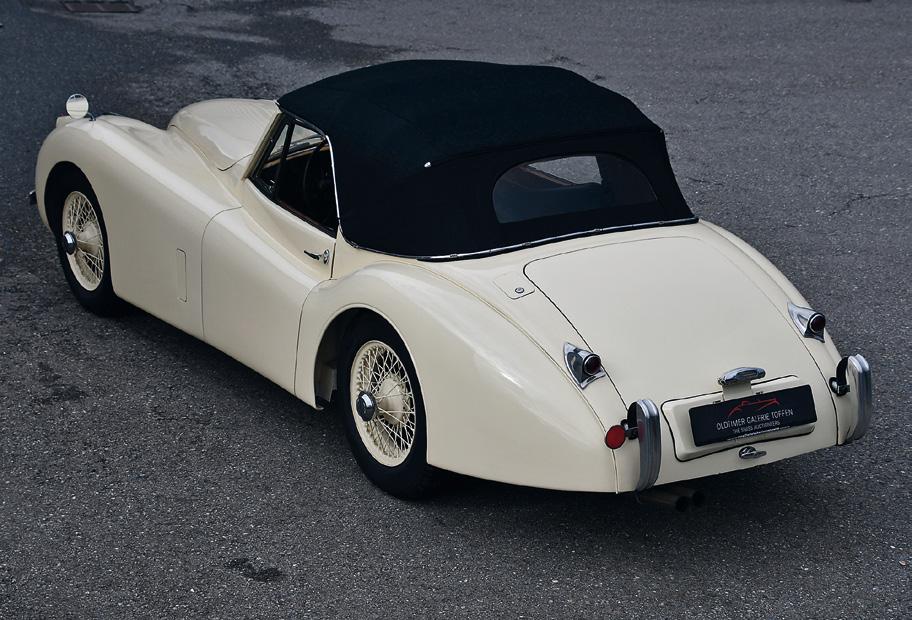
25
1956 Cadillac Series 62 Sedan de Ville
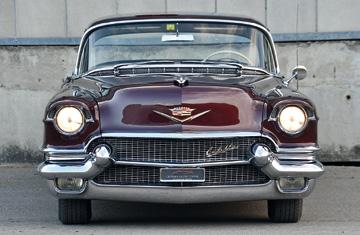
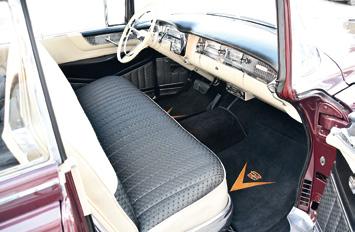
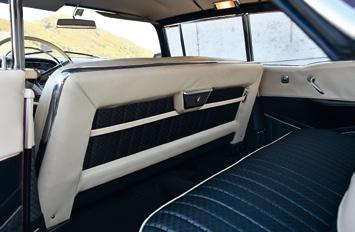

Chassis # 5662067655
General Motor‘s top-of-the-line Cadillac Division was rightly advertised as the ‚Standard of the World,‘ having reached the summit of America‘s fine car market during 1947 when it outsold its archrival Packard by nearly 11‘000 units. A year later, Cadillac sales reached nearly 96‘000 units with orders awaiting fulfillment. This success and enthusiasm for the Cadillac models were fueled by the stylistic talents of GM Design Chief Harley Earl and his team, and the new-for-1948 body designs inspired by Earl‘s fascination with the futuristic shape of Lockheed‘s P-38 Lightning fighter aircraft of World War II fame. The 1948 models hold the distinction of being Cadillac‘s first application of tailfins, which remained a hallmark of GM‘s luxury division for over a dozen years.
The captivating designs were equally matched by its engineering prowess, led by a powerful new overheadvalve V-8 engine introduced for 1949. Initially displacing 331 cubic-inches and offering 160 horsepower,.
During the early 1950s, the General Motors division promoted its vehicles and futuristic endeavors with the lavish Motorama traveling shows. In 1952, Cadillac introduced its daring El Dorado Golden Anniversary concept convertible, and little changed by the time it was put into production for 1953 as the Series 62 model. Early that year, the fame of the Eldorado nameplate was taken to new heights with its high-profile use transporting U.S. President Dwight D. Eisenhower to his inaugural ceremonies.
On October 24th of 1955, Cadillac introduced its new Series 62 Sedan DeVille four-door hardtop and the top-line Eldorado Seville two-door hardtop, nearly a month before the rest of its models debuted for 1956.
For 1956 the Cadillac Series 62 was restyled, with changes appearing throughout the vehicle. A new grille could now be found in the front and repositioned bumper lights now resting within the bumper. The Eldorado series of the Model 62 line-up consisted of a two-door Hardtop Coupe Seville and the convertible Biarritz. Both had two doors and seating for six. The base price was well above the regular Series 62, costing a hefty $6‘500. The base Series 62, in comparison, cost $4‘150. A total of 3‘900 buyers selected the Eldorado Hardtop Coupe Seville and 2,150 purchased the Eldorado Convertible Biarritz. The most popular body style in the Series 62 lineup was the four-door Sedan DeVille which saw 41‘732 examples produced.
Several of the styling cues previewed at the GM Motorama shows were placed into production. The El Camino and La Espada show cars of the 1954 Motorama season had a profound effect on the 1956 Eldorado‘s style and contributed its angled ‚gullwing‘ front bumpers and angular tailfins.
The Cadillac V-8 engine received its first displacement increase to 365 cubic inches by 1956 and horsepower rose to 285 for the standard Cadillac lines. The engine
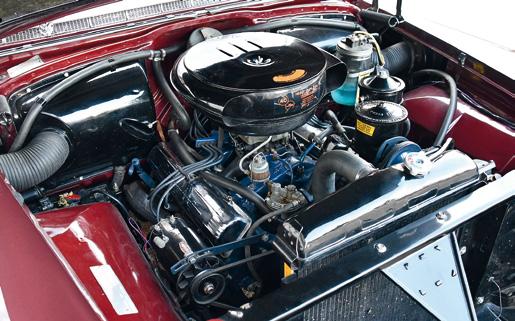
26 www.TheSwissAuctioneers.swiss
Lot 109 41‘732 cars (1956) V8 5‘972 cc 285 SAE hp at 4‘600/min Estimate CHF 55‘000 - 65‘000 Story conceptcarz.com
Photos Oldtimer Galerie
was backed by GM‘s Hydra-Matic four-speed automatic transmission that benefited from improvements developed at a cost of $35 million. These well-equipped vehicles came with many standard features including a six-way power front seat and power-operated windows.

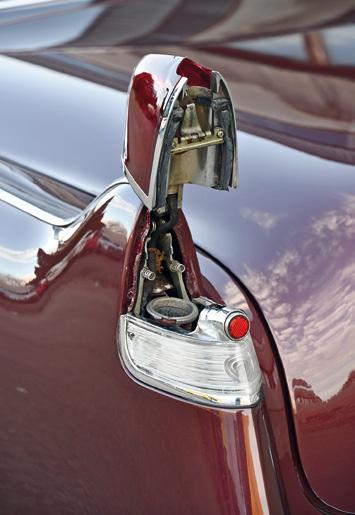
Despite the rather steep price tag, the demand for Cadillacs was strong and the company moved from 10th to 9th position in American sales rankings for 1956.


zeigt der Fahrzeugausweis den 27. Oktober 1964 als erste Inverkehrsetzung. 1982 wurde der Cadillac mit nur einem eingetragenen Halter von einem absoluten Markenliebhaber und -kenner übernommen und anschliessend in Eigenleistung restauriert. Hierbei wurde der Wagen vom ursprünglichen Schwarz in das aktuelle – Chantilly Maroon genannte – Dunkelrot umlackiert. In den folgenden Jahren wurde das Fahrzeug akribisch und liebevoll gewartet, so wurden unter Anderem 2001 der Motor revidiert und 2008 ein neuer Kabelbaum verlegt. Ein umfangreiches Dossier mit Belegen und Notizen zeugt von der Liebe zum Fahrzeug. Im November 2016 wechselte der Cadillac zum dritten Besitzer, welcher den Wagen neu lackieren liess und ihn 2021 an den letzten eingetragenen Halter veräusserte. Nach nahezu vierzig Jahren seit der Restaurierung, präsentiert sich der Sedan de Ville in aussergewöhnlich schönen und guten Zustand. Die letzte MFK als Veteranenfahrzeug erfolgte im Mai 2021.

This imposing Cadillac left the Detroit works on 29th February 1956 to be exported to the dealers Ramuz & Edelweiss in Lausanne. When the owner moved from Lausanne to Geneva the authorities erroneously changed the first registration date in the cars registration document to 27th October 1964. In 1982 the Cadillac was taken over from its first owner by an absolute Cadillac lover and specialist and consequently restored by himself. During the restoration the car was repainted from its original black to the current Chantilly maroon (dark red). In the following years, the car was impeccably and most carefully maintained. In 2001 the engine was overhauled and in 2008 a new wiring loom was installed. A very extensive file with countless receipts and notes testifies the loving care the car received. In November 2016 the Cadillac was taken over by a third owner who had it repainted and in 2021 it arrived with its last registered owner. In spite of close to 40 years since its restoration the Sedan Deville is in exceptionally beautiful condition. The last veteran MOT was completed in May 2021.
Dieser imposante Cadillac verliess am 29. Februar 1956 das Cadillac Werk Detroit in Richtung des Händlers Ramuz & Edelweiss in Lausanne. Beim Umzug des Erstbesitzers von Lausanne nach Genf wurde durch die Behörden irrtümlich das Ausstelldatum des neuen Ausweises auch gleich als Erstzulassung notiert – daher

Cette imposante Cadillac a quitté l‘usine de Détroit le 29 février 1956 pour être exportée chez les concessionnaires Ramuz & Edelweiss à Lausanne. Lorsque le propriétaire a déménagé de Lausanne à Genève, les autorités ont changé par erreur la date de première immatriculation dans la carte grise de la voiture au 27 octobre 1964. En 1982, la Cadillac a été reprise de son premier propriétaire par un amateur et spécialiste absolu de Cadillac et a été restaurée par lui-même. Pendant la restauration, la voiture a été repeinte de son noir d‘origine au «Chantilly Maroon» (rouge foncé) actuel. Dans les années suivantes, la voiture a été impeccablement et très soigneusement entretenue. En 2001, le moteur a été révisé et en 2008, un nouveau faisceau électrique a été installé. Un dossier très complet avec d‘innombrables reçus et notes témoigne des soins affectueux dont la voiture a bénéficié. En novembre 2016, la Cadillac a été reprise par un troisième propriétaire qui l‘a fait repeindre et en 2021, elle est arrivée chez son dernier propriétaire enregistré. Malgré près de 40 ans depuis sa restauration, la Sedan de Ville est dans un état exceptionnellement beau. La dernière expertise vétéran a été réalisée en mai 2021.

27
1987 Ferrari 412
Chassis # ZFFYD25B000070217
Following Ferrari practice, their numeric designations refer to their engines‘ single-cylinder displacement expressed in cubic centimetres. The 365 GT4 2+2 was introduced in 1972 to replace the 365 GTC/4. It then evolved into the 400, the first Ferrari available with an automatic transmission. In 1979 the 400 was replaced by the fuel injected 400 i. The improved 412 ran from 1985 to 1989, bringing to an end Ferrari‘s longest-ever production series.

Berlinetta. The Pininfarina-designed bodylines were crisply tailored and virtually unchanged through the evolutionary 400 and 400i (fuel injected) models of 1976 through 1984, culminating in 1985 with the 5.0-liter 412 which continued through 1989. This line was Ferrari‘s longest-running series, surviving for 17 years, and the 412 was the last front-engine Ferrari until the arrival of the 456 in 1992.
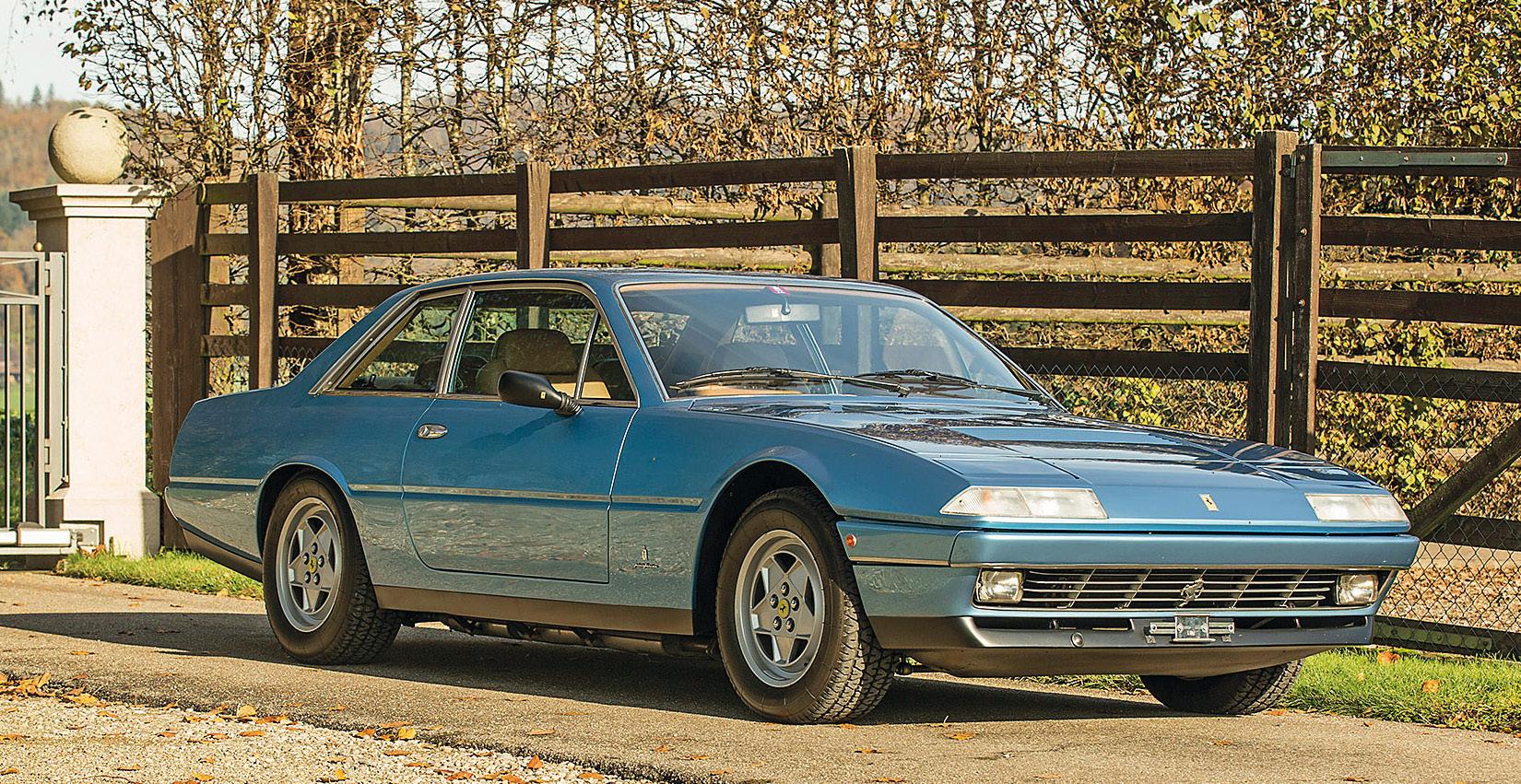
The 365 GT4, 400, and 412 were closely related, using the same chassis, body, and engine. Their numerical names were in reference to the engine‘s single cylinder displacement expressing cubic centimeters and therefore changed with each update to reflect the increased displacement. The engine of the 412 displaced 4,943cc and offered 340 rated horsepower. Transmission options included a five-speed manual or GM-sourced Turbo-Hydramatic 400 automatic. The 400GT had been the first Ferrari to offer an automatic transmission as an option, a decision vindicated by the fact that more than two-thirds of customers took up the option.
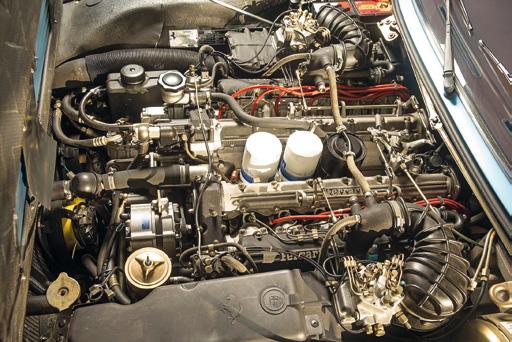
Although the option of an automatic transmission might imply it may have been designed for the American market, no version of these grand tourers was ever officially imported there as Enzo Ferrari believed that emerging environmental and safety regulations and a 55 MPH national speed limit suggested the company‘s 8 cylinder cars would suffice in the US market.
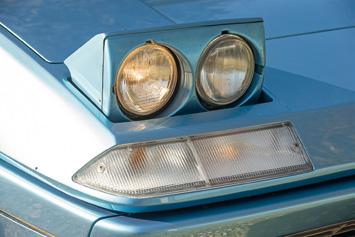
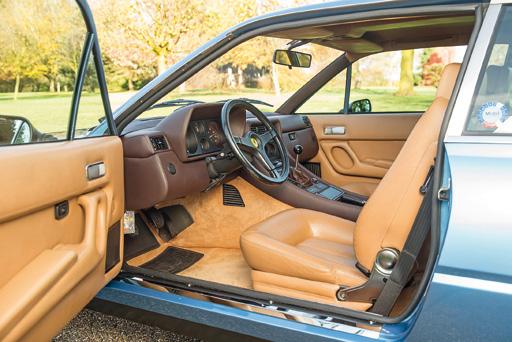
The Ferrari 365 GT4 2+2 replaced the curvaceous 365 GTC/4 in 1973. It was the company‘s new and highly luxurious four-seater that signaled an entirely new stylistic direction for Turin‘s Pininfarina design studio. In 1972, it made its public debut at Paris and utilized the basic mechanicals of the 365 GTB/4 ‚Daytona‘
Zero-to-sixty was achieved in 7.0 seconds with a top speed exceeding 150 mph.
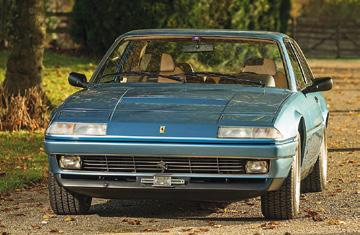
28 www.TheSwissAuctioneers.swiss
Lot 110 270 cars (5-speed, LHD) V12 4‘943 cc 325 hp at 6‘000/min Estimate CHF 90‘000 - 110‘000 Story conceptcarz.com
Photos Daniel Reinhard
Although the 412 was visually similar to the 400i it replaced, Pininfarina made several modifications throughout the vehicle. The side window trim was changed from chrome to black, and the flat-faced wheels were new and fitted with TRX tires. A raised rear deck allowed more luggage space, the bumpers were now body-colored, and there was a deep spoiler in the front. In the back, a black valance incorporated the fog lamps and exhaust pipes. Bosch ABS was available, a first for Ferrari. There was no longer badging to denote the transmission type fitted. Five-spoke alloy wheels were mounted on Rudge knock-off hubs (Cromodora alloy wheels were also a popular option). These luxurious grand tourers came standard with leather upholstery, electric windows, and air conditioning.
Turismo is in very good original condition with the last Veteran MOT completed in March 2019.
Wie das Ferrari Classiche Zertifikat zeigt, wurde dieser Ferrari 412 - eines von nur 270 gebauten Exemplaren mit Linkslenkung und 5-Gang Getriebe - 1987 gebaut, jedoch erst im Juli 1989 an Al Ajda Automotive nach Saudi Arabien ausgeliefert. Zu Beginn der 90er Jahre wurde das elegante Coupé vom damaligen Besitzer nach England überführt und dort zugelassen. Mit Wohnsitz in London und in der Schweiz, überführte dieser den 412er für die Servicearbeiten meist zu Loris Kessel in Grancia. 2011 schliesslich, führte er den Wagen mit damals 25‘856 gefahrenen Kilometern definitiv in die Schweiz ein. Vier Jahre, und nicht einmal 1‘000 Kilometer, später wurde der Ferrari in die Sammlung des Einlieferers aufgenommen. In der wunderschönen Farbkombination von «Azzurro Metallizzato» mit der Innenausstattung «Pelle Tabacco», Matching-Numbers und erst 27‘100 gefahrenen Kilometern, befindet sich der italienische Grand Tourismo in sehr gutem Originalzustand. Die letzte MFK als Veteranenfahrzeug erfolgte im März 2019.

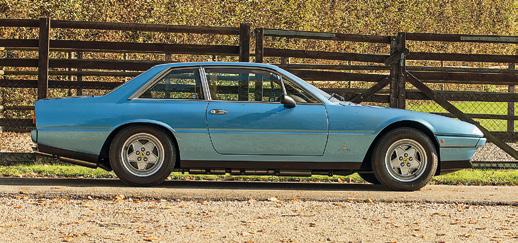

Comme le montre le certificat Ferrari Classiche, cette Ferrari 412, l‘un des 270 exemplaires construits avec conduite à gauche et boîte de vitesses manuelle à 5 rapports, a été construite en 1987 mais n‘a été livrée qu‘en 1989 à Al Ajda Automotive en Arabie Saoudite. Au début des années 90, l‘élégant Coupé a été emmené au Royaume-Uni par son propriétaire de l‘époque et enregistré avec des plaques britanniques. Ayant un domicile à Londres ainsi qu‘en Suisse, le propriétaire emmenait régulièrement la voiture chez Loris Kessel à Grancia pour les révisions. En 2011, alors qu‘elle affichait 25‘856 kilomètres, la voiture a été correctement importée en Suisse et enregistrée ici. Quatre ans plus tard, avec à peine 1‘000 kilomètres supplémentaires parcourus, la Ferrari a trouvé le chemin de la collection du vendeur et avec sa belle combinaison d‘“Azzuro Metallizzato“ avec l‘intérieur en „Pelle Tobacco“, les numéros correspondants et seulement 27‘100 kilomètres parcourus, cette quintessence de la Gran Turismo italienne est en très bon état d‘origine avec la dernière expertise vétéran effectuée en mars 2019.
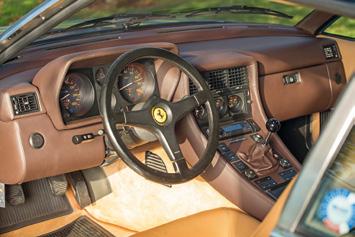
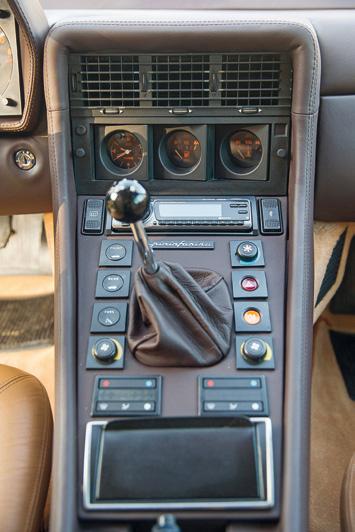

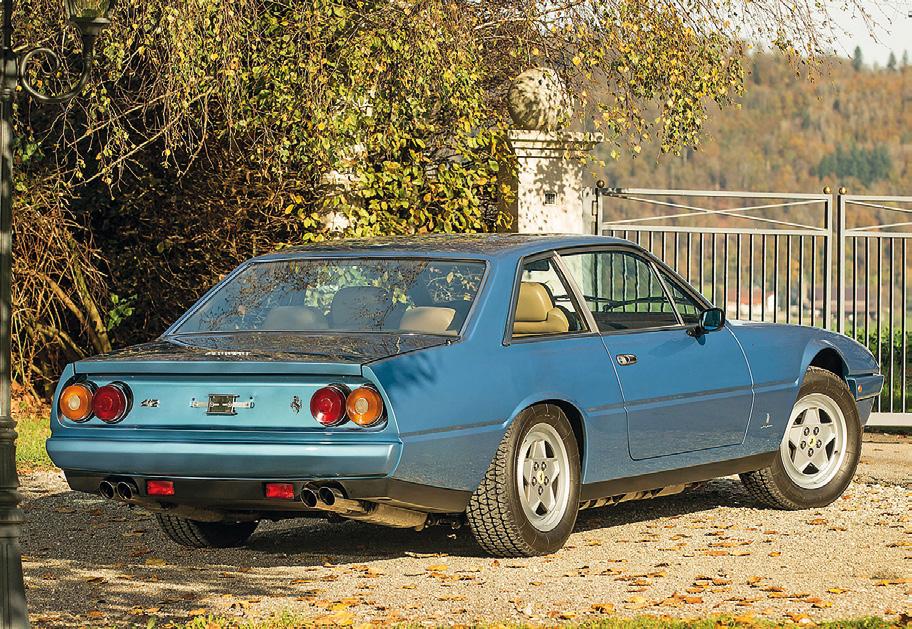
As shown in the Ferrari Classiche certificate, this Ferrari 412, one of only 270 examples built with left hand drive and manual 5 speed gearbox, was built in 1987 but only delivered in 1989 to Al Ajda Automotive in Saudi Arabia. At the beginning of the 90s, the elegant Coupé was taken to the UK by its then owner and registered with UK plates. Having a home in London as well as in Switzerland, the owner regularly took the car to Loris Kessel in Grancia for servicing. In 2011, then showing 25’856 kilometres, the car was properly imported into Switzerland and registered here. Four years later, with barely 1’000 additional kilometres driven, the Ferrari found its way into the vendors collection and with it‘s beautiful combination of “Azzuro Metallizzato” with the interior in “Pelle Tobacco”, matching numbers and only 27‘100 kilometres driven, this quintessential Italian Gran

29
1957 Facel Vega FV3
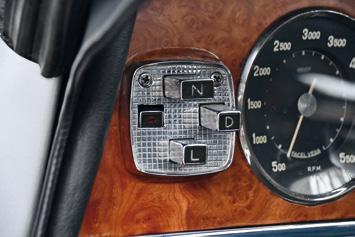

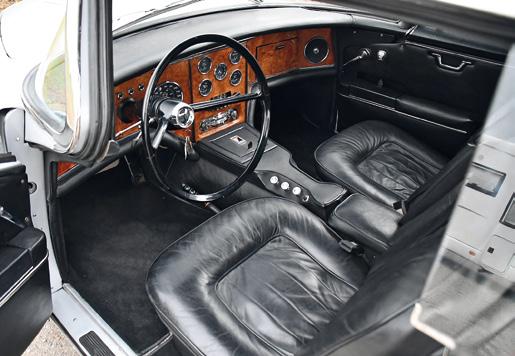 Chassis # FV357163
Chassis # FV357163
Facel was founded on 20 December 1939 by Bronzavia, a French manufacturer of military aircraft, to make special components. Marcel Koehler directed Facel from 1939 to 1945. He gave way to Jean Daninos when he returned from the United States, summoned by Henri Feuillée, the ex-boss of Bronzavia and a large shareholder of Facel. Jean Daninos had begun his career with Citroen, where he assisted in the design of the Traction coupés and cabriolets. He moved to Morane-Saulnier, then in 1937 to Bronzavia as technical director. During WWII he worked in the US with General Aircraft, which was using Bronzavia patents, but he returned in 1945 and took charge of Facel. Daninos merged Facel with Metallon, a tie maintained until January 1953.

Daninos had Facel begin manufacturing short-run and special complete finished bodies for the major French brands. In conjunction with l‘Aluminium Français Facel designed the all-aluminium alloy Panhard Dyna X and then built around 45‘000 examples for Panhard. The body work assembly division was established in 1948. It made various models of Simca Sport and drew publicity by designing with Farina and then building a special body on a Bentley Mark VI chassis. The car was named the Bentley Cresta. The exercise was repeated in 1951 and named Cresta II. September 1951 saw the introduction of its Ford Comète. Production of the Comète ended in 1955 when Simca took over Ford France. The styling of the Crestas and Comètes was developed into the shape of the first Vega.
The Facel Vega marque was created on 22 July 1954 by Jean Daninos, although the Facel company had been established by the Bronzavia Company in 1939 as a subcontracting company for the aviation industry. FACEL (Forges et Ateliers de Construction d‘Eure-et-Loir) was initially a metal-stamping company but it expanded into car manufacturing in the early 1950s. Facel entered the automobile business as a supplier of special bodies for Panhard, Delahaye and Simca. The company was headquartered in Paris at 19, Avenue George V, and had the main assembly factory in Colombes at 132 Boulevard de Valmy, with parts supplied from the outskirts of the city in Amboise, Dreux and Puteaux.

The Facel ‚Vega‘ was launched at the 1954 Paris Salon. By 1956, the cars were called FVS (for Facel Vega Sport), with earlier cars often being referred to as simply „FV“. The 1954 versions of the Facel were fitted with a DeSoto Firedome (Chrysler) 4.5 litre Hemi V8 engine, paired with either Chrysler‘s two-speed Powerflite automatic transmission or, at extra cost, a four-speed manual made by Pont-à-Mousson. At this stage, the 180 hp FV was capable of a top speed from

30 www.TheSwissAuctioneers.swiss
Lot 111 46 cars (FV3) V8 4‘539 cc 200 SAE-hp at 4‘400/min Estimate CHF 135‘000 - 145‘000 Story wikipedia.org
Photos Oldtimer Galerie
172 to 193 km/h, depending on which rear axle ratio was installed. The chassis, designed by Lance Macklin, was tubular framed, featuring coil springs and double wishbones at the front, with a leaf-sprung live rear axle. The styling, by Daninos himself, was somewhat American and perhaps a bit heavy, with rudimentary tail fins. The body was an expanded version of the earlier, Facel-bodied Simca/Ford Comète. An abundance of stainless steel brightwork was fitted.
The dashboard was aircraft-inspired, and one of the first to feature a middle console over the gearbox. The rear seats folded flat to provide a luggage platform and additional access to the boot. In 1955 the engine capacity increased to 4.8 litres and 200 hp (FV1), which later in the year grew to 250 hp (FV2). 47 of these early FVs were built in 1954 and 1955. Six were convertibles, but as these suffered from rigidity troubles the rest of the large two-door Facels were pillarless coupés. The 1956 FVS featured a panoramic windshield. Sometimes referred to as FV2, the car featured the same engine as in the later FV1s. Subsequently the 5.4-litre FV2B appeared, with 255 hp. Later versions offered a three-speed automatic, and disc brakes were available from 1958. At some point a reworked, more harmonious front end was introduced, featuring what looked like twin stacked headlights but what were actually headlamps on top and auxiliaries beneath. Power steering and power brakes were both standard as of 1957. For 1958, the engine grew to 5.8 litres (FV4) and 325 hp, although the earlier 4.5 and a 4.9 (FV3/FV3B) were also listed as available. In total, 357 FVs and FVSs were built.
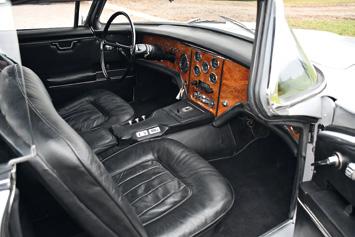
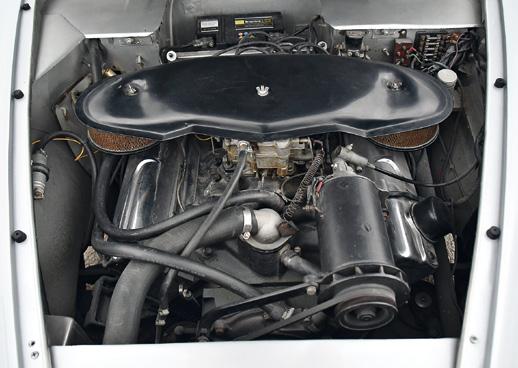
Facel-Vega war zu seiner Zeit ein Geheimtipp unter den oberen Zehntausend. Eine äusserst elegante und Detailreiche Karosserie aus französischer Fertigung gepaart mit robuster amerikanischer Grossserientechnik machte den Facel zum Exoten unter den Exoten. Bei diesem Exemplar handelt es sich um einen FV3 mit 4.5-Liter Chrysler V8 und automatischem Getriebe mit DruckknopfBetätigung. Zwischen November 1956 und September 1957 wurden gerade einmal 46 Fahrzeuge dieses Typs hergestellt. Das schöne Coupé wurde vor einigen Jahren aus den USA importiert wo, zu Gunsten einer besseren Bremsleistung Scheibenbremsen des späteren Modells HK 500 montiert worden wurden. Die Innenausstattung wurde vor einigen Jahren restauriert und das gigantische Armaturenbrett mit seiner auflackierten Holzmaserung (Trompe-l’œil) erinnert an ein Sportboot der damaligen Zeit. Kürzlich erhielt der FV3 eine Neulackierung sowie eine neue Frontscheibe. Somit befindet sich der äusserst seltene Franzose in sehr gutem Allgemeinzustand und wird mit der letzten MFK als Veteranenfahrzeug im Mai 2019 an einen neuen Besitzer übergeben.
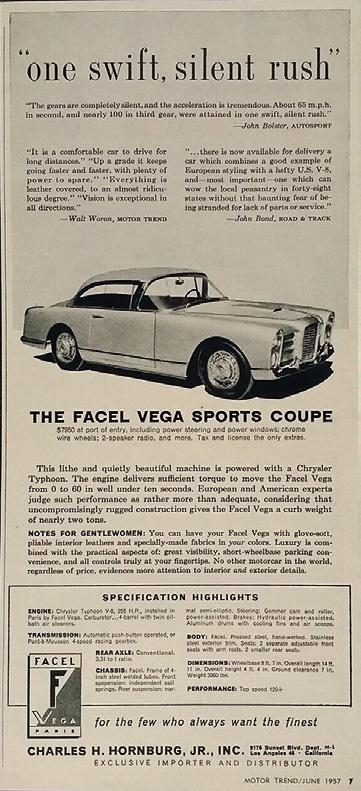

Les Facel Vega GT françaises étaient un secret bien gardé parmi les riches et célèbres de leur époque. Une carrosserie française extrêmement élégante, pleine de petits détails passionnants, combinée à des composants techniques puissants et fiables provenant des États-Unis, font de la Facel „l‘exotique parmi les exotiques“. Cet exemple est une FV3 avec un V8 Chrysler de 4.5 litres et une boîte de vitesses automatique à bouton-poussoir. Entre novembre 1956 et septembre 1957, seuls 46 exemplaires de ce type ont été produits. Ce magnifique coupé a été importé des Etats-Unis il y a quelques années, où, afin d‘améliorer les performances de freinage, des freins à disque d‘un modèle ultérieur HK500 avaient été installés. L‘intérieur a été restauré il y a quelque temps et le tableau de bord extravagant avec ses veines de bois peintes (trompe-l‘œil) rappelle un bateau de sport de l‘époque. Récemment, la FV3 a été repeinte, et un nouveau pare-brise a été installé. Par conséquent, la rarissime GT française est en très bon état général et sera vendue avec la dernière expertise vétéran effectuée en mai 2019.
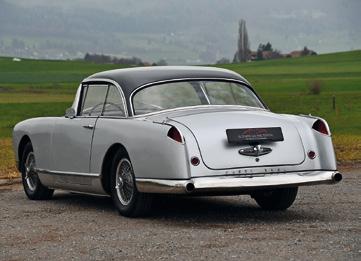
The French Facel Vega GT’s were a well-kept secret among the rich and famous in their days. Exceedingly elegant French coachwork, full of exciting little details, combined with powerful and reliable technical components from the USA, make the Facel the “exotic among exotics”. This example is a FV3 with a 4.5 litre Chrysler V8 and a push button operated automatic gearbox. Between November 1956 and September 1957 only 46 examples of this type were produced. The beautiful coupe was imported from the USA a number of years ago, where, in order to improve the breaking performance, disc brakes of a later HK500 model had been installed. The interior was restored some time ago and the outrageous dashboard reminds us of one of those elegant sports speed-boats of the period. Recently the FV3 was repainted, and a new front screen was installed. Therefore, the exceedingly rare French GT is in very good overall condition and will be sold with the last veteran MOT completed in May 2019.
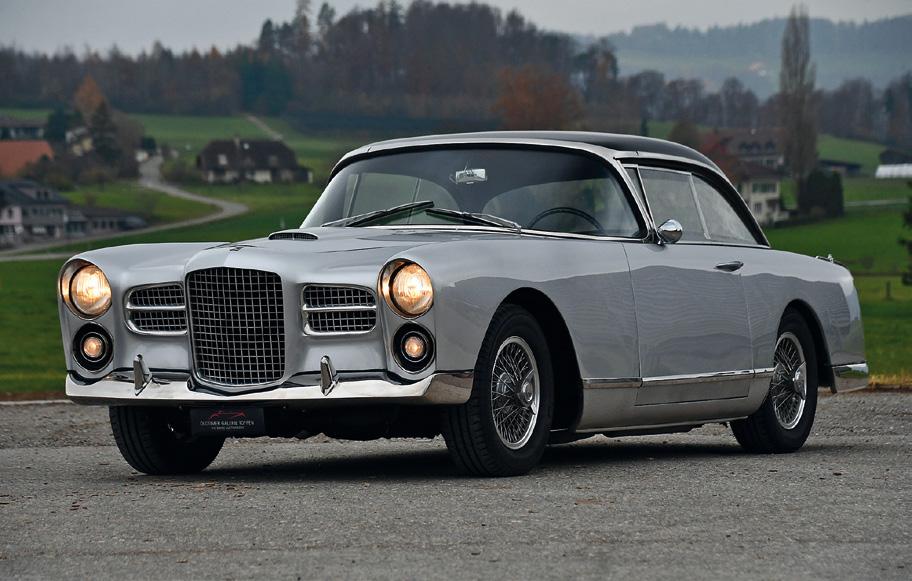
31
1979 VW Käfer 1303 Cabriolet
Chassis # 1592018439
The Volkswagen Beetle - officially the Volkswagen Type 1, informally in German der Käfer (meaning „beetle“), in parts of the English-speaking world the Bug, and known by many other nicknames in other languages—is a two-door, rear-engine economy car, intended for five occupants (later, Beetles were restricted to four people in some countries), that was manufactured and marketed by German automaker Volkswagen (VW) from 1938 until 2003.
The Volkswagen Beetle was the longest-running production car in history using the same basic platform and sold around the world. Produced from 1938 through 1980, around 21‘529‘464 examples were built. Most of them were sent to the United States during the 1950s, 1960s, and 1970s.
silver. The interior is in well maintained original condition and a woodrim steering wheel as well as a retro radio were installed. Engine and gearbox are working as they should in typical beetle manner. The last veteran MOT was completed in May 2022.
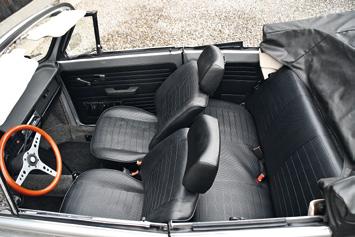

Dieses hübsche Käfer Cabriolet wurde als eines der letzten bei Karmann in Osnabrück gefertigten Fahrzeuge am 9. Januar 1979 als italienische Ausführung ausgeliefert. Typisch für diese Länderspezifikation ist, dass aus Steuergründen der 1.2-Liter Motor mit 34 PS verbaut wurde. Gemäss Fahrzeugausweis wurde der Käfer bereits am 1. März 1979 im Kanton St. Gallen zugelassen. Die Karosserie wurde vor einigen Jahren restauriert und von „Brasilbraun-Metallic“ auf das aktuelle Silber umlackiert. Die Innenausstattung befindet sich in sehr gepflegtem Originalzustand und wurde mit einem Holzlenkrad sowie einem Retro-Radio ergänzt. Motor und Getriebe funktionieren, Käfertypisch, einwandfrei und problemlos. Die letzte MFK als Veteranenfahrzeug erfolgte im Mai 2022.
This pretty beetle cabriolet was finished as one of the last examples by Karman in Osnabrück as an Italian export version on the 9th of January 1979. Typical for the Italian specification (for tax reasons) is the 1.2 litre engine with 34 horsepower. According to the cars registration the beetle was registered in St. Gallen already on the 1st March 1979. The coachwork was restored several years ago and repainted from Brazil brown metallic to the actual
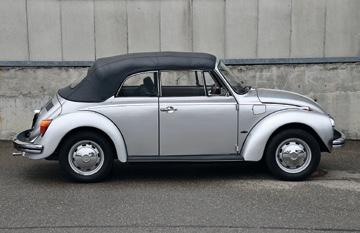

Cette jolie coccinelle cabriolet a été finie comme l‘un des derniers exemplaires par Karman à Osnabrück en version d‘exportation italienne le 9 janvier 1979. La spécification italienne (pour des raisons fiscales) est caractérisée par un moteur de 1.2 litre avec 34 chevaux. Selon la carte grise, la coccinelle était déjà immatriculée à St-Gall le 1er mars 1979. La carrosserie a été restaurée il y a plusieurs années et repeinte du brun Brésil métallisé à l‘argent actuel. L‘intérieur est en bon état d‘origine et un volant en bois ainsi qu‘une radio rétro ont été installés. Le moteur et la boîte de vitesses fonctionnent comme ils le devraient, à la manière typique des coccinelles. La dernière expertise vétéran a été effectuée en mai 2022.
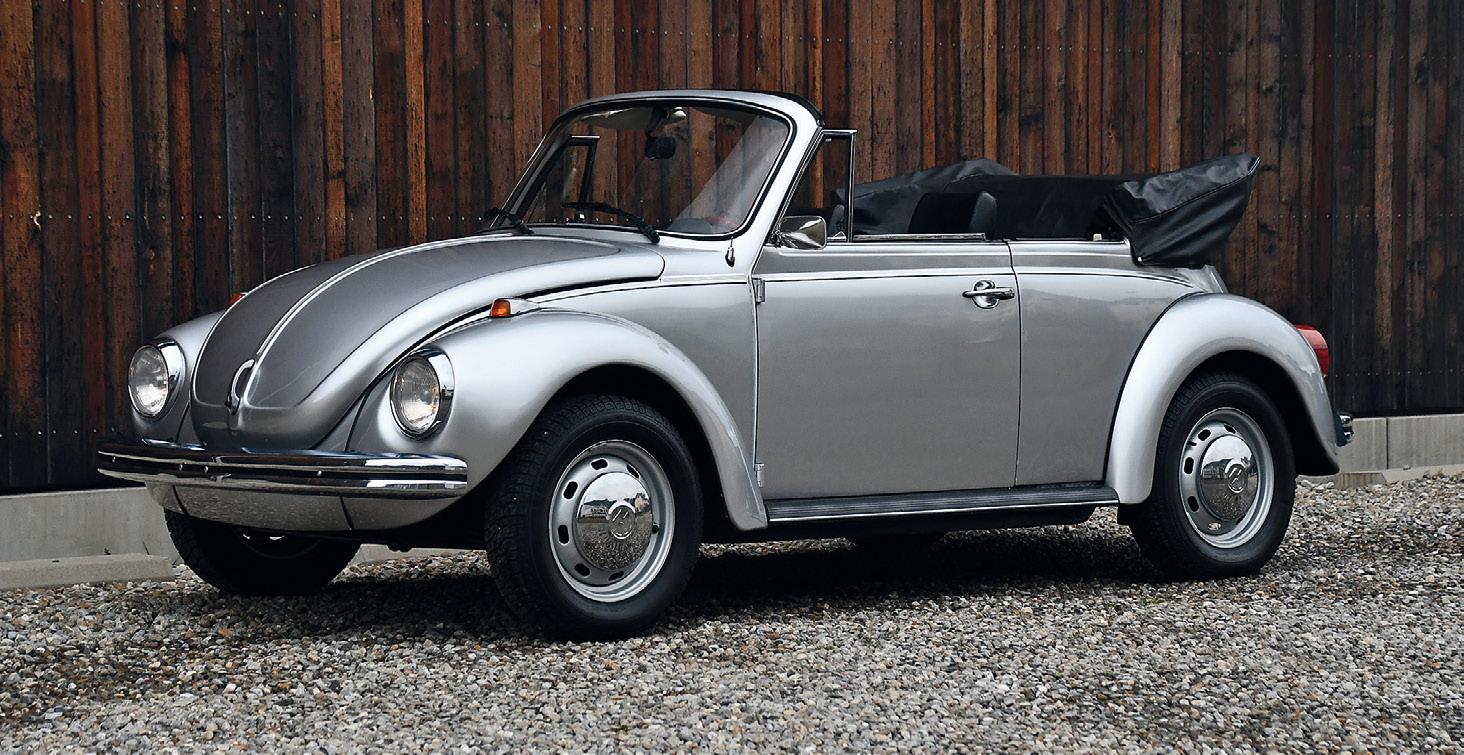
32 www.TheSwissAuctioneers.swiss
Lot 112 19‘569 cars (1979) 4 cylinder flat-engine 1‘192 cc 34 hp at 3‘600/min Estimate CHF 28‘000 - 32‘000 Story wikipedia.org
Oldtimer Galerie
Photos
2015 Harley-Davidson

Frame # 5HD1GNMC5FC301248
FXDL

Dyna-frame motorcycles were developed in the 1980s and early 1990s and debuted in the 1991 model year with the FXDB Sturgis offered in limited edition quantities. In 1992 the line continued with the limited edition FXDB Daytona and a production model FXD Super Glide. The new DYNA frame featured big-twin engines and traditional styling.

The Dyna family used the 88-cubic-inch (1,440 cc) twin cam from 1999 to 2006. In 2007, the displacement was increased to 96 cubic inches (1,570 cc). For the 2012 model year, the manufacturer began to offer Dyna models with the 103-cubic-inch (1,690 cc) upgrade.
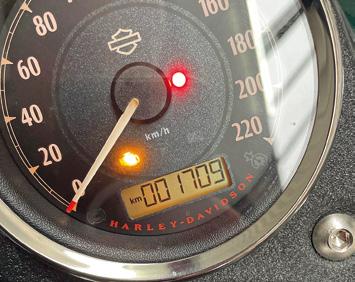

1690 Dyna Low Rider
Diese schöne Dyna Low Rider Modelljahr 2015 mit dem Drehmomentstarken 1‘690 cm3 V2-Motor wurde am 17. August 2016 erstmals in der Schweiz zugelassen. Für den besseren Sound wurde eine Kesstech Auspuffanlage (mit Beiblatt) montiert. Der erste und bislang einzige Besitzer entschied sich nicht zuletzt wegen der angenehm tiefen Sitzposition für die Low Rider und plante genüssliche Ausfahrten mit seiner neuen Maschine. Aus gesundheitlichen Gründen wurden daraus in den letzten 6 Jahren lediglich knapp 2‘000 gefahrenen Kilometer. So befindet sich die Harley in der eleganten Farbe «Deep Jade Pearl» in ausgezeichnetem Zustand. Die letzte MFK erfolgte im August 2016.
Story wikipedia.org Photos Oldtimer Galerie
This great looking Dyna Low Rider with its model year 2015, equipped with a high-torque 1’690 cc V2 engine, was first registered in Switzerland on the 17th of August 2016. For a richer sound a Kesstech exhaust system (with its specific approval certificate) was installed. The first and so far only owner decided on this model not least because of its comfortably low seating position. Health issues unfortunately prevented him from using the bike much and only around 2’000 kilometres were covered in the last six years. The Harley in its elegant colour of “Deep Jade Pearl” is therefore in exceptional condition with the last MOT completed in August 2016.
Cette superbe Dyna Low Rider de l’année modèle 2015, équipée d‘un moteur V2 de 1‘690 cc à fort couple, a été immatriculée pour la première fois en Suisse le 17 août 2016. Pour un son plus riche, un système d‘échappement Kesstech (avec son certificat d‘homologation spécifique) a été installé. Le premier et jusqu‘à présent unique propriétaire a opté pour ce modèle notamment en raison de sa position assise confortablement basse. Des problèmes de santé l‘ont malheureusement empêché d‘utiliser la moto de manière intensive et seuls 2’000 kilomètres environ ont été parcourus au cours des six dernières années. La Harley dans son élégante couleur de „Deep Jade Pearl“ est donc dans un état exceptionnel, la dernière expertise ayant été effectuée en août 2016.
33
Lot
Production numbers
V2 1‘690 cc 76 hp at 5‘010/min Estimate CHF 12‘000 - 55‘000 at no reserve
113
unknown
1957 BMW R26
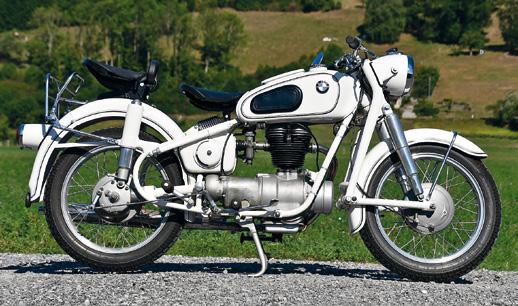
Frame # 353086
After World War II, the Potsdam Agreement of the USSR, USA, and the UK, prohibited BMW Aktiengesellschaft (AG) from building motorcycles. Later, this ban was lifted and in 1948 BMW produced its first postwar motorcycle, the 250 cc R24, which was based largely on the prewar R23. It was the only postwar BMW motorcycle produced without a rear suspension. BMW introduced the R25 model, with plunger rear suspension, in 1950. The last of the plunger models, the R25/3, was introduced in 1953.
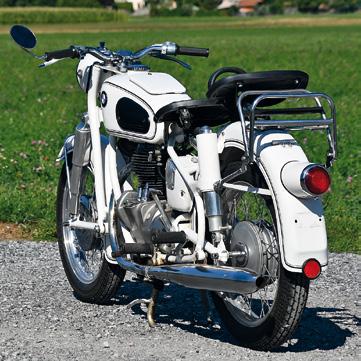
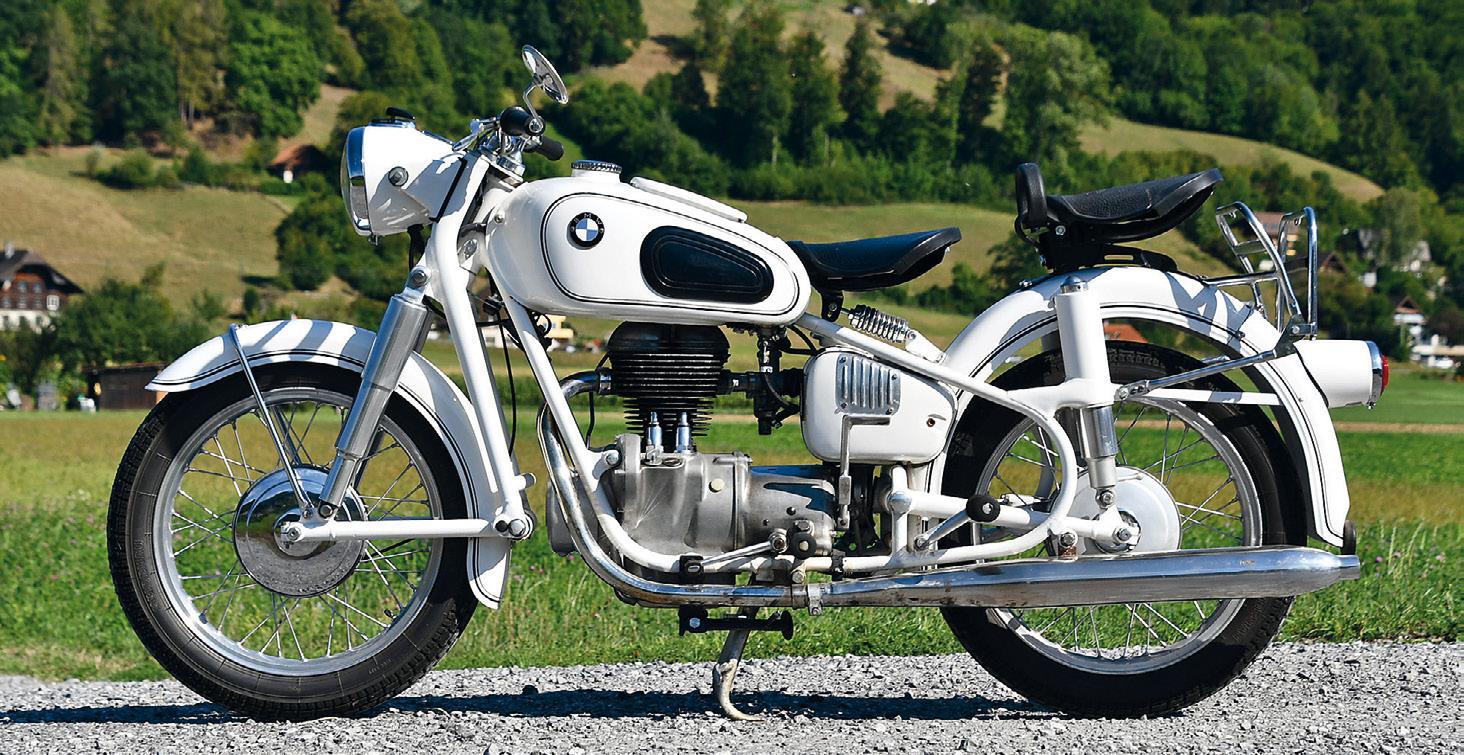
In 1956 BMW introduced a completely revamped single-cylinder engine, the R26, with improvements paralleling those introduced at the same time in the boxer twins. The R26 came with an enclosed drive shaft, rear swingarm, and front Earles forks. A new headlight nacelle came with a sliding black plastic over the ignition key, and the “bell-bottom” front fender was dropped along with the mechanics‘ hand shifter. The engine of the R26 was bolted directly to the frame, and produced 15 hp
Outstanding characteristics of the two-fifty are its excellent riding comfort, superb steering, smooth, powerful braking, a remarkably high level of exhaust and mechanical quietness, goof fuel economy and a fine standard of engineering, detail design and finish.
This beautiful BMW R26 and its very rare white finish was restored a number of years ago and presents itself in very good condition. The robust bike with its then revolutionary plunger suspension front and back will certainly provide a lot of enjoyment to a new owner on leisurely outings. The last veteran MOT was completed in October 2018.
Diese wunderschöne BMW R26 im eher seltenen Weiss wurde vor einigen Jahren restauriert und befindet sich in sehr gutem Zustand. Das robuste Motorrad mit dem damals revolutionären Vollschwingenfahrwerk (je eine Schwinge mit Stossdämpfern an der Vorder- und Hinterachse) wird einem Liebhaber gemächlicher Motorradfahrten sicher noch viele Jahre Freude bereiten. Die letzte MFK als Veteranenfahrzeug erfolgte im Oktober 2018.
Cette belle BMW R26 dans sa très rare finition blanche a été restaurée il y a quelques années et se présente en très bon état. Cette moto robuste, dotée d‘une suspension à plongeur avant et arrière alors révolutionnaire, procurera certainement beaucoup de plaisir à un nouveau propriétaire lors de ses sorties de loisirs. La dernière expertise vétéran a été effectuée en octobre 2018.

34 www.TheSwissAuctioneers.swiss
Lot 114 30‘236 bikes (1956-60) 1 cylinder 248 cc 15 hp at 6‘400/min Estimate CHF 6‘500 - 7‘500 at no reserve Story wikipedia.org Photos Oldtimer Galerie
1950 Norton Manx 500

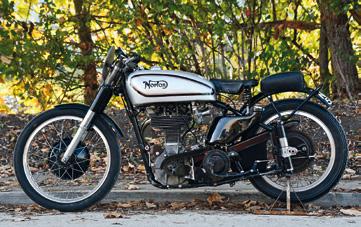
This beautiful racing bike was sold in the UK to a Mr. Hinton in 1950. Research indicates that it almost certainly was Mr. Harry Hinton, an Australian racing driver living in England. Harry Hinton was the first Australian driver gaining points in the 500cc world championship, in all probability on this very bike! As is often the case with racing bikes, the Manx eventually received a new type correct engine and continued to see regular competition use. In 1996 the Norton was acquired by the vendor to be integrated into a stationary collection soon after. In preparation for today’s sale an oil change was completed and the 500cc racing engine with its OHC carefully brought back to life. Since this is a pure competition machine without any road registration no further paperwork is available. This Norton Manx will certainly be a welcome entrant at any historic motorbike race and provide endless thrills as well as admiring looks to its new owner.
Diese schöne Rennmaschine wurde 1950 in England an einen Mr. Hinton verkauft. Die Recherchen haben ergeben, dass es sich hierbei mit an Sicherheit grenzender Wahrscheinlichkeit um Harry Hinton – einen in England lebenden australischen Rennfahrer - gehandelt hat. Harry Hinton war 1950 der erste australische Fahrer, welcher in

der 500er Weltmeisterschaft Punkte eingefahren hat – diese höchstwahrscheinlich auf genau dieser Norton Manx. Wie so oft bei Rennfahrzeugen, hat die Manx irgendwann einen neuen, typenkorrekten Motor erhalten und wurde wohl oft eingesetzt. 1996 wurde die Maschine vom Einlieferer erworben und bereits kurze Zeit später in dessen Sammlung abgestellt. Im Zuge der Verkaufsvorbereitungen wurde ein Ölwechsel durchgeführt und der 500er Rennmotor mit obenliegender Nockenwelle vorsichtig in Betrieb genommen. Da es sich um eine Rennmaschine ohne Strassenzulassung handelt sind keine Papiere vorhanden. Diese Norton Manx wird sicherlich bei jedem historischen Motorradrennen ein gern gesehener Gast sein und einem künftigen Besitzer viel Spass und bewundernde Blicke bereiten.
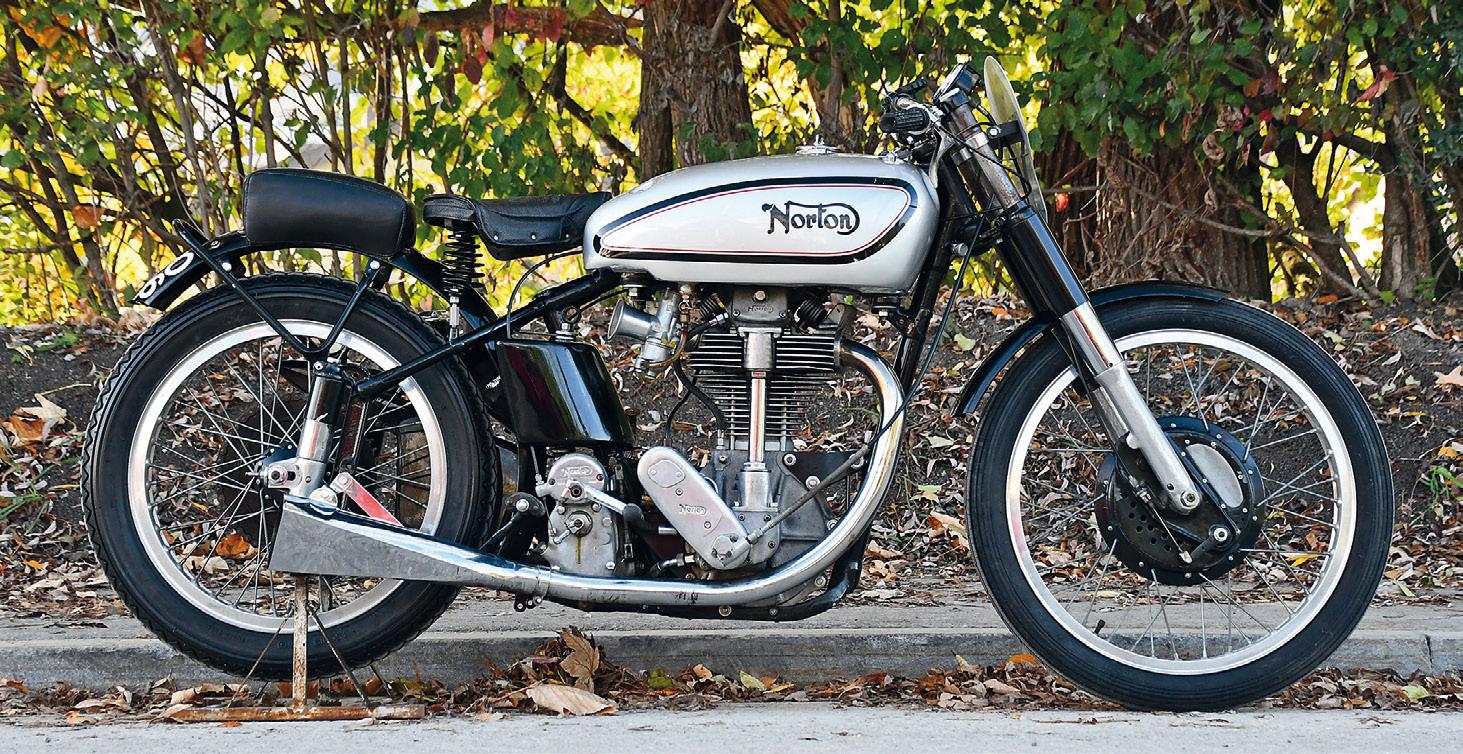
Cette magnifique moto de course a été vendue au Royaume-Uni à un certain M. Hinton en 1950. Les recherches indiquent qu‘il s‘agissait presque certainement de M. Harry Hinton, un pilote de course australien vivant en Angleterre. Harry Hinton a été le premier pilote australien à marquer des points dans le championnat du monde 500cc, selon toute probabilité sur cette même moto ! Comme c‘est souvent le cas avec les motos de course, la Manx a finalement reçu un nouveau moteur du type correct et a continué à être utilisée régulièrement en compétition. En 1996, la Norton a été acquise par le vendeur pour être intégrée peu après dans une collection stationnaire. En préparation de la vente d‘aujourd‘hui, une vidange d‘huile a été effectuée et le moteur de course de 500cc arbre à cames en tête a été soigneusement ramené à la vie. Comme il s‘agit d‘une pure machine de compétition sans aucune immatriculation routière, aucun autre document n‘est disponible. Cette Norton Manx sera certainement la bienvenue dans n‘importe quelle course de moto historique et procurera des frissons sans fin ainsi que des regards admiratifs à son nouveau propriétaire.


35
Frame # 29574
Lot 115 Production numbers unknown 1 cylinder 498 cc 47 hp at 6‘500/min Estimate CHF 35‘000 - 40‘000
Photos Oldtimer Galerie
1970 Porsche 911 T 2.2
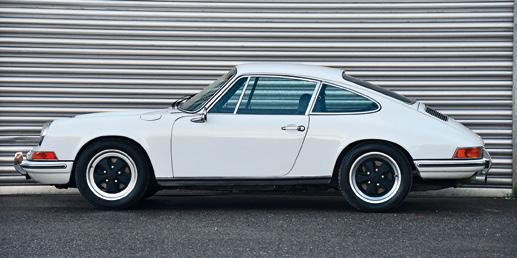
Chassis # 9110100097
The 911 traces its roots to sketches drawn by Ferdinand „Butzi“ Porsche in 1959. The Porsche 911 was developed as a more powerful, larger and a more comfortable replacement for the 356, the company‘s first model. The new car made its public debut at the 1963 Frankfurt Motor Show. The car was developed with the proof-of-concept twin-fan Type 745 flat-six engine, but the car presented at the auto show had a non-operational mockup of the single-fan 901 engine, receiving a working unit in February 1964. It originally was designated as the „Porsche 901“ (901 being its internal project number). A total of 82 cars were built as which were badged as 901s. However, French automobile manufacturer Peugeot protested on the grounds that in France it had exclusive rights to car names formed by three numbers with a zero in the middle. Instead of selling the new model with a different name in France, Porsche changed the name to 911. The first models of the 911 had a rear-mounted Type 901/01 flat-6 engine, in the „boxer“ configuration, the engine is air-cooled and displaces 1‘991 cc. In August 1969 the C series was introduced with an enlarged 2.2-litre engine.
1969. During its time in America the Porsche was restored and its colour changed from “Albert blue” with a beige vinyl interior to the current white with a black leather interior. In 2011 the 911 was imported and registered in Switzerland. The pretty Coupé is in good overall condition and will be sold with a birth certificate from Porsche, FIVA ID and the last Veteran MOT completed in April 2020.
Dieser schöne 911 T mit 2.2-Liter Matching-Numbers Motor, 5-Gang Getriebe und 16“ Fuchs Felgen wurde am 1. Dezember 1969 nach Jacksonville/USA ausgeliefert. Während der Zeit jenseits des grossen Teiches wurde der Porsche restauriert und von der originalen Farbkomposition «Albertblau» mit beiger Kunstlederausstattung auf das aktuelle Weiss mit schwarzer Lederausstattung geändert. 2011 wurde der 911er in die Schweiz importiert und hier zugelassen. Das hübsche Coupé befindet sich in gutem Allgemeinzustand und wird mit Porsche Geburtsurkunde, FIVA-ID und der letzten MFK als Veteranenfahrzeug im April 2020 verkauft.


This lovely 911 T, with its 2.2 litres matching numbers engine, 5-speed gearbox and 16 inch Fuchs rims was delivered to Jacksonville USA on the 1st of December

Cette belle 911 T, avec son moteur de 2.2 litres aux numéros correspondants, sa boîte de vitesses à 5 rapports et ses jantes Fuchs de 16 pouces, a été livrée à Jacksonville, aux États-Unis, le 1er décembre 1969. Pendant son séjour en Amérique, la Porsche a été restaurée et sa couleur est passée du „bleu Albert“ avec un intérieur en vinyle beige au blanc actuel avec un intérieur en cuir noir. En 2011, la 911 a été importée et immatriculée en Suisse. Le joli Coupé est en bon état général et sera vendu avec un certificat de naissance de Porsche, une ID FIVA et la dernière expertise vétéran effectué en avril 2020.
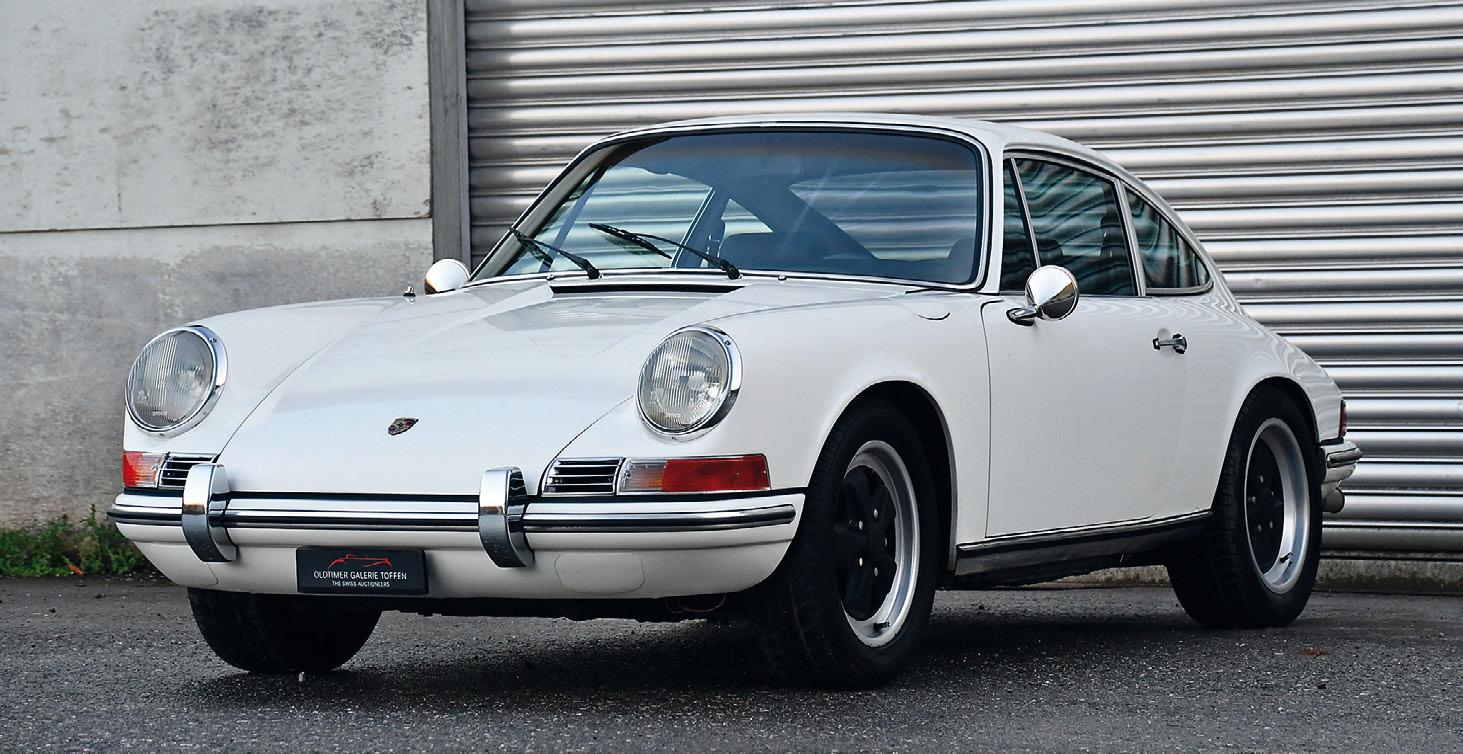
36 www.TheSwissAuctioneers.swiss
Lot 116 1‘934 cars (1970) 6 cylinder flat-engine 2‘195 cc 125 hp at 5‘800/min Estimate CHF 85‘000 - 95‘000 Story wikipedia.org
Photos Oldtimer Galerie
1957 Ford Thunderbird
Chassis # D7FH181322

For 1957, the Ford Thunderbird underwent some visual changes. Most notably, the front bumper was reconfigured, removing the large chrome nacelles, and adding fog lights to the corners. This opened up the grille visually, and made it seem more like the luxurious boulevard cruiser that it was.

The “Thunderbird” inscription was moved from the rear quarter to ahead of the front quarter panel vent. Out back, the spare tire was moved back into the trunk, and the rear fascia was revised. The fins were thinned out and more pronounced, and the rear bumper featured a new design.
Die frühen Modelle des Ford Thunderbird, die sogenannten «Early Birds», sind für viele Leute der Inbegriff des amerikanischen Sportcabriolets der 50er Jahre. Dieses Exemplar in der klassischen Kombination von schwarzer Lackierung und roter Lederausstattung befindet sich seit 2011 im Besitz des Einlieferers. Dieser liess den T-Bird komplett restaurieren. Hierbei wurde die Karosserie neu lackiert, die Chromteile neu verchromt und die Innenausstattung erneuert. Technisch wurde der Ford mittels eines neuen 302 cui-Motors und eines neuen AOD-Automatikgetriebes mit 4 Fahrstufen aufgerüstet. Zudem erhielt der Wagen eine Edelstahl-Auspuffanlage sowie eine komplette Bremsrevision. Dieser Thunderbird befindet sich also in hervorragendem Zustand und wird dank der Updates viel Fahrfreude vermitteln. Die letzte MFK als Veteranenfahrzeug erfolgte im März 2022.

The early versions of the Ford Thunderbird called “Early Birds” present, for many people, the epitome of a 50’s American sports cabriolet. This example in the classic combination of black paint with red leather interior has been with the current owner since 2011. He had the T-bird completely restored. This included a repaint of the coachwork, re-chroming of all the shiny bits and a renewed interior. On the technical side, the Ford was equipped with a new 302 cubic inch engine and a new AOD four-speed automatic gearbox as well as a stainless-steel exhaust system and completion of a brake overhaul. The Thunderbird is therefore in outstanding condition and, with those useful updates, will provide exciting, powerful and reliable transport to its next lucky owner. The most recent Veteran MOT was successfully completed in March 2022.

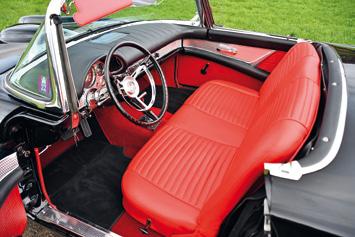
Les premières versions de la Ford Thunderbird appelées „Early Birds“ présentent, pour beaucoup, l‘incarnation du cabriolet sportif américain des années 50. Cet exemple dans la combinaison classique de la peinture noire avec un intérieur en cuir rouge est avec le propriétaire actuel depuis 2011. Il a fait entièrement restaurer la T-bird. Cela comprenait une nouvelle peinture de la carrosserie, un re-chromage de tous les éléments brillants et un intérieur renouvelé. Sur le plan technique, la Ford a été équipée d‘un nouveau moteur 302 cui et d‘une nouvelle boîte automatique à quatre vitesses AOD, ainsi que d‘un système d‘échappement en acier inoxydable et de la réalisation d‘une révision des freins. La Thunderbird est donc dans un état exceptionnel et, avec ces mises à jour utiles, elle fournira un transport excitant, puissant et fiable à son prochain heureux propriétaire. La dernière expertise vétéran a été effectuée avec succès en mars 2022.
hagerty.com
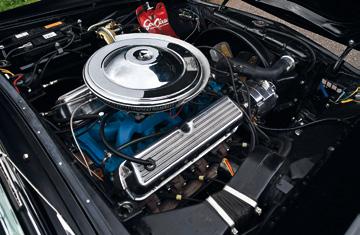
37
Lot 117 21‘380 cars (1957, all engines) V8 5‘112 cc 245 bhp at 4‘500/min Estimate CHF 55‘000 - 65‘000
Oldtimer
Story
Photos
Galerie
1964 Ferrari 330 GT 2+2 Series 1
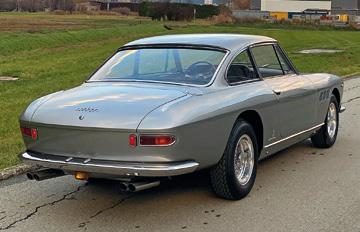
Chassis # 5835
The Ferrari 330 series belonged to a long line of Ferrari road cars with front-mounted V12 engines, cars that were members of a bloodline whose history is still being written today. The 330‘s name derived from the then-familiar Ferrari practice of naming cars for their per-cylinder displacement in cubic centimeters, indicating that the engines used to power this series of cars displaced a total of 12x330cc, or about four liters. Preceded by the 275 and replaced by the 365, the 330 was caught right in the middle of a glorious era for Ferrari road cars.
The 330 road cars were decidedly more relaxed and less exhilarating than the racing cars mentioned above, but their relatively high sales numbers and use of race-bred components meant that they were still important cars to Ferrari‘s history. Ferrari produced the 330 road cars primarily in four guises: the 330 America, the 330 GT 2+2, and the coupe/spider couple named 330 GTC and 330 GTS.

Ferrari introduced the 330 America first. It was a transitional model, essentially a 250 GTE 2+2 with the new 330 motor. The 330 GT 2+2 followed in 1964, and was a more thoroughly revised grand tourer built on a chassis stretched by 50mm compared to the America. This newer model, though still closely related to its predecessor, wore a controversial body design by the familiar Pininfarina. Its front end styling used an unconventional quad-headlight arrangement that mounted the two lights per side in clusters canted down toward the egg crate grille, creating an aggressive but cumbersome appearance of slanted eyes. The Mulliner Park Ward-bodied Rolls-Royce Silver Cloud III of the mid-1960s used a similar frontal treatment, also with questionable results.

A more harmonious front end debuted on the 1965 Ferrari 330 GT 2+2, reverting to a more traditional

twin-headlight approach. Other changes for 1965 included the replacement of the four-speed with overdrive gearbox by a 5-speed unit.
The engine common to all 330 series road cars was a 60-degree V12 of 3,967cc displacement. The block and heads were cast silumin, an aluminum and silicon alloy. A chain-driven single overhead camshaft per cylinder bank operated two inclined valves per cylinder that opened into hemispherical combustion chambers. Ferrari employed three Weber carburetors and an 8.8:1 compression ratio in the 330 motor to create a power plant that was capable of 300bhp at 6,600rpm in street tune. The V12 was bolted to a 5-speed gearbox in all 330 road cars, excepting the 330 America and early 330 GT 2+2, which used 4-speed gearboxes with overdrive. Double wishbones and coil springs suspended the front end of all 330 road cars. The GTC and GTS used independent rear suspensions, but the 2+2 models retained live axles. Brakes were assisted four wheel discs on all models, using an unconventional dualcircuit design that incorporated two master cylinders and two servos.

38 www.TheSwissAuctioneers.swiss
Lot 118 453 cars (4-speed w. OD, LHD) V12 3‘967 cc 300 hp at 6‘600/min Estimate CHF 330‘000 - 360‘000 Story conceptcarz.com Photos by consignor
This gorgeous Ferrari 330 GT 2+2, is a first series example with its distinctive 4 headlights. Equipped with a four speed plus overdrive gearbox, the car was delivered to the Swiss Importer Italauto in Lausanne in June 1964. In July of the same year the elegant coupé was first registered in Switzerland where it has resided ever since. Most probably during the 70’s the Ferrari with its chassis number 5835 received a replacement engine from another 330 GT, chassis number 5457 and was repainted to dark red metallic. After a few additional owners the car was acquired by the vendor in 2016. A Ferrari specialist himself, he immediately embarked on a full restoration of the 330. The coachwork was restored by Carrozzeria Zanasi in Maranello and repainted in the original “Grigio Argento” while the interior was recovered with new leather “Nero VM 8500” by Tappezzeria Luppi in Modena. All the mechanical work was performed at Sport Auto Staub AG in Gisikon and Darles Bussetti in Soliera, and in 2020 the restoration was awarded with the coveted “Ferrari Classiche” certification. This noble Italian steed is in impeccable condition and will be sold to a Swiss buyer with Veteran MOT completed after the auction.
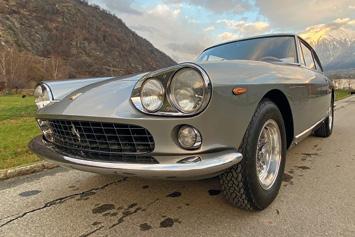
Dieser wunderschöne Ferrari 330 GT 2+2 der ersten Serie mit Doppelscheinwerfern und 4 Gang Getriebe mit Overdrive wurde im Juni 1964 an den Schweizer Importeur Italauto in Lausanne geliefert. Im Juli des Jahres wurde das elegante Coupé erstmals in der Schweiz zugelassen, wo es sein weiteres Leben verbrachte.

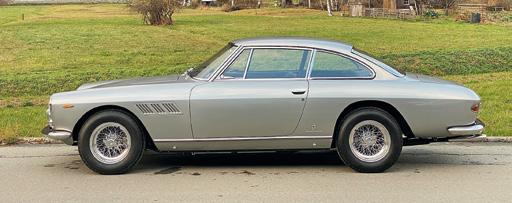
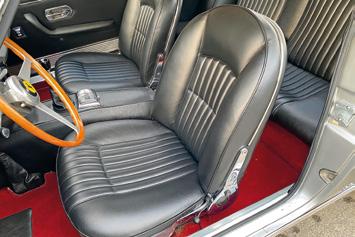
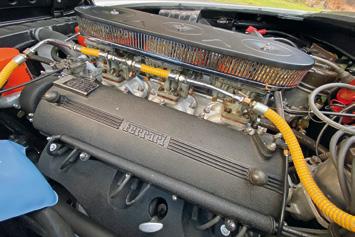
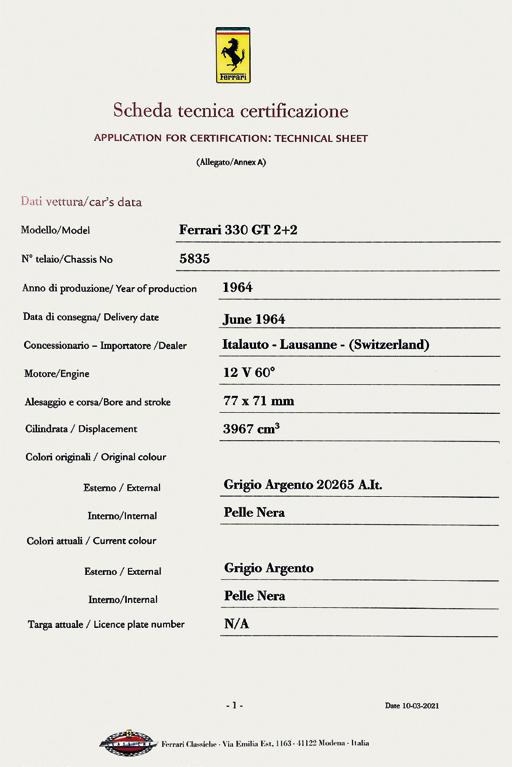
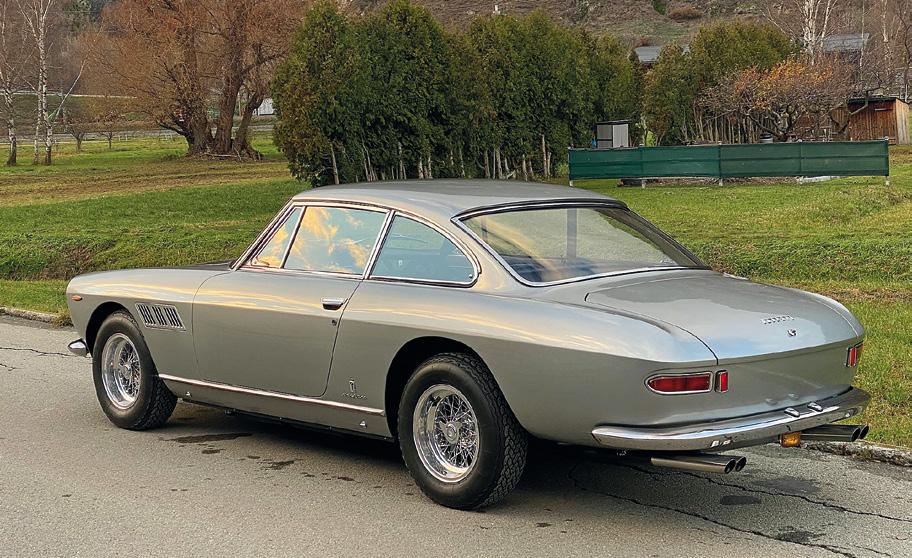
Vermutlich im Verlauf der siebziger Jahre erhielt der Ferrari #5835 einen Austauschmotor aus dem 330 GT #5457 und wurde auf dunkelrot metallic umlackiert. Nach einigen Besitzern wurde das Fahrzeug 2016 vom Einlieferer – selbst Ferrari Spezialist - übernommen, welcher eine Komplettrestaurierung in Angriff nahm. Die Karosserie wurde durch die Spezialisten der Carrozzeria Zanasi in Maranello restauriert und in der Originalfarbe «Grigio Argento» neu lackiert. Die Innenausstattung wurde durch die Tappezzeria Luppi, in Modena mit neuem Leder «Nero VM 8500» komplett aufgearbeitet. Die mechanischen Arbeiten wurden durch die Sport Auto Staub AG in Gisikon und Darles Bussetti in Soliera durchgeführt. Diese Arbeiten dauerten bis 2020 an und wurden, im März 2021, mit der begehrten Ferrari Classiche Zertifizierung belohnt. Der edle Italiener befindet sich also in hervorragendem Zustand und wird für Schweizer Käufer nach der Auktion als Veteranenfahrzeug frisch vorgeführt.
Cette magnifique Ferrari 330 GT 2+2, est un exemple de première série avec ses 4 phares distinctifs. Equipée d‘une boîte de vitesses à 4 rapports avec overdrive, la voiture a été livrée à l‘importateur suisse Italauto à Lausanne en juin 1964. En juillet de la même année, l‘élégant coupé a été enregistré pour la première fois en Suisse, où il réside depuis lors. Très probablement dans les années 70, la Ferrari avec son numéro de châssis 5835 a reçu un moteur de remplacement d‘une autre 330 GT, numéro de châssis 5457 et a été repeinte en rouge foncé métallisé. Après quelques propriétaires supplémentaires, la voiture a été acquise par le vendeur en 2016. Lui-même spécialiste des Ferrari, il s‘est immédiatement lancé dans une restauration complète de la 330. La carrosserie a été restaurée par la Carrozzeria Zanasi à Maranello et repeinte dans le „Grigio Argento“ d‘origine, tandis que l‘intérieur a été récupéré avec un nouveau cuir „Nero VM 8500“ par la Tappezzeria Luppi à Modena. Tous les travaux mécaniques ont été effectués chez Sport Auto Staub AG à Gisikon et Darles Bussetti à Soliera. En 2020, la restauration a reçu la très convoitée certification „Ferrari Classiche“. Ce noble Grand Tourismo italien est dans un état impeccable et sera vendu à un acheteur suisse avec l’expertise vétéran qui sera effectuée après la vente.
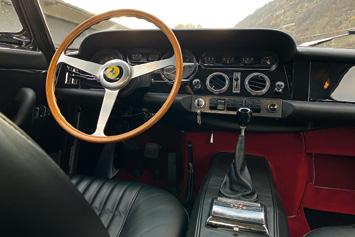

39
1969 Jaguar E-Type 4.2-Litre Series 2 Roadster
Chassis # 1R10893
The Jaguar E-Type (known as the Jaguar XK-E in the North American market) was produced from 1961 through 1975. The rear-wheel-drive grand tourer was offered as a two-seater coupe (FHC or Fixed Head Coupe) and as a two-seater convertible (OTS or Open Two Seater). In 1966, a ‚2+2‘ four-seater version of the coupe became available resting on a lengthened wheelbase. It was nine inches longer and the roof angles were different.

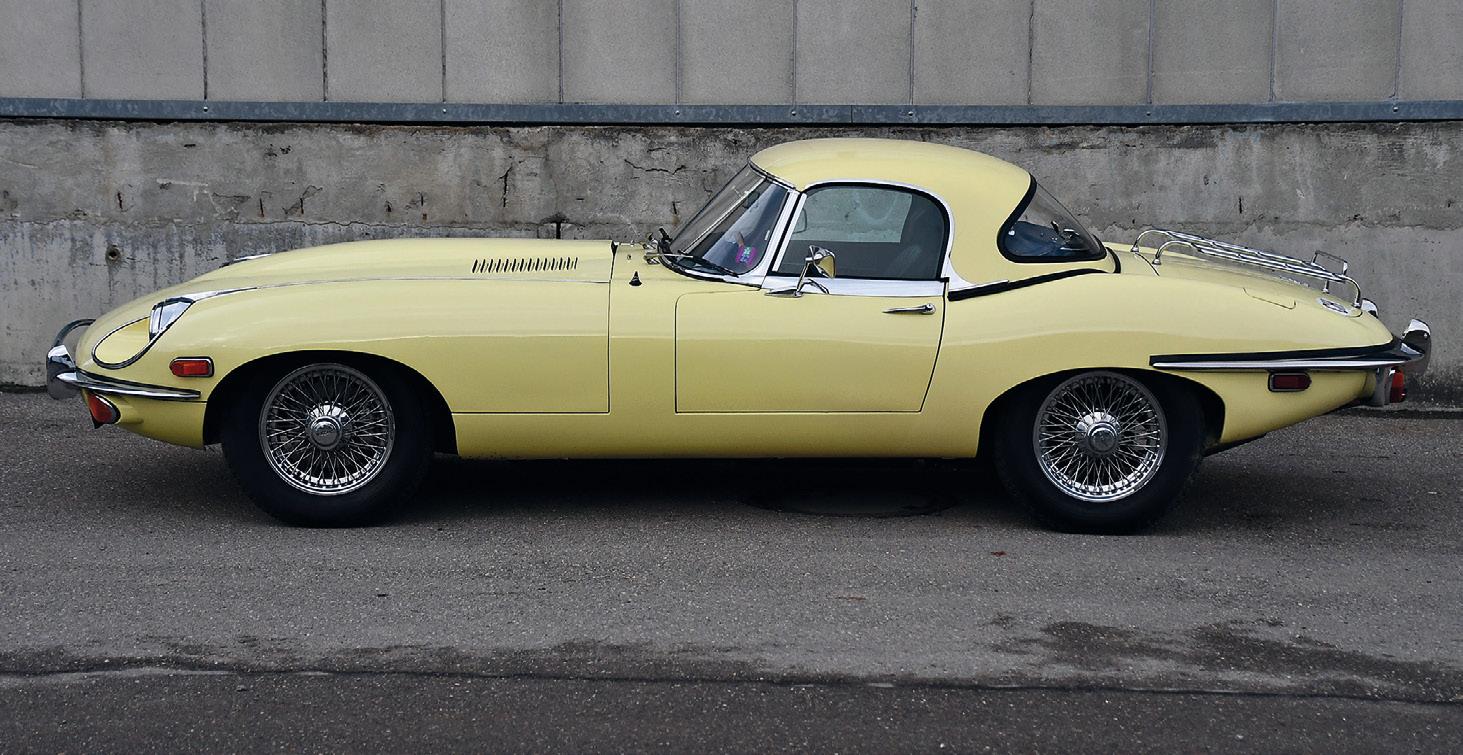
With 3.8-liter power and triple SU carburetors, the Jaguar E-Type was capable of achieving top speeds of 150 mph. When it was introduced in March of 1961, it was available solely for export, with the domestic market launch following four months later in July of 1961.
R.J. Knight developed the independent coil spring rear suspension with torsion bar front ends. The powerassisted four-wheel disc brakes were in-board at the rear. The Jaguar marque had become one of the first vehicle manufacturers to equip production cars with four-wheel disc brakes as standard from the XK150 in 1958.
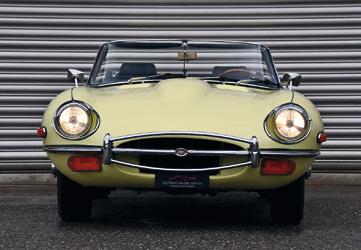
In October of 1964, engine displacement increased to 4.2-liters, and although larger in size, it produced the same power as the 3.8-liter size. Torque, however, increased by approximately ten percent, from 240 to 283 lb-ft. To accommodate the 5mm larger bores, the 4.2-liter‘s block was completely redesigned, and the crankshaft received new bearings. Additional modifications included an electric cooling fan for the radiator and a new alternator/generator.

The 3.8-liter Series 1 cars were distinguished from the 4.2-liter vehicles by their leather-upholstered
bucket seats, a Moss four-speed gearbox that lacked synchromesh for the first gear (except for the very last cars), and an aluminum-trimmed center instrument panel and console. The console was changed to vinal and leather in 1963. The 4.2-liter cars received more comfortable seats, an all-synchromesh Jaguardesigned four-speed gearbox, and improvements to the electrical and braking system. A ‚Jaguar 4.2-liter E-Type‘ badge on the boot of the car proudly proclaimed the powerplant lurking beneath the bonnet. The 3.8-liters cars had a ‚Jaguar‘ badge.

Series 1 cars, except for the late 1967 examples, had glass-covered headlights, tail-lights and signal lights located above the bumpers, exhaust tips under the number plate in the back, and a small opening at the front.
Jaguar built a total of 15‘498 examples of the Series 1 E-Type with the 3.8-liter engine, and 16‘195 with the 4.2-liter powerplant. An additional 6‘726 examples, unofficially known as the ‚Series 1½,‘ were built prior to the production of Series II cars. Among the incremental changes applied to the Series 1.5 cars
40 www.TheSwissAuctioneers.swiss
Lot 119 7‘852 cars (LHD, Roadster) in-line 6 cylinder 4‘235 cc 230 hp at 4‘650/min Estimate CHF 80‘000 - 90‘000 Story conceptcarz.com Photos Oldtimer Galerie
were twin cooling fans, adjustable seatbacks, and two (for the North American market) instead of three carburetors.
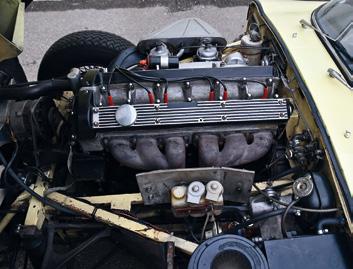

In 1968, the E-Type received major revisions to comply with United States safety and emissions legislation, resulting in ‚Series II‘ guise. They adopted enlarged side and rear lights, a thickened front bumper section, a wrap-around rear bumper, and a larger radiator intake. Interior changes included a collapsible steering column, new seats and head restraints, and rocker switches in place of the earlier toggles. Power steering and air conditioning were added to the list of available options. U.S-destined cars also received a steering lock which moved the ignition switch to the steering column, replacing the dashboard-mounted ignition and push-button starter.
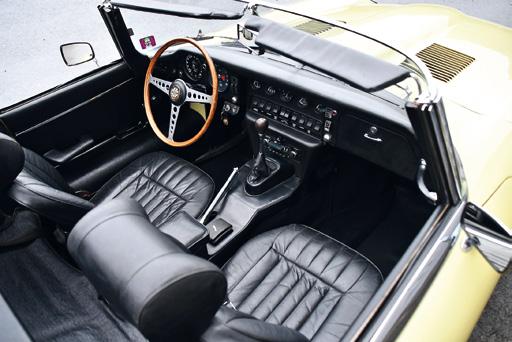
Series 2 cars were built from 1968 through 1971 and continued to be offered as a fastback coupe, roadster, and 2+2 fastback coupe. The 4.2-liter engine differed from the previous ‚Series‘ by the use of polished cam covers and twin two-barrel Stromberg carburetors (replaced the previous three SU carburetor setup) for the U.S-cars.
einem Vorbesitzer, wurde der E-Type vom ersten und einzigen Schweizer Besitzer in den USA erworben und anschliessend in die Schweiz importiert. In den letzten 38 Jahren wurde der Jaguar gerne genutzt und stets pfleglich gewartet. So wurde in der Zeit der MatchingNumbers Motor komplett revidiert, die Karosserie teilrestauriert, der Unterboden erneuert, die Bremsen revidiert, der Kühler erneuert, etc. Sämtliche Belege seit 1984 sind vorhanden und die Gesamtinvestitionen belaufen sich auf über CHF 141‘000.-. Der Jaguar befindet sich in gutem bis sehr gutem Zustand und hat die letzte MFK als Veteranenfahrzeug im September 2020 erfolgreich bestanden.
This beautifully E-type roadster with its rare hard top was delivered new to the USA. In its combination of primrose yellow with a black leather interior and four speed manual gearbox, this Jaguar is a classic representative of the proverbial British sports car of its time. In December 1984, and, according to the vendor, with then only one previous owner, the Etype was acquired by the first and only Swiss owner in the USA and imported into Switzerland. In the last 38 years the Jaguar was enthusiastically driven but always thoroughly maintained. In recent times, the matching-numbers engine was completely overhauled, the coachwork partially restored with new floors, the brakes overhauled, the radiator replaced, etc. All maintenance and restoration receipts since 1984 are present and a total of more than 141’000 francs have been invested in the car. The Jaguar is in good to very good condition and has successfully passed its latest Veteran MOT in September 2020.
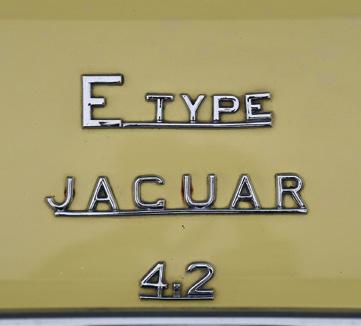
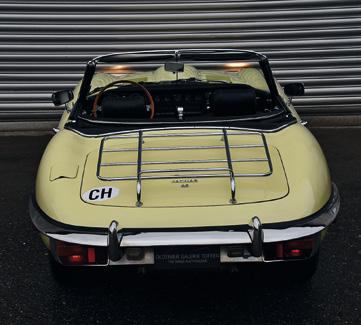
Dieses schöne E-Type Cabriolet mit seltenem Hardtop wurde als Neuwagen in die USA geliefert. In der Farbkombination «Primrose Yellow» mit schwarzer Lederausstattung und 4-Gang Schaltgetriebe ist dieser Jaguar ein typischer Vertreter des britischen Sportwagens seiner Zeit. Im Dezember 1984, und gemäss Verkäufer mit nur
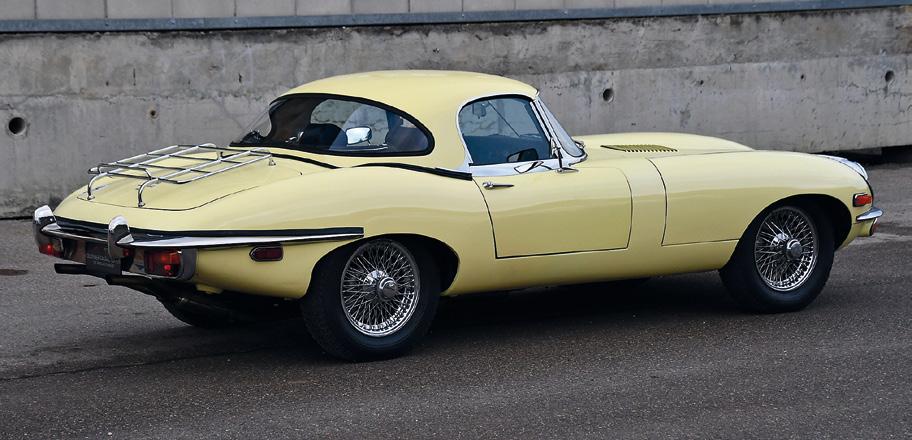
Ce magnifique type E roadster avec son rare hard top a été livré neuf aux Etats-Unis. Dans sa combinaison de jaune primeur avec un intérieur en cuir noir et une boîte manuelle à quatre vitesses, cette Jaguar est un représentant classique de la proverbiale voiture de sport britannique de son époque. En décembre 1984, et, selon le vendeur, avec alors un seul propriétaire précédent, le type E a été acquis par le premier et unique propriétaire suisse aux États-Unis et importé en Suisse. Au cours des 38 dernières années, la Jaguar a été conduite avec enthousiasme mais toujours soigneusement entretenue. Ainsi, durant cette période, le moteur Matching-Numbers a été entièrement révisé, la carrosserie partiellement restaurée avec de nouveaux planchers, les freins révisés, le radiateur remplacé, etc. Tous les reçus d‘entretien et de restauration depuis 1984 sont présents et un total de plus de 141‘000 francs a été investi dans la voiture. La Jaguar est en bon à très bon état et a passée avec succès sa dernière expertise vétéran en septembre 2020.
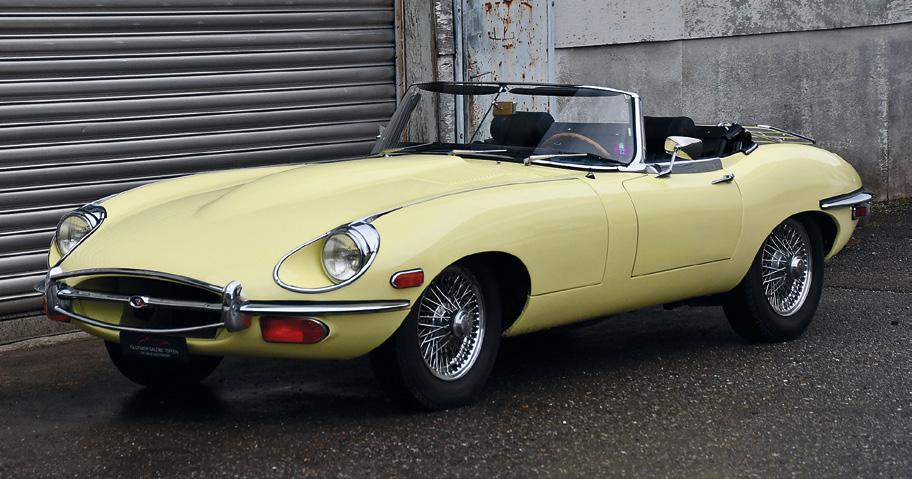
41
2016 Porsche 911 (991) GT3 RS
 Chassis # WPOZZZ99ZGS189687
Chassis # WPOZZZ99ZGS189687
The Porsche 991 is the internal designation for the seventh generation of the Porsche 911 sports car, which was unveiled at the 2011 Frankfurt Motor Show on 15 September as the replacement for the 997. The 991 was an entirely new platform, only the third since the original 911 launched in 1963 (the 996 of 1999 was the second new platform).
Compared to the 997, the 991 is slightly larger, with the wheelbase increased by 100 mm to 2‘450 mm, and the overall length up by 70 mm to 4‘490 mm. A new transaxle was developed so that the rear wheels could be moved 76 mm backward in relation to the position of the engine, which significantly improves the weight distribution and cornering performance of the car.
Due to the use of high-strength steel, aluminium and some composites, the weight was reduced to 1‘380 kg for the manual Carrera, rising to 1‘605 kg for the all wheel drive Turbo model if equipped with the PDK transmission (Porsche Doppelkupplung). PDK is available as an option for all 911 Carrera and 911 Turbo models as a 7-speed transmission, featuring manual and automatic modes. Gears 1 to 6 have a sports ratio and top speed is reached in 6th gear. 7th gear has a long ratio and helps to reduce fuel consumption by keeping engine revs low. The PDK is essentially two gearboxes merged into a single unit and thus requires two clutches. For all 991 models, the PDK is produced by ZF Friedrichshafen.
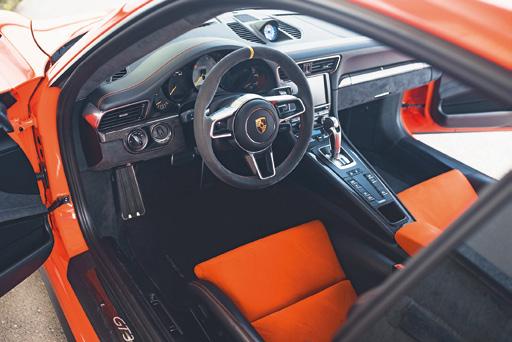
The GT3 variant was added to the 991 line up at the 2013 Geneva Motor Show equipped with Porsche‘s new active rear wheel steering. The system is claimed to provide higher lateral dynamics than previously available by the manufacturer. Car speed inputs determine whether the rear wheels steer in the same or opposite
direction of the front wheels. It is the first GT3 model to be offered with an automatic transmission. At the start of 2014, deliveries of the GT3 were halted following two incidents of the car catching fire. A subsequent recall to replace the engines of all 785 cars manufactured at that time was announced in March 2014 before production of the GT3 would restart.
Porsche launched the RS version of the 991 GT3 at the Geneva Motor Show in 2015. Compared to the 991 GT3, the front fenders are now equipped with louvers above the wheels and the rear fenders now include intakes taken from the 911 Turbo, rather than an intake below the rear wing. The roof is made from magnesium. The interior includes full bucket seats (based on the carbon seats of the 918 Spyder), carbon-fibre inserts, lightweight door handles and the Club Sport Package as standard (a bolted-on roll cage behind the front seats, preparation for a battery master switch, and a six-point safety harness for the driver and fire extinguisher with mounting bracket).
The 3.8-litre unit found in the 991 GT3 is replaced with a 4.0-litre unit generating a maximum power output

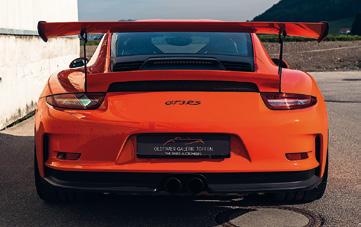

42 www.TheSwissAuctioneers.swiss
Lot 120 4‘596 cars (991.1) 6 cylinder flat-engine 3‘996 cc 500 hp at 8‘250/min Estimate CHF 180‘000 - 200‘000 Story wikipedia.org
Daniel Zizka
Photos
of 500 hp and 460 Nm of torque. The transmission is PDK only. The car is able to accelerate from 0–100 km/h in 3.3 seconds and to 0–200 km/h in 10.9 seconds. The 991 GT3 RS also comes with functions such as declutching by „paddle neutral“ — comparable to pressing the clutch with a conventional manual gearbox – and a Pit Speed limiter button. As with the 991 GT3, there is rear-axle steering and Porsche Torque Vectoring Plus system with fully variable rear axle differential lock.
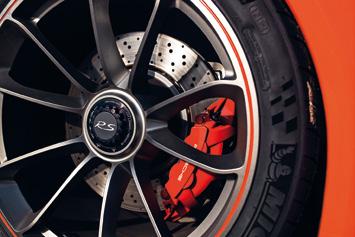
Starting with the 2.7 Carrera RS, “RS” variants of the 911 have become coveted for their track readiness, precision and power. Throughout the succeeding generations of 911s, the RS badge remained reserved for only the most hardcore, purpose-built road cars in Porsche’s portfolio and has become highly coveted.
With a giant rear wing, large intakes, graphics and a wide track, the 991.1 GT3 RS certainly looks the part. The naturally aspirated 6-cylinder engine motivates the GT3 RS to 60 mph in three seconds flat — impressive, but this car is about track performance and handling. It also has stiff springs, solid mounts, and many manually adjustable settings to tune the car to suit the task at hand, one of very few road cars allowed to have these race-derived refinements. Adding to the manual adjustments, trick technology like an electronically locking rear differential and rear-wheel steering transform the GT3 RS into a formidable track weapon, lapping the Nürburgring in 6:56.4, faster than the venerable Porsche 918.
with only 1’495 kilo empty weight, is in absolutely outstanding condition. The GT3 RS has covered a mere 6’500 kilometre and has a full service booklet with its latest entry from July 2022 at 5’969 kilometres. This fantastic Porsche successfully completed its last MOT in July 2022 and is ready to thrill a new owner on and off the circuit.
Dieser tolle GT3 RS in Lavaorange mit schwarz/oranger Leder/Alcantara Ausstattung, 7-Gang Doppelkupplungsgetriebe, Sportschalensitzen, Clubsportpaket, Karbon-Paket, Chrono-Paket, Liftsystem und PCM-Multimediaanlage wurde am 11. März 2016 durch das Porsche Zentrum Bern an den ersten und bislang einzigen Besitzer ausgeliefert. Dieser hat seinen 911er geliebt und, wie der Pflegezustand vermuten lässt, wohl nur bei schönem Wetter bewegt. Dieses ultimative Track-Tool mit 4-Liter 6-Zylinder Boxermotor und 500 PS bei nur 1‘495 kg Leergewicht befindet sich in hervorragendem Zustand. Der GT3 RS hat erst knapp 6‘500 Kilometer gefahren und besitzt ein lückenloses Serviceheft mit dem letzten Eintrag bei 5‘969 Kilometern im Juli 2022. Dieser herrliche Porsche hat die letzte MFK im Juli 2022 erfolgreich bestanden und wird einem kommenden Besitzer auf- und abseits der Rennstrecken dieser Welt jede Menge Fahrspass bereiten.
Cette superbe GT3 RS en lava-orange avec un intérieur cuir/Alcantara noir/orange, équipée d‘une boîte de vitesses à double embrayage à 7 rapports, de sièges baquets sport, du pack club sport, du pack carbone, du pack chrono, du système de levage et du système multimédia PCM a été livrée par Porsche centre Bern à son premier et jusqu‘à présent unique propriétaire. Ce dernier aimait manifestement sa 911 et, comme en témoigne l‘état d‘entretien impeccable, ne l‘a probablement jamais utilisée par mauvais temps. Cet outil de piste ultime, avec son moteur boxer 6 cylindres de 4 litres et 500 cv, qui ne pèse que 1‘495 kg à vide, est dans un état absolument exceptionnel. La GT3 RS n‘a parcouru que 6‘500 kilomètres et dispose d‘un carnet d‘entretien complet avec sa dernière inscription de juillet 2022 à 5‘969 kilomètres. Cette fantastique Porsche a passé avec succès sa dernière expertise en juillet 2022 et est prête à faire vibrer un nouveau propriétaire sur et en dehors des circuits.

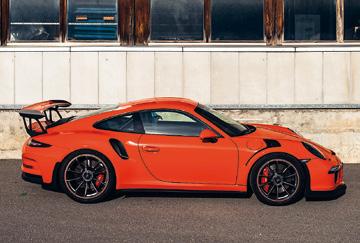
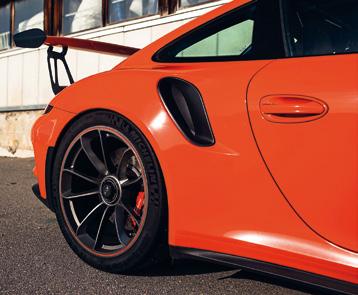

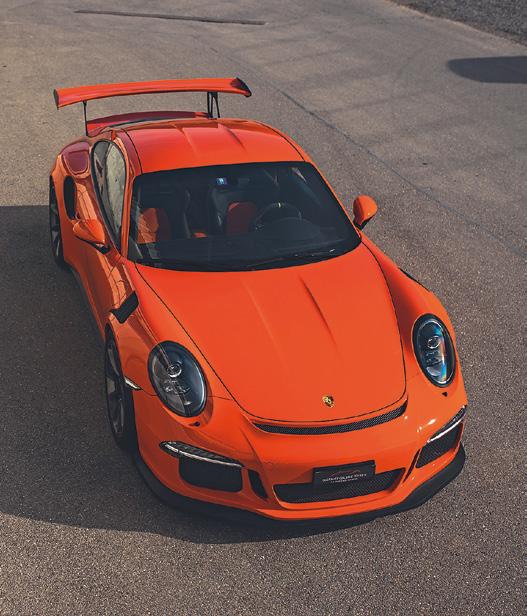

911 and, as shown with the impeccable state of tune and cleanliness, has never used it in inclement weather. This ultimate track tool with its four litre 6 cylinder boxer engine and 500 hp coping

43
This great GT3 RS in lava-orange with a black/orange leather/Alcantara interior, equipped with a 7-speed twin clutch gearbox, sports bucket seats, club sport package, carbon package, chrono package, lift system and PCM multimedia system was delivered by Porsche centre Bern two its first and so far only owner. He clearly loved his
2008 Ferrari 430 Scuderia

Chassis # ZFFKZ64B000156643
The Ferrari F430 (Type F131) is a sports car produced by the Italian automobile manufacturer Ferrari from 2004 to 2009 as a successor to the Ferrari 360. The car is an update to the 360 with exterior and performance changes. It was unveiled at the 2004 Paris Motor Show.
Designed by Pininfarina in collaboration with Frank Stephenson, the body styling of the F430 was revised from its predecessor, the 360, to improve its aerodynamic efficiency. Although the drag coefficient remained the same, the downforce was greatly enhanced. Despite sharing the same basic Alcoa Aluminium chassis, roofline, doors, and glass, the car looked significantly different from the 360. A great extent of Ferrari heritage was included in the exterior design. At the rear, the Enzo‘s tail lights and engine cover vents were added. The car‘s name was etched on the Testarossa-styled driver‘s side mirror. The large oval openings in the front bumper are reminiscent of Ferrari racing models from the 60s, specifically the 156 „shark nose“ Formula One car.
The F430 features a 4‘308 cc V8 engine of the „FerrariMaserati“ F136 family. This new power plant was a significant change for Ferrari, as all previous Ferrari V8‘s were descendants of the Dino racing program of the 1950s. This fifty-year development cycle came to an end with the entirely new engine used in the F430, the architecture of which replaced the Dino-derived V12 in most other Ferrari cars. The engine‘s output specifications are: 490 PS at 8‘500 rpm and 465 Nm of torque at 5‘250 rpm, 80% of which is available below 3,500 rpm. The connecting rods, pistons and crankshaft were all entirely new, while the 4-valve cylinder head, valves and intake trumpets were directly retained from Formula 1 engines, for ideal volumetric efficiency. The F430 has a top speed in excess of 315 km/h and can
accelerate from 0 to 97 km/h (60 mph) in 3.6 seconds, 0.6 seconds quicker than the old model.
The F430 featured the E-Diff, a computer-controlled limited slip active differential which can vary the distribution of torque based on inputs such as steering angle and lateral acceleration.
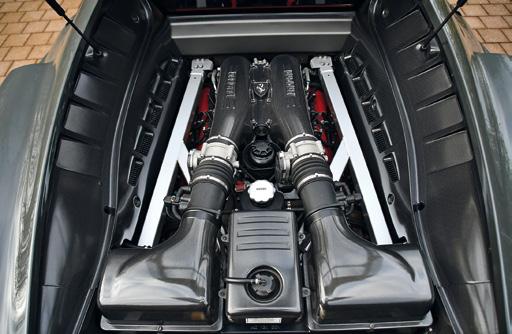
Other notable features include the first application of Ferrari‘s manettino steering wheel-mounted control knob. Drivers can select from five different settings which modify the vehicle‘s ESC system, „Skyhook“ electronic suspension, transmission behavior, throttle response, and E-Diff.


Serving as the successor to the 360 Challenge Stradale, the 430 Scuderia (scuderia meaning „stable“, but also used in the context of motor racing teams, including Ferrari‘s own) was unveiled by Michael Schumacher at the 2007 Frankfurt Auto Show. Aimed to compete with cars like the Porsche 911 GT2 and the Lamborghini Gallardo Superleggera (superleggera meaning super light weight), it is lighter (by 100 kg ) and more powerful (510 PS at 8‘500 rpm and 471 Nm of torque at 5‘250 rpm) than the standard F430. Increased power comes from a revised intake, exhaust, and an ion-sensing
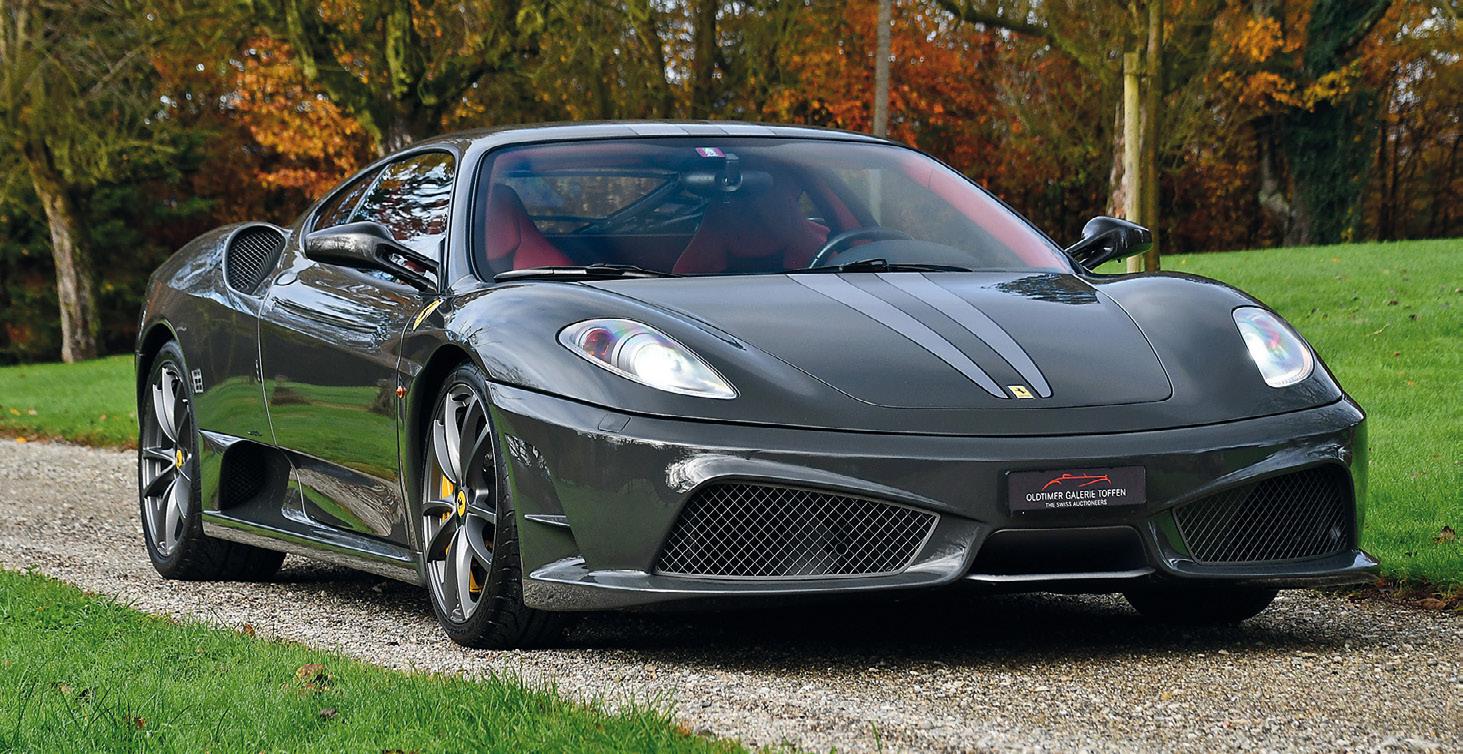
44 www.TheSwissAuctioneers.swiss
Lot 121 approx. 2‘500 cars V8 4‘308 cc 510 hp at 8‘500/min Estimate CHF 210‘000 - 230‘000 Story wikipedia.org
Photos Oldtimer Galerie
knock-detection system that allows for a higher compression ratio in the engine. Thus the weight-to-power ratio is reduced from 2.96 kg/hp to 2.5 kg/hp. In addition to the weight saving measures, the Scuderia‘s single-clutch automated manual gained improved „Superfast“ software, known as „Superfast2“, for faster 60 millisecond shift times. A new traction control system combined the F1-Trac traction from the 599 GTB and stability control with the E-Diff electronic differential. The Ferrari 430 Scuderia accelerates from 0-100 km/h in 3.6 seconds, with a top speed of 319 km/h.

Kilometern auf der Uhr, wurde der Bolide vom Einlieferer übernommen und in dessen Sammlung integriert. Dieser liebte den Ferrari und sparte auch nicht an der Wartung wie das Serviceheft und die vorhandenen Belege zeigen. Im Oktober 2017 wurde ein leichter - wegen eines herabfallenden Gegenstandes entstandener - Defekt an der Fahrzeugfront durch die Spezialisten der Niki Hasler AG, welche auch sonst für die Wartung zuständig waren, behoben. Der letzte Service erfolgte im Januar 2022 bei 23‘409 Kilometern, und im März des Jahres wurde der 430er mit vier neuen Pirelli Corsa Reifen ausgestattet. Dieser Ferrari 430 Scuderia, eines von rund 2‘500 gebauten Fahrzeugen, befindet sich in sehr gutem Zustand, hat erst 23‘500 Kilometer gefahren und wird mit der letzten MFK im April 2022 an einen neuen Besitzer übergeben.
This beautiful 430 Scuderia, developed with the help of none other than Formula One legend Michael Schumacher, was first registered on the 28th January 2008 and delivered to its first owner in Munich on the 22nd March of the same year. In its elegant combination of “Grigio Scuro” with a red/black interior, sports exhaust, carbon ceramic brake system, yellow brake callipers, carbon bucket seats and numerous carbon elements in the interior as well as the engine compartment, the Scuderia was well equipped to be enjoyed by its first owner. In March 2010 the Ferrari was registered and MOT’d for the first time in Switzerland. At the end of 2016, then showing roughly 22’500 kilometres, the Ferrari was taken over by the vendor and added to his collection. He cherished his Scuderia and, as shown with a full service booklet, afforded all necessary maintenance. In October 2017, a minor frontal damage vehicle - caused by a falling object - was repaired by the specialists from Niki Hasler AG. They also took care of all maintenance requirements of the car. The last service was completed in January 2022 at 23’409 kilometres and in March the 430 was shod with four new Pirelli Corsa tyres. This Ferrari 430 Scuderia, one of only 2’500 examples built, is in very good condition, has been driven a mere 23’500 kilometres and will be handed over to its new owner with the last MOT completed in April 2022.
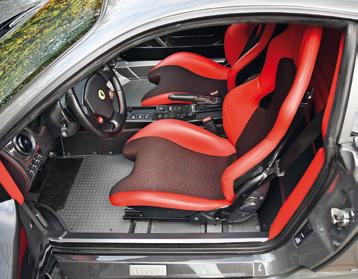
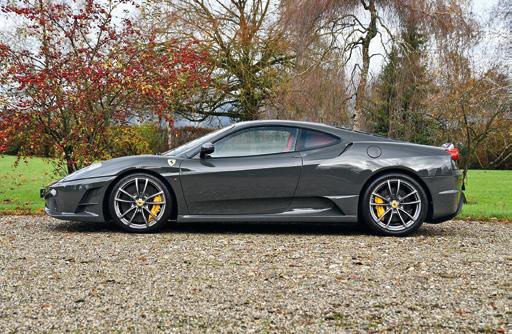
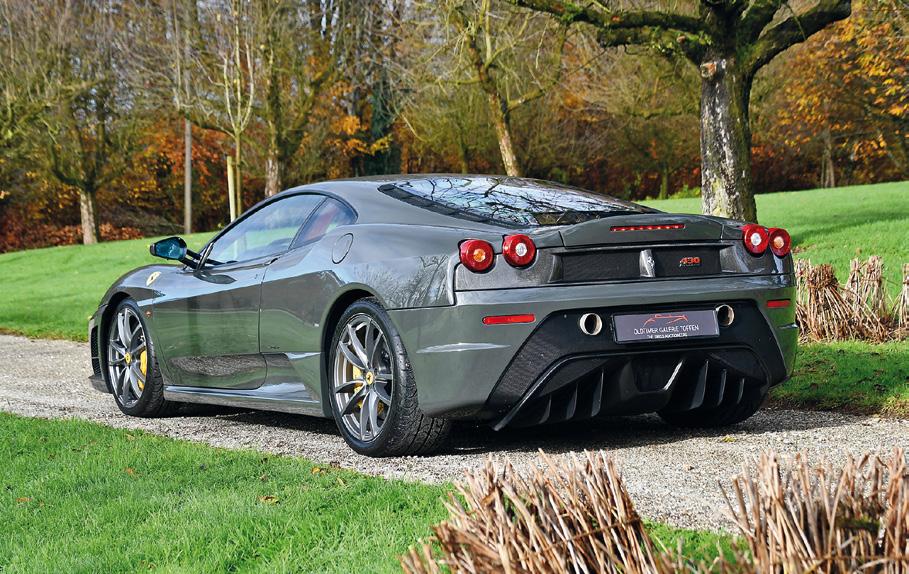

Dieser wunderschöne 430 Scuderia, bei dessen Entwicklung und Feinabstimmung kein anderer als die Formel 1 Legende Michael Schumacher mit Hand anlegte, wurde am 28. Januar 2008 erstmals zugelassen und am 22. März des Jahres durch die Ferrari Vertretung in Meerbusch an den Erstbesitzer aus München übergeben. In der eleganten Farbkombination «Grigio Scuro» mit rot/schwarzer Innenausstattung, Klappen-Auspuffanlage, KarbonKeramikbremsanlage, gelb lackierten Bremszangen, Karbon-Schalensitzen und vielen Karbon-Applikationen im Innen- und Motorraum, war der Scuderia gut gerüstet seinem Besitzer viel Freude zu bereiten. Im März 2010 wurde der Ferrari dann erstmals in der Schweiz vorgeführt und zugelassen. Ende 2016, mit damals knapp 22‘500
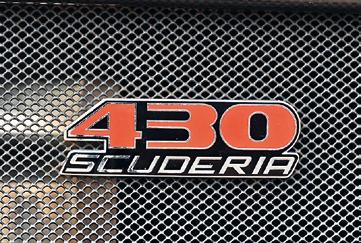
Cette magnifique 430 Scuderia, développée avec l‘aide de nul autre que la légende de la Formule 1 Michael Schumacher, a été immatriculée pour la première fois le 28 janvier 2008 et livrée à son premier propriétaire à Munich le 22 mars de la même année. Dans son élégante combinaison de „Grigio Scuro“ avec un intérieur rouge/noir, un échappement sport, un système de freinage en carbone céramique, des étriers de frein jaunes, des sièges baquets en carbone et de nombreux éléments en carbone dans l‘habitacle ainsi que dans le compartiment moteur, la Scuderia était bien équipée pour être appréciée par son premier propriétaire. En mars 2010, la Ferrari a été immatriculée pour la première fois en Suisse. À la fin de 2016, affichant alors environ 22‘500 kilomètres, la Ferrari a été reprise par le vendeur et ajoutée à sa collection. Il chérissait sa Scuderia et, comme le montre le carnet d‘entretien complet, il lui a accordé tout l‘entretien nécessaire. En octobre 2017, un léger dommage frontal - causé par la chute d‘un objet - a été réparé par les spécialistes de Niki Hasler AG. Ils se sont également occupés de tous les besoins d‘entretien de la voiture. Le dernier service a été effectué en janvier 2022 à 23‘409 kilomètres et en mars, la 430 a été chaussée de quatre nouveaux pneus Pirelli Corsa. Cette Ferrari 430 Scuderia, l‘un des environs 2‘500 exemplaires construits, est en très bon état, n‘a parcouru que 23‘500 kilomètres et sera remise à son nouveau propriétaire avec la dernière expertise effectuée en avril 2022.

45

1971 Aston Martin DBS V8 Convertible by Banham

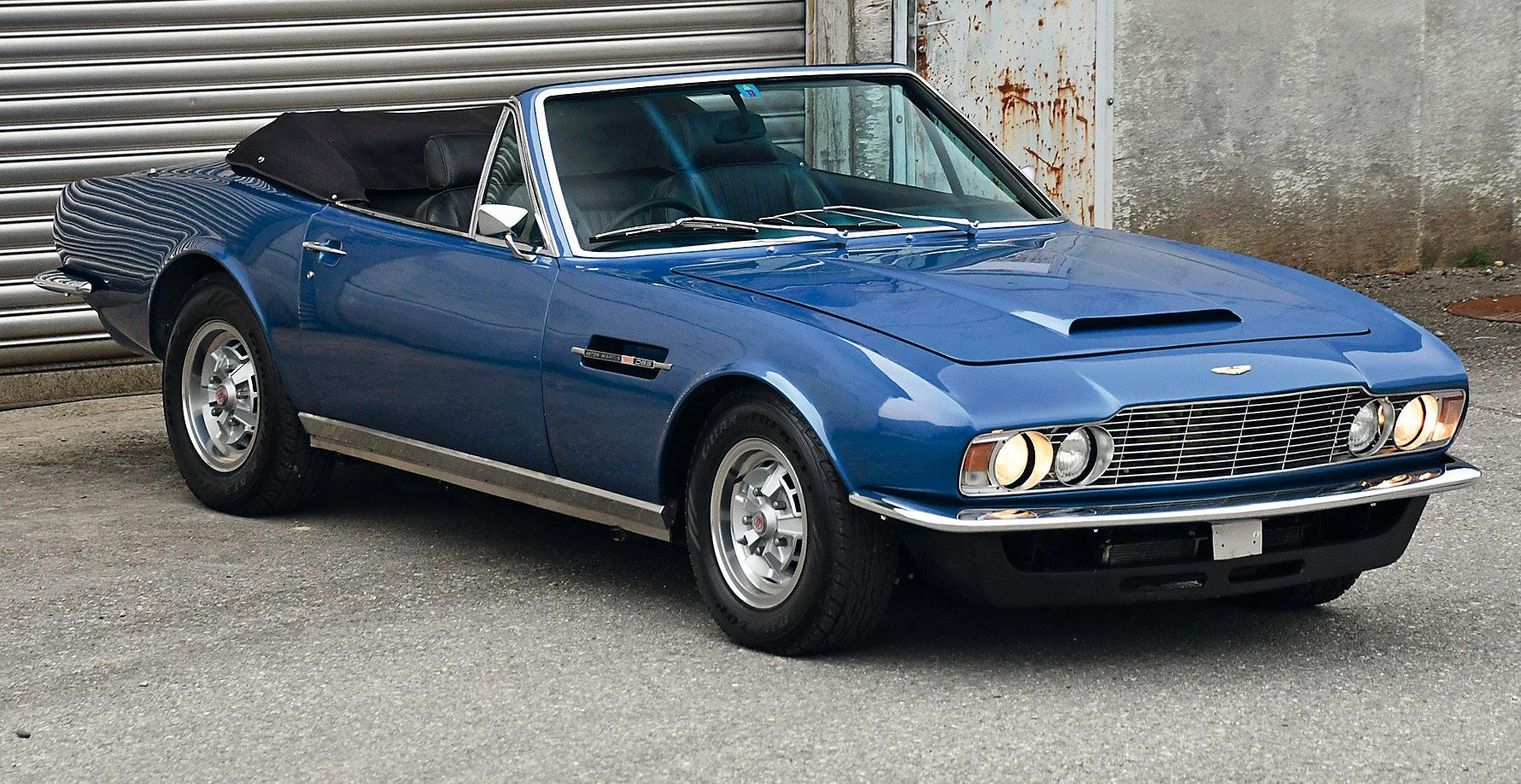 Chassis # DBSV8/10124/RC
Chassis # DBSV8/10124/RC

This early DBS V8 was delivered as a right hand drive Fixed head Coupé with automatic gearbox in January 1971, painted in “Jamaica Blue” with a black leather interior to its first owner Plough Motors Ltd. Aston Martin did not offer a drophead coupe until 1978, but specialists “Banham Conversions” in Kent converted a number of DBS and V8’s to dropheads during the 1970s. The example we have on offer was additionally given a (much more desirable) 5 speed manual gearbox at the same time. The exact date of the conversion as well as any additional history of the Aston is unfortunately not available up to the year 2000. By the time the car was acquired by the vendor in October 2011, the Aston Martin had had three UK owners and, as receipts available indicate, was always carefully and lovingly maintained. After importation into Switzerland and in order to prepare the DBS for the MOT, the brakes received an overhaul and a stainless-steel exhaust system as well as new dampers were installed. Two years and around 1’000 miles later, the convertible was deregistered and stored in the vendor‘s collection. The Aston Martin is in fair to good condition showing signs of use on the coach work as well as the interior and, due to its long period of inactivity, certainly will require a major service. The last MOT dates from May 2013.
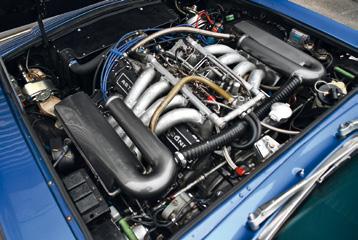
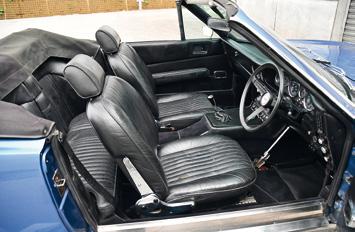
Dieser frühe DBS V8 wurde im Januar 1971 als Coupé mit Rechtslenkung und automatischem Getriebe in «Jamaica Blue» mit schwarzer Lederausstattung an die Firma Plough Motors Limited geliefert. Aston Martin bot bis 1978 kein Cabriolet an, der Spezialist Banham Conversions in Kent baute in den 1970er-Jahren aber auf individuellen Kundenwunsch einzelne DBS und V8 in Cabriolets um. So auch dieses Fahrzeug welches, vermutlich im Zuge des Umbaus, zusätzlich auf ein 5-Gang Schaltgetriebe umgerüstet wurde. Wann genau der Umbau durchgeführt wurde ist ebenso wenig dokumentiert wie die Fahrzeuggeschichte bis 2000. Bis zum Kauf durch den Einlieferer im Oktober 2011, hatte der Aston Martin drei englische Besitzer und wurde – wie die Belege zeigen – stets gepflegt. Nach dem Import in die Schweiz wurden für die MFK unter anderem die Bremsen revidiert, und eine Edelstahlauspuffanlage sowie neue Stossdämpfer montiert. Bereits zwei Jahre und knapp 1‘000 gefahrene Meilen später, wurde das Cabriolet abgemeldet und in der Sammlung des Einlieferers parkiert. Der Aston Martin befindet sich in ordentlichem bis gutem Zustand mit Gebrauchsspuren an Karosserie sowie Innenausstattung und benötigt aufgrund der langen Standzeit sicher einen grossen Service. Die letzte MFK erfolgte im Mai 2013.


47
Lot
V8 5‘340
320
CHF 60‘000
80‘000 at
122 approx. 10 cars
cc
bhp at 5‘800/min Estimate
-
no reserve
Photos Oldtimer Galerie
Veuillez trouver le descriptif en français sur www.TheSwissAuctioneers.swiss
1939 BMW 327 Sportkabriolett
Chassis # 73808
The BMW 327 is a medium-sized touring coupé produced by the Bavarian firm between 1937 and 1941, and again produced after 1945. It sat on a shortened version of the BMW 326 chassis.
The first 327, launched in 1937, was a cabriolet. In 1938, this was joined by a fixed head coupé version. The car was shorter and lower than its sedan counterpart, but shared the famous BMW grill and a streamlined form representative of the more progressive designs of the 1930s.
During the 1930s, Eisenach was the centre of BMW’s automobile manufacturing. In 1945, Eisenach was occupied by United States forces. However, the wartime allies had already agreed that Thuringia would fall within the Soviet occupation zone. BMW‘s automobile factory in Eisenach was not fully destroyed, and assembly of the 327 resumed. Clear production figures are hard to obtain, but many of the 327s surviving with collectors into the twenty-first century were post-war products. After the war, it became clear that the Soviets would not return the Eisenach factory to BMW. BMW-branded automobiles produced between 1945 and 1952 were therefore being produced outside the control of BMW headquarters in Munich.
Mechanically, the car utilised the hydraulic brake control, gear box, clutch and front suspension system first seen on the BMW 326, along with the live axle used on the BMW 320 and BMW 328. The BMW M78 straight-6 engine was used. The advertised top speed was 125 km/h.
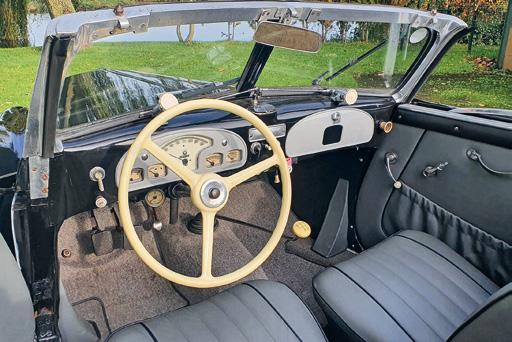
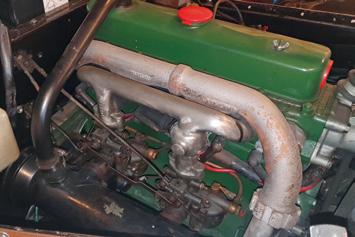
Among some enthusiasts, the 327 has subsequently been overshadowed by its more uncompromising sibling, the 80 bhp BMW 328 which appeared in April 1936. In its day, however, the 327 was the bigger seller, with 1‘396 base engined versions built between 1937 and 1941, and significant further production after 1945.
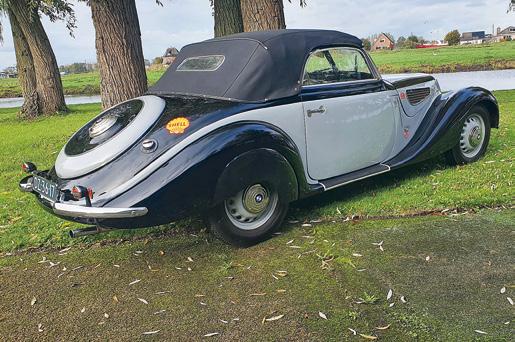


This caused a protracted dispute concerning title to the BMW brand and other assets, but in 1952 it was determined that Eisenach-produced models such as the 327s should be badged as EMW (Eisenacher Motorenwerk, Eisenach Motors‘ Works) rather than as BMW (Bayerische Motoren Werke, Bavarian Motors‘ Works). The BMW‘s blue and white badge from the Bavarian coat of arms changed to the EMW‘s red and white badge from the Thuringian coat of arms.
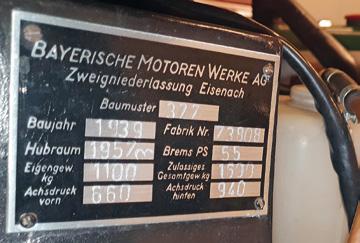
48 www.TheSwissAuctioneers.swiss
Lot 123 1‘124 cars (Sportkabriolett) in-line 6 cylinder 1971 cc 55 hp at 4‘500/min Estimate CHF 125‘000 - 135‘000 Story wikipedia.org Photos by consignor
The 327 “Sportkabriolett” (note the spelling!) was built from 1937 to 1941 at the BMW subsidiary in Eisenach. Only 1’124 examples of this elegant open 2-seater were sold at the hefty price of 7’500 Reichsmark. The example on offer was delivered to BMW importer Drenowatz in Zurich in early 1939 and spent most of its life in Switzerland. At one stage the cabriolet was apparently restored and repainted in red/beige. After three Swiss owners the BMW was acquired in 2017 by the vendor and transferred to Holland. He commissioned a restoration of the coachwork and interior resulting in a repaint in the original black/ grey and installation of a new soft top. The interior was renewed in grey leather and new carpets were fitted. The complete mechanics as well as the original matching numbers engine were inspected and overhauled as necessary. As a result, the pretty cabriolet present itself today in a good to very good condition and is ready for enjoyable outings in the next summer. The car has EU documentation, but Swiss customs duties have not been paid. Copies of the old Swiss registration are available which should facilitate a renewed registration in Switzerland.

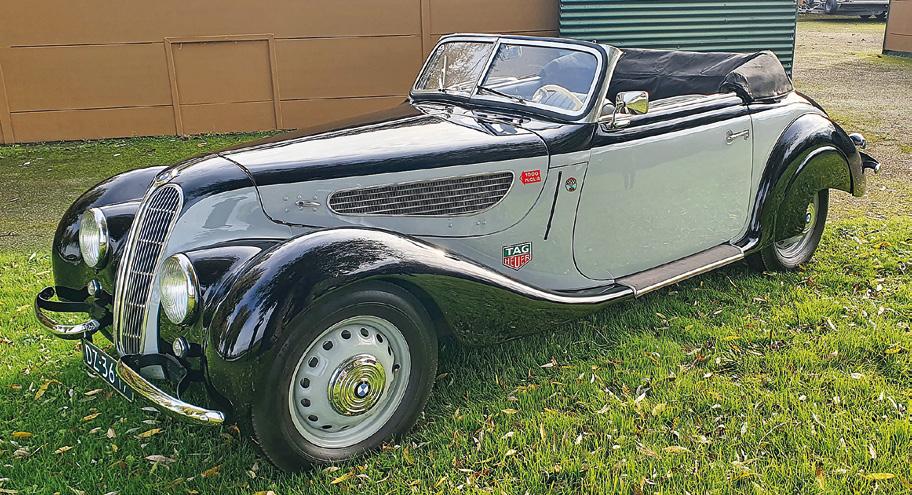
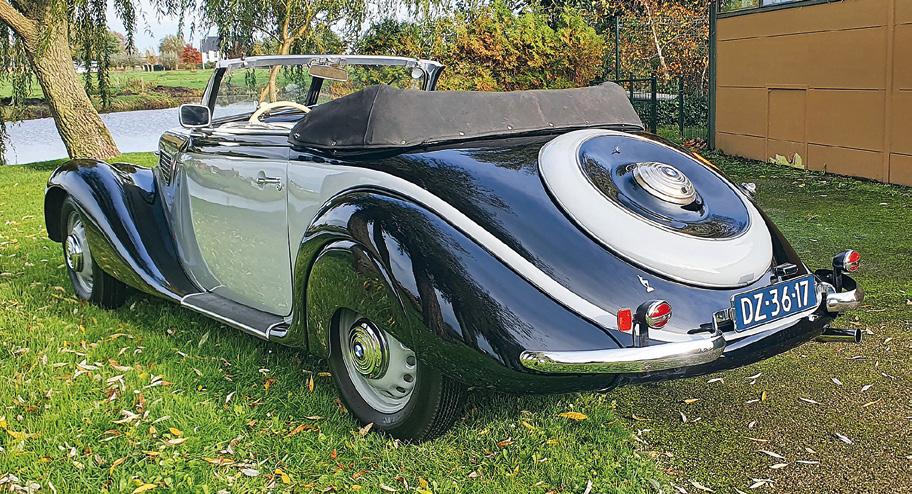
Das 327 Sportkabriolett – man beachte die Schreibweise – wurde von 1937 bis 1941 im BMW Zweigwerk Eisenach gebaut. Gerade einmal 1‘124 Exemplare dieses eleganten offenen Zweisitzers wurden in dieser Zeit zu einem Preis von 7‘500 Reichsmark verkauft. Das angebotene Exemplar wurde Anfang 1939 an den BMW Importeur Drenowatz in Zürich geliefert und verbrachte die meiste Zeit seines Lebens in der Schweiz. Irgendwann wurde das Cabriolet wohl restauriert und erhielt eine Lackierung in Rot/Beige. Nach 3 Schweizer Besitzern wurde der BMW 2017 vom Einlieferer erworben und nach Holland überführt. Dieser entschied sich für eine Restaurierung von Karosserie und Innenausstattung – so wurde der 327er in der Originalkombination Schwarz/Grau neu lackiert und erhielt ein neues Verdeck. Die Innenausstattung wurde in grauem Leder neu angefertigt und es wurden neue Teppiche verlegt. Die komplette Mechanik wie auch der «Matching-Numbers» Originalmotor wurden überprüft und wo nötig in Stand gestellt. So präsentiert sich das hübsche Cabriolet heute in gutem bis sehr gutem Zustand und ist bereit für genussvolle Ausfahrten im kommenden Sommer.
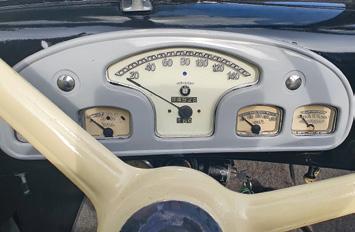
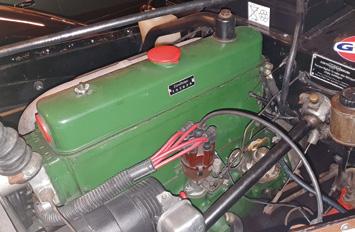
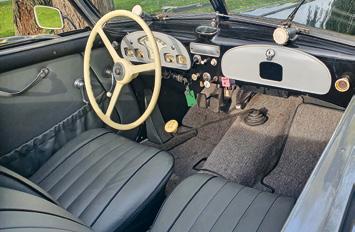

Das Fahrzeug besitzt EU-Fahrzeugpapiere und ist in der Schweiz nicht verzollt. Kopien der alten Schweizer Papiere sind vorhanden, was eine erneute Zulassung hier sicherlich vereinfachen wird.
La 327 „Sportkabriolett“ (notez l‘orthographe!) a été construite de 1937 à 1941 dans la filiale de BMW à Eisenach. Seuls 1‘124 exemplaires de cette élégante voiture ouverte à deux places ont été vendus au prix élevé de 7‘500 Reichsmark. L‘exemplaire proposé a été livré à l‘importateur BMW Drenowatz à Zurich au début de 1939 et a passé la majeure partie de sa vie en Suisse. A un moment donné, le cabriolet a apparemment été restauré et repeint en rouge/beige. Après trois propriétaires suisses, la BMW a été acquise en 2017 par le vendeur et transférée en Hollande. Il a commandé une restauration de la carrosserie et de l‘intérieur résultant en une repeinture dans le noir/ gris d‘origine et l‘installation d‘une nouvelle capote. L‘intérieur a été renouvelé en cuir gris et de nouvelles moquettes ont été installées. La mécanique complète ainsi que le moteur d‘origine ont été inspectés et révisés si nécessaire. En conséquence, le joli cabriolet se présente aujourd‘hui dans un bon à très bon état et est prêt pour d‘agréables sorties l‘été prochain. La voiture dispose de papiers européens, mais les droits de douane suisses n‘ont pas été payés. Une copie de l‘ancienne immatriculation suisse est disponible, ce qui devrait faciliter le renouvellement de l‘immatriculation en Suisse.

49
1969 Ferrari 365 GT 2+2
Chassis # 365GT*12901
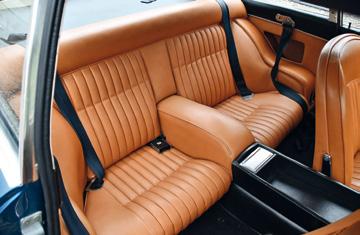

When Ferrari introduced its 365 GT 2+2 at the Paris Salon in 1967, it represented its largest, best-equipped, and most luxurious model to date. Serving as the successor to the 330 GT 2+2 and wearing styling by Pininfarina, the V-12 Grand Tourer became a great commercial success, accounting for about half of total Ferrari production during its brief three-year run.
The Ferrari 365 GT 2+2 rested on a 2,650-millimeter wheelbase platform, based on the contemporary 330GTS, and was created using the company‘s traditional combination of oval and round steel tubing. It was the first Ferrari to be equipped with standard ZF power-assisted steering and power brakes, and the company‘s first 2+2 model with a hydro-pneumatic self-leveling independent rear suspension (by Koni). This setup allowed it to maintain a constant ride height regardless of passenger and luggage load. The fully independent suspension system was another first for a Ferrari 2+2 model and provided excellent handling. While its stablemates including the 365 GTB/4 received rear transaxles, the five-speed gearbox of the 365 GT 2+2 was mated to the engine with power transmitted via torque-tube drive to a frame-mounted rear-differential assembly. Further refinements included mounting the engine and drive-train in rubber bushes to insulate the car‘s occupants from noise and vibration. Girling ventilated discs at all four corners provided the stopping power.

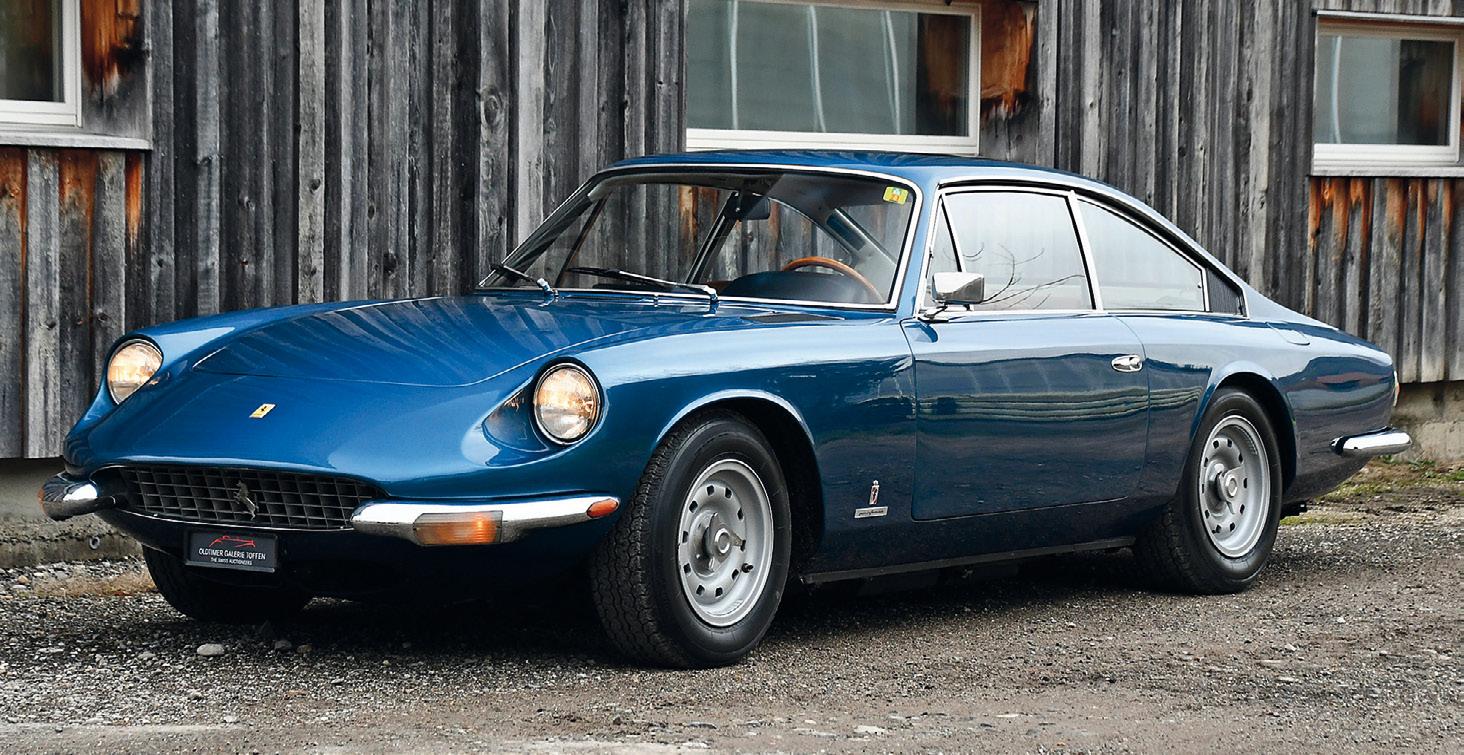
Beneath the long and graceful bonnet was a 4.4-liter Tipo 245 twelve-cylinder engine fitted with a single overhead camshaft per cylinder bank with induction via triple dual-choke Weber carburetors. Ignition was a Marelli-Dinoplex system with twin coils and distributors. Output was rated at 368 bhp (American SAE) and
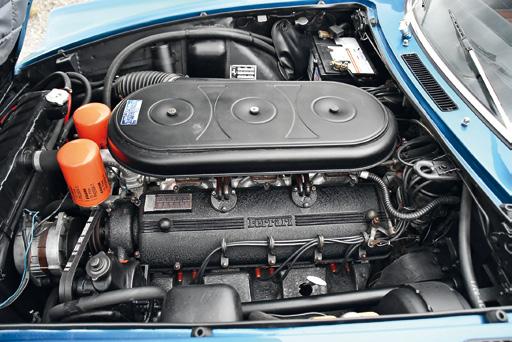
320 bhp (DIN) at 6‘600 rpm, making it an ideal Grand Touring car with enviable speed and long-distance performance. Complimenting its advanced mechanical setup with an equally impressive luxurious interior with plush leather upholstery, veneered wooden trim panels, and standard power-operated window lifts. The 2+2 seating accommodated up to four passengers.
The frontal styling was reminiscent of the 365 California with a rounded nose with recessed headlamps and an elliptical egg-crate grille. Side markers and turn-signal lamps were carefully incorporated into the front quarter-bumpers, and the gently sloping roofline was slightly longer than that of the 330 GT 2+2, flowing into a nearly flat deck lid and aero-efficient Kamm tail. The Ferrari factory in Modena assembled and installed the mechanical components while Pininfarina in Turin constructed the bodies and the upholstery.
The Ferrari 365GT 2+2 was capable of sprinting from zero-to-sixty mph in 7.0 seconds and had a top speed of approximately 150 mph.
50 www.TheSwissAuctioneers.swiss
Lot 124 809 cars V12 4‘390 cc 320 hp at 6‘600/min Estimate CHF 235‘000 - 255‘000 Story conceptcarz.com
Photos Oldtimer Galerie
This beautiful Ferrari GT, affectionately known as “Queen Mary” (due to its not inconsiderable size), is a Swiss delivery through SAVAF Geneva. The classic Ferrari Gran Turismo has had only three owners in the last 30 years and has been driven sparingly. Around 20 years ago the coachwork was restored and repainted in the original colour “Blu Ribot”. At the same time the interior received a new beige VM 846 leather. In 2019 around 1’000 kilometres ago, and after a longer period of inactivity, a major service was performed including a replacement of all fuel lines, a revision of the rear brake callipers together with the renewal of the rear brake discs and lines. At the same time new rear Ansa exhaust silencers as well as new tyres were installed. The Ferrari is in good to very good condition with the matching-numbers engine running sweetly and the gearbox operating as it should. This great 365 has been driven probably around 122’500 kilometres and will be sold with the latest Veteran MOT completed in October 2019.
Bei dieser schönen «Queen Mary» handelt es sich um eine Schweizer Auslieferung an SAVAF Genf. Der klassische Ferrari Grand Tourismo hatte während der letzten 30 Jahre nur drei Besitzer und wurde nur wenig gefahren. Vor gut 20 Jahren wurde die Karosserie restauriert, und in der Originalfarbe „blu ribot“ neu lackiert, zur selben Zeit wurde die Innenausstattung mit Leder in Beige VM 846 erneuert. 2019, vor rund 1‘000 km und nach längerer Standzeit, wurde ein grosser Service inklusive neuen Benzinleitungen, Revision der hinteren Bremszangen, neuen hinteren Bremsscheiben und -Leitungen, neuen ANSA-Endschalldämpfern und neuen Reifen durchgeführt. Der Ferrari befindet sich in gutem bis sehr gutem Zustand, der Matching-Numbers Motor läuft einwandfrei und das Getriebe schaltet sich gut und knackig. Dieser tolle 365er hat vermutlich rund 122‘500 Kilometer gefahren und wird mit der letzten MFK als Veteranenfahrzeug im Oktober 2019 an einen neuen Liebhaber übergeben.

Cette magnifique Ferrari GT, affectueusement surnommée „Queen Mary“ (en raison de sa taille non négligeable), est une livraison suisse par la SAVAF Genève. Cette Ferrari Gran Turismo classique n‘a eu que trois propriétaires au cours des 30 dernières années et a été conduite avec parcimonie. Il y a environ 20 ans, la carrosserie a été restaurée et repeinte dans la couleur d‘origine „Blu Ribot“. Dans le même temps, l‘intérieur a reçu un nouveau cuir beige VM 846. En 2019, il y a environ 1‘000 kilomètres, et après une plus longue période d‘inactivité, un service majeur a été effectué comprenant le remplacement de toutes les conduites de carburant, une révision des étriers de frein arrière en même temps que le renouvellement des disques de frein arrière et des conduites. En même temps, de nouveaux silencieux d‘échappement Ansa ainsi que des pneus neufs ont été installés. La Ferrari est en bon à très bon état, le moteur, dont les numéros sont corrects, fonctionne bien et la boîte de vitesses fonctionne comme il se doit. Cette superbe 365 a été conduite probablement autour de 122‘500 kilomètres et sera vendue avec la dernière expertise vétéran complétée en octobre 2019.

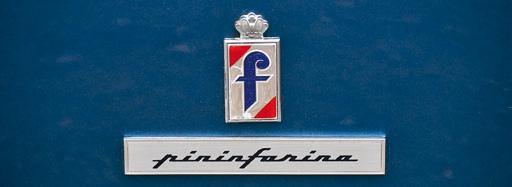
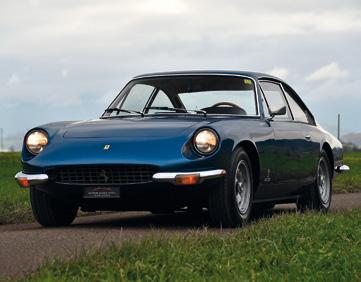
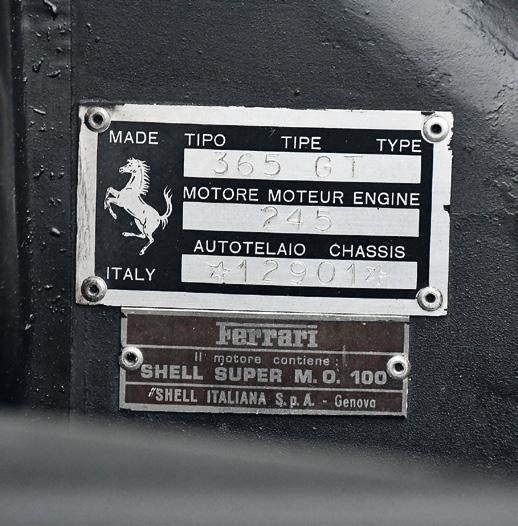


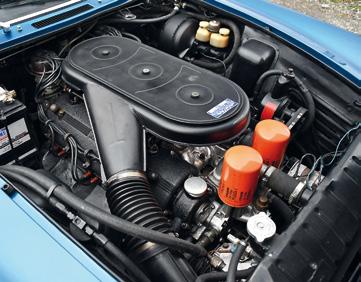
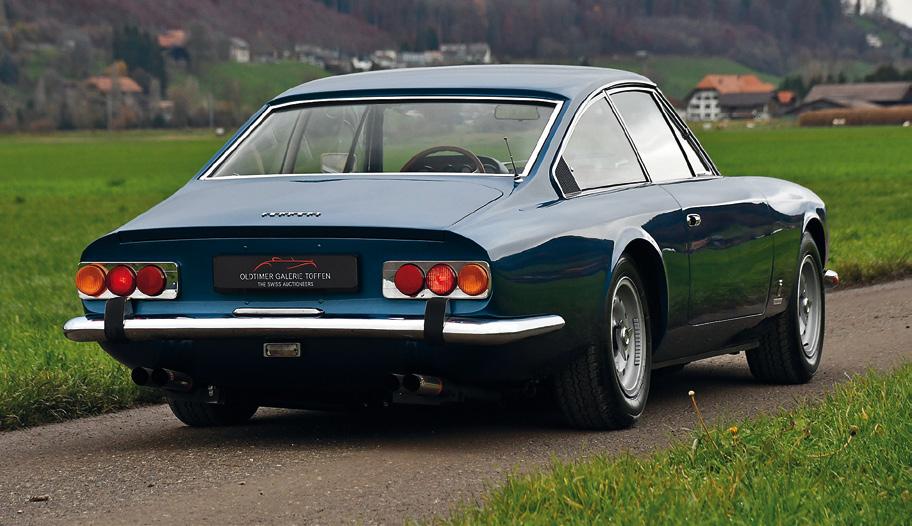
51
1989 Porsche 911 (930) Turbo Cabriolet

Chassis # WP0EB0936KS070204

For the 1975 model year, Porsche introduced the first production turbocharged 911. Although called the 930 Turbo (930 being its internal type number) in Europe, it was marketed as the 930 Turbo Carrera in North America. The 3.0-liter flat-six engine was given a largecapacity Kühnle, Kopp & Kausch turbocharger, the suspension was modified, a strengthened four-speed gearbox was fitted, and larger brakes were placed at all four corners. The turbocharger‘s wastegate was a ‚world production car‘ first. To help send the power to the ground, the wheel arches were widened and larger tires were installed. A function ‚whale-tail‘ spoiler was added to the back to reduce rear-end lift at speed.
Production of the first 400 units qualified the 930 for FIA Group 4 competition. With the racing version called the Porsche 934 of 1976 participating at the 24 Hours of Le Mans and other races including battles with the BMW 3.0 CSL „Batmobile“. The FIA Group 5 version called Porsche 935 evolved from the 934. Fitted with a slope nose or „slant nose“, the 500+ PS car was campaigned in 1976 by the factory, winning the world championship title. Private teams went on to win many races, like Le Mans in 1979, and continued to compete successfully with the car well into the 1980s until the FIA and IMSA rules were changed.
For the 1978 model year, Porsche revised the 930 with a larger 3.3-litre turbocharged engine with intercooler rated at 300 PS. To fit the intercooler a newly designed „tea-tray“ tail spoiler replaced the earlier whale tail spoiler. Porsche dropped the „Carrera“ nomenclature for the North American markets and the car was simply called the Porsche 911 Turbo worldwide. The larger engine helped reduce some of the turbo lag inherent in the earlier models.

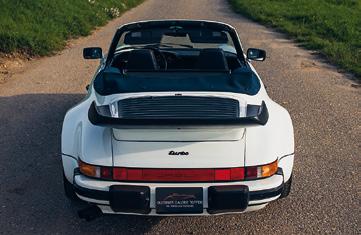
Stiff emission mandates made the Porsche Turbo scarce in the United States, making 1979 the last model year for the 930 in the U.S. until 1986. Production continued for Porsche‘s other markets. The new redesignated 911 Turbo returned to America in 1986. A catalytic converter with an oxygen sensor helped it meet emissions standards and US-spec power output rose to 286 horsepower.
In 1989, a 5-speed manual transmission became available for the 930. The 930 was replaced in 1990 with the 964 turbo featuring the same 3.3-litre engine. There have been turbocharged variants of each subsequent generation of 911 since then.
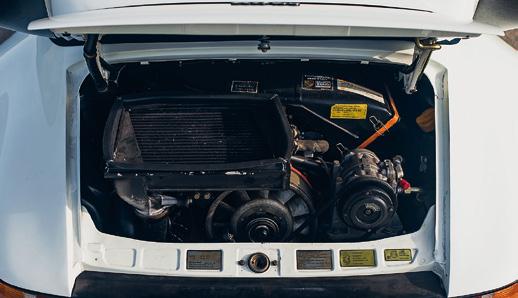


52 www.TheSwissAuctioneers.swiss
Lot 125 844 cars (5-speed) turbocarged 6 cyl. flat-engine 3‘258 cc 286 hp at 5‘500/min Estimate CHF 155‘000 - 175‘000
Story conceptcarz.com
Photos Daniel Zizka
This 911 Turbo convertible, one of only 844 examples with a 5-speed gearbox, was originally delivered to the USA. In March 1990, the car found its way into Switzerland where it was registered by its then owner. Examples with a 5-speed gearbox were never officially imported into Switzerland making this car a very rare and exotic 911 indeed. With presumably 3 Swiss owners and only 51’500 kilometres driven, this open top supersportster is in very good and well-maintained condition and will provide endless excitement to a Porsche aficionado for many years. The most recent Veteran MOT was completed in June 2021.
Dieses 911 Turbo Cabriolet ist eines von nur 844 Fahrzeugen mit 5-Gang Getriebe und wurde neu in die USA ausgeliefert. Bereits im März 1990 fand der 911er den Weg in die Schweiz, wo er anschliessend zugelassen wurde. Speziell ist, dass die Fahrzeuge mit 5-Gang Getriebe nie offiziell in die Schweiz importiert wurden, womit dieses Exemplar hierzulande einen absoluten Exoten darstellt. Mit vermutlich drei Schweizer Vorbesitzern und erst

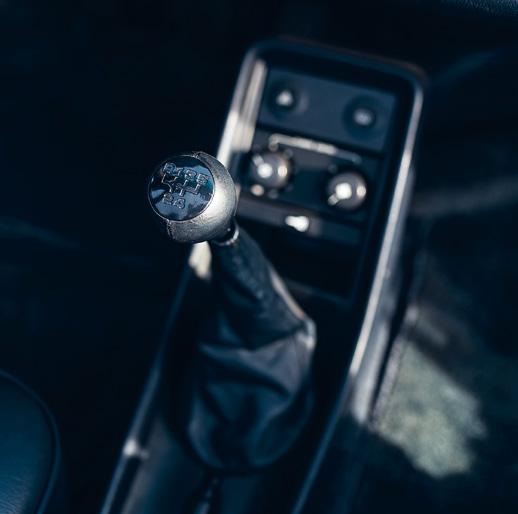
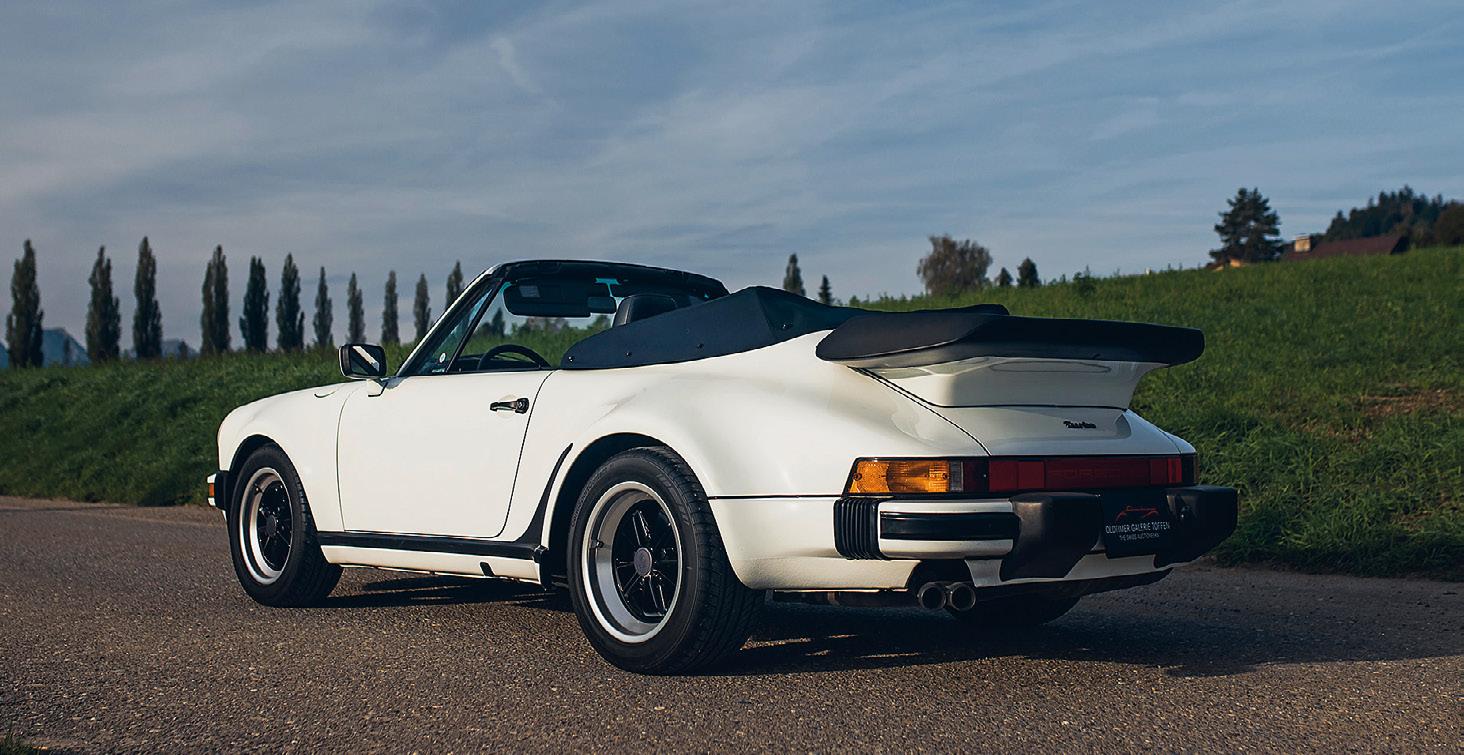


51‘500 gefahrenen Kilometern befindet sich dieser offene Supersportler in sehr gutem und gepflegtem Zustand und wird einem Liebhaber der Marke aus StuttgartZuffenhausen noch viele Jahre Freude bereiten. Die letzte MFK als Veteranenfahrzeug erfolgte im Juni 2021.
Cette 911 Turbo décapotable, l‘un des seulement 844 exemplaires équipés d‘une boîte de vitesses à 5 rapports, a été livrée à l‘origine aux États-Unis. En mars 1990 déjà, la voiture s‘est retrouvée en Suisse où elle a été immatriculée par son propriétaire de l‘époque. Les exemplaires avec une boîte de vitesses à 5 rapports n‘ont jamais été officiellement importés en Suisse, ce qui fait de cette voiture une 911 très rare et exotique. Avec vraisemblablement 3 propriétaires suisses et seulement 51‘500 kilomètres parcourus, cette supersportive à toit ouvert est en très bon état bien entretenue et fournira une excitation sans fin à un aficionado de Porsche pendant de nombreuses années. La dernière expertise vétéran a eu lieu en juin 2021.

53
1991 Ferrari Testarossa
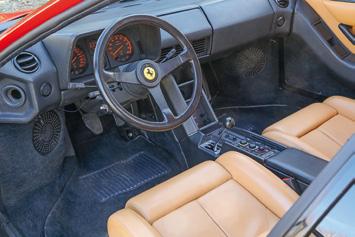
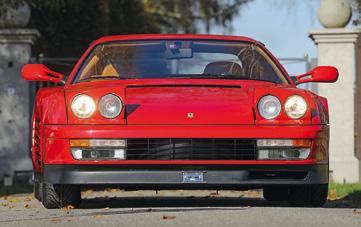

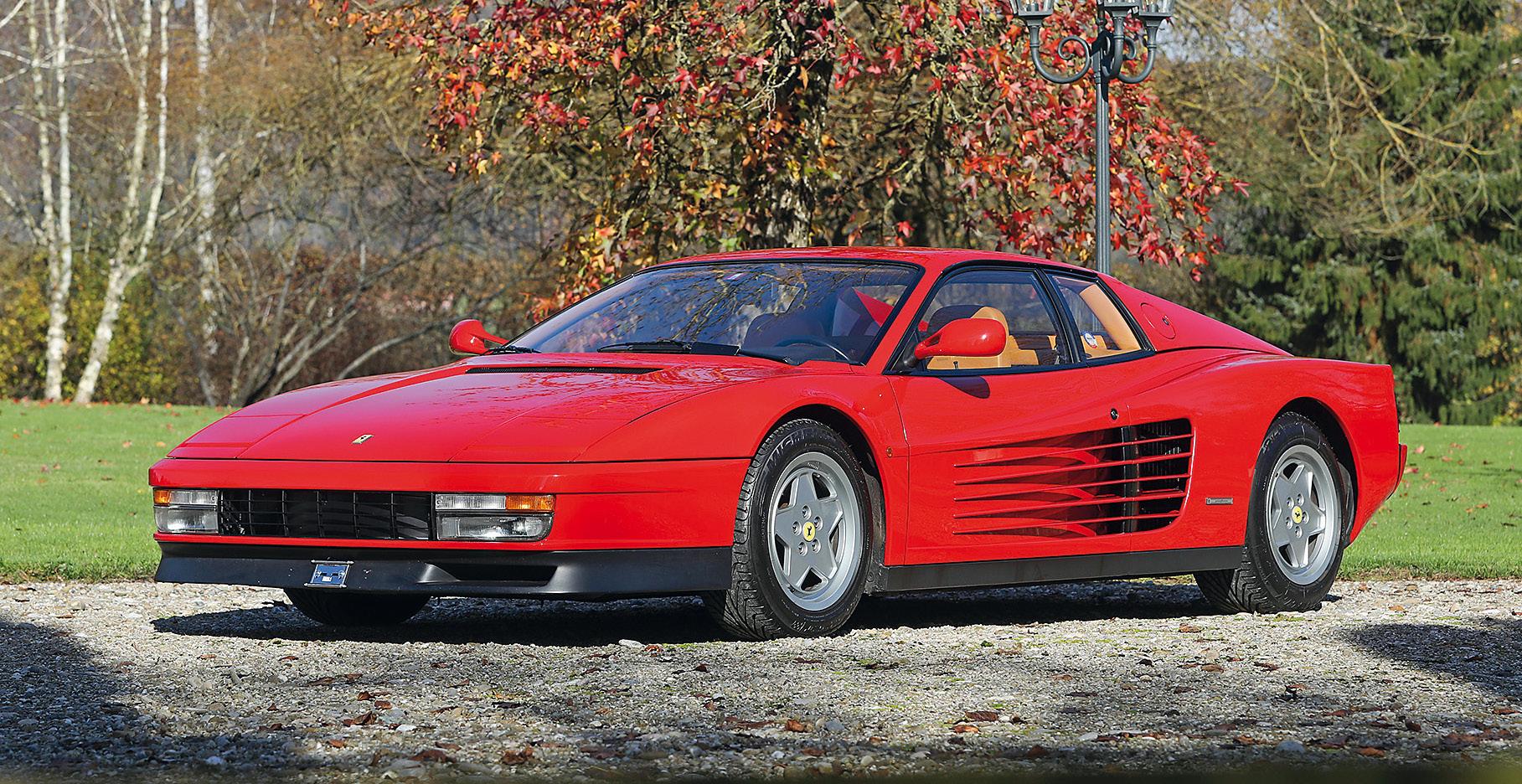
Chassis # ZFFSA17S000090905

The Testarossa is a two-door coupé that premiered at the 1984 Paris Auto Show and it‘s name paid homage to the famed World Sportscar Championship winner 1957 250 Testa Rossa sports racing car. Testa Rossa, which literally means „red head“ in Italian, refers to the red-painted cam covers sported by both cars‘ 12-cylinder engines. All versions of the Testarossa were available with a rear-mounted, five-speed manual transmission. The rear mid-engine design keeps the centre of gravity in the middle of the car, which increases stability and improves the car‘s cornering ability, and thus results in a standing weight distribution of 40% front: 60% rear. The original Testarossa was re-engineered for the 1992 model year and was introduced as the 512 TR (TR meaning TestaRossa), at the Los Angeles Auto Show, effectively as a completely new car, and an improved weight distribution of 41% front, 59% rear. Another new variant called the F512 M was introduced at the 1994 Paris Auto Show. The car dropped the TR initials and added the M which in Italian stood for modificata, or translated to modified, and was the final version of the Testarossa, which continued its predecessor‘s weight distribution improvement of 42% front, 58% rear. The F512 M was Ferrari‘s last vehicle that featured the flat-12 engine. The Testarossa traces its roots back to the faults of the 1981 512 BBi. The problems that the Testarossa was conceived to fix included a cabin that got increasingly hot from the indoor plumbing that ran between the front-mounted radiator and the midshipsmounted engine and a lack of luggage space. To fix these problems the Testarossa was designed to be larger than its predecessor. For instance, at 1‘976 mm wide, the Testarossa was half a foot wider than the Boxer. This resulted in an increased wheelbase that stretched about 64 mm to 2‘550 mm, which was
used to accommodate luggage in a carpeted storage space under the front forward-opening hood. The increase in length created extra storage space behind the seats in the cabin. Headroom was also increased with a roofline half an inch taller than the Boxer.
The design came from Pininfarina. The design team at Pininfarina consisted of Ian Cameron, Guido Campoli, Diego Ottina and Emanuele Nicosia. They were led by design chief Leonardo Fioravanti, who also designed many other contemporary Ferrari models. The design was originated by Nicosia, but the guidance of Fioravanti was equally important. Being trained in aerodynamics, Fioravanti applied his know-how to set the layout of the car. The designers were originally trying to minimize the necessary side intakes, which also could not be left open due to American safety legislation, but then decided on making them a statement of style instead - one that ended up becoming emblematic of the late eighties. The Testarossa did not need a rear spoiler. The aerodynamic drag coefficient of Cd=0.36 was significantly lower than the Lamborghini Countach‘s 0.42.
54 www.TheSwissAuctioneers.swiss
Lot 126 7‘177 cars 180° V12 4‘941 cc 380 hp at 5‘750/min Estimate CHF 115‘000 - 125‘000 Story wikipedia.org Photos zwischengas.com
The styling was a departure from the curvaceous boxer—one which caused some controversy. The side strakes sometimes referred to as „cheese graters“ or „egg slicers,“ that spanned from the doors to the rear fenders were needed for rules in several countries outlawing large openings on cars. Unlike the Berlinetta Boxer, the Testarossa had twin side radiators near the engine at the rear instead of a single radiator up-front - eliminating much piping and allowing for a much cooler cabin. After passing through the engine bay, the cooling air exited through the vents at the engine lid and the tail. The strakes also made the Testarossa wider at the rear than at the front, thus increasing stability and handling. One last unique addition to the new design was a single high mounted side view mirror on the driver‘s side. On US-based cars, the mirror was lowered to a more normal placement for the 1987 model year and was quickly joined by a passenger side view mirror for the driver to be able to make safe lane changes. Like its predecessor, the Testarossa used double wishbone front and rear suspension systems. Ferrari improved traction by adding 10-inch-wide alloy rear wheels. The Testarossa‘s drivetrain was also an evolution of the 512 BBi. Its engine used near identical displacement and compression ratio, but unlike the 512 BBi had four-valve cylinder heads that were finished in red.
Kilometern, wurde der Ferrari vom Einlieferer übernommen und in dessen Sammlung integriert. In den letzten sieben Jahren wurde der Wagen nur sehr wenig gefahren, aber stets gewissenhaft gewartet, wie die vorhandenen Unterhaltsbelege zeigen. Aus zweiter Hand, mit erst rund 25‘700 gefahrenen Kilometern und lückenlosem Serviceheft befindet sich diese Ikone der Ferrari Geschichte in sehr gutem Zustand. Der letzte grosse Service inklusive Zahnriemenwechsel erfolgte vor 200 Kilometern im Mai 2022, womit das wunderschöne Coupé bereit ist einen neuen Liebhaber mit dem Klang des kraftvollen Zwölfzylinders zu erfreuen. Die letzte MFK als Veteranenfahrzeug erfolgte im September 2021.
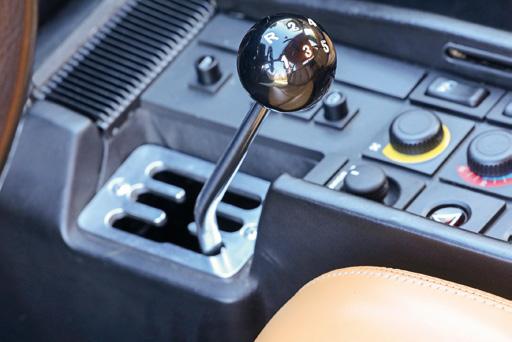
This Testarossa was handed over to its first lucky owner by AD Autodiffusion S.A. in Meyrin on the 29th of July 1991. In 2015, then showing 24’600 kilometres, the Ferrari was taken over by the vendor and added to his collection. In the last seven years the car was used very little but always carefully maintained as documented with numerous maintenance receipts. With only two owners and 25’700 kilometres driven and a complete service booklet, this Ferrari icon is in very good condition. The last major service, which included a cambelt change, was completed only 200 kilometres ago in May 2022 and so this breathtaking Coupé with its unmistakeable 12-cylinder sound is ready to be enjoyed by a new enthusiast. The most recent Veteran MOT was completed in September 2021.

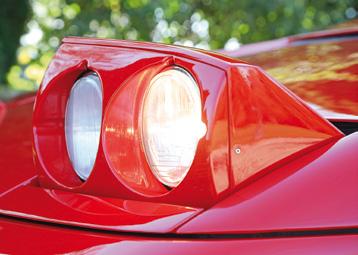


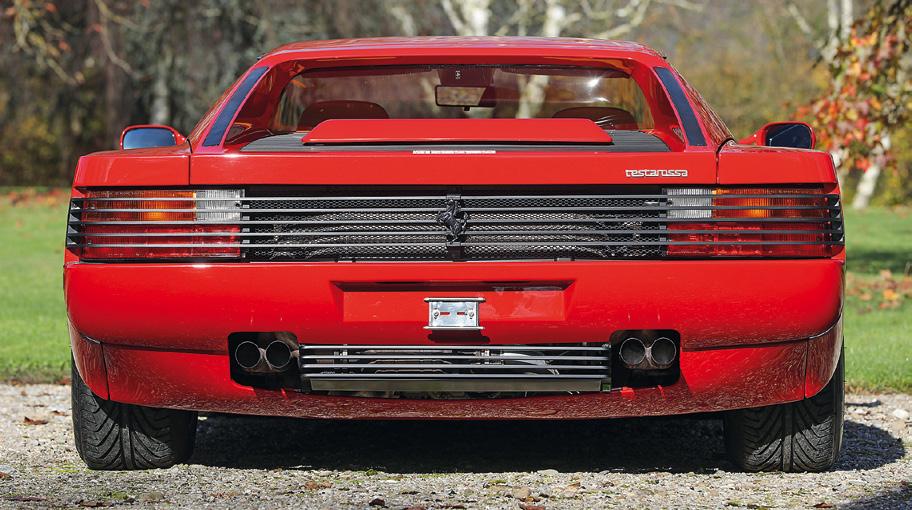

Dieser Testarossa wurde am 29. Juli 1991 durch die AD Autodiffusion S.A. in Meyrin an den glücklichen Erstbesitzer übergeben. 2015, mit damals 24‘600 gefahrenen
Cette Testarossa a été remise à son premier heureux propriétaire par AD Autodiffusion S.A. à Meyrin le 29 juillet 1991. En 2015, affichant alors 24‘600 kilomètres, la Ferrari a été reprise par le vendeur et ajoutée à sa collection. Au cours des sept dernières années, la voiture a été très peu utilisée mais toujours soigneusement entretenue comme le documentent les reçus d‘entretien. Avec seulement deux propriétaires, 25‘700 kilomètres parcourus et un carnet d‘entretien complet, cette icône Ferrari est en très bon état. Le dernier service majeur, qui comprenait un changement de courroie, a été effectué il y a seulement 200 kilomètres en mai 2022 et donc cet époustouflant Coupé avec son bruit incomparable 12 cylindres est prêt à être apprécié par un nouvel enthousiaste. La dernière expertise vétéran a été effectuée en septembre 2021.

55
1951 Alfa Romeo 1900 Berlina Abarth
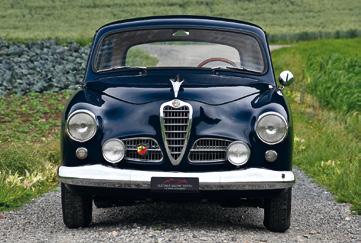

Chassis # AR1900*90734*
With the “Millenove”, Alfa Romeo introduced the first assembly line at the Portello plant, created its first car with a load-bearing body and launched the four-cylinder twin-cam engine that would pave the way for years of future success.
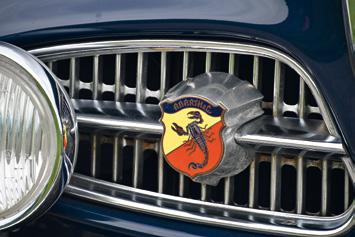
After winning the first two Formula 1 World Championships, Alfa Romeo left the highest category of motor racing undefeated, an achievement that most constructors can only dream of. It was no early retirement by a fading champion anticipating a reversal in fortunes, but a very deliberate strategic choice linked to transformations under way in the company. The Milanese automaker was concentrating all its efforts on manufacturing a new car, a task that it entrusted to designer Orazio Satta Puliga. Indeed in 1950, the elegant 1900 was unveiled, the first Alfa Romeo car with a unitised body integrated with the chassis. But that was not the only innovation: the Portello plant was radically restructured for industrial-scale production by introducing an assembly line.
The Alfa Romeo 1900 had a conventional mechanical design, including a longitudinal front engine, four-speed gearbox, rear wheel drive, independent front suspension with coil springs and stabiliser bar, plus a rigid rear axle with longitudinal connecting rod, central triangular arm and coil springs. The straight-four 1884 cc engine, which was equipped with an aluminium cylinder head with two chain-driven camshafts fed by a single carburettor, developed 80 hp and propelled the 1100 kg Millenove to a top speed of 150 km/h.
On the outside, the saloon silhouette was sedate and elegant, characterised by soft curves and a chromeplated grille with distinctive three-lobed motif, an

unmistakable style hallmark of the Milanese manufacturer. On the inside, the single front seat bench and steering-mounted gear lever allowed the car to easily transport six people.

Known for its famous slogan, „The family car that wins races“, the 1900 was an excellent saloon for everyday use and began to dominate competitions in the Touring class.
Although contingent factors prompted Alfa to leave Formula 1, the Milanese car maker stayed true to its sporting DNA. Over the years, the first 1900 was supplemented with more powerful versions, starting with the T.I. (Turismo Internazionale) in 1952, which adopted a twin-barrel carburettor and larger valves that enabled the twin-cam engine to deliver 100 hp at 5500 rpm, for a top speed of 170 km/h. The car became a favourite among gentlemen drivers and enthusiasts competing in road and track races.
In 1954 came the 1900 Super and the feistier T.I. Super, both featuring an increased displacement of 1957 cc.

56 www.TheSwissAuctioneers.swiss
Lot 127 17‘243 cars (all 1900 Berlina) in-line 4 cylinder 1‘884 cc approx. 100 hp at 5‘500/min Estimate CHF 55‘000 - 65‘000
Story fcaheritage.com
Photos Oldtimer Galerie
With a higher compression ratio of 8:1, the T.I. Super produced 115 hp and its top speed increased to 180 km/h. Coachbuilder Boano created an original threedoor version based on the Berlina, which was called the „Primavera“ and was also available in a two-tone variant.
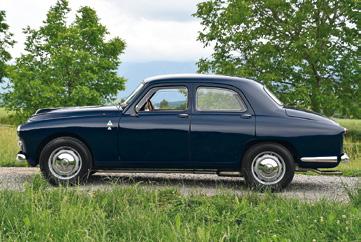
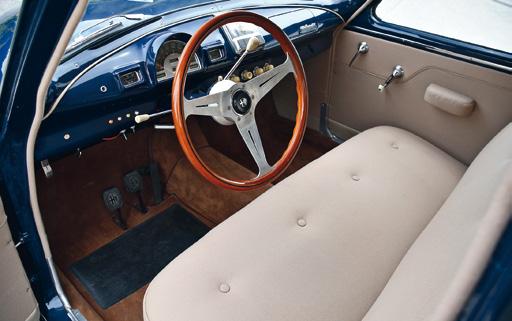

In 1951, Alfa Romeo began designing variants of the saloon, to offer customers different styling and usage possibilities. Rolling chassis were made available to major design studios: Pininfarina created an elegant coupé and a sedate cabriolet, while Touring penned a sports berlinetta with aluminium bodywork called the 1900 Sprint, which in 1955 was updated and renamed the 1900 Super Sprint with the introduction of the 1957 cc engine and 5-speed gearbox; this last setup formed the basis of a racing version developed by Zagato, the original SSZ coupé.
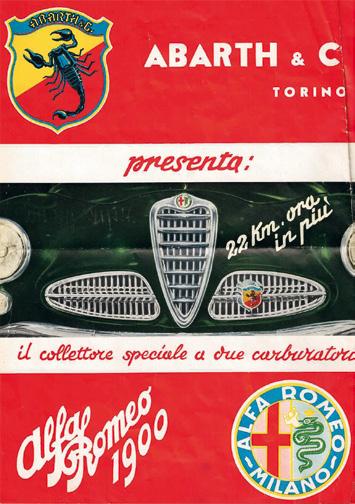
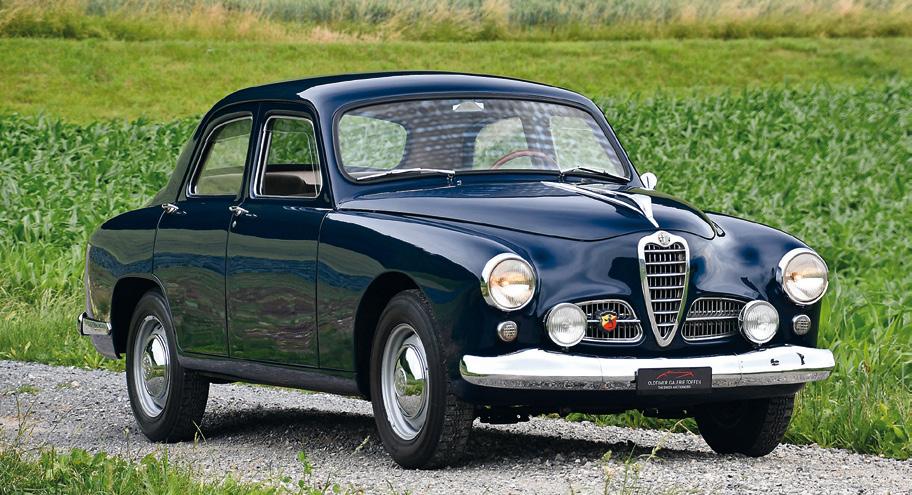
Dieser wunderschöne Alfa Romeo wurde am 31. Oktober 1951 gebaut, und am 5. November des Jahres an Alfa Romeo Lugano geliefert – der originale Verzollungsausweis vom 14. November 1951 ist bis heute vorhanden. Im Laufe ihres Lebens wurde die Berlina einem zeitgemässen Abarth Tuning mit zwei Weber Vergasern und Abarth-Ansaugbrücke unterzogen – was gemäss Abarth-Prospekt zu einer um 22 km/h gesteigerten Höchstgeschwindigkeit führt. Nach einigen Vorbesitzern und einem Farbwechsel von blau auf grün, wurde der Alfa vor einigen Jahren originalgetreu restauriert und präsentiert sich wieder im eleganten Dunkelblau. Die Mille-Miglia taugliche Limousine verfügt über eine FIVA-ID, ein Alfa Romeo Certificato d’Origine, welches die MatchingNumbers bestätigen, auch das originale Garantieheft von 1951 ist vorhanden. Der Alfa Romeo befindet sich in ausgezeichnetem Zustand und hat die letzte MFK als Veteranenfahrzeug im Februar 2017 bestanden.

This gorgeous Alfa Romeo, the first of the legendary postwar 1900 Series developed by Ingeniere Busso, left the works on 31st October 1951. It was delivered to the Lugano Alfa Romeo agency on the 5th of November of the same year. The original custom clearance document dating from the 14th of November 1951 is still available. During its life the Berlina received a welcome power upgrade with the help of some period Abarth tuning comprising of two Weber carburettors coupled to an Abarth intake manifold resulting, according to Abarth sales brochures, in a 22 km/h increase in top speed. After a number of owner changes and a colour change from blue to green the Alfa was restored to its original specs a number of years ago and today presents itself once again in its elegant dark blue. This Mille Miglia-eligible saloon boasts a FIVA-ID, an Alfa Romeo Certificato d’Origine, testifying the original matching numbers, and the original warranty booklet from 1951. The Alfa Romeo is in outstanding condition and has completed its last Veteran MOT in February 2017.

Cette belle Alfa Romeo a été construite le 31 octobre 1951 et livrée à Alfa Romeo Lugano le 5 novembre de la même année - le certificat de dédouanement original daté du 14 novembre 1951 existe encore aujourd‘hui. Au cours de sa vie, la Berlina a subi une mise au point Abarth contemporaine avec deux carburateurs Weber et un collecteur d‘admission Abarth - ce qui a entraîné une augmentation de 22 km/h de la vitesse de pointe selon la brochure Abarth. Après plusieurs propriétaires précédents et un changement de couleur du bleu au vert, l‘Alfa a été fidèlement restaurée il y a quelques années et se présente à nouveau dans l‘élégant bleu foncé. La berline éligible à la Mille-Miglia possède une FIVA-ID, un Alfa Romeo Certificato d‘Origine qui confirme les «Matching-Numbers», et sera remise à un nouveau propriétaire avec le livret de garantie original de 1951. L‘Alfa Romeo est en très bon état et a passée la dernière expertise vétéran en février 2017.
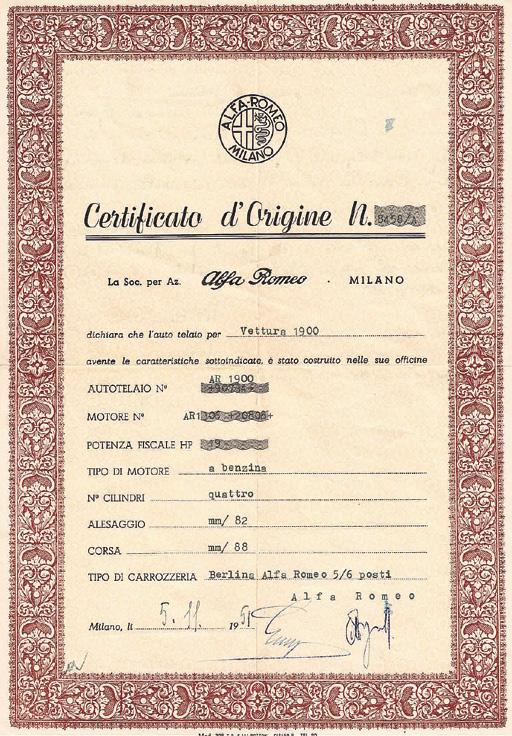
57
1962 Chevrolet Corvette C1 Fuel Injection

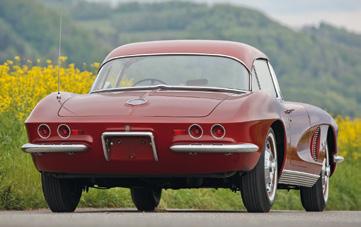
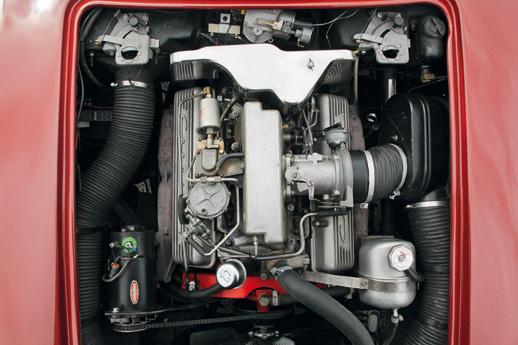
Chassis # 20867S110032

The history of the Corvette dates back to 1953, as one of Harley Earl‘s projects at General Motors, eventually becoming an American icon in sports car history. When General Motors offered a V-8 for the Corvette in 1955, performance greatly improved and it became a fierce competitor on the track. Fuel-injection for 1957 moved performance to a whole new level. 1962 was the final year of the solid-axle Corvette and the company‘s ‚Golden‘ 50th Anniversary. Chevrolet celebrated by offering a special paint scheme on the 1962 Impala in Anniversary Gold with Yellow-Gold interior. They had actually experimented with the Gold-on-Tan color combination on a Corvette before offering it on the 50th Anniversary Impala as an option. General Motors management felt the color scheme was better suited for the full-size line that would result in more sales, and subsequently, an estimated 350 Impala 50th Anniversary cars were produced for 1962.
Nonetheless, the 1962 Corvette was offered with a plethora of high-performance options, described in factory literature as ‚special equipment for sports car meets.‘ Among the choices was the fuel-injected 327 cubic-inch V8 engine offering 360 horsepower and finding its way into 1‘918 Corvettes. Of those, 246 were equipped with heavy-duty chassis equipment (RPO 687), which included fast-ratio steering, heavy-duty shock absorbers, and large sintered-metallic drum brakes with cooling fins, vented backing plates, and air scoops. Of those, just 65 were given the extra-large 24-gallon fuel tank (RPO 488) earning them the nickname, ‚tanker‘ Corvettes.
By 1962, the Corvette had scored international class victories at Le Mans and Sebring and was on its way to its sixth-consecutive SCCA B Production National Championship. The list of legendary drivers included Dr. Dick Thompson, Jim Jeffords, Bob Johnson, and Don Yenko. The original 265 cubicinch displacement of 1955 had grown to 327 cubicinches in 1962, and the options list included the ‚Duntov cam,‘ Rochester fuel injection, suspension packages, and competition brakes. New Chevrolet president Semon ‚Bunkie‘ Knudsen, previously at the helm of the Pontiac Division, hired a new marketing team to help increase sales from 10‘939 in 1961 to over 14‘000 for 1962, a monumental task for an outgoing model. For this reason, Knudsen decided that only minimal changes were to be applied to the 1962 Corvette.
In 1961, the new ‚ducktail‘ rear treatment foretold Corvette‘s dramatic 1963 Sting Ray. Styling Chief Bill Mitchell continued cleaning up the car‘s exterior, most noticeably removing the side cove trim and two-tone paint, a blacked-out grille, and adding ribbed rocker trim

would continue on the new

58 www.TheSwissAuctioneers.swiss
Lot 128 1‘918 cars (1962, fuel inj.) V8 5‘358 cc 365 hp at 6‘000/min Estimate CHF 90‘000 - 110‘000 Story conceptcarz.com
that
Photos Oldtimer Galerie
1963 models. Standard features included an electric clock, dual exhaust, heater and defroster, seat belts, windshield washer, tachometer, and outside rearview mirror.
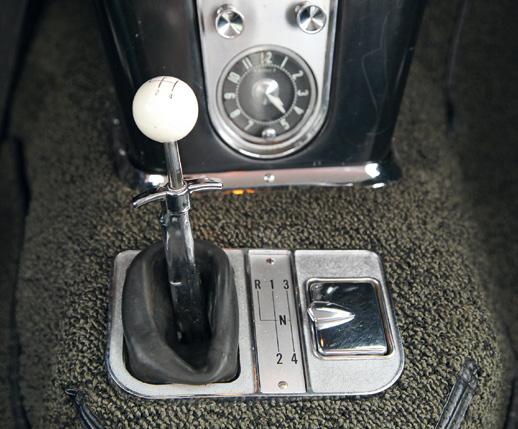
The base engine was the 327 CID with 250 horsepower and 350 lbs-ft of torque. A threespeed manual all-synchromesh transmission with floor-mounted gear shifter was standard, and a two-speed Powerglide automatic was optional. A four-speed manual all-synchro was also available. Four-wheel hydraulic, internal-expanding, 11-inch diameter drums provided the stopping power.

1962 was the first year that the Corvette‘s base price exceeded the $4,000 mark. Total production reached 14‘531, by far the highest number of Corvettes produced to date. 10‘939 had been sold in 1961 and 10‘261 in 1960.
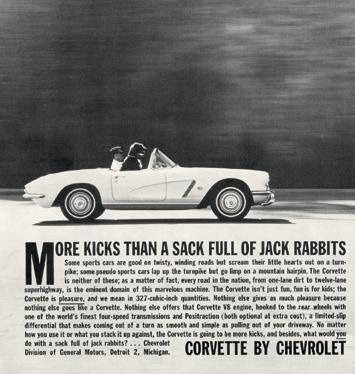

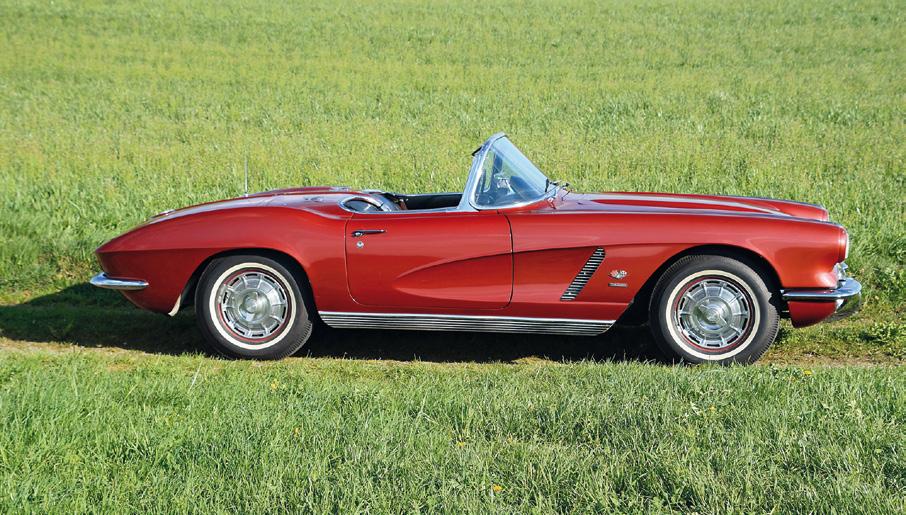
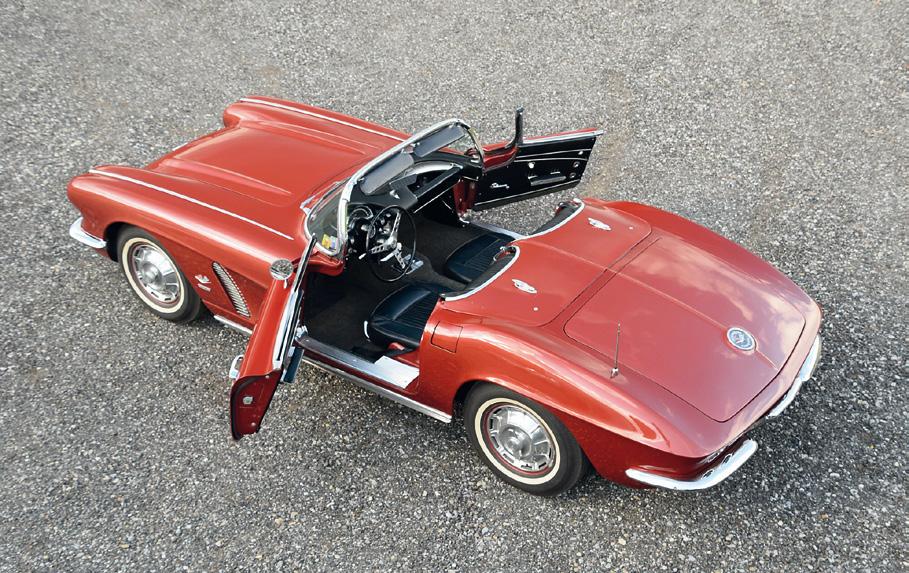
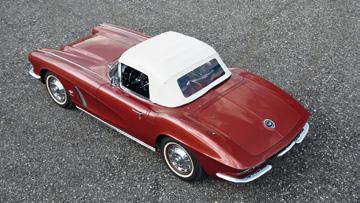

Seuls 1‘918 exemplaires de la Corvette C1 à injection ont été construits et, avec 365 cv et une boîte manuelle à quatre vitesses, c‘est une Corvette aussi excitante que vous pourriez trouver. Livrée aux EtatsUnis, la „Vette“ a été importée en Hollande au début du nouveau millénaire et en 2012, elle a été amenée en Suisse via la France. La voiture a été restaurée il y a quelques années mais porte toujours son moteur d‘origine aux numéros correspondants. La „Fuelie“ possède le très rare hardtop d‘origine avec une capote cachée derrière les sièges. La Corvette est en très bon état et est prête à offrir des sensations fortes pendant de nombreuses années encore à un nouveau propriétaire. La dernière expertise vétéran a été effectuée en décembre 2022.
Only 1’918 examples off the fuel injected Corvette C1 were ever built and with 365hp and a four-speed manual gearbox, this is as exciting a Corvette as you could possibly find. Delivered in the USA the “Vette” was imported into Holland in the new Millennium and in 2012 was brought to Switzerland via France. The car was restored a number of years ago but still carries its matching numbers original engine. The “Fuelie” boasts the very rare original hardtop with a soft top hidden behind the seats. The red Corvette is in very good condition and is ready to provide neck-snapping excitement for many more years for a new owner. The last Veteran MOT was successfully completed in December 2022.
Die angebotene Corvette ist eines von nur 1’918 gebauten Fahrzeugen mit 365 PS Eispritzmotor und 4-Gang Handschaltung. Ausgeliefert in den USA, wurde die Vette in den Zweitausendern nach Holland importiert und schliesslich Ende 2012 via Frankreich in die Schweiz gebracht. Der Wagen wurde vor einigen Jahren restauriert - nach 60 Jahren ist aber immer noch der «Matching-Numbers» Originalmotor eingebaut. Die sogenannte «Fuelie» verfügt über ein seltenes Original-Hardtop und ein hinter den Sitzen verstautes Faltverdeck. Die seltene Corvette befindet sich in sehr gutem Zustand und wird einem Liebhaber sicher noch viele Jahre Freude bereiten. Die letzte MFK als Veteranenfahrzeug erfolgte im Dezember 2022.
59
1996 Lamborghini Diablo VT
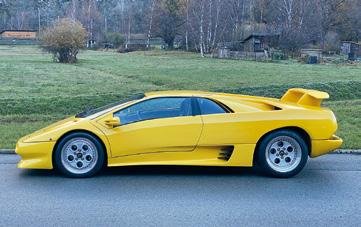

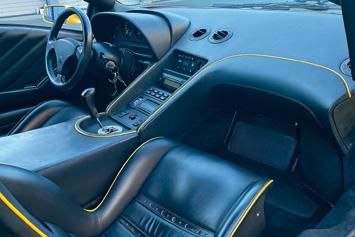
Chassis # ZA9DE07A0RLA12251
The Lamborghini Diablo is a high-performance midengine sports car built by Italian automotive manufacturer Lamborghini between 1990 and 2001. It is the first production Lamborghini capable of attaining a top speed in excess of 320 kilometres per hour (200 mph). After the end of its production run in 2001, the Diablo was replaced by the Lamborghini Murciélago. The name Diablo means „devil“ in Spanish.
smoothing out the infamous sharp edges and corners of Gandini‘s original design, and leaving him famously unimpressed. In fact, Gandini was so disappointed with the „softened“ shape that he would later realise his original design in the Cizeta-Moroder V16T.
The new car was named Diablo, carrying on Lamborghini‘s tradition of naming its cars after breeds of fighting bulls. The Diablo was named after a ferocious bull raised by the Duke of Veragua in the 19th century, famous for fighting an epic battle with ‚El Chicorro‘ in Madrid on 11 July 1869.
The development is believed to have cost a total of 6 billion Italian lira.
At a time when the company was financed by the Swiss-based brothers Jean Claude and Patrick Mimran, Lamborghini began development of what was codenamed Project 132 in June 1985 as a replacement for the Countach, Lamborghini‘s then flagship sports car. The brief stated that the top speed of the new car had to be at least 315 km/h (196 mph).
The design of the car was contracted to Marcello Gandini, who had designed its two predecessors. When Chrysler Corporation bought the company in 1987, funding the company to complete the car‘s development, its management was uncomfortable with Gandini‘s designs and commissioned its design team in Detroit to execute a third extensive redesign,
The Diablo was presented to the public for sale on 21 January 1990. Its power came from a 5.7 L (348 cui) dual overhead cam, 4 valves per cylinder version of the existing V12 engine and computer-controlled multi-point fuel injection, producing a maximum output of 492 and 580 Nm (428 lbf/ft) of torque. The vehicle could reach 0-100 km/h (62 mph) in about 4.5 seconds, with a top speed of 325 km/h (202 mph).

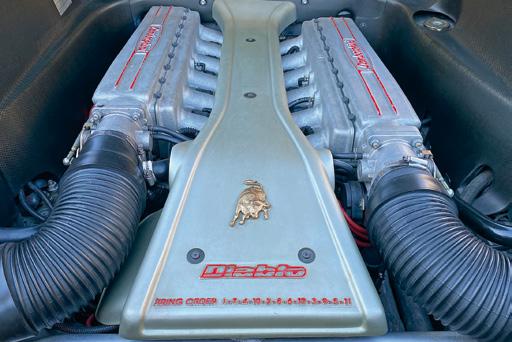
The Diablo was rear-wheel drive and the engine was mid-mounted to aid its weight balance.

60 www.TheSwissAuctioneers.swiss
Lot 129 approx. 400 cars V12 5‘704 cc 492 hp at 7‘000/min Estimate CHF 200‘000 - 225‘000 Story wikipedia.org Photos by consignor
The Diablo came better equipped than the Countach; standard features included fully adjustable seats and steering wheel, electric windows, an Alpine stereo system, and power steering from 1993 onwards. Anti-lock brakes were not initially available, although they would eventually be used. A few options were available, including a custom-molded driver‘s seat, remote CD changer and subwoofer, rear spoiler, factory fitted luggage set (priced at $2‘600) and an exclusive Breguet clock for the dash (priced at $10‘500).
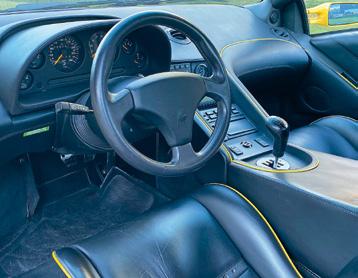
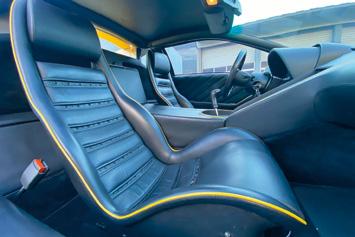
The Diablo VT was introduced in 1993. Although the VT differed from the standard Diablo in a number of ways, by far the most notable change was the addition of all wheel drive, which made use of a viscous center differential (a modified version of LM002‘s 4WD system). This provided the new nomenclature for the car (VT stands for viscous traction). The new drivetrain could direct up to 25% of the torque to the front wheels to aid traction during rear wheel slip, thus significantly improving the handling characteristics of the car. Other improvements debuting on the VT included front air intakes below the driving lamps to improve brake cooling, larger intakes in the rear arches, a more ergonomic interior with revised electronically adjustable dampers, four-piston brake calipers, power steering and minor engine refinements. Many of these improvements, save the four-wheel drive system, soon transferred to the base Diablo, making the cars visually nearly identical.

dass der Kampfstier bis heute vier stolze Besitzer hatte. Mit nun 59‘000 gefahrenen Kilometern befindet sich der Lamborghini in sehr gutem Zustand und wird frisch ab MFK an einen neuen Besitzer übergeben.
Cette Diablo VT avec sa transmission intégrale et son V12 de 5,7 litres développant 492 cv est un exemplaire livré en Suisse et a été enregistré pour la première fois le 12 septembre 1996. La supersportive dans sa combinaison attrayante de jaune Superfly avec un intérieur noir/jaune et l‘aileron arrière proéminent a toujours été soigneusement entretenue comme le prouve le carnet d‘entretien. Le certificat de contrôle des émissions indiquerait quatre propriétaires précédents de la voiture avec le kilométrage total indiqué pour être correct. Avec maintenant 59‘000 kilomètres parcourus, cette sensationnelle Lamborghini „old-school“ est en très bon état et sera remise à un nouveau propriétaire avec l’expertise fraichement passée.


This Diablo VT with its all-wheel drive and it‘s 5.7 litre V12 delivering a healthy 492 hp is a Swiss delivered example and was first registered on the 12th of September 1996. The supersportscar in its attractive combination of Superfly yellow with a black/yellow interior and the prominent rear wing has always been carefully maintained as documented with the service booklet. The emission controls certificate would indicate four previous owners of the car with the total mileage shown to be correct. With now 59’000 kilometres driven, this sensational “old-school” Lamborghini is in very good condition and will be handed over to a new owner with a fresh MOT.
Dieser Diablo VT mit Allradantrieb und 492 PS leistendem 5.7-Liter V12 stammt aus Schweizer Auslieferung und wurde am 12. September 1996 erstmals zugelassen. Der Supersportler in der Farbkombination «Superfly Yellow» mit schwarz-gelber Innenausstattung und dem beliebten Heckflügel wurde stets gut gewartet, wie das vorhandene Serviceheft zeigt. Das Abgaswartungsdokument macht die Laufleistung nachvollziehbar und lässt vermuten,



61
2001 Bentley Continental R Le Mans
 Chassis # SCBZB25E01CX63561
Chassis # SCBZB25E01CX63561
At the 1984 Geneva Motor Show „Project 90“ had been exhibited by Rolls-Royce and this was a really impressive full size mock-up of a future Bentley Coupé. Thus the manufacturer had gone to previously unheard of expenses in market research. Reactions had been so enthusiastic that within five years the company had developed a completely new Coupé and this was unveiled to the public as the Bentley Continental R at the Geneva Motor Show in March, 1991. Based on the Bentley Turbo R floorpan an aerodynamically shaped 2 + 2 coupé body had been styled. There is a taboo in the aeronautical industry against introducing new aircraft with new engines, and this was followed by Rolls-Royce in the case of the new Continental R. The well-proven turbocharged engine from the Bentley Turbo R had been chosen to power what one reporter termed as a sort of „Crewe‘s Missile“. The Bentley Continental S was built as a variant in a limited series only. That model sported an engine with turbocharger and intercooler, and then the intercooler became standard on the Bentley Continental R.
The designation Continental R could be traced back to the Bentley Continental of the post-war period, whose legendary fame had resulted from the combination of a most impressive powertrain and highly attractive coachwork design and features of which had been specified by customers. Such an opportunity – though altered to present time demands – was offered again, when in March 1999 the ‚Mulliner‘ Continental model range was introduced at the Geneva Motor Show. A Bentley driver could specify his personal motor car in direct contact with engineers and designers at the Crewe factory. The Bentley Continental R Mulliner was equipped with the most powerful engine as hitherto only found on the Bentley Continental T. A power
output of 420bhp and a maximum torque of 875Nm was more than any other manufacturer in the world did offer. The car could be pushed up to a top speed of some 170mph.
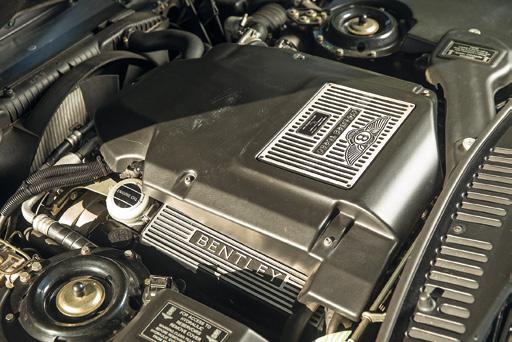
Bentley launched two limited Le Mans editions to celebrate the occasion of Bentley‘s return after 71 years to racing at Le Mans. Production was planned of 50 Le Mans editions of the Continental R Mulliner and 150 of the Bentley Arnage Red label. Actually 46 examples were manufactured of the Continental R Le Mans and 154 of the Arnage Le Mans. Besides those planned models also 5 Le Mans editions were manufactured of the Continental T Le Mans and 4 of the Bentley Azure Le Mans.
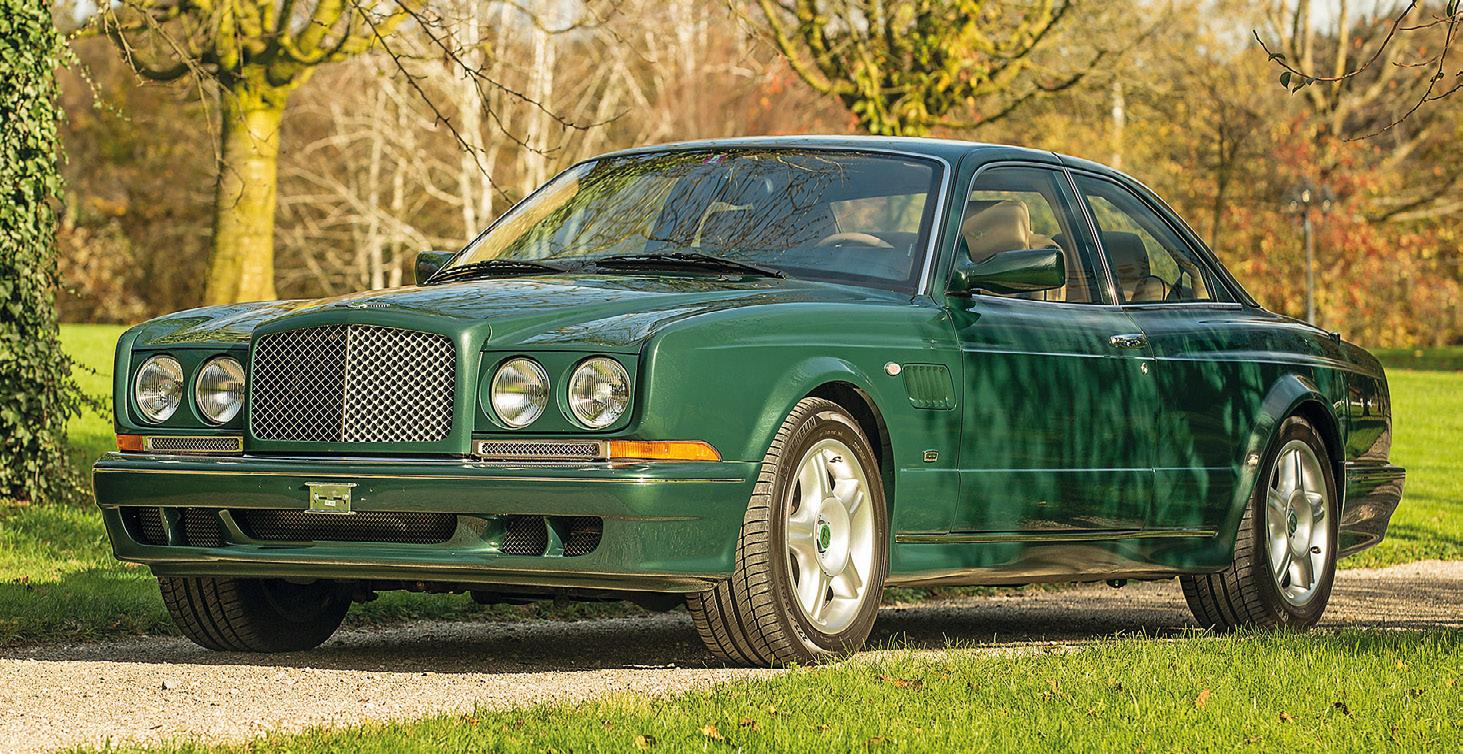
The Le Mans editions didn‘t replace any other model but were special editions of existing models. The Continental R Le Mans was a specially enhanced edition of the Continental R Mulliner edition.
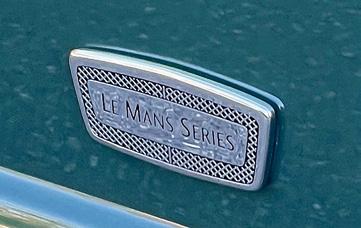

62 www.TheSwissAuctioneers.swiss
Lot 130 34 cars (LHD) turbocharged V8 6‘761 cc 420 hp at 4‘000/min Estimate CHF 175‘000 - 195‘000 Story rrab.com Photos Daniel
Reinhard
Any lucky person who, in 2001, had 500’000 Swiss Francs to spend liberally, bought either shares on the stock market, a (small) flat in Kensington or a Bentley Continental R Le Mans. This special edition model was built for roughly one year to celebrate the return of Bentley to the famous Le Mans endurance event at the Sarthe. 50 examples of the car were planned and 46 were eventually completed. The example we have on offer, one of 34 examples with left hand drive, was first registered in Germany on the 27th June 2001. After two owners, the Continental, then showing 22’850 kilometres, was integrated in February 2014 into the vendors collection and consequently imported into Switzerland. The imposing yet elegant Coupé presents itself in classic Le Mans racing green with a matching two-tone tan/dark green leather interior and, of course, all the luxury options available at the time. With a turbocharged 6.75 litre V8, 426hp coupled to an automatic gearbox, the Bentley is a very rapid long distance GT indeed and will show a clean pair of heels to many sports cars. This Le Mans has had three owners, has covered roughly 27’000 kilometres, boasts a complete service booklet and is in very good condition. The last MOT was completed in April 2022 permitting immediate registration and enjoyment to a new owner.
zeuge waren geplant, 46 wurden schliesslich gebaut. Das angebotene Exemplar, eines von 34 Fahrzeugen mit Linkslenkung, wurde am 27. Juni 2001 erstmals in Deutschland zugelassen. Nach zwei Vorbesitzern wurde der Continental im Februar 2014, mit damals 22‘850 Kilometern auf der Uhr, für die Sammlung des Einlieferers erworben und anschliessend in die Schweiz importiert. Das imposante Coupé präsentiert sich in «Le Mans Racing Green» und passender hellbraun/ dunkelgrüner Lederausstattung und sämtlichen damals gängigen Luxusfeatures. Mit turbogeladenem 6.75-Liter V8, 426 PS und automatischem Getriebe ist der Bentley zudem ein äusserst schnelles Reisefahrzeug. Dieser Le Mans stammt aus dritter Hand, hat erst knapp 27‘000 Kilometer gefahren, besitzt ein lückenloses Serviceheft und befindet sich in sehr gutem Zustand. Die letzte MFK erfolgte im April 2022, womit dieses Sammlerstück sofort zugelassen und genossen werden kann.
Toute personne chanceuse qui, en 2001, disposait de 500’000 francs suisses à dépenser sans compter, a acheté soit des actions en bourse, soit un (petit) appartement à Kensington, soit une Bentley Continental R Le Mans. Ce modèle en édition spéciale a été construit pendant environ un an pour célébrer le retour de Bentley à la célèbre épreuve d‘endurance du Mans, dans la Sarthe. 50 exemplaires de la voiture étaient prévus et 46 ont finalement été réalisés. L‘exemplaire que nous proposons, l‘un des 34 exemplaires avec conduite à gauche, a été enregistré pour la première fois en Allemagne le 27 juin 2001. Après deux propriétaires, la Continental, qui affichait alors 22‘850 kilomètres, a été intégrée en février 2014 à la collection du vendeur et par conséquent importée en Suisse. L‘imposant mais élégant Coupé se présente en vert course du Mans classique avec un intérieur en cuir bicolore havane/vert foncé assorti et, bien sûr, toutes les options de luxe disponibles à l‘époque. Avec un V8 6.75 litres turbocompressé de 426 cv couplé à une boîte de vitesses automatique, la Bentley est une GT très rapide sur les longues distances et fera pâlir de jalousie de nombreuses voitures de sport. Cette Le Mans a eu trois propriétaires, a parcouru environ 27‘000 kilomètres, possède un carnet d‘entretien complet et est en très bon état. La dernière expertise a été effectuée en avril 2022, ce qui permet à un nouveau propriétaire de l‘immatriculer immédiatement et d‘en profiter.


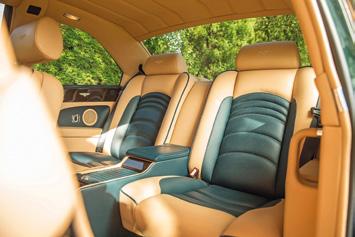
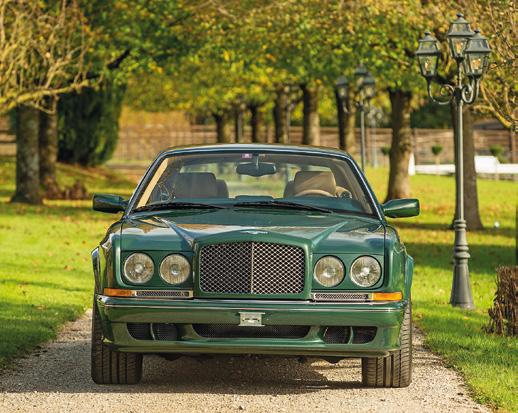

Wer 2001 CHF 500‘000 ausgeben konnte, kaufte entweder Aktien, eine Wohnung oder einen Bentley Continental R Le Mans. Dieses Sondermodell wurde anlässlich der Rückkehr der Marke auf die Rennstrecke an der Sarthe nur knapp ein Jahr produziert – 50 Fahr-

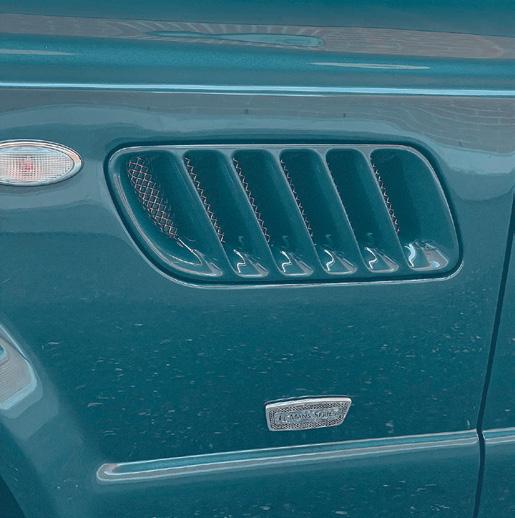

63
1966 Chevrolet Corvette C2 427 Sting Ray Convertible


Chassis # 194676S122776
Making its debut at the 1953 GM Motorama Show as a concept car, no one imagined the little Corvette, named after a class of Navy battleships, would enter production or be successful. The Corvette, however, caused such a stir that GM decided to put it into production. Introduced as an American sports car, the first Corvette rolled off the assembly line with only minor changes from its show car design. Given that it was the first mass-produced car with a fiberglass body, getting production up and running was no small task. There were 300 units sold in its inaugural year, and despite its ups and downs over the years, it has survived and is now recognized around the world as the standard of excellence in the world of performance cars.
The second generation of the Corvette, known as the Stingray (C2), was produced from 1963 to 1967. The design was courtesy of Larry Shinoda under the guidance of the legendary Bill Mitchell. Design inspiration is said to include the Jaguar E-Type, a Mako shark, the ‚Q Corvette‘ concept car of 1957 and the ‚Mitchell Sting Ray‘. By the autumn of 1959 elements of the two unique Corvettes had been built into XP-720, the design program that led to the production of the Sting Ray.
Compared to the original C1 Corvette generation, the C2 Corvette received a much stiffer chassis with independent rear suspension that offered vast handling improvements over its solid axle predecessor. The engineering of this platform validated itself by the fact that it continued, almost untouched, until the 1983 Corvette model year.
The Corvette of the 1960s had adroit handling, was easy to drive fast, and manageable for everyday use.


The list of available V8s grew even larger and the options list grew even hotter, with the Corvette taking on an element of a muscle car.
To test, perfect, and showcase the new Corvette, many enterprising road racers like Dick Guldstrand, Bob Bondurant, Allen Grant, and Davy MacDonald had them on the track before they even appeared in the show rooms of the nation. Doug Hooper, in the new Corvette‘s maiden voyage, won at the Riverside Times Grand Prix. One of the more colorful drivers was Dave MacDonald, whose spectacular sideways driving style in his X06 Corvette compensated for the car‘s racing inadequate drum brakes – not upgraded by GM until the 1965 model year. By the mid-‘60‘s Corvettes, powered by the immortal 327 Chevrolet V8, were regular national winners in the Sports Car Club of America‘s B Production Class.
The 1966 Corvette was powered by an overhead valve V8 engine displacing 327 cubic-inches and offering 300 horsepower and 360 ft-lbs of torque. An optional 327 with an 11.00:1 compression ratio, high-lift camshaft, and a Holley four-barrel carburetor added
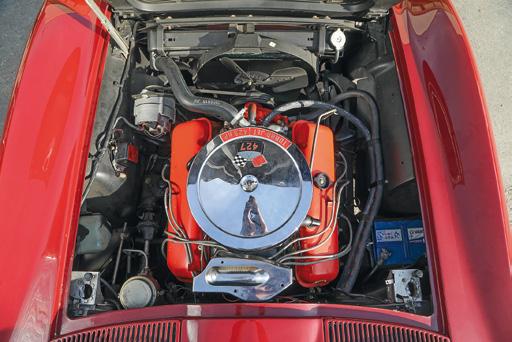
64 www.TheSwissAuctioneers.swiss
Lot 131 5‘258 cars (all 425 hp engine) V8 6‘974 cc 425 hp at 5‘600/min Estimate CHF 110‘000 - 120‘000 Story conceptcarz.com Photos zwischengas.com / OG
an additional 50 horsepower. A 427 CID V8 was also available, with 390 - 425 horsepower depending on the configuration. A three-speed manual all-synchromesh transmission was standard. An automatic or fourspeed manual was optional.
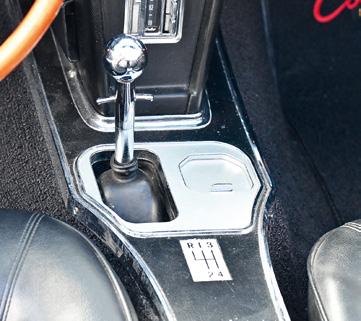

Changes to the 1966 Corvette were minimal over the prior year. In the front, the grille was slightly updated with a plated, cast-metal grille. There were chromeplated exhaust bezels, spoke-style wheel covers, ribbed rocker panel moldings, and the removal of roof vents. Corvettes fitted with the 427 CID engine had a power-bulge hood.
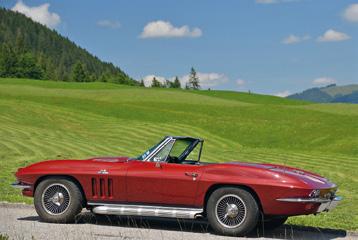
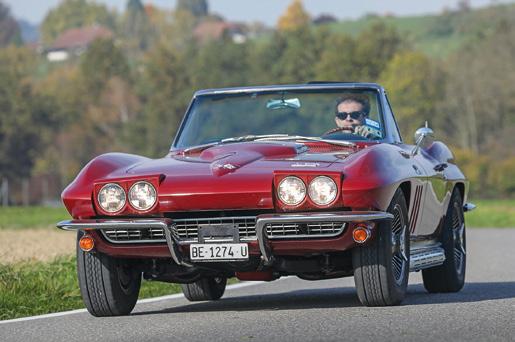
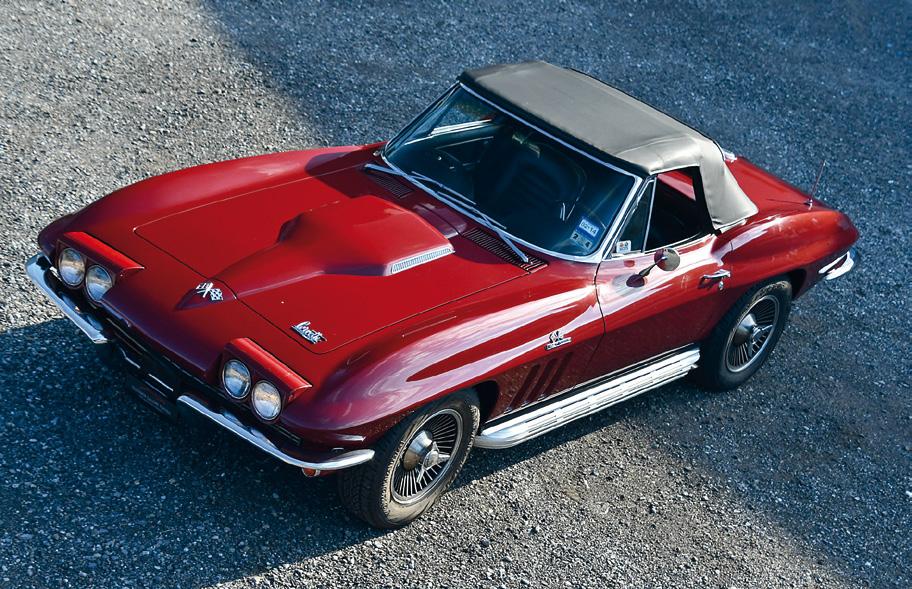
Bodystyles included the fastback coupe and the convertible. A total of 9‘958 examples of the fastback coupe were built and had a base price of nearly $4‘300. The convertibles, selling for just over $4‘000, saw production reach 17‘762 examples.

presents itself in its original colour combo “Milano Maroon” with a black vinyl interior. The rare and very powerful convertible is in very good condition and will be handed over to its next owner with a FIVA ID at the most recent Veteran MOT dating from August 2020.
Diese tolle Sting Ray wurde am 26. Mai 1966 gebaut und an Dearing Chevrolet in Savannah/Georgia ausgeliefert. Bestellt mit 427 cui/425 hp V8, 4-Gang Getriebe, Positrac-Hinterachse, Seitenauspuffanlage und Zentralverschlussrädern, dürfte die Corvette ihrem ersten Besitzer viel Freude bereitet haben. Ausser der Kopie der Auslieferungsrechnung ist über die frühen Jahre des potenten Cabrios Nichts bekannt. Ab 1993 sind drei amerikanische Besitzer belegt, bevor die Vette 2013 vom ersten und einzigen Schweizer Besitzer importiert wurde. Die C2 verfügt immer noch über Ihren Matching-Numbers Originalmotor und präsentiert sich in der originalen Farbkombination «Milano Maroon» mit schwarzer Kunstlederausstattung. Das seltene PowerCabrio befindet sich in sehr gutem Zustand und wird mit FIVA-ID und der letzten MFK als Veteranenfahrzeug im August 2020 an einen nächsten Liebhaber übergeben.
Cette fantastique Stingray a été produite le 26 mai 1966 et livrée à Dearing Chevrolet à Savannah/ Georgia. Spécifiée avec le très désirable V8 427 cui, délivrant 425cv et une montagne de couple, une boîte de vitesse manuelle à 4 rapports, un différentiel «Positraction», un système d‘échappement latéral et des jantes à verrouillage central, la Corvette a certainement dû faire la fierté et la joie de son premier propriétaire. À l‘exception de la copie de la facture de livraison, on ne sait rien des premières années de la vie de ce puissant roadster. Depuis 1993, la voiture a eu trois propriétaires américains documentés avant d‘être importée en Suisse par son seul et unique propriétaire suisse en 2013. La C2 possède toujours son moteur d‘origine aux numéros correspondants et se présente dans sa combinaison de couleurs d‘origine „Milano Maroon“ avec un intérieur en vinyle noir. Le rare cabriolet est en très bon état et sera remis à son prochain propriétaire avec une ID FIVA et la dernière expertise vétéran datant d‘août 2020.

This fantastic Stingray was completed on 26th May 1966 and delivered to Dearing Chevrolet in Savannah GA. Specified with the highly desirable 427 cui V8, delivering 425hp and a mountain of torque, a 4-speed manual gearbox, Positraction diff, side exhaust system and knock-off wheels, the Corvette certainly must have been the pride and joy of its first owner. With the exception of the initial invoice, nothing is known about the early years in the life of this potent roadster. From 1993 the car has had three documented American owners before it was imported into Switzerland by its one and only Swiss owner in 2013. The C2 still boasts its matching numbers original engine and
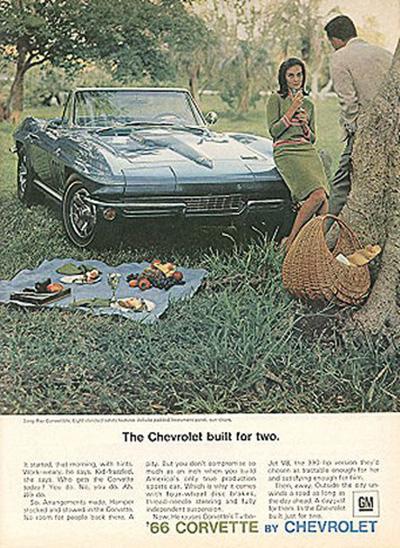
65
1963 Volvo P1800 Aston Martin DP208
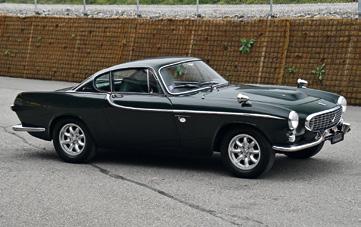
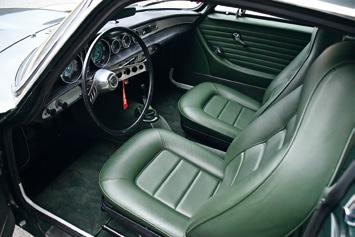


Chassis # 1716

With the introduction of the Volvo P1800 in January 1960 in Brussels, the story of this unique car begins. The shape of the Volvo P1800 is the work (from 1957) of Pelle Petterson then working for Pietro Frua in Italy. The first series, starting with the model year 1961, was assembled in the UK by Jensen motors in West Bromwich. The bodies were delivered by train from the Pressed Steel company works in Lynnwood. The cars were powered by the proven Volvo B18 1.8 litre carburetted engine with 90hp. It was identical with the engine from the Volvo 122 S saloon which, according to Aston Martin chief Sir David Brown, was somewhat inadequate to power a proper sports car and he decided to commence a rather bold experiment. In March 1961 he commissioned his engineers to develop a 2.5 litre 4-cylinder engine with the potential to be sold in large numbers to various companies. The internal code for the project was DP208 and the project responsible was none other than legendary John Wyre (Astons racing manager responsible for Aston Martin’s 1959 Le Mans victory). He had a budget of 3’000 pounds available (the about 36’000 Swiss francs). The engineering team around (equally famous) Tadek Marek jumped at the task and shortened a existing DB4 engine by cutting off two cylinders. The crankcase, crankshaft and camshaft had to be designed and built from scratch while the liners, pistons and valves could be taken straight from the six cylinder DB4 engine. After the first three engines had been completed, Sir David Brown made an agreement with the then UK Volvo importer Charles Singer to test one of the units in a Volvo P1800 and he commissioned John Wyer with the task. Over the following 12 months the car was tested extensively, among others by Marek’s wife and a successful corporation with Volvo should then have materialised. In the meantime, Volvo unfortunately had decided to terminate its corporation with Jensen due to major quality problems with the coachwork construction and painting process and
had transferred the complete construction of the P1800 to the Volvo main site at Lundby near Göteborg in Sweden. Perhaps the - rather complex - engine proved to be too costly for Volvo; after all the P 1800 was advertised at below $4’000 in the USA, and the targeted weight saving could also not be realised. As a result, project DP208 was cancelled probably in 1964, with the test mule scrapped and the remaining engines used for other projects. Since 1974 these engines had been considered lost until, in 2003, engine #3 was found and acquired by Swiss Aston Martin specialist Beat Roos. He had the engine completely overhauled and of course it didn’t take long to decide to use that engine for its original purpose. For that, an early Volvo P 1800 originally completed at Jensen‘s was found. Over the following two years, due to lack of any plans or drawings, a large number of parts had to be designed, built and adapted by specialists from Roos Engineering. The coachwork was restored and repainted in British racing green combined with a new green leather interior. Small concessions to comfort and safety were made in the shape of later P1800 seats with integrated head rests as well as the installation of servo brakes. In 2005, after investing more than 200’000 Swiss francs, the project was finally completed and the beautiful result presented to an astonished public. The Volvo P1800/Aston Martin was then portrayed in various magazines and shown by the Volvo factory on several occasions. With its 2.5 litre delivering 151 hp the Aston- Volvo is considerably quicker than a normal P1800 and the Volvo 4-speed gearbox with its overdrive is shifting with the customary mechanical feel and harmonises perfectly with the engine. The car is driving surprisingly “normal” and thanks to the use of regular Volvo and Aston Martin bits can be maintained with reasonable effort. The Coupé will now be sold with an extensive documentation, a FIVA ID as well as the latest Veteran MOT completed in July 2021. In addition, a fresh,
66 www.TheSwissAuctioneers.swiss
Lot 132 one of a kind in-line 4 cylinder 2‘499 cc 151 hp at 5‘500/min Estimate CHF 175‘000 - 225‘000
Photos Oldtimer Galerie
Veuillez trouver le descriptif en français sur www.TheSwissAuctioneers.swiss
still unmachined replacement crankshaft will be handed over to the new owner. Since the two other engines were most probably scrapped many years ago, there remains only one DP208 P1800 making it one of the rarest items in Aston Martin history. This sole example represents a unique and all but forgotten cooperation between two manufacturers who couldn‘t have been more different and it will make a fantastic addition and talking point to any Volvo or Aston Martin collection.
Zwischenzeitlich hatte Volvo wegen Qualitätsproblemen bei Montage und Lackierung jedoch beschlossen die Zusammenarbeit mit Jensen zu beenden und die Produktion wurde nach Schweden in das Volvo-Stammwerk Lundby bei Göteborg verlegt. Auch war der aufwändige Motor für Volvo wohl zu teuer – der P1800 wurde in den USA mit einem Verkaufspreis von unter 4‘000 Dollar beworben – und brachte angeblich keinen Gewichtvorteil gegenüber dem firmeneigenen Guss-Aggregat.
Mit der Vorstellung des Volvo P1800 im Januar 1960 in Brüssel begann die Geschichte dieses einmaligen Fahrzeuges. Die Form des Volvo P1800 entwarf 1957 Pelle Petterson, damals Mitarbeiter bei Pietro Frua in Italien. Die erste Serie ab Modelljahr 1961 wurde in Großbritannien bei Jensen Motors in West Bromwich montiert. Die Karosserien wurden vom Werk Linwood der Pressed Steel Company mit der Bahn angeliefert. Angetrieben wurde diese Version durch den bewährten B18 1,8-Liter-Vergasermotor mit 90 PS aus dem Volvo Regal.


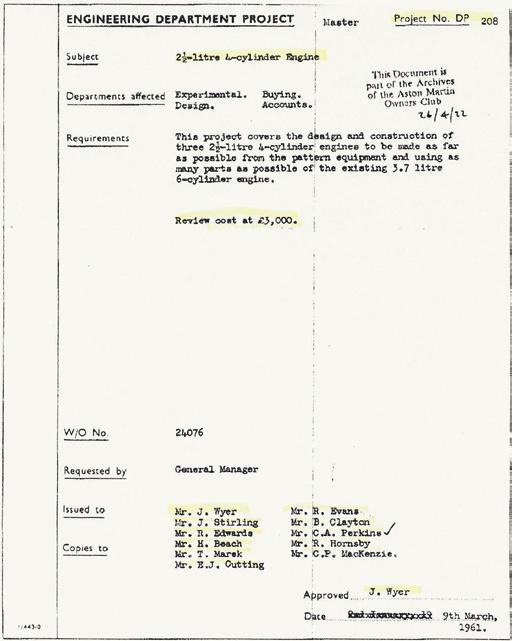
Und genau beim Motor sah der Aston Martin Chef Sir David Brown das Problem (und die Chance für Aston Martin) des hübschen Coupés – das eher gemächliche Aggregat aus der 122 S Limousine passte in seinen Augen nicht in einen Sportwagen.
Im März 1961 erteilte er den Auftrag einen 2.5-Liter 4-Zylinder Motor zu entwickeln, welcher in grösseren Stückzahlen an verschiedene Hersteller verkauft werden sollte. Der Code für dieses Projekt war DP208, der Projektleiter war J. Weyer und das Budget lag bei 3‘000 Pfund (was damals rund CHF 36‘000 entsprach). Die Ingenieure um Tadek Marek machten sich an die Arbeit und kürzten den DB4-Motor um zwei Zylinder. Motorgehäuse, Kurbel- und Nockenwellen wurden extra angefertigt – Zylinder, Kolben und Ventile wurden 1:1 aus dem Sechszylinder übernommen.Nach Fertigstellung von 3 Motoren vereinbarte Sir David Brown mit dem damaligen englischen Volvo Importeur Charles Singer eines der Aggregate in einem Volvo P1800 zu testen. Am 29. Juli 1963 erteilte J. Weyer den Auftrag dieses Vorhaben auszuführen. In den folgenden 12 Monaten wurde der Wagen unter Anderem von Mareks Ehefrau ausgiebig getestet und einer erfolgreichen Zusammenarbeit wäre eigentlich nichts im Wege gestanden.

So wurde Projekt DP208 wahrscheinlich 1964 eingestellt – der Testwagen wurde entsorgt und die Motoren für andere Projekte verwendet. Seit 1974 galten die Motoren als verschollen, bis 2003 Aggregat Nummer 3 vom Schweizer Aston Martin Spezialisten Beat Roos gefunden und erworben wurde. In der Folge wurde die Maschine komplett revidiert und schnell war der Beschluss gefasst, diese ihrem angedachten Verwendungszweck zuzuführen. Selbstverständlich wurde hierzu ein bei Jensen gebautes Fahrzeug als Basis genommen. Mangels Pläne und Zeichnungen mussten in den folgenden zwei Jahren viele Teile in aufwändiger Kleinarbeit durch die Spezialisten von Roos Engineering angefertigt und angepasst werden. Die Karosserie wurde restauriert und erhielt eine Lackierung in «British Racing Green», die Innenausstattung wurde mit grünem Leder komplett neu angefertigt. Kleine Zugeständnisse an Komfort und Sicherheit wurden in Form der späten P1800 Sitze mit hoher Rückenlehne sowie dem Einbau einer Servounterstützung für die Bremsanlage gemacht. 2005, und nach über CHF 200‘000 Investition, war das Projekt schliesslich fertiggestellt und das wunderschöne Ergebnis wurde der Öffentlichkeit präsentiert.Der Volvo P1800 Aston Martin wurde in der Folge in zahlreichen Magazinen porträtiert und unter Anderem vom Volvo Werk an verschiedenen Ausstellungen gezeigt. Mit seinem 151 PS leistenden 2.5-Liter Motor fährt sich der Aston-Volvo deutlich sportlicher als der normale P1800 und das Volvo Viergang-Getriebe mit Overdrive schaltet sich gewohnt knackig und passt gut zur Maschine. Der Wagen fährt sich erstaunlich «normal» und ist dank der Verwendung normaler Volvo- und Aston Martin Teile auch mit vernünftigem Aufwand zu warten. Das Coupé wird mit einer umfangreichen Dokumentation, einer FIVA-ID, sowie der letzten MFK als Veteranenfahrzeug im Juli 2021 an einen neuen Besitzer übergeben. Zudem wird eine neue, unbearbeitete, Ersatz-Kurbelwelle mitgeliefert.

Da die beiden anderen Motoren mit grösster Wahrscheinlichkeit verschrottet wurden, existiert weltweit nur noch dieser Motor DP208 im Volvo P1800 - eines der seltensten Stücke der Aston Martin Geschichte!
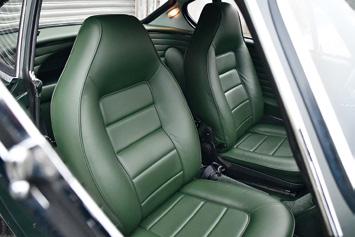


Dieses Unikat repräsentiert die einmalige und nahezu vergessene Zusammenarbeit zweier Automobilhersteller welche unterschiedlicher nicht hätten sein können und passt sowohl in eine Volvo- als auch in eine Aston Martin Sammlung.

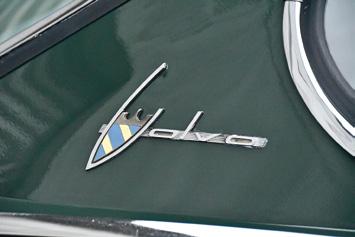
67
1961 Lancia Flaminia 2500 GT Touring
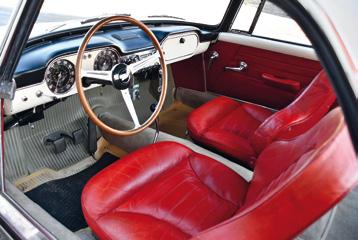

Chassis # 824.00-1653
The Lancia Flaminia was introduced in late 1956 as a 1957 model to replace the aging Lancia Aurelia line. While Lancia made the mechanical underpinnings and Pinin Farina drew the basic design, coachwork was farmed out to Italy’s finest design and bodywork houses, including Zagato, Touring, Pininfarina and Ghia. The Flaminia debuted with 2‘458 cc V-6 engine rated at 98 hp. An optional high compression version of this engine was available for sedans and was installed as standard equipment on coupes and roadsters. The optional engine was rated at 119 hp on coupes.
Dieses wunderschöne Lancia Coupé mit Touring Karosserie – eines von 863 gebauten Fahrzeugen mit 2.5-Liter Motor und 119 PS – wurde im Juli 1961, vermutlich in Italien, erstmals zugelassen. Vor vielen Jahren wurde die Flaminia in die Schweiz importiert und hier zugelassen. Vor rund 15 Jahren wurde die Karosserie restauriert und neu lackiert, die Innenausstattung wurde im Originalzustand belassen und weist eine altersgerechte Patina auf. 2011 wurde der Lancia vom Einlieferer übernommen und seither gerne gefahren und stets gut gewartet. 2020 – vor rund 1‘000 Kilometern – wurden unter anderem der KurbelwellenSimmerring und die hinteren Stossdämpfer ersetzt, die Aufhängung revidiert und die Ventile eingestellt. Das italienische Luxuscoupé befindet sich in gutem Zustand und wird es einem neuen Besitzer ermögliche auf den Spuren der italienischen Filmgrössen der 60er Jahre zu reisen. Die letzte MFK als Veteranenfahrzeug erfolgte im Juni 2019.
This fantastic Lancia Coupé with its Touring coachwork, one of 863 examples built, with a 2.5 litre engine V6 delivering 119 horsepower was registered in July 1961, most probably in Italy. Many years ago, the Flaminia was imported and registered in Switzerland. Around 15 years ago the coachwork was restored and repainted with the interior left in its original condition, showing a lovely age correct patina. In 2011 the Lancia was taken over by the vendor who gave it the necessary exercise whilst performing thorough maintenance on the car. In 2020, around 1’000 kilometres ago, the rear crankshaft seal was replaced, the valves adjusted, the suspension overhauled and the rear dampers replaced. The Italian luxury Coupé is in good condition and is ready to revive 60s Italian cinematic dolce vita for its next lucky owner. The most recent Veteran MOT dates from June 2019.
Ce fantastique Lancia Coupé avec sa carrosserie Touring, l‘un des 863 exemplaires construits, avec un moteur V6 de 2,5 litres développant 119 chevaux, a été enregistré pour le première fois en juillet 1961, très probablement en Italie. Il y a de nombreuses années, la Flaminia a été importée et immatriculée en Suisse. Il y a environ 15 ans, la carrosserie a été restaurée et repeinte avec l‘intérieur laissé dans son état d‘origine, montrant une belle patine d‘âge correcte. En 2011, la Lancia a été reprise par le vendeur qui lui a donné l‘exercice nécessaire tout en effectuant un entretien approfondi de la voiture. En 2020, il y a environ 1‘000 kilomètres, le joint arrière du vilebrequin a été remplacé, les soupapes ajustées, la suspension révisée et les amortisseurs arrière remplacés. Le Coupé de luxe italien est en bon état et est prêt à faire revivre les 60s dolce vita cinématographiques italiennes pour son prochain propriétaire. L’expertise vétéran la plus récente date de juin 2019.



68 www.TheSwissAuctioneers.swiss
Lot 133 863 cars V6 2‘458 cc 119 hp at 5‘100/min Estimate CHF 80‘000 - 90‘000 Story hagerty.com Photos Oldtimer Galerie
2007 Rolls-Royce Phantom Drophead Coupe
the coachwork, originally painted in “Metropolitan blue metallic”, received the current matt blue foil treatment. The interior was recently professionally cleaned and this Rolls-Royce, which by now has driven 52’500 kilometres, is in very good condition. It will be sold with the last MOT dating from December 2021.

With a list price north of 700’000 Swiss francs, the Rolls-Royce Phantom Drophead Coupé was definitely not a car for the average buyer. For this princely sum, the new owner did not just receive a simple drophead powered by a beautiful 6.75 litre V12 engine delivering 460 horsepower. In addition, the Phantom is equipped with every conceivable option imaginable such as an interior in the finest leather, electrically adjustable seats, air conditioning, a dashboard clad with the finest veneer with an integrated monitor for the navigation system which discreetly swivelled away at the touch of a button and, of course, an electrically operated soft top comprising 5 layers off sound deadening material. To complete this luxury defining package, the car is equipped with large rear hinged doors and the front screen frame and bonnet in brushed stainless steel as well as a rear deck covered in the finest teak. The example we have on offer was registered in Switzerland for the first time on 13th December 2007 and has been with its current owner since 2019. At the end of 2020, a major service to the tune of around CHF 40’000.- was performed and the car received new tyres. In 2021,
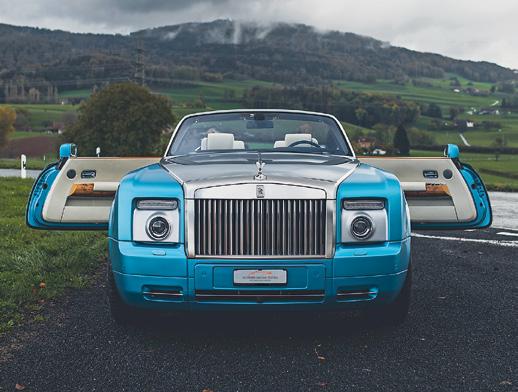
Mit einem Neupreis jenseits der 700‘000 Franken, war das Rolls-Royce Phantom Coupé definitiv nicht für jedermann erschwinglich. Für diese Summe erhielt der Käufer aber nicht nur ein simples Cabriolet mit 6.75-Liter V12-Motor und 460 PS, nein, der Phantom ist auch mit jedem erdenklichen Luxus ausgestattet - die edle Lederausstattung mit elektrisch verstellbaren Sitzen, die Klimaanlage, das Holzvertäfelte Armaturenbrett mit dem sich wegdrehenden Monitor für das Navigationssystem oder das 5-lagig ausgeführte elektrische Stoffverdeck gehören selbstverständlich zum Standard in dieser Klasse. Besonderheiten wie die hinten angeschlagenen «Selbstmördertüren», die Motorhaube und der Windschutzscheibenrahmen aus gebürstetem Edelstahl, oder die Teak-Beplankung der Verdeckabdeckung sind aber einmalige Erkennungszeichen der britischen Luxusmarke. Das angebotene Exemplar wurde am 13. Dezember 2007 erstmals in der Schweiz zugelassen und befindet sich seit 2019 im Besitz des Einlieferers. Ende 2020 wurde ein grosser Service im Umfang von rund CHF 40‘000.- durchgeführt und das Fahrzeug wurde neu bereift. 2021 erhielt die «Metropolitan blue metallic» lakkierte Karosserie eine Folierung im aktuellen blau matt. Zudem wurde kürzlich die Innenausstattung professionell aufgearbeitet, womit sich der Rolls mit seinen 52‘500 gefahrenen Kilometern in sehr gutem Zustand befindet und mit der letzten MFK im Dezember 2021 an einen neuen Liebhaber übergeben wird.
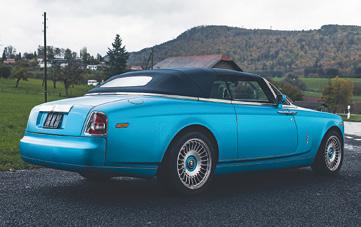

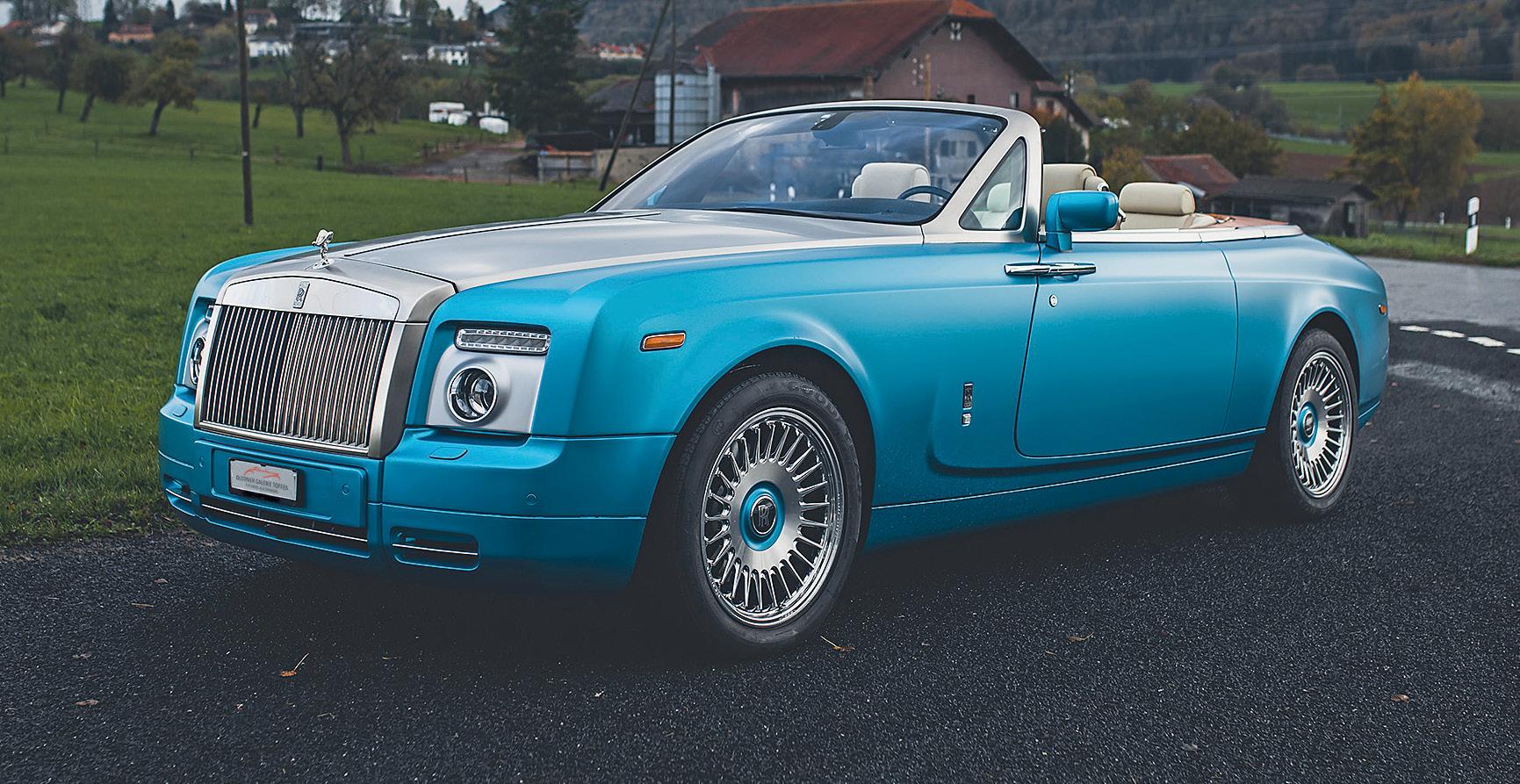

69
Chassis # SCA2D68038UX14091
Lot 134 253 cars (2007) V12 6‘749 cc 460 hp at 5‘350/min Estimate CHF 195‘000 - 225‘000
Photos Daniel Zizka
Veuillez trouver le descriptif en français sur www.TheSwissAuctioneers.swiss
1971 Maserati Ghibli 4700
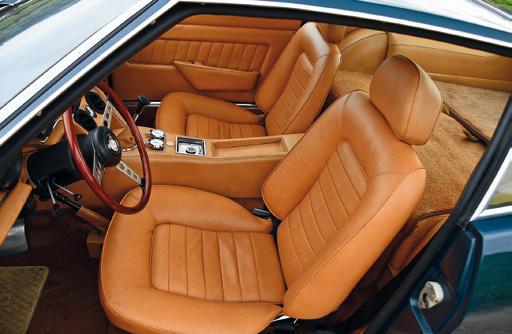


Chassis # AM115 2188
The Maserati Ghibli was introduced in 1966 at the Turin Italy Automobile Show and wore styling by Giorgetto Giugiaro while working for Ghia while the mechanical aspects were handled by Maserati‘s chief engineer, Giulio Alfieri. It was named after a hot wind blowing across the Sahara Desert. Production began with a fastback coupe in April of 1967 with a Spyder joining in 1969. The 4‘719 cc V8 engine with dry-sump lubrication and two chain-driven camshafts per cylinder bank produced just over 300 horsepower. The drysump lubrication enabled the engine to be mounted deep in the chassis, allowing a low bonnet line, while limited suspension travel ensured the tires did not rub the wheel arches. The styling was long and low, with a razor-edge design that was both refined and brutal. It had a steeply raked windscreen, a chopped-off tail, and a lower cabin height than most of its contemporaries, giving it a low center of gravity, albeit restricted headroom for rear passengers.
backed by either a five-speed ZF manual transmission or a three-speed Borg-Warner automatic. The tubular frame was derived from those of the Maserati Mexico and the Quattroporte sedan, and like its predecessors had a live rear axle. Instead of the more complex suspension design used by its rivals, the Ghibli received leaf springs and a single locating arm. It rode on alloy wheels or the optional Borrani wire wheels, had disappearing headlamps, and leather sports seats.
The Ghibli could sprint from zero-to-sixty mph in 6.8 seconds and had a top speed approaching 170 mph, putting it in similar territory to the Lamborghini Miura and Ferrari 365 GTB/4 Daytona. The engine could be


In 1969, Maserati introduced the SS version powered by a new engine that had a larger stroke resulting in a 4‘930cc, 330 horsepower, and 355 lb-ft of torque. From a standstill, the Ghibli could now reach 100 mph in just 16 seconds and had a top speed of 170. Maserati described the SS version as ‚powerful and ultrafast, smooth and dependable, modern and efficient.‘
The exotic styling and mid-front-engine placement, exclusive production numbers, predictable drivability at high speeds, forgiving handling characteristics, low center of gravity, and near-perfect weight distribution made it among the finest supercars of its era.
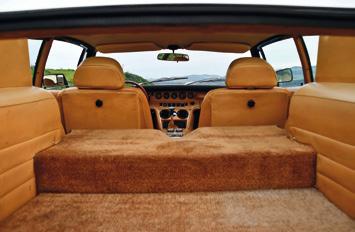
70 www.TheSwissAuctioneers.swiss
The Spyders had two seats while the coupes had a 2+2 configuration, although the rear two seats consisted
Lot 135 1‘170 cars (SS included) V8 4‘719 cc 310 hp at 5‘500/min Estimate CHF 200‘000 - 225‘000 Story conceptcarz.com
Photos Oldtimer Galerie
This gorgeous Maserati Ghibli, certainly one of Giugiaro’s most outstanding designs, with its 4.7 litre V8, was first registered in Switzerland on the 29th of March 1971. Nothing is known about the early history of the car until taken over by the vendor a number of years ago. At that time the coachwork had obviously already been restored and repainted from the original grey to the current blue metallic. The Maserati is in good too very good condition and will certainly form a worthy centrepiece in the collection of any Italian sports car enthusiast. The last veteran MOT was completed in April 2019
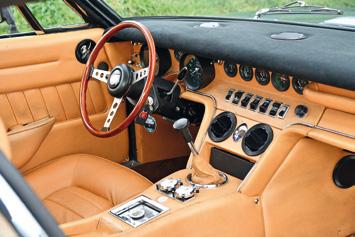

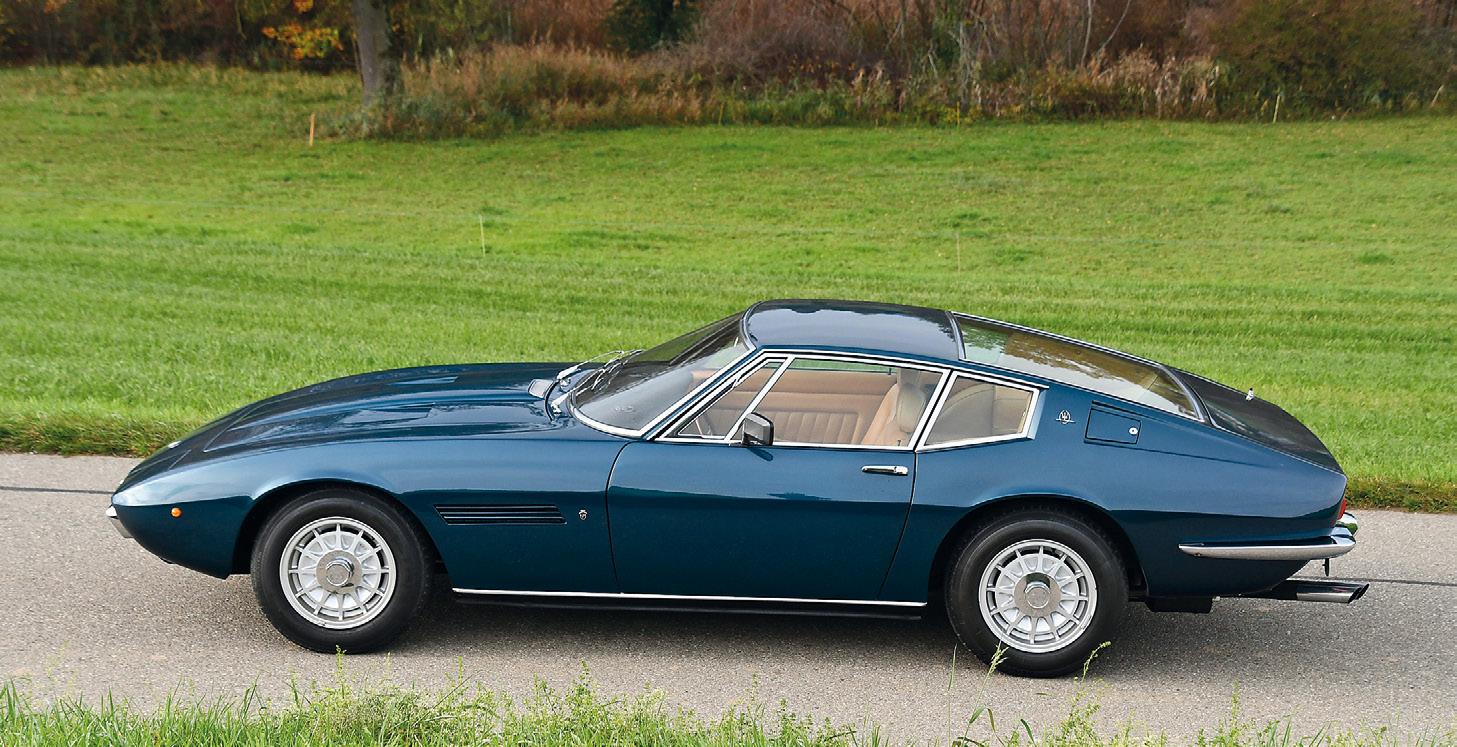

Dieser schöne Maserati Ghibli mit 4.7-Liter V8 wurde am 29. März 1971 erstmals in der Schweiz zugelassen. Über die Geschichte dieses Coupés ist Nichts bekannt, bis der Wagen vor einigen Jahren vom Einlieferer übernommen wurde. Damals war die Karosserie offensichtlich bereits restauriert und vom ursprünglichen Grau

auf das aktuelle Blau metallic umlackiert worden. Der Maserati befindet sich in gutem bis sehr gutem Zustand und wird einem Liebhaber italienischer Grand Tourismo sicher viel Freude bereiten. Die letzte MFK als Veteranenfahrzeug erfolgte im April 2019.

Cette magnifique Maserati Ghibli, certainement l‘une des conceptions les plus remarquables de Giugiaro, avec son V8 de 4.7 litres, a été enregistrée pour la première fois en Suisse le 29 mars 1971. On ne sait rien de l‘histoire de la voiture jusqu‘à sa reprise par le vendeur il y a quelques années. A cette époque, la carrosserie avait déjà été restaurée et repeinte du gris d‘origine au bleu métallisé actuel. La Maserati est en bon à très bon état et constituera certainement une pièce maîtresse dans la collection de tout amateur de voitures de sport italiennes. La dernière expertise vétéran a eu lieu en avril 2019.
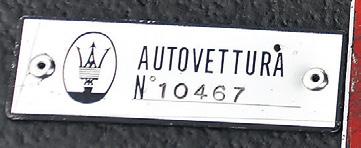
71




TAKING CAR STORAGE TO THE NEXT LEVEL. P791 AG | The Car Residence | Eichholzweg 18 | 3123 Belp | Switzerland | +41 79 791 70 70 | www.p791.ch P791 The Car Residence p791_thecarresidence
1963 Rolls-Royce Silver Cloud III Drophead Conversion
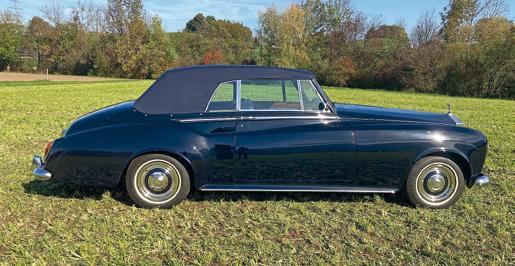
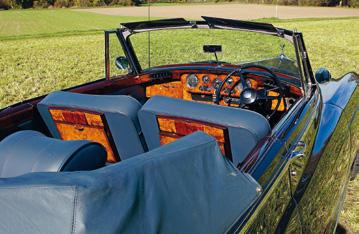




Jahre mehrheitlich in einer Sammlung gestanden. In Vorbereitung für den Verkauf wurden im September 2022 die Bremsen revidiert und ein Service durchgeführt. Der Silver Cloud III befindet sich in gutem bis sehr gutem Zustand und bietet einem Liebhaber die Möglichkeit solch ein Cabriolet zum Bruchteil des Preises, welcher für ein Werksfahrzeug verlangt wird zu erwerben. Die letzte MFK als Veteranenfahrzeug erfolgte im August 2011.
Lot 136

This beautiful Rolls-Royce cabriolet left the Crewe works as a regular saloon painted in burgundy red with a white leather interior. When and with whom the conversion to a drophead was performed is not known, the task was completed very thoroughly though and only deviates in minor details from an original works drophead. The car still boasts its matching numbers original engine. It was restored a number of years ago and has since lived on stationary display in a private collection. In preparation for this sale the brakes were overhauled, and a major service was completed in September 2022. The Silver Cloud III is in good to very good condition and offers the opportunity to acquire a drophead for a fraction of the prize normally paid for a works conversion. The last Veteran MOT was completed in August 2011.
Dieses schöne Rolls-Royce Cabriolet verliess das Werk als normale Limousine mit burgunderroter Lackierung und weisser Lederausstattung. Wann und durch welche Firma der Umbau zum Cabriolet erfolgte, ist nicht bekannt – die Arbeiten wurden jedoch gut ausgeführt und unterscheiden sich nur im Detail von einem originalen «Werks» Cabriolet. Das Fahrzeug verfügt immer noch über seinen «Matching-Numbers» Originalmotor, wurde vor etlichen Jahren restauriert und hat dann die letzten
Ce magnifique cabriolet Rolls-Royce a quitté l‘usine de Crewe en tant que berline ordinaire peinte en rouge bordeaux avec un intérieur en cuir blanc. On ne sait pas quand et avec qui la conversion en cabriolet a été effectuée, mais la tâche a été accomplie avec beaucoup de soin et ne diffère que par des détails mineurs d‘un drophead d‘origine. La voiture possède toujours son moteur d‘origine aux numéros correspondants. Elle a été restaurée il y a plusieurs années et a depuis vécu en exposition stationnaire dans une collection privée. En préparation de cette vente, les freins ont été révisés, et un service majeur a été effectué en septembre 2022. La Silver Cloud III est en bon à très bon état et offre l‘opportunité d‘acquérir une drophead pour une fraction du prix normalement payé pour une conversion d‘usine. La dernière expertise vétéran a été effectuée en août 2011.
73
Chassis # SCX 591
2‘555 cars (all Silver Cloud III) V8 6‘230 cc approx. 225 hp at 4‘500/min Estimate CHF 110‘000 - 130‘000
Photos by consignor
1938 Jaguar SS 100 2 1/2-Litre Roadster

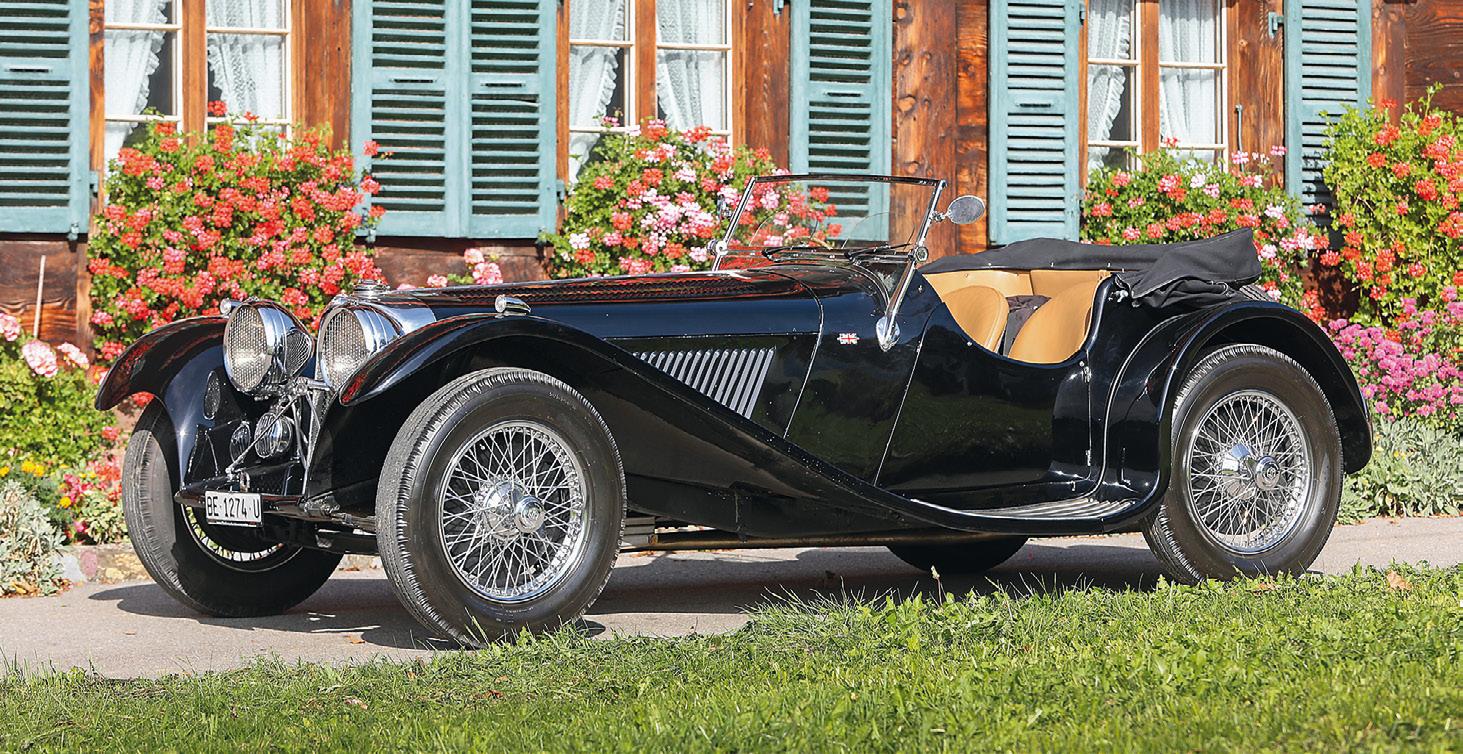
Chassis # 49044

Before it was Jaguar, it was ‚S.S‘, and before that, it was the Swallow Sidecar & Coachbuilding Company of Blackpool, England, founded by William Walmsley. Initially, they built sidecars for motorcycles, adding automobile coachbuilding in 1926 using the popular and inexpensive Austin 7 chassis as their platform. The design had been created by Walmsley‘s partner, one William Lyons. Soon after, the company relocated to Coventry and the Swallow range grew to include models on the Standard Sixteen, Wolseley Hornet, and Morris Cowley chassis. Official marque status arrived in October of 1931 with the introduction of the S.S.I.
The ‚S.S.‘ of the S.S.I represented ‚Standard Swallow‘ (the ‚Sidecar‘ had been dropped from the name in 1927 when it became the Swallow Coachbuilding Company) and the chassis was supplied by Standard, who also provided the four-speed gearbox and the six-cylinder side-valve engine. 2-liter or 2.5-liter displacements were available, while the SS2 came with a four-cylinder 1-liter side-valve engine. Body styles included a coupe or tourer, with a saloon being added in 1934 when the chassis grew two inches wider. The S.S. 90 sports car was added to the lineup in 1935 and by this point in history, William Walmsley had recently retired and William Heynes had joined as Chief Engineer. The S.S.90 rested on a shortened S.S.I. chassis, reengineered by Heynes and wore bodies styled by Lyons characterized by flowing lines, cut-away doors, a truncated tail, and a long bonnet. The ‚90‘ in the car‘s name represented its top speed of 90 mph.
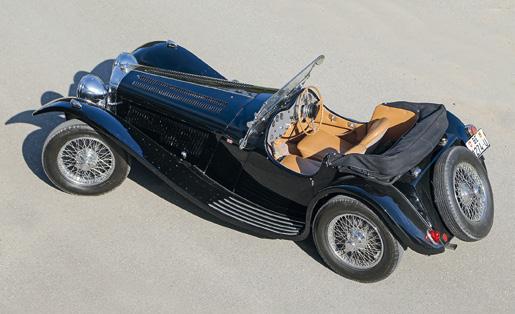
Harry Weslake was described as England‘s greatest expert on cylinder head design. He built an enviable reputation that included working with W.O. Bentley tuning his racing engines cylinder heads, which resulted in the first Le Mans victory. He worked with Automotive Engineering for nearly a decade before setting up his own business in 1935 called Weslake & Taylor. This consultation business
collaborated with companies such as Citroen, MG, Austin, and Swallow Sidecars. His work for Swallows included modifying the side valve Standard engine to overhead valves, and when equipped with twin SU carburetors, the 2,663cc Standard six produced 104 horsepower. Installed in the 8-foot 8-inch wheelbase chassis of the S.S.100 was a ‚proper‘ sports car, although marketed as primarily for competition work. The engine grew larger in 1938, to a 3½ liter displacement size and power increased to 125 bhp. The four-speed gearbox had synchromesh on the top 3 ratios. They left the factory with 5.50 or 5.25 x 18inch tires on 18-inch wheels, and brakes were by Girling.

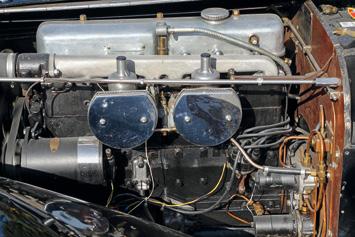
As the popularity and production of the SS cars had increased, the company‘s ash-framed construction had become too time-consuming. All-steel bodies were adopted for the volume-selling saloon cars for 1938, and these heavier bodies required more power. Thus, the 2½-liter engine grew to the 3½-liter displacement. boosting output to 125 bhp.
The name ‚100‘ suggested 100 mph but period road tests revealed a top speed of 95 mph with the 2.5-liter engine and a zero-to-sixty mph time of 13.5 seconds. The larger 3.5-liter powerplant gave the S.S.100 a 100 mph top speed and a zero-to-sixty mph time of 10.4 seconds.
74 www.TheSwissAuctioneers.swiss
Lot 137 198 cars (2 1/2-Litre) in-line 6 cylinder 2‘664 cc 102 hp at 4‘600/min Estimate CHF 180‘000 - 200‘000 at no reserve Story conceptcarz.com
Photos Daniel Zizka / ZG
In 1936, the S.S.100 driven by Tommy Wisdom won the International Alpine Trial, the first of many competition successes, including class victories in the RAC events of 1937 and 1938, and the Alpine (outright) again in 1948. Production of the S.S.100 continued until the outbreak of World War II in Europe, by which point around 198 examples of the 2½-Litre and 116 of the later 3½-Litre cars had been built. The ‚100‘ was in reference to its theoretical 100 mph maximum top speed. In March 1945 the S. S. Cars shareholders agreed to change the name to Jaguar Cars Limited. Jaguar would continue to use the vehicle‘s top speed as part of its model naming scheme, including the legendary XK120. The introduction of the OHV unit was considered to justify the adoption of a new name for the series. Lyons later recalled ‚I immediately pounced on Jaguar as it had an exciting sound to me.‘ (‚Jaguar‘ would be adopted as the marque name in 1943, ‚S.S.‘ having by then acquired a somewhat tarnished reputation). The SS100 was the first vehicle from Sir William Lyon‘s stable to wear the famous Jaguar ‚leaper,‘ the marque‘s feline bonnet ornament in mid-1936. Another example wore a revised Jaguar ‚leaper‘ in early 1937, mounted on the radiator cap. This second ‚leaper‘ was the one that would later become the trademark for Jaguar Cars, Ltd.
Heritage Trust certificate as well as sundry restoration/maintenance records and correspondence since 1988. The most recent Veteran MOT was completed in August 2021.
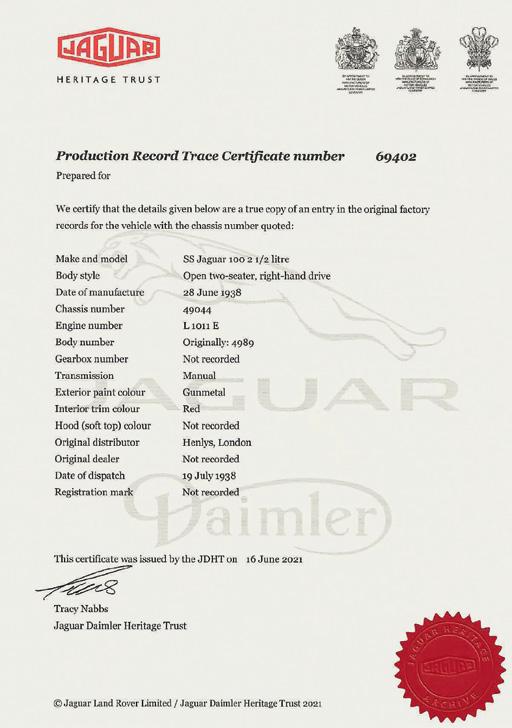

Dieser schöne Jaguar SS 100 wurde am 28. Juni 1938 in gunmetal grey mit roter Innenausstattung gefertigt und am 19. Juli 1938 über Henlys/London an den ersten Händler ausgeliefert. Später wurde der Roadster in die USA verschifft, von wo er Mitte der 80er Jahre zurück in die englische Heimat geholt wurde. Nicht restauriert und mit einem Typenkorrekten 2.5-Liter Austauschmotor ausgestattet, wurde der SS 100 1988/89 restauriert und in der aktuellen Farbkombination fertiggestellt. 1991 wurde der Jaguar vom letzten Besitzer erworben und in die Schweiz importiert. In den letzten 31 Jahren wurde der Roadster für gelegentliche Ausfahrten genutzt und stets gut gewartet. Als einer von nur 198 gebauten SS 100 mit 2.5-Liter Motor befindet sich der Wagen in gutem Zustand und wird mit Heritage Trust Certificate sowie Korrespondenz, Restaurations- und Unterhaltsbelegen seit 1988 an den nächsten Liebhaber übergeben. Die letzte MFK als Veteranenfahrzeug erfolgte im August 2021.
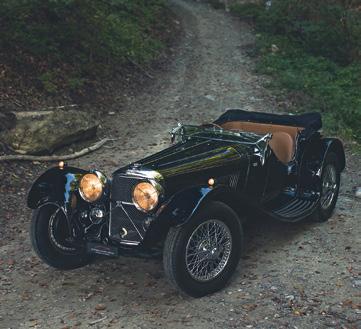



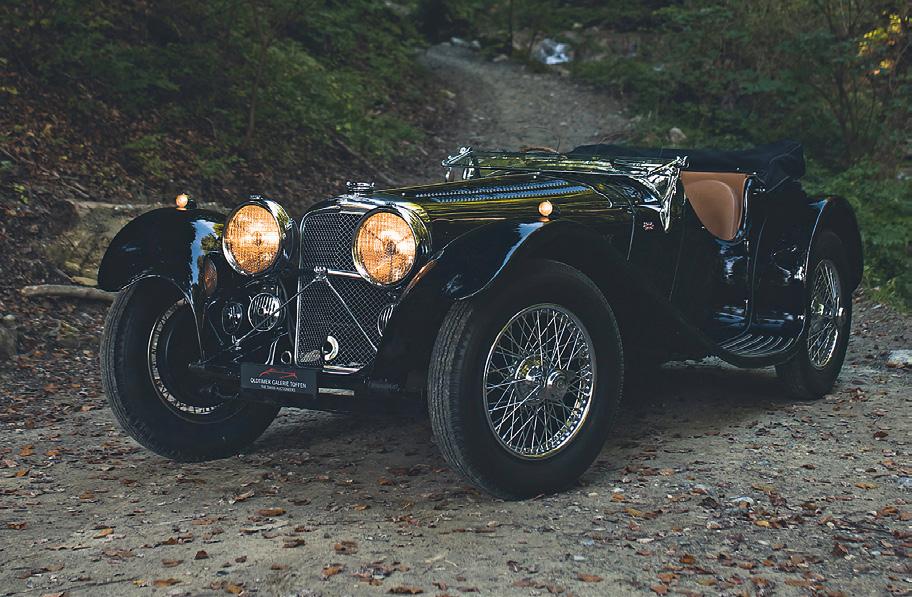
Cette magnifique Jaguar SS 100 a été produite le 28 juin 1938 en gris gunmetal avec intérieur rouge et livrée au premier concessionnaire le 19 juillet 1938 via Henlys/Londres. Le roadster a ensuite été expédié aux États-Unis, d‘où il a été ramené dans sa patrie anglaise au milieu des années 1980. Non restauré et équipé d‘un moteur de remplacement de 2,5 litres conforme au type, le SS 100 a été restauré en 1988/89 dans la combinaison de couleurs actuelle. En 1991, la Jaguar a été acquise par le dernier propriétaire et importée en Suisse. Au cours des 31 dernières années, le roadster a été utilisé pour des sorties occasionnelles et a toujours été bien entretenu. Comme il s‘agit de l‘une des 198 SS 100 produites avec le moteur de 2.5 litres, la voiture est en bon état et sera remise au prochain amateur avec un certificat du Heritage Trust ainsi que la correspondance, les reçus de restauration et d‘entretien depuis 1988. La dernière expertise en tant que véhicule vétéran a eu lieu en août 2021.
This beautiful Jaguar SS100 was completed on the 28th June 1938 painted gunmetal grey with a red interior and delivered through Henly’s in London to a dealer on the 19th July 1938. Later, the roadster was shipped to the USA from where it returned to English shores in the mid-80s. Unrestored and equipped with a type correct 2.5 litre replacement engine, the SS100 was restored in 1988/89 and completed in the actual colour combination. In 1991 the Jaguar was acquired by its last owner and imported into Switzerland. In the last 31 years the SS100 was used for occasional outings whilst enjoying thorough and regular maintenance. Being one of only 198 2 1/2 litre SS100 built, the car is in good condition and will be sold with a

75
1987 Lamborghini Countach LP5000 Quattrovalvole
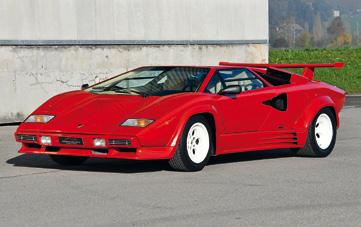
Chassis # ZA9C005A0JLA12409

Lamborghini introduced a sports car dubbed the Miura in the early 1960s and its stellar performance and equally impressive design resulted in it being the first supercar. It had a mid-engine two-seat layout which would become the standard for high-performance sports and supercars. The iconic, high-velocity Miura coupe was always going to be a hard act to follow, but nobody expected its successor would eclipse the 1960s supercar to the degree that the Countach achieved. Its styling, like its predecessor, was courtesy of Bertone‘s Marcello Gandini with design inspiration sourced from the Lancia Stratos Zero concept the year before. The Countach was given an angular wedge with crisp lines and dramatic angles. Introduction in 1971 at the Geneva Salon, the production version would follow two years later, with deliveries commencing in 1974.
archange. The prototype used a 5.0-liter engine, while the spaceframe chassis of the production version was equipped with a 4.0-liter vehicle. The 370 horsepower engine gave the lightweight Countach a top speed of 170 miles per hour.
The Lamborghini Countach was given the Miura‘s fourcam V-12 engine installed longitudinally behind the cabin. Designer Paolo Stanzani placed the five-speed gearbox ahead of the engine between the seats, and the differential – driven by a shaft passing through the sump – at the rear. This setup gave the supercar optimum weight distribution, better balance, and ge-
The LP400S of 1978 was the first upgrade to appear, bringing with it flared wheel arches to accommodate large 345mm rear tires for increased stability and grip. An optional rear aerofoil became available and proved popular with most buyers.
The Countach was finally available for the United States market with the arrival of the ‚emissions friendly‘ LP500S in 1982. The updated 4,754cc produced a similar horsepower output to its predecessors but enjoyed a welcome boost in torque.

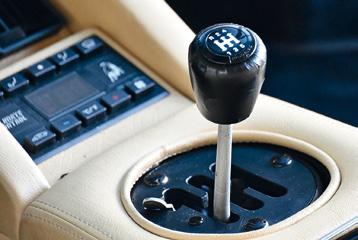
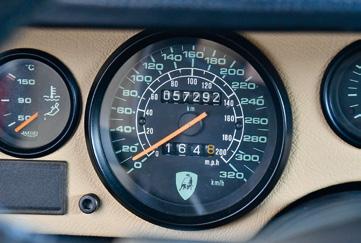
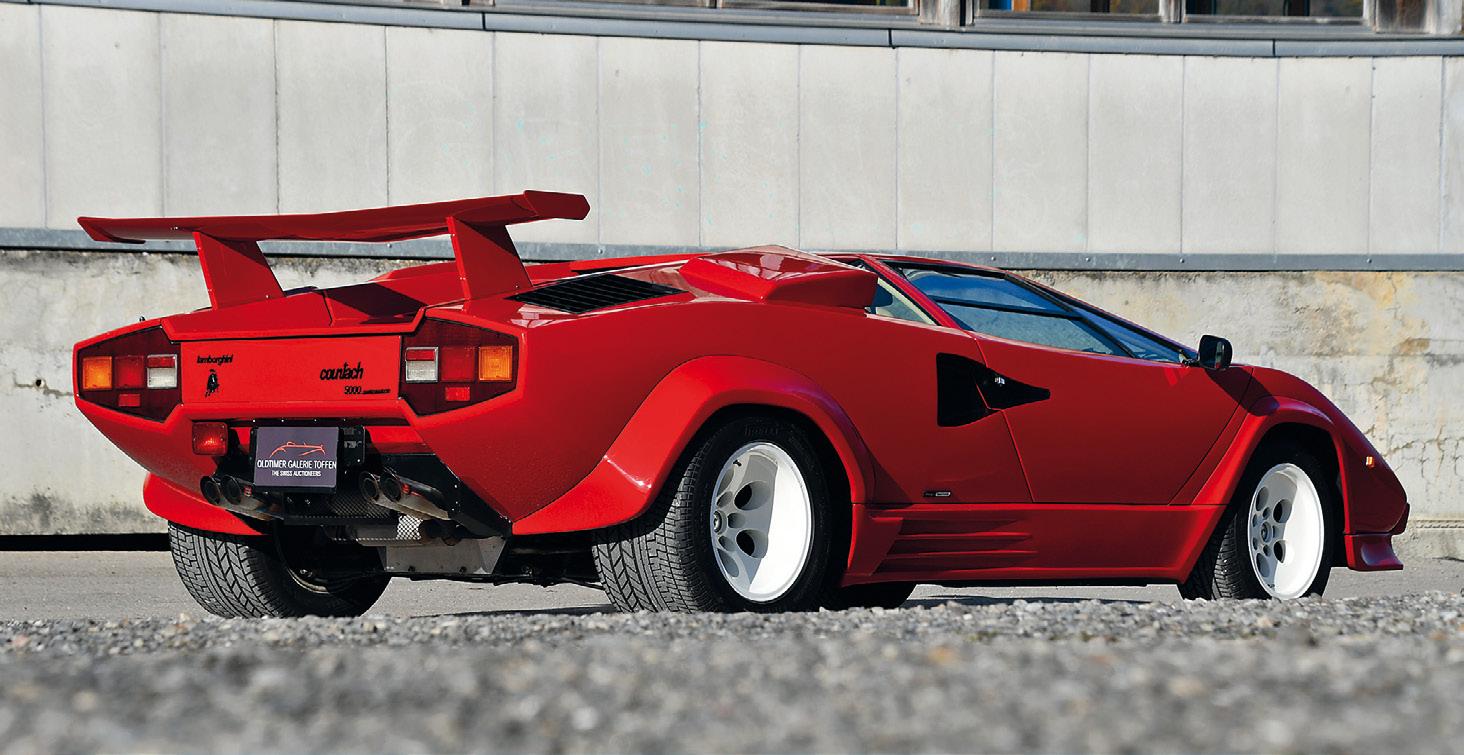
In 1985, Lamborghini introduced the final version of the Countach. It came equipped with a 48-valve (four per cylinder) version of the V12 engine, had a displacement size of 5‘167cc, and offered 455 (DIN) horsepower. In US form, the engine offered 420 (SAE) horsepower and was capable of a 186 mph top speed.
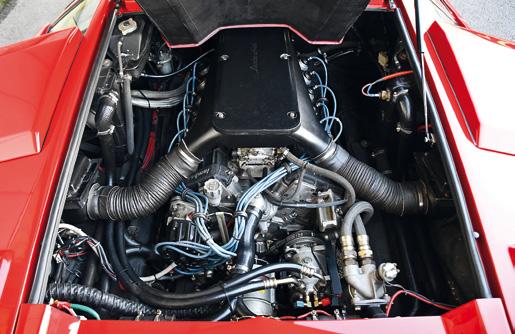
76 www.TheSwissAuctioneers.swiss
Lot 138 610 cars (1985-88) V12 5‘167 cc 455 hp at 7‘000/min Estimate CHF 500‘000 - 550‘000 Story conceptcarz.com
Photos Oldtimer Galerie
The 5000 Quattrovalvole would remain in production through 1989 and was priced at approximately $100,000. In 1989, an Anniversary Countach (in celebration of the 25th birthday of the company) became available for the cost of $145,000. It had a re-shaped hood air intake grilles, large flared wheel wells, re-styled front air dam, a one-piece rear bumper, and front and side skirting.
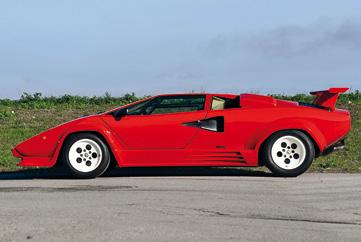
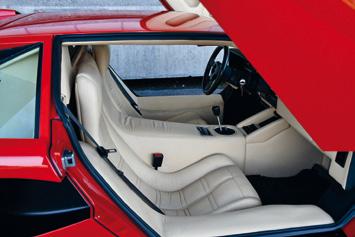
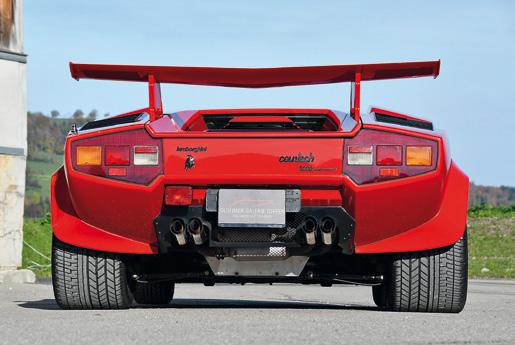
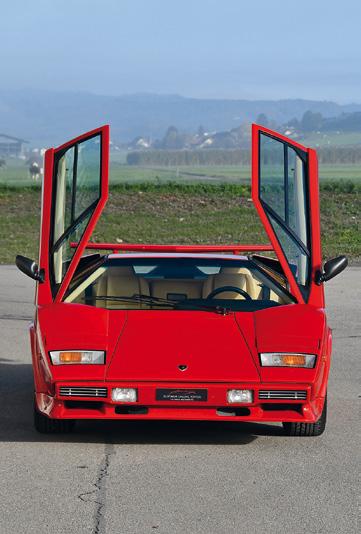
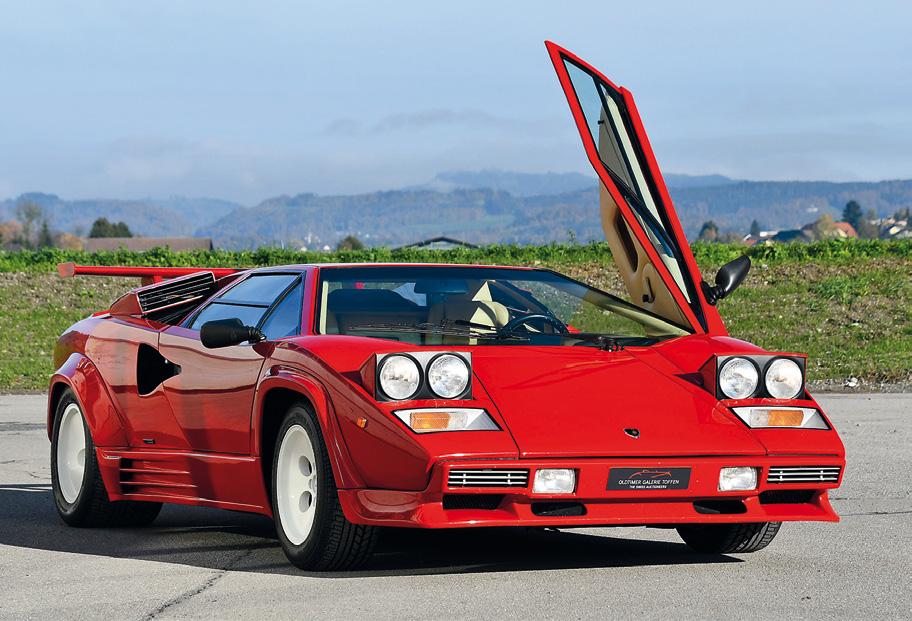

der markentypischen Scherentüren empfiehlt es sich auf genügend Deckenfreiheit zu achten und die breiten Türschweller werden gerne auch als Sitzgelegenheit beim Rückwärtsfahren genutzt. Ein zeitloser Supersportwagen der späten 80er Jahre, welcher sich mit rund 58‘000 gefahrenen Kilometern in gutem bis sehr gutem Zustand befindet und jeder Lamborghini- bzw. Sportwagensammlung gut zu Gesicht stehen wird. Das Fahrzeug wird mit englischen Papieren angeboten und ist in der Schweiz verzollt.
The example offered is one of the last examplesbesides the plastic-flared Anniversary Edition - of the legendary wedge from Sant’Agata Bolognese. It‘s a European version of the Quattrovalvole equipped with Weber carburettors but without a catalytic converter, resulting in a unique and unforgettable sound combined with a bigger than necessary punch. The first registration of this Lamborghini with its construction year 1987 was completed on 17th November 1988 in Hannover. In September 2014, the car was deregistered by its first owner and consequently sold to England. In 2016, after two further owners, the supersportscar was finally acquired by the vendor, imported into Switzerland and added to his collection. Not for the shy and retiring, this Lamborghini creates quite a stir wherever it appears and is of course instantly recognisable as a Countach. Opening those scissor type doors is quite a spectacle in itself, and to help reversing the car, the wide sill can be used as the perfect (and very necessary) aiming base. A timeless yet typical 80’s sports car which, with 58’000 kilometres driven, presents itself in good to very good condition and would certainly make a worthy addition to any Lamborghini or sports car collection. The car is offered with UK documentation and Swiss custom duties have been paid.

Das angebotene Fahrzeug ist eines der letzten Exemplare – ok, es gab noch den Anniversary mit unveränderter Technik und vielen Kunststoffanbauteilen – des legendären Donnerkeils aus Sant’Agata Bolognese. Hier handelt es sich um ein Quattrovalvole in europäischer Ausführung – mit Weber-Vergasern und ohne Katalysator. So bietet dieser Lamborghini einen einmaligen Klang gepaart mit mehr als ausreichender Leistung. Die Erstzulassung dieses Lambos mit Baujahr 1987 erfolgte am 17. November 1988 in Hannover. Im September 2014 wurde der Wagen vom Erstbesitzer abgemeldet und anschliessend nach England verkauft. 2016, nach zwei englischen Besitzern, wurde der Sportwagen schliesslich vom Einlieferer erworben, in die Schweiz importiert, und in dessen Sammlung integriert. Dieser Lamborghini sorgt überall für Aufsehen und wird auch heute noch von jedermann sofort als Countach erkannt. Beim Öffnen
L‘exemple proposé est l‘un des derniers exemplaires - outre l‘édition Anniversaire avec une technique inchangée et de nombreuses pièces rapportées en plastique - du légendaire coin du tonnerre de Sant‘Agata Bolognese. Il s‘agit d‘une version européenne de la Quattrovalvole équipée de carburateurs Weber mais sans catalyseur, ce qui donne un son unique et inoubliable combiné à un punch plus grand que nécessaire. La première immatriculation de cette Lamborghini avec son année de construction 1987 a été réalisée le 17 novembre 1988 à Hanovre. En septembre 2014, la voiture a été désenregistrée par son premier propriétaire et par conséquent vendue en Angleterre. En 2016, après deux autres propriétaires, la supersportive a finalement été acquise par le vendeur, importée en Suisse et ajoutée à sa collection. Cette Lamborghini, qui n‘est pas faite pour les timides et les effacés, fait sensation partout où elle apparaît et est bien sûr immédiatement reconnaissable comme une Countach. L‘ouverture de ces portes en ciseaux est un spectacle en soi, et pour faciliter la marche arrière de la voiture, le large seuil peut être utilisé comme base de visée parfaite (et très nécessaire). Une voiture de sport intemporelle mais typique des années 80 qui, avec 58’000 kilomètres parcourus, se présente en bon à très bon état et ferait certainement un ajout digne de ce nom à toute collection de Lamborghini ou de voitures de sport. La voiture est offerte avec les papiers britanniques et les droits de douane suisses qui ont été payés.
77
1961 Bentley S2 Continental Drophead Coupe



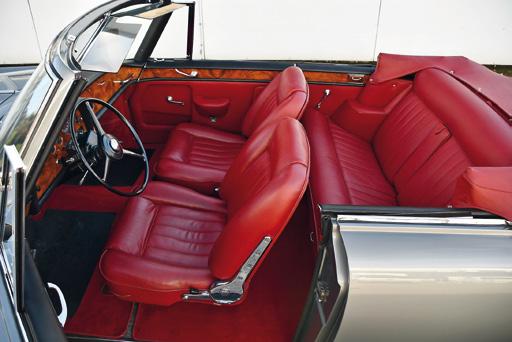 Chassis # BC74LBY
Chassis # BC74LBY
The Bentley S2, introduced in September of 1959, was the stablemate to the Rolls-Royce Silver Cloud II and retained the basic body design and chassis of its predecessor, the S1. The F-head six-cylinder engine of the S1 was replaced with an all-new overhead-valve V-8 engine, under design and development for the previous decade by the engineers at Crewe. Breaking from the tradition of its parent firm, Rolls-Royce, long disdained publication of horsepower ratings, the new 6230cc V-8 engine was estimated to develop over 200 brake horsepower, approximately 25% more than the old six. With the light-weight all-alloy construction, the Silver Cloud II and S2 were faster and quicker than their immediate predecessors. Significant changes were made to the running gear, with power-assisted steering offered as standard equipment and the manual gearbox was no longer offered, with the Rolls-Royce four-speed automatic being the sole offering.

special highs-peed tires, a higher rear axle ratio applied up to ‚B-Series‘ Chassis BC99BY, lightweight alloy body panels, and a lower-profile radiator.
Continuing the tradition established by the R-Type Continental of the early 1950s, a higher-specification Continental variant with distinctive styling was offered on the S2 chassis to discerning buyers. Upgrades included four-leading-shoe drum brakes in the front,
The Continental was exclusively a coachbuilt automobiles. The firms of H J Mulliner, Park Ward, James Young and Hooper (with a solitary example) all offered handcrafted bodies on the Continental S2 chassis. James Young and Hooper would soon cease coachbuilding, leaving only Mulliner and Park Ward to carry on a tradition. Consolidating its in-house coachbuilding capability, Rolls-Royce had purchased H J Mulliner in 1959 and two years later the firm was merged with Park Ward, which had been acquired in 1939.
For the most part the Continental line was limited to coupes and cabriolets with one exception being the four-door Flying Spur.
The open Drophead Coupé by Park Ward was distinct on the S2 line. It was designed by Vilhelm Koren of Norway for Park Ward with a straight fender line and more outwardly positioned front headlights.

78 www.TheSwissAuctioneers.swiss
63
V8 6‘230 cc approx. 200
at 4‘500/min Estimate CHF 200‘000 - 225‘000
Lot 139
cars (LHD)
hp
Story conceptcarz.com
Photos Oldtimer Galerie
The 1961 Continental Park Ward DHC with its ground breaking design by the Norwegian designer Vilhelm Koren is one of Bentleys most outstanding post war design. Popular with film stars such as Yul Brynner and royalty such as King Hassan II of Morocco, the car proved popular with a number of well situated connoisseurs around the world. The example on offer is one of only 63 left hand drive cars built. It was delivered to the garage de l’Athénée in Geneva in March 1961, and in April of the same year sold to Hans Grether, then CEO off Doetsch-Grether (Fenjal). Copies of the chassis card show that the Continental was built to Swiss specifications and delivered in shell grey, with a grey soft top and a red leather interior. In the same chassis card, as well as the Bentley Continental registry, only one further owner, Walter F. Bugmann is listed, and the car was last registered in his company’s name. Obviously the S2 received restoration work many years ago and at the same time was equipped with a black soft top, but unfortunately there is no further documentation available. The beautiful Cabriolet is in good overall condition and for the most recent Veteran MOT in November 22 enjoyed a cosmetic refreshing.

Nicht nur bei Filmgrössen wie Yul Brynner oder gekrönten Häuptern wie König Hassan II von Marokko, sondern auch bei Wirtschaftsgrössen war ein Bentley S2 Cabriolet ein beliebtes Fortbewegungsmittel. Das hier angebotene Exemplar – eines von nur 63 gebauten Fahrzeugen mit Linkslenkung – wurde im März 1961 an die Garage de l’Athénée in Genf geliefert, und im April des Jahres an Hans Grether, damaliger Firmenführer von Doetsch-Grether (fenjal), übergeben. Wie Kopien der Chassis-Karten zeigen, wurde der Continental nach
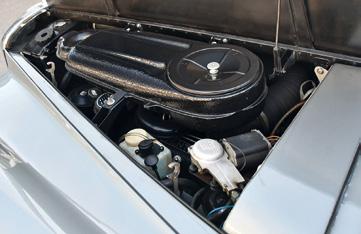


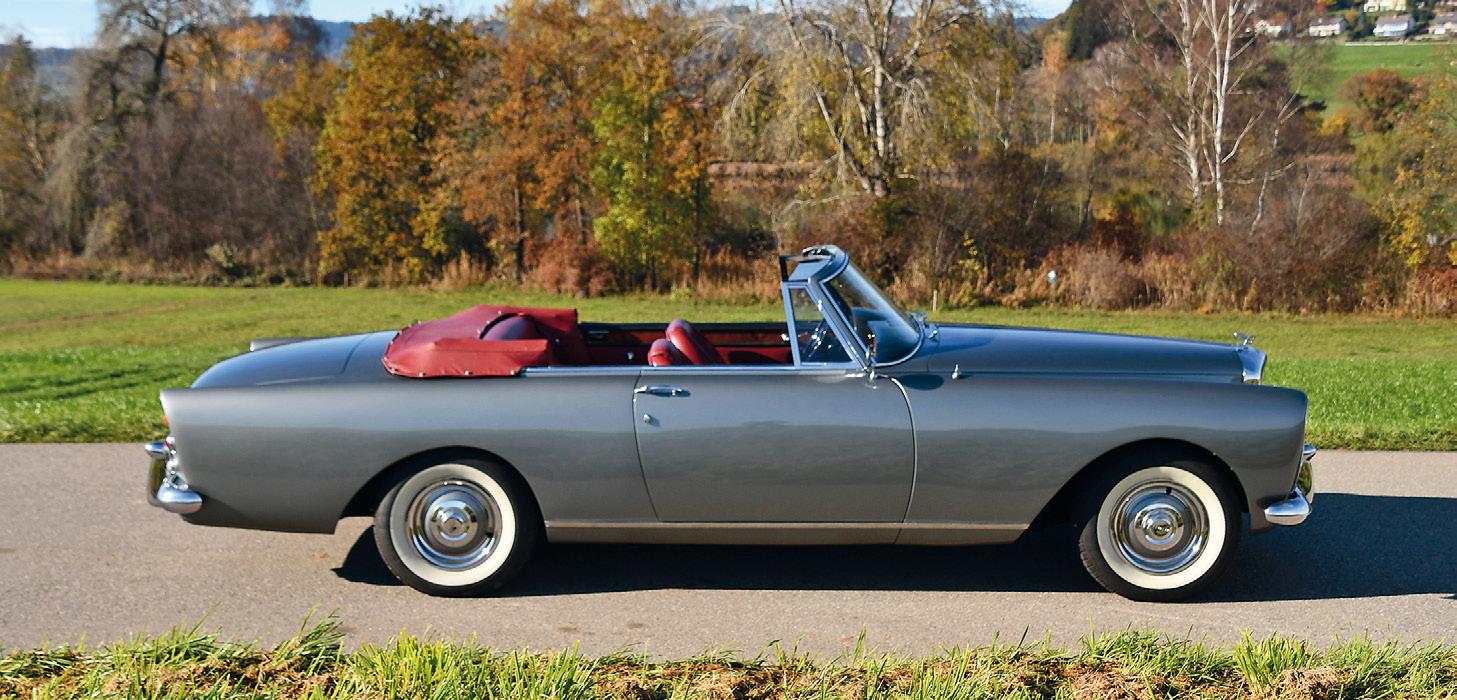
Schweizer Spezifikationen gebaut, und in «Shell Grey» mit grauem Verdeck und roter Lederausstattung ausgeliefert. In den Chassis-Karten wie auch im Bentley Continental Register ist nur noch ein weiterer Besitzer – Walter F Bugmann - vermerkt, und der Wagen war bis zuletzt auf dessen Firma zugelassen. Offensichtlich wurde der S2 vor vielen Jahren restauriert und erhielt ein schwarzes Verdeck, Unterlagen hierzu sind nicht vorhanden. Das schöne Cabriolet befindet sich in gutem Allgemeinzustand und wurde für die letzte MFK als Veteranenfahrzeug im November 2022 kosmetisch aufbereitet.
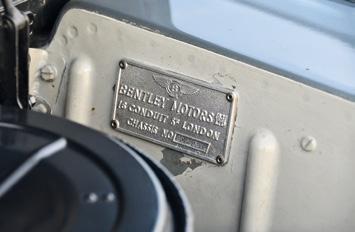

La Continental Park Ward DHC de 1961, dont le design révolutionnaire a été conçu par le designer norvégien Vilhelm Koren, est l‘un des modèles Bentley les plus remarquables de l‘après-guerre. Populaire auprès de stars de cinéma comme Yul Brynner et de membres de la royauté comme le roi Hassan II du Maroc, la voiture s‘est avérée populaire auprès d‘un certain nombre de connaisseurs bien situés dans le monde entier. L‘exemplaire proposé est l‘une des 63 voitures avec conduite à gauche construites. Il a été livré au garage de l‘Athénée à Genève en mars 1961, et vendu en avril de la même année à Hans Grether, alors PDG de Doetsch-Grether (Fenjal). Des copies de la carte de châssis montrent que la Continental a été construite selon les spécifications suisses et livrée en gris coquille, avec une capote grise et un intérieur en cuir rouge. Dans la même fiche de châssis, ainsi que dans le registre de la Bentley Continental, un seul autre propriétaire, Walter F. Bugmann, est mentionné, et la voiture a été enregistrée pour la dernière fois au nom de sa société. Il est évident que la S2 a été restaurée il y a de nombreuses années et qu‘elle a été équipée en même temps d‘une capote noire, mais il n‘y a malheureusement pas d‘autres documents disponibles. Le beau cabriolet est en bon état général et a bénéficié d‘un rafraîchissement cosmétique lors la dernière expertise vétéran en novembre 2022.
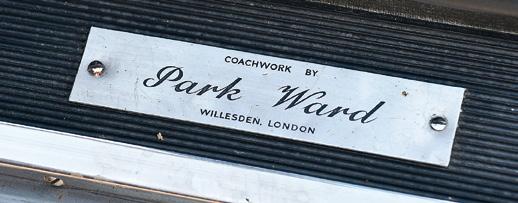
79
2009 Rolls-Royce Phantom Coupé

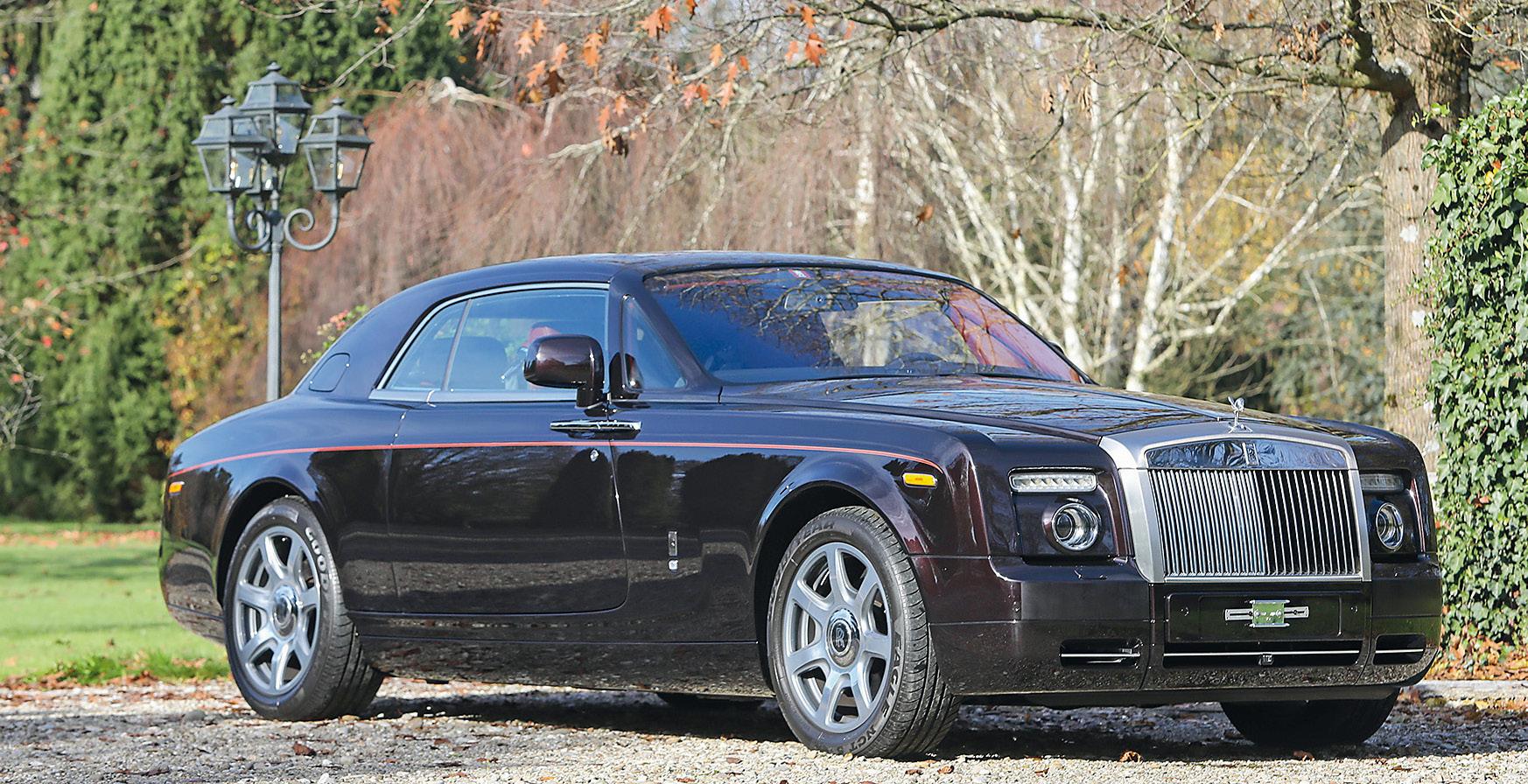
Chassis # SCA3C680X9UX29115
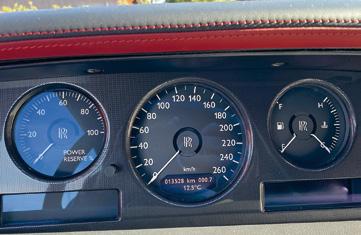
The Rolls-Royce Phantom Coupé is a luxury car manufactured by Rolls-Royce Motor Cars that debuted at the 2008 Geneva International Motor Show in Geneva, Switzerland, on 6 March 2008.
The platform is based on the 2003 Rolls-Royce Phantom and has styling heavily derived from the RollsRoyce 100EX, a concept car unveiled to celebrate the company‘s centennial in 2004. Its interior includes leather and wood veneer. There is a button to close the „coach doors“ (suicide doors). The Phantom Coupe has the same 6.75-litre (412 cu in) V12 as found in the other Phantom models, developing 338 kW (460 hp) of power and 720 Nm of torque. It is the first RollsRoyce coupe in 22 years. It featured pillarless body construction making it a true 2-door hardtop, much like the popular hardtops from the United States in the 1960s.

doors, adaptive suspension with automatic four-corner levelling, 21-inch alloy wheels, a 15-speaker 420 watt sound system with navigation, and a handcrafted interior with flawless leather trim and a choice of wood veneers. The „picnic“ boot provides a seating platform for two and offers easy access to the luggage compartment. Optional equipment includes front and rear parking cameras and a wide array of paint colours and interior trim material choices. A unique option is a full-length „starlight“ headliner, which incorporates hundreds of tiny fibre optics to give the impression of a star-filled night sky.
The Phantom Coupé is capable of accelerating from 0–60 mph (0–97 km/h) in 5.8 seconds and has a limited top speed of 155 mph (249 km/h).
The Phantom Coupé has received mostly positive reviews from critics. The British television show Top Gear rated the car 9/10 for performance, 10/10 for quality, 9/10 for design, but criticised its high cost.
The Phantom Coupé has nearly 542 Nm of torque, or 75 percent, available at 1‘000 rpm — and has segmentleading fuel economy thanks to technology such as direct injection and variable valve and camshaft control. The car features reverse-opening power-closing
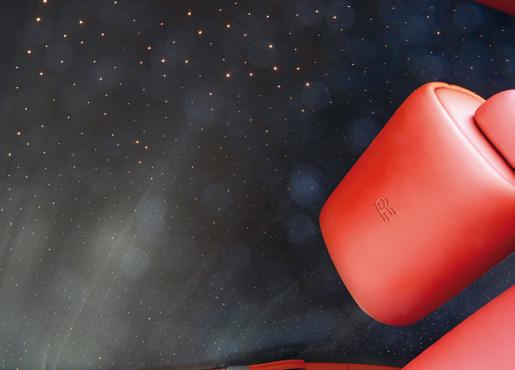
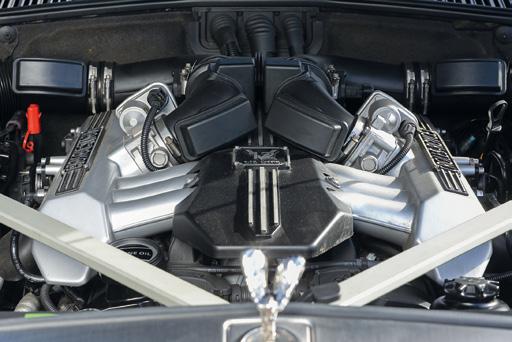
80 www.TheSwissAuctioneers.swiss
Lot 140 196 cars (2009) V12 6‘749 cc 460 hp at 5‘350/min Estimate CHF 280‘000 - 320‘000 Story wikipedia.org Photos zwischengas.com
Despite its hefty list price of around 700’000 Swiss francs, Rolls Royce was able to shift 196 examples of the Phantom Coupé in 2009. Basic equipment includes the BMW-sourced 6.75 litre V12 with 460hp as well as the automatic gearbox, rear hinged “suicide” doors, an opulent leather interior and many other luxury options. The Starlight rooflining (for the romantically inclined) in this car with its more than 1’600 tiny optical fibre transmitted lights, was an additional and rather expensive special option. This rather generous Coupé was delivered to Switzerland as an exhibition vehicle for the 79th Geneva Motor Show and first registered on 27th of March 2009 also in Geneva. In 2014, then showing around 10’000 kilometres, the Coupé was sold to the second owner to form part of the vendors family collection. With a complete service booklet and only 13’500 kilometres driven, the Rolls-Royce is in very good and exceedingly well-maintained original condition and will provide a new owner with many years of unequalled luxury, courtesy of this most traditional of British brands. The last MOT was completed in September 2021.

Trotz eines Grundpreises von rund CHF 700‘000, konnte Rolls-Royce 2009 immerhin 196 Phantom Coupés an den Mann bringen. Der 6.75-Liter V12 mit 460 PS gehörte ebenso zur Grundausstattung wie das automatische Getriebe, die hinten angeschlagenen «Selbstmördertüren», die opulente Lederausstattung, und viele weitere Luxusfeatures. Der in diesem Fahrzeug motierte «Starlight» genannte Dachhimmel mit 1‘600 über Glasfasern versorgten Lichtpunkten war jedoch eine nicht ganz günstige Sonderausstattung. Dieses riesige Coupé wurde als Ausstellungsfahrzeug für den 79. Automobilsalon in Genf in die Schweiz ausgeliefert und am 27. März 2009 erstmals, ebenfalls in Genf, zugelassen. 2014, mit damals rund 10‘000 gefahrenen Kilometern, wechselte das Coupé den Besitzer und war fortan Bestandteil der Sammlung der Einliefererfamilie. Mit lückenlosem Serviceheft, und erst 13‘500 gefahrenen Kilometern befindet sich der Rolls-Royce in sehr gutem und äusserst gepflegtem Originalzustand und ermöglicht es einem neuen Besitzer noch viele Jahre den unvergleichlichen Luxus der britischen Traditionsmarke zu geniessen. Die letzte MFK erfolgte im September 2021.


Malgré son prix d‘appel élevé d‘environ 700’000 francs suisses, Rolls Royce a réussi à écouler 196 exemplaires de la Phantom Coupé en 2009. L‘équipement de base comprend le V12 de 6.75 litres de 460 cv ainsi que la boîte de vitesses automatique, les portes „suicide“ à charnières arrière, un intérieur en cuir opulent et de nombreuses autres options de luxe. Le ciel de toit «Starlight» (pour les amateurs de romantisme) de cette voiture, avec ses plus de 1‘600 minuscules lumières transmises par fibre optique, était une option spéciale supplémentaire et plutôt coûteuse. Ce coupé plutôt généreux a été livré en Suisse comme véhicule d‘exposition pour le 79e Salon de l‘automobile de Genève et a été immatriculé pour la première fois le 27 mars 2009 aussi à Genève. En 2014, affichant alors environ 10‘000 kilomètres, le Coupé a été vendu au second propriétaire pour faire partie de la collection familiale du vendeur. Avec un carnet d‘entretien complet et seulement 13‘500 kilomètres parcourus, la Rolls-Royce est en très bon état d‘origine, extrêmement bien entretenue et offrira à un nouveau propriétaire de nombreuses années de luxe inégalé, grâce à la plus traditionnelle des marques britanniques. La dernière expertise a été effectuée en septembre 2021.
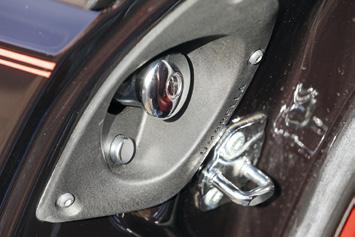

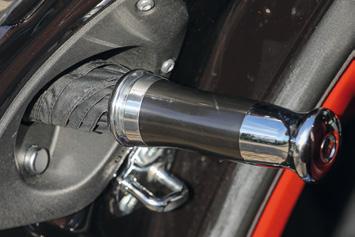

81

1973 Jaguar E-Type V12 Roadster
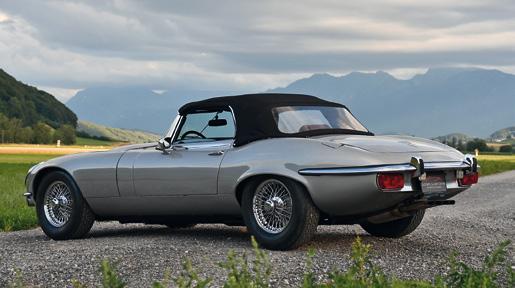
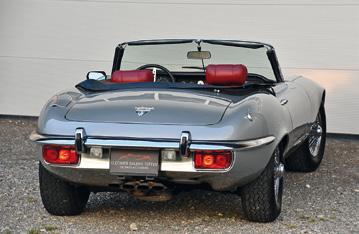
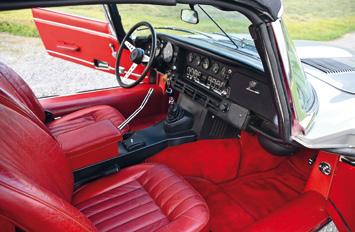
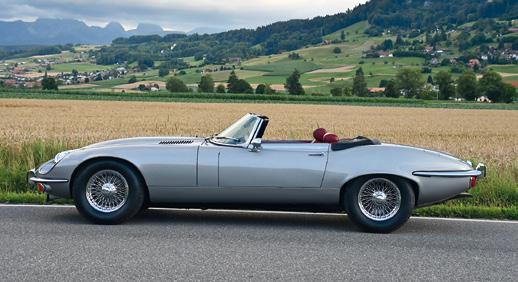
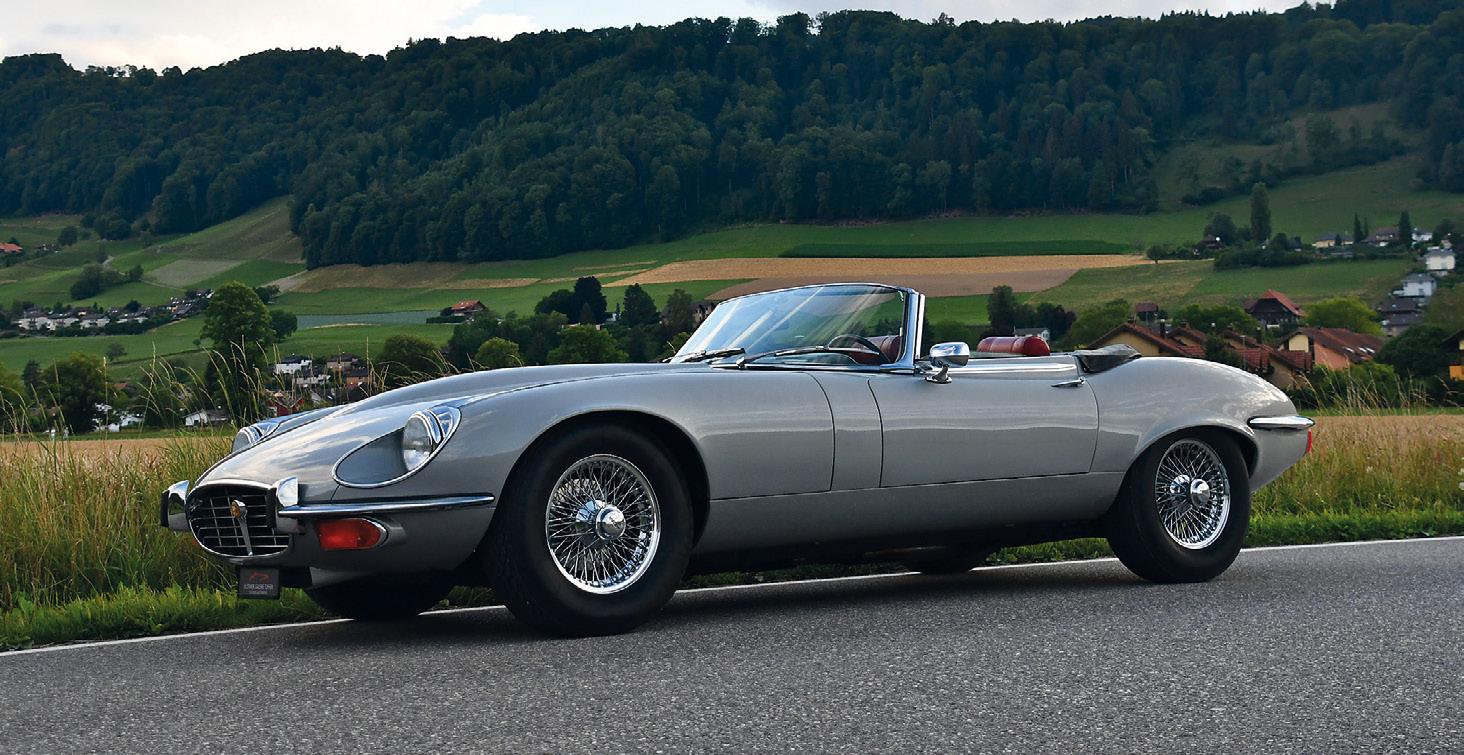 Chassis # UD1S23085
Chassis # UD1S23085

The V12 E type, commonly known as Series 3, was built mainly for the American market and a large number all of them were ordered with an automatic gearbox. The example we have on offer boasts a 4-speed manual box which is not only much more desirable but also more in the spirit of proper sports car motoring. The Jaguar was completed in 1973 and registered in the USA for the first time in November of the same year. Many years ago, this outstanding roadster was imported into Switzerland and registered here. The car was recently repainted in its original colour of light silver metallic and is in very good condition indeed. The red leather interior perfectly complements its lovely silver coachwork and chrome wire wheels complete the quintessential British 70’s sports car cliché. The last Veteran MOT was completed in February 2022.
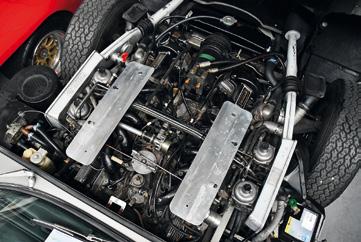
Der auch Series III genannte E-Type V12 war vorwiegend für den amerikanischen Markt konzipiert und wurde gerne mit automatischem Getriebe bestellt – das angebotene Exemplar verfügt über ein 4-Gang Schaltgetriebe, was deutlich besser zu einem Sportwagen passt. Der Jaguar wurde 1973 gebaut und im November des Jahres erstmals in den USA zugelassen. Vor vielen Jahren wurde der wunderschöne Roadster in die Schweiz importiert und hier zugelassen. Der Wagen wurde kürzlich in der Origi-
nalfarbe «Light Silver Metallic» neu lackiert und befindet sich in sehr gutem Zustand. Die rote Innenausstattung harmoniert perfekt, und die Chrom-Speichenräder unterstreichen die typisch britische Sportwagenerscheinung der frühen 70er Jahre. Die letzte MFK als Veteranenfahrzeug erfolgte im Februar 2022.
La type E V12, communément appelé Série 3, a été construit principalement pour le marché américain et un grand nombre d‘entre eux ont été commandés avec une boîte de vitesses automatique. L‘exemple que nous proposons est équipé d‘une boîte manuelle à 4 vitesses, ce qui est non seulement beaucoup plus désirable mais aussi plus conforme à l‘esprit des voitures de sport. La Jaguar a été achevée en 1973 et immatriculée pour la première fois aux États-Unis en novembre de la même année. Il y a de nombreuses années, ce roadster exceptionnel a été importé en Suisse et enregistré ici. La voiture a été récemment repeinte dans sa couleur d‘origine, argent clair métallisé, et se trouve en très bon état. L‘intérieur en cuir rouge complète parfaitement sa belle carrosserie argentée et les roues en fil de fer chromées complètent le cliché de la quintessence des voitures de sport britanniques des années 70. La dernière expertise vétéran a été effectuée en février 2022.
83
Lot 141 6‘119 cars (LHD) V12 5‘344 cc 276 hp at 5‘850/min Estimate CHF 95‘000 - 115‘000
Photos Oldtimer Galerie
This AMG G63 with its brute 4 litre biturbo V8 delivering 585 hp has been the ultimate Power-SUV for a long time. The example offered is a Swiss delivery and was first registered in the Baselland canton on the 30th of October 2020. In September 2021, then showing 15’200 kilometres, the car was taken over by the vendor and regularly used since. With all the options, including a speed shift 9 speed automatic gearbox, leather, air conditioning, multimedia system and much more, this AMG is the perfect long distance express on and off the tarmac. This gigantic Mercedes AMG has had two owners, has covered only around 23’500 kilometres, and will be delivered freshly serviced and with the latest MOT from October 2020.
Der AMG G63 mit seinem brachialen, 585 PS leistenden, 4-Liter Biturbo V8, war lange Zeit der ultimative Power-Geländewagen. Das angebotene Fahrzeug stammt aus Schweizer Auslieferung und wurde am 30. Oktober 2020 erstmals im Kanton Baselland zugelassen. Im September 2021, mit 15‘200 Kilometern auf der Uhr, wurde der Wagen vom Einlieferer übernommen und seither gerne genutzt. Komplett ausgestattet mit Speedshift 9-Gang Automatik, Leder, Klimaanlage,
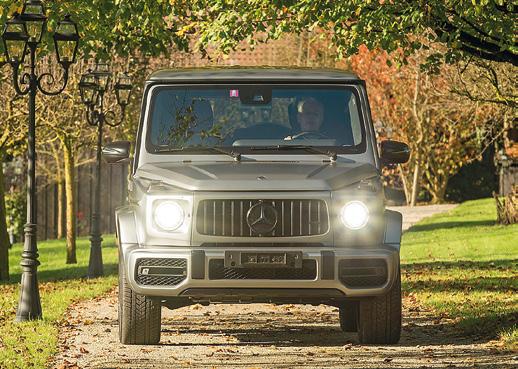
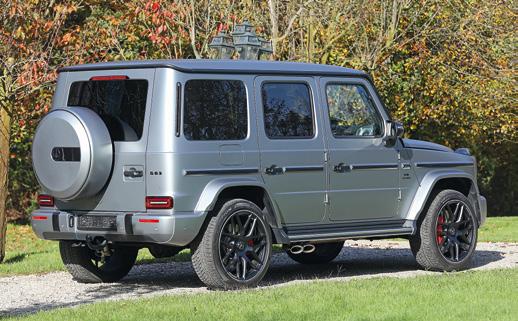

Multimedia-System und Vielem mehr ist dieser AMG ein hervorragendes Reisefahrzeug auf- und abseits befestigter Strassen. Dieser gigantische Mercedes AMG stammt aus zweiter Hand, hat erst rund 23‘500 Kilometer gefahren und wird frisch ab Service und mit der letzten MFK im Oktober 2020 verkauft.


Cette AMG G63, avec son V8 biturbo de 4 litres délivrant 585 ch, est depuis longtemps le Power-SUV par excellence. L‘exemplaire proposé est une livraison suisse et a été immatriculé pour la première fois dans le canton de Bâle-Campagne le 30 octobre 2020. En septembre 2021, affichant alors 15‘200 kilomètres, la voiture a été reprise par le vendeur et régulièrement utilisée depuis. Avec toutes les options, notamment la boîte automatique à 9 vitesses speed shift, le cuir, la climatisation, le système multimédia et bien d‘autres choses encore, cette AMG est le parfait express longue distance sur et hors du macadam. Cette gigantesque Mercedes AMG a eu deux propriétaires, n‘a parcouru qu‘environ 23‘500 kilomètres, et sera livrée avec le service qui vient d‘être effectué et avec la dernière expertise datant d‘octobre 2020.

84 www.TheSwissAuctioneers.swiss
Chassis # W1N4632761X370141
2020 Mercedes AMG G63
Lot 142 Production numbers unknown Twin-Turbo V8 3‘982 cc 585 hp at 6‘000/min Estimate CHF 220‘000 - 230‘000 Photos zwischengas.com
1992 Honda NSX 3.0i 24V



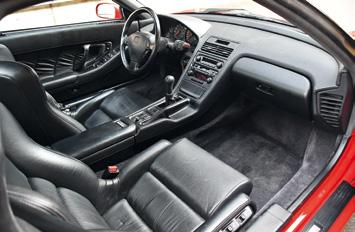
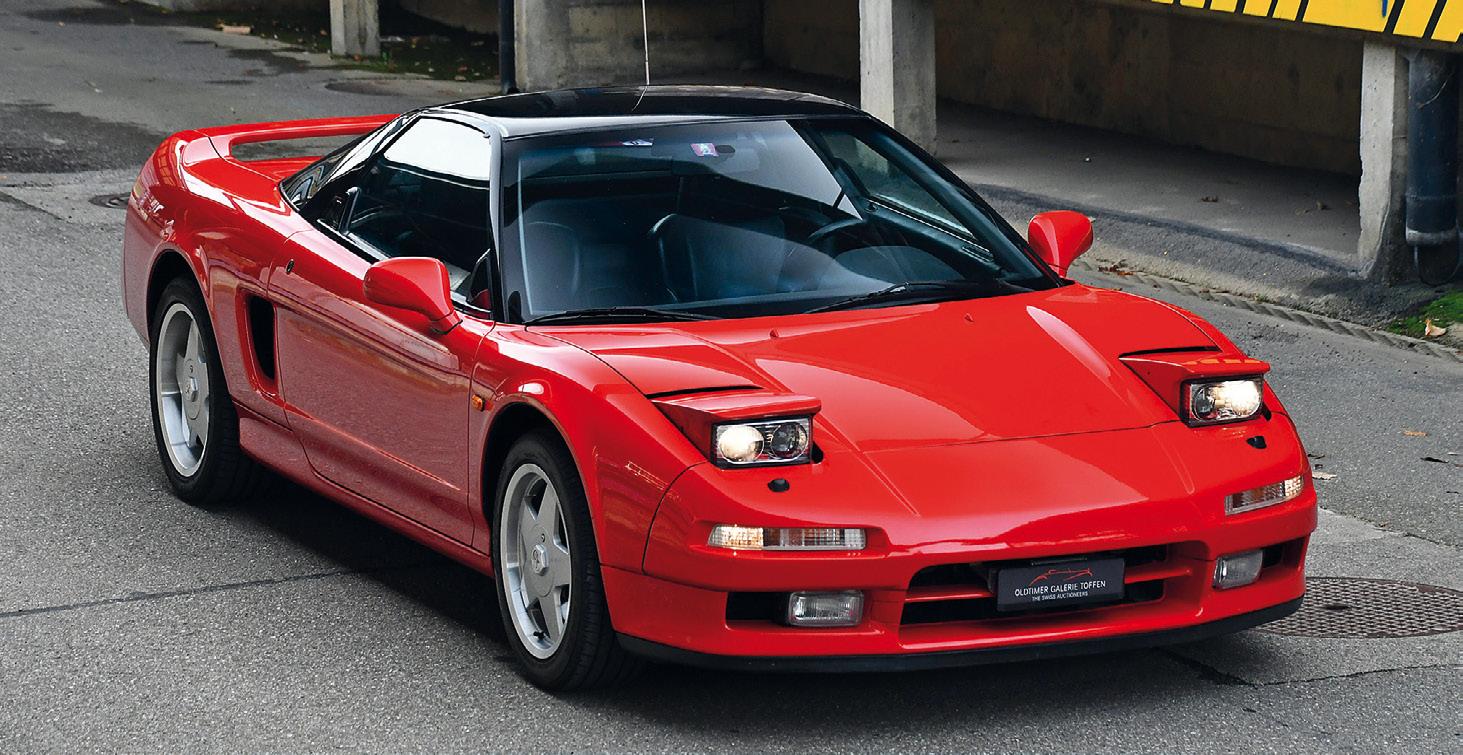

The Honda NSX, presented in 1989 was truly state-ofthe-art. None other than the legendary Ayrton Senna was involved in its development and with a full aluminium construction including the chassis and the coachwork, a DOHC V6 engine with variable valve timing, the car was certainly a technological Tour de force. With electrically adjustable leather covered seats, an air conditioning system and a top of the range HIFI system, the NSX is as luxurious as one could possibly wish for. Today, 30 years after its delivery, this Honda is still a very rapid, agile, modern sports car which can be used on a daily basis and show a clean pair of heels to many Ferraris and other exotica. Two owners have covered a mere 55’000 kilometres with this example which has benefitted from regular maintenance. The last timing belt change has been executed in 2017 at 51’150 kilometres. The 16-inch rims mounted at the front and 17-inch at the rear provide the coupe with a slightly more aggressive stance but the original rims, at 15 and 16 inch respectively, are available. The NSX is in very good original condition and offers a rare chance to experience a fascinating piece of Japanese automotive history coupled to a bit of Senna magic and a generous helping of Formula One know how. The last Veteran MOT was completed in June 2022.
Der 1989 präsentierte Honda NSX war zu seiner Zeit mit allen Raffinessen ausgestattet, die man sich wünschen konnte – die Karosserie und das Fahrwerk sind aus Aluminium, der V6-Motor verfügt über zwei obenliegende Nockenwellen und eine variable Ventilsteuerung, die elektrisch verstellbaren Sitze sind mit Leder bezogen und es fehlt weder an einer Klimaanlage noch an einem Hi-Fi-System. Heute, 30 Jahre nach seiner Auslieferung, ist dieser Honda immer noch ein schneller, handlicher, moderner und alltagstauglicher Sportwagen. Die zwei bisherigen Besitzer haben den schnittigen Japaner nur knapp 55‘000 Kilometer gefahren und stets gut gewartet. Der letzte Zahnriemenwechsel erfolgte 2017 bei 51‘150 Kilometern. Die montierten 16-Zoll Räder vorne-, bzw. 17-Zoll Räder hinten verleihen dem Coupé einen etwas bulligeren Auftritt – die Originalräder (15- bzw. 16-Zoll) sind vorhanden. Der NSX befindet sich in sehr gutem Originalzustand und bietet einem Liebhaber die Möglichkeit ein Stück japanischer Automobilgeschichte und, dank des durch den unvergessenen Ayrton Senna abgestimmten Fahrwerks, Honda Formel 1 Know-how zu erwerben. Die letzte MFK als Veteranenfahrzeug erfolgte im Juni 2022.
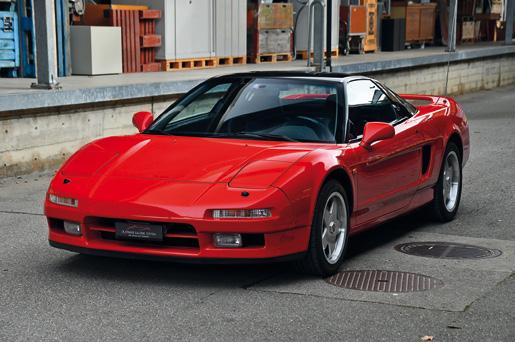

85
Chassis # JHMNA11500T100113
Lot 143 18‘685 cars (1990-2005) V6 2‘976 cc 274 hp at 7‘300/min Estimate CHF 95‘000 - 105‘000
Photos Oldtimer Galerie
Veuillez trouver le descriptif en français sur www.TheSwissAuctioneers.swiss
1996 Aston Martin Vantage V550
Chassis # SCFDAM2S2SBL70119
The Aston Martin Virage is an automobile produced by British luxury automobile manufacturer Aston Martin as a replacement for its V8 models. Introduced at the Birmingham Motor Show in 1988 When compared to the preceding V8, the design was fresh and more modern. The Virage was more similar in design language to the Lagonda than the V8 it replaced. Indeed, the chassis was an evolution of the Lagonda‘s, with a de Dion tube rear suspension, located by triangulated radius rods and a Watts linkage, and a double wishbone unit at the front. To cut costs, many of the less-important pieces came from other companies, as had been the case for Aston Martin automobiles of the past. The sleek headlights and taillights were sourced from the Audi 200 and the Volkswagen Scirocco respectively, while General Motors, Jaguar, and Ford provided the steering column, climate control panel, wing mirrors and dash switches. In fact, Ford had purchased Aston Martin and Jaguar shortly before the Virage debuted and it became the first model to be introduced under the new ownership.
The Virage was a large, heavy car in spite of its allaluminium body, but the 32-valve 5.3 L (5‘341 cc) V8 engine‘s 494 Nm torque elevated its performance to near sports car levels. „Acceleration just never seems to run out“, claimed Sports Car International during a first test. They also praised the „eager and quicker revving“ nature of the 335 PS engine with its Callaway-designed heads and Weber-Marelli fuel injection. „Nothing sounds quite like an Aston V8,“ they concluded. The 1‘790 kg car could attain a topspeed of 254 km/h.
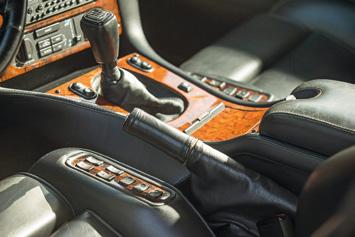
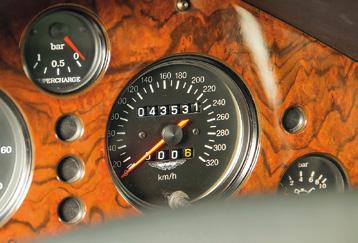
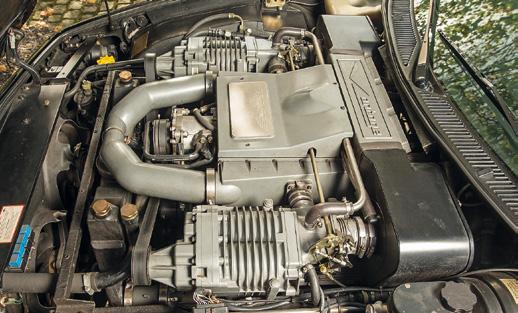
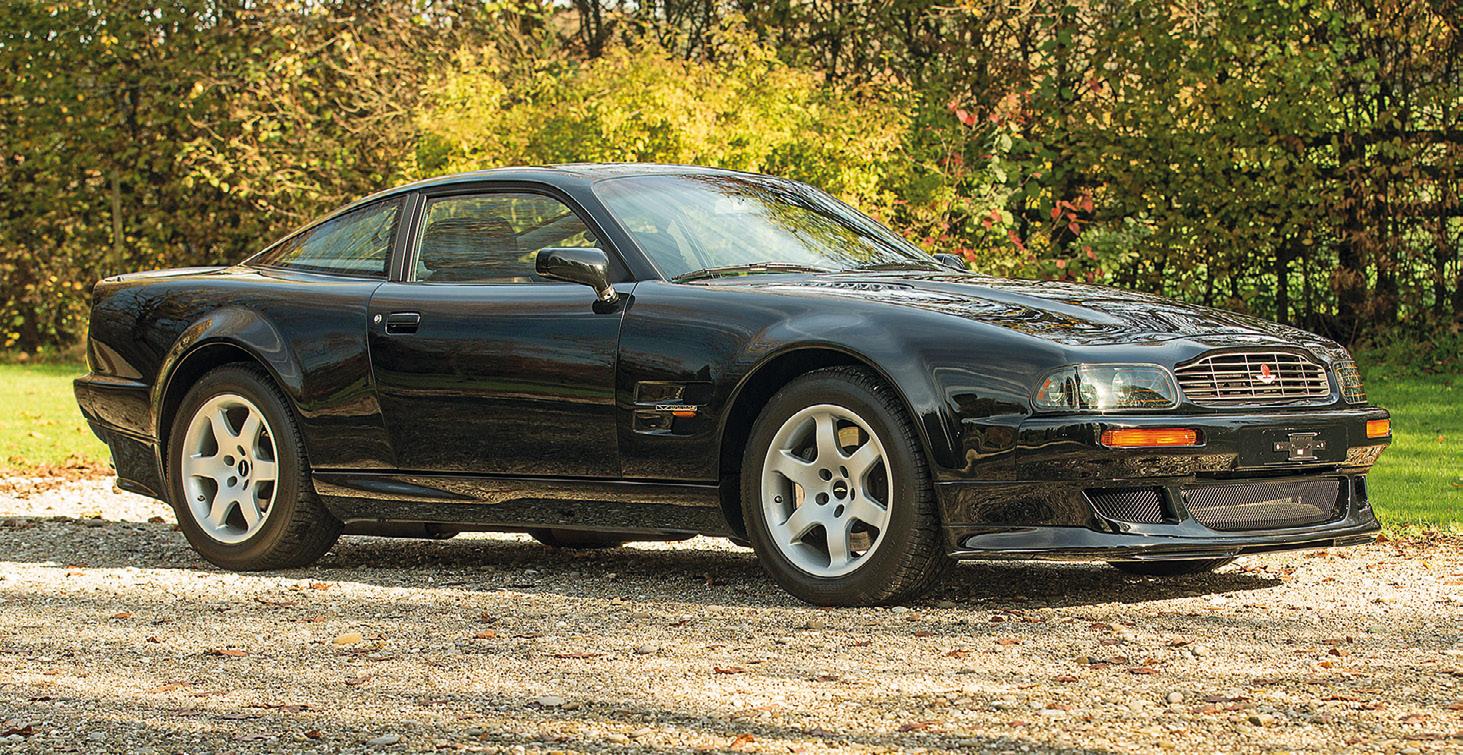
As with many other Aston Martin models, a highperformance Vantage model of the Virage would later

be introduced. First shown at Birmingham in September 1992, the Vantage was produced from 1993 through 2000 and, like many other Aston Vantage models would soon become the only variant available. The Virage name lasted just a few years, with its final descendants inheriting the simple and familiar V8 name.
The Vantage had new styling with only the roof, doors and wing mirrors shared with the Virage. The wing mirrors were later replaced in favour of newly styled wing mirrors exclusive to this model. The Vantage is wider, lower, used four round tail lights, and featured new rear suspension and interior electronics. Like the 6.3, the Vantage used record-sized 362 mm brake discs and 18 inch wheels.
The biggest change to the Vantage was inside the engine compartment. The 5.3 L V8 engine now used twin superchargers. Power output was now 557 PS, and the torque was equally high at 745 Nm at 4‘000 rpm. Top speed was 300 km/h, with acceleration to 97 km/h (60 mph) taking 4.6 seconds. Customers cars could be returned to Works Service starting in 1998 to be converted to V600 specifications, where the engine was upgraded to 608 PS at 6‘200 rpm and 813 Nm of torque at 4‘400 rpm.
86 www.TheSwissAuctioneers.swiss
Lot 144 239 cars Twin supercharged V8 5‘341 cc 557 hp at 6‘500/min Estimate CHF 215‘000 - 235‘000 Story wikipedia.org Photos Daniel Reinhard
With the Vantage V550, introduced in 1992, Aston Martin provided a second lease and a welcome boost in power to the ageing V8 whose design had started in 1965. The 5.3 litre engine was equipped with two Eaton compressors resulting in an impressive 550 hp (with earth-moving torque), which were transmitted to the De Dion rear axle via a 6-speed manual gearbox. The car offered was completed on 31st of October 1995 and delivered to Germany where it was first registered in January 1996. Little of the V550’s history is known until, in 2007, it was acquired, most probably in Monaco, and imported into Switzerland in August 2008, then showing 35’000 kilometres. In the following years the Aston Martin formed part of a Swiss collection and was regularly maintained by Roos engineering. In October 2014, then showing 41’000 kilometres, the powerful GT changed ownership again and was added to the vendor’s collection. As one of only 239 examples built, with matching numbers and now 43’500 kilometres showing, and a complete service booklet, this Vantage V550 is in very good and lovingly maintained original condition. The car will be sold with its last MOT dating from April 2022 and its last service completed in May 2022.
Kilometern, wechselte das Power-Coupé den Besitzer und wurde in die Sammlung des Einlieferers aufgenommen. Als eines von nur 239 gebauten Fahrzeugen, mit Matching-Numbers, gut 43‘500 gefahrenen Kilometern und Serviceheft, präsentiert sich dieser Vantage V550 in sehr gutem und gepflegtem Originalzustand. Das Fahrzeug wird mit der letzten MFK im April 2022 und Service im Mai 2022 verkauft.
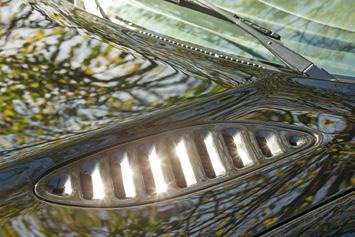


Avec la Vantage V550, lancée en 1992, Aston Martin a offert une augmentation de puissance bienvenue au V8 vieillissant dont la conception avait débuté en 1965. Le moteur de 5,3 litres était équipé de deux compresseurs Eaton, ce qui permettait d‘obtenir une puissance impressionnante de 550 cv (avec un couple de terrassement), transmise à l‘essieu arrière via une boîte de vitesses manuelle à 6 rapports. La voiture proposée a été achevée le 31 octobre 1995 et livrée en Allemagne où elle a été immatriculée pour la première fois en janvier 1996. On connaît peu de choses de l‘histoire de la V550 jusqu‘à ce que, en 2007, elle soit acquise, très probablement à Monaco, et importée en Suisse en août 2008, affichant alors 35‘000 kilomètres. Au cours des années suivantes, l‘Aston Martin a fait partie d‘une collection suisse et a été régulièrement entretenue par Roos engineering. En octobre 2014, affichant alors 41‘000 kilomètres, la puissante GT a de nouveau changé de propriétaire et a été ajoutée à la collection du vendeur. En tant que l‘un des 239 exemplaires construits, avec des numéros correspondants et maintenant 43‘500 kilomètres affichés, et un carnet d‘entretien complet, cette Vantage V550 est en très bon état d‘origine et amoureusement entretenue. La voiture sera vendue avec la dernière expertise datant d‘avril 2022 et son dernier service effectué en mai 2022.
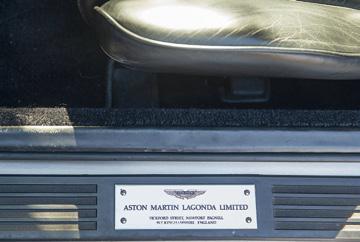

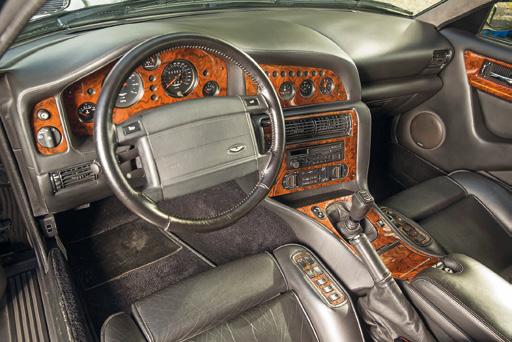

Mit dem 1992 vorgestellten Vantage V550 verhalf Aston Martin dem in die Jahre gekommenen V8 (die Konstruktion des Aggregates begann 1965) noch einmal zu zeitgemässer Leistung. Die 5.3-Liter Maschine wurde mit zwei Eaton-Kompressoren ausgestattet und leistete so stolze 550 PS, welche mittels Sechsgang-Getriebe an die Hinterachse weitergeleitet wurden. Das angebotene Fahrzeug wurde am 31. Oktober 1995 fertiggestellt und nach Deutschland geliefert und im Januar 1996 erstmals zugelassen. Über die ersten Jahre des V550 ist Nichts bekannt, bis er 2007 – scheinbar in Monaco – erworben und im August 2008, mit rund 35‘000 gefahrenen Kilometern, schliesslich in die Schweiz importiert wurde. In den folgenden Jahren wurde der Aston Martin regelmässig durch die Spezialisten der Firma Roos Engineering gewartet. Im Oktober 2014, mit rund 41‘000 gefahrenen
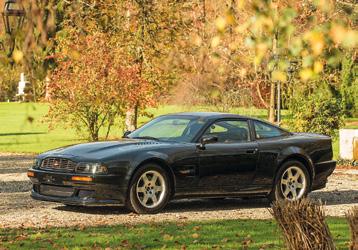

87
1994 Audi-Porsche RS2 Avant


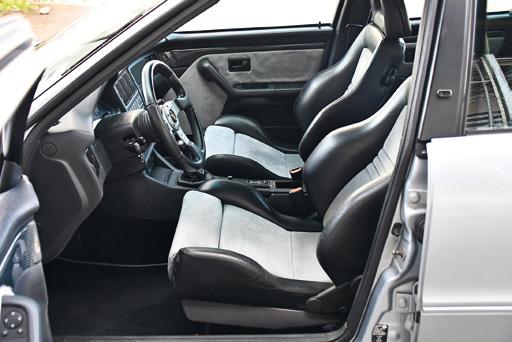
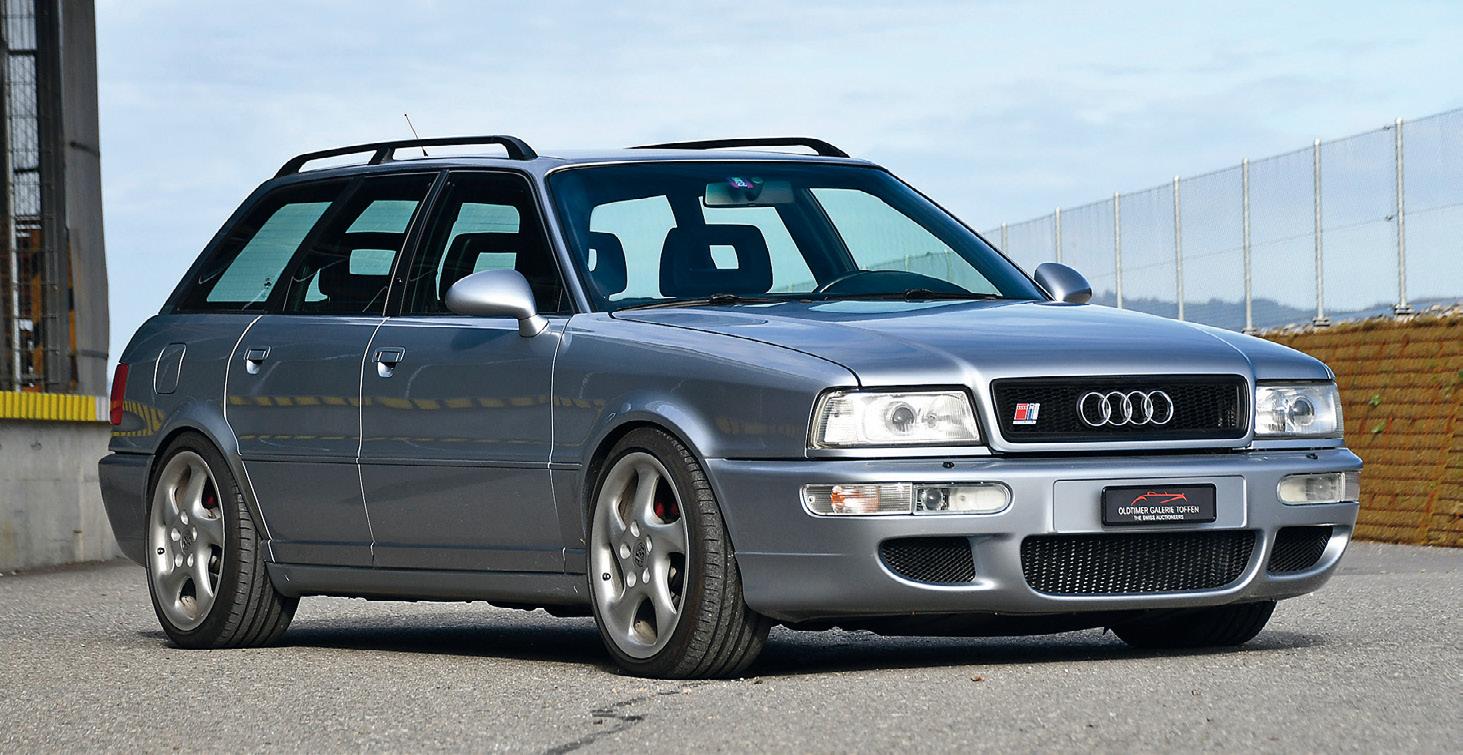 Chassis # WACZZZ8CZRZ000131
Chassis # WACZZZ8CZRZ000131
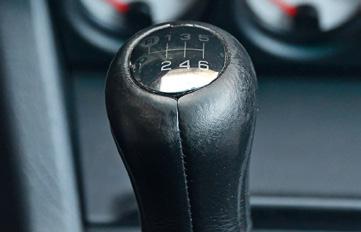
Presented in autumn 1993 at the IAA in Frankfurt the RS2, a coproduction by Audi and Porsche, was not only the then fastest station car in the world but is justifiably considered the granddad off all power station cars so popular today as well, as the eponymous RS-series from Audi. With a turbocharged 2.3 litre 5 cylinder delivering 315 horsepower and a 6-speed manual gearbox driving all four wheels, the Audi was capable of a top speed of 262 kph. Breaking was done with the help of a Porsche breaking system with ABS of course. The example we have on offer, one of only 2’891 RS2 built, was delivered through the Audi works in Ingoldstadt to its first owner from Klosters on the 24th February 1994. He kept the RS2 for 10 years before selling it to the second owner in 2004 with a mileage of 46’000 kilometres. The car then received a sports exhaust system by the tuning companies Sportec resulting in a power increase to 347.9 hp and more than 500 Newtons of torque. Shortly afterwards the third owner took possession of the RS2 and he had an adjustable suspension system from KW installed. In August 2006 at roughly 90’000 kilometres, the turbocharger was replaced. In September 2006 finally, the car was sold to its current owner, a absolute enthusiast of those 5-Cylinder cars. Over the last 16 years the car was cherished and carefully maintained as shown with the complete service booklet. The last cambelt change was completed in March 2021 at 147’606 kilometres. In recent years the headlining was replaced with the original Audi fabric and the roof repainted after a minor hail damage. The Recaro sport seats as well as the entyre interior only show minor signs of use, the engine is running faultlessly and the gearbox shifting as it should. Besides the 18-inch Porsche rims a complete set of original wheels, the original ignition coil cover, the original steering wheel as well as sundry
replacement parts will be handed over with the car. The modified suspension as well as the 18-inch wheels are registered in the car‘s documents and there is a specific permission certificate for the exhaust system. Any future MOT should therefore pose no problems. This Audi-Porsche is in very good, well maintained condition, has now covered 150’800 kilometres and, with the most recent MOT completed in January 2022, will certainly provide a worthy addition to any Porsche or Audi collection.
Der im Herbst 1993 an der IAA in Frankfurt vorgestellte, gemeinsam mit Porsche entwickelte, RS2 Avant war nicht nur der damals schnellste Serienkombi der Welt, sondern auch der Urvater der bis heute beliebten Powerkombi und der Begründer der RS-Baureihen der Ingolstädter. Mit turbogeladenem 2.3-Liter 5-Zylinder leistete der Eiltransporter 315 PS welche mittels 6-Gang Getriebe Audi-typisch an alle 4 Räder weitergeleitet wurden – alles Zutaten für eine Höchstgeschwindigkeit von 262 km/h. Verzögert wurde mittels einer Porsche Bremsanlage und ABS. Das hier angebotene Exemplar des nur 2‘891 mal gebauten RS2 wurde am 24. Februar 1994 – noch vor dem offiziellen Verkaufsstart
88 www.TheSwissAuctioneers.swiss
Lot 145 2‘891 cars turbocharched in-line 5 cyl. 2‘225 cc 315 hp at 6‘500/min Estimate CHF 65‘000 - 75‘000
Photos Oldtimer Galerie
in der Schweiz – durch das Audi Werk in Ingolstadt an den Erstbesitzer aus Klosters übergeben. Dieser hielt dem Kombi für 10 Jahre die Treue, bevor er 2004 mit rund 46‘000 Kilometern zum zweiten Liebhaber wechselte. Dieser liess dem Audi durch die bekannte Firma Sportec ein Stufe 1 Tuning nebst Abgasanlage installieren – das Leistungsdiagramm zeigt stolze 347.9 PS und über 500 Nm Drehmoment. Kurze Zeit später übernahm der dritte Besitzer den RS2 – dieser liess ein KW-Gewindefahrwerk installieren und im August 2006 bei knapp 90‘000 Kilometern ersetzte er den Turbolader. Im September 2006 schliesslich, wechselte der Powerkombi zum letzten Halter, einem absoluten Liebhaber der 5-Zylinder aus Ingolstadt. Während der letzten 16 Jahre wurde der Wagen geliebt und, wie das lückenlose Serviceheft zeigt, pfleglich gewartet. Der letzte Zahnriemenwechsel erfolgte im März 2021 bei 147‘606 km. In den letzten Jahren wurde der Dachhimmel mit originalem Audi Stoff erneuert und das Dach nach einem leichten Hagelschaden neu lackiert. Die Recaro-Sportsitze weisen, wie die gesamte Innenausstattung nur wenig Gebrauchsspuren auf, der Motor läuft einwandfrei und das Getriebe schaltet sich ausgezeichnet. Neben den montierten 18” Porsche Felgen werden ein Satz Originalräder, die originale Zündspulenabdeckung, das originale Lenkrad sowie einige Modellspezifische Ersatzteile mit dem Fahrzeug abgeben. Fahrwerk und 18” Räder sind im Ausweis eingetragen, für die Auspuffanlage existiert ein Beiblatt – eine künftige MFK sollte also keine Probleme bereiten. Dieser Audi-Porsche befindet sich in sehr gepflegtem Zustand, hat 150‘800 Kilometer zurückgelegt und dürfte eine perfekte Ergänzung sowohl in einer Audi- als auch in einer Porsche-Sammlung darstellen.
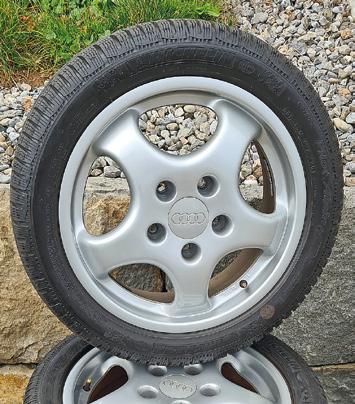
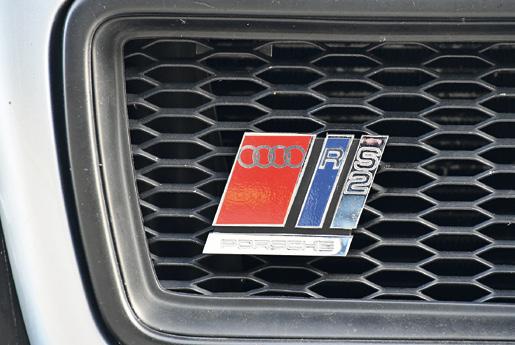
de niveau 1 ainsi qu‘un système d‘échappement par la célèbre entreprise Sportec - le diagramme de puissance indique fièrement 347.9 cv et plus de 500 Nm de couple. Peu de temps après, le troisième propriétaire a pris possession de la RS2 et a fait installer un système de suspension réglable de KW. En août 2006, à environ 90‘000 kilomètres, le turbocompresseur a été remplacé. Enfin, en septembre 2006, la voiture a été vendue à son propriétaire actuel, un passionné absolu de ces voitures à 5 cylindres. Pendant les 16 dernières années, la voiture a été chérie et soigneusement entretenue, comme le montre le carnet d‘entretien complet. Le dernier changement de courroie a été effectué en mars 2021 à 147‘606 kilomètres. Ces dernières années, la garniture de toit a été remplacée par le tissu Audi d‘origine et le toit a été repeint après un dommage mineur dû à la grêle. Les sièges sport Recaro ainsi que tout l’ensemble de l‘intérieur ne montrent que des signes mineurs d‘utilisation, le moteur fonctionne sans problème et la boîte de vitesses passe les vitesses comme il se doit. Outre les jantes Porsche de 18 pouces, un jeu complet de roues 17 pouces d‘origine, le cachebobine d‘allumage d‘origine, le volant d‘origine ainsi que diverses pièces de rechange seront remis avec la voiture. La suspension modifiée ainsi que les jantes de 18 pouces sont enregistrées dans les documents de la voiture et il existe un certificat d‘autorisation spécifique pour le système d‘échappement. Un futur contrôle technique ne devrait donc poser aucun problème. Cette Audi-Porsche est en très bon état et bien entretenue, elle a maintenant parcouru 150‘800 kilomètres et, avec la dernière expertise passée en janvier 2022, elle sera certainement un ajout digne de ce nom à toute collection Porsche ou Audi.

Présentée à l‘automne 1993 au salon IAA de Francfort, la RS2, une coproduction d‘Audi et de Porsche, n‘était pas seulement le break le plus rapide du monde à l‘époque, mais elle est considérée à juste titre comme le grand-père de tous les breaks puissants si populaires aujourd‘hui, comme la série RS éponyme d‘Audi. Avec un 5 cylindres de 2,3 litres turbocompressé développant 315 chevaux et une boîte de vitesses manuelle à 6 rapports entraînant les quatre roues, l‘Audi était capable d‘atteindre une vitesse de pointe de 262 km/h. Le freinage se faisait à l‘aide d‘un système de freinage Porsche avec ABS bien sûr. L‘exemplaire que nous proposons, l‘un des 2‘891 RS2 construits, a été livré par l‘usine Audi d‘Ingoldstadt à son premier propriétaire de Klosters le 24 février 1994. Il a gardé la RS2 pendant 10 ans avant de la vendre au deuxième propriétaire en 2004 avec un kilométrage de 46‘000 kilomètres. Celui-ci a fait installer sur l‘Audi un tuning
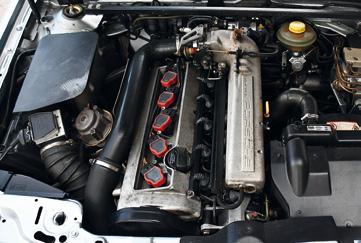



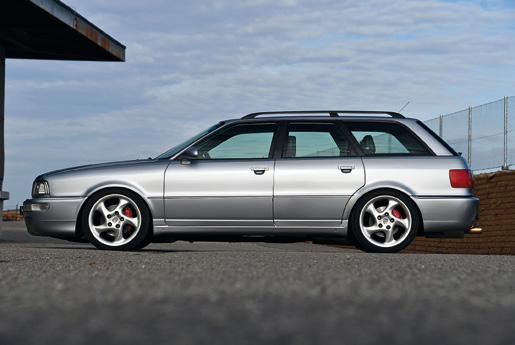
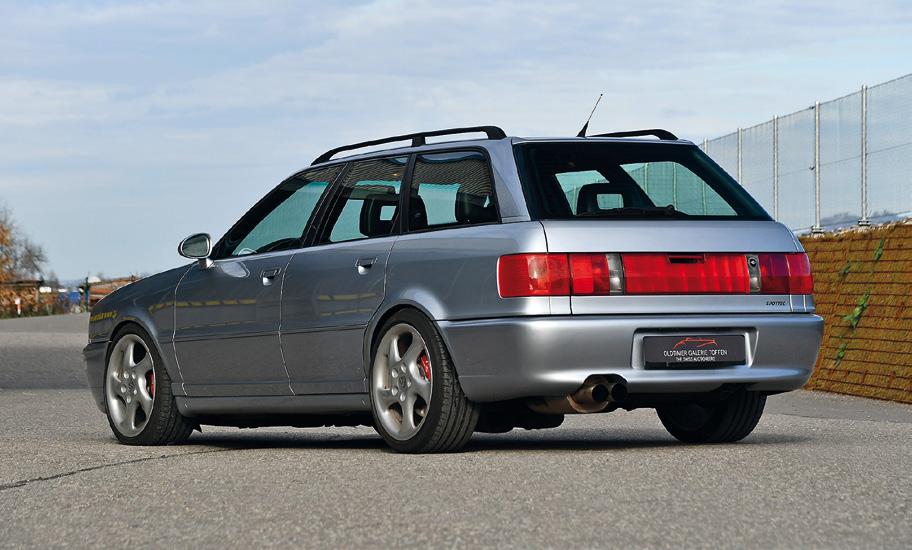
89
1984 Aston Martin Lagonda
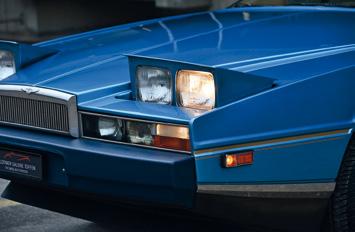
 Chassis # SCFDL01S9ETL13354
Chassis # SCFDL01S9ETL13354
Designer William Towns’ extraordinary 1976 Lagonda sedan is just about the most polarizing collectible car you can buy. Its sharp-angled origami styling is a loveit-or-hate-it proposition, and if you fall for one and buy it, you love the car’s look and commanding presence, but also may grow to hate both the car and yourself when the electronics go south, as they often do.
Aston Martin had flirted with the Lagonda nameplate now and then ever since the acquisition of the company by David Brown in 1947. He followed up his £20‘000 Aston Martin purchase with a £50‘000 gamble on Lagonda shortly after, gaining the services of WO Bentley and his new 2½ -liter, DOHC 6-cylinder engine. A total of 550 Lagonda dropheads and sedans were built between 1946-53, a further 430 between 1953-56, 55 between 1961-64 and half a dozen in the early 1970s. All were fairly frumpy versions of the current Aston Martins of the time.
William Towns had penned the squared-off DBS of 1969 and his instructions were to come up with something edgy. Harris Mann’s wedge shapes were all the rage, and Towns one-upped Mann with the razorsharp Lagonda that became the hit of the 1976 Earls Court Motor Show. It was powered by Tadek Marek’s DOHC, 5.3-liter V-8 engine, which developed 280 hp and drove through a Chrysler 3-speed automatic transmission. There was little brightwork, the headlights popped up above a thin line park lights and the grille was only about 6 inches tall. Early cars had carburetors, but later ones had fuel injection. The body was refined in 1988 with the corners rounded off and the pop-up headlights abandoned. Inside, the interior was wool carpet, burled wood and hand-stitched leather, but there was not much
room inside considering the overall size of the car. Electronic gremlins were a persistent problem. Early cars used LED readouts in the digital dash. They were hard to read in daylight, and didn’t work most of the time, anyway. Later cars had CRT readouts, which cost several thousand dollars to replace, when they too failed. Push-button stalks on the steering column were equally problematic.
In their day, Lagondas were the darlings of the nouveau riche, pop stars and Arab sheiks, who were inclined to colors like candy apple red with a lime green vinyl top, white puffy leather inside, and gold-plated mag wheels. At least the sheiks could cope with 8 mpg. Some thought the cars were vulgar, and they remain divisive automobiles even today. A total of 645 Aston Martin Lagondas were sold in about 11 years, but a small percentage of those are roadworthy today.
On introduction of the Aston Martin Lagonda Series 2 in October 1976, the car created quite a sensation. Not only was the external styling absolutely breathtakingly outrageous, the Lagonda also sported a state-of-theart interior with its touch sensitive switches equipped
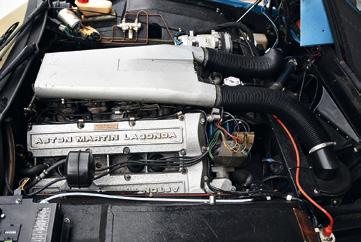


90 www.TheSwissAuctioneers.swiss
Lot 146 645 cars V8 5‘341 cc 280 hp at 5‘000/min Estimate CHF 105‘000 - 125‘000 Story hagerty.com Photos Oldtimer
Galerie
digital dashboard. This very complex system proved somewhat temperamental and delayed a series production of the car until autumn 1978. The well-known Tadek Marek designed 5.3 litre DOHC V8 from the DBS was coupled to a Chrysler 3-speed automatic gearbox and provided brisk if not exactly rapid progress. A list price of 130’000 Swiss francs placed the car firmly in the realm of Rolls Royce Silver Shadow and Bentley T, but of course offered a rather more dramatic entrance. This example, built in 1984 was delivered by Universal Motors in Riyad but registered in Switzerland already on the 15th May 1985. After two owners, the car, then showing 28’000 kilometres, was taken over by the vendor in March 2001. He immediately had the blue velours interior (quite popular in the Arab part of the world) replaced with the finest parchment coloured Connolly leather. At the same time the blue vinyl covering of the roof was replaced by a proper Everflex material (as used by Rolls-Royce) and the same material was equally used to cover the front and rear bumpers. The Aston Martin has since been enthusiastically driven and has always enjoyed loving care and maintenance. Receipts for maintenance and restoration work exceeding 75’000 Swiss francs are available. As one of only 645 examples built, this elegant Aston Martin Lagonda is in very good and wellmaintained condition and has covered a guaranteed 59’000 kilometres only. It will be sold to a new owner with the last Veteran MOT completed in June 2021.
Als der Aston Martin Lagonda Series 2 im Oktober 1976 der Presse vorgestellt wurde erregte die futuristisch gestaltete Limousine enormes Aufsehen. Nicht nur war die Limousine flach und kantig, nein auch im Innenraum wurde mit Neuheiten wie einem digitalen Armaturenbrett und Sensortasten geglänzt - diese aufwändige Fahrzeugelektronik verzögerten aber den Start der Serienproduktion bis zum Herbst 1978. Der aus dem DBS V8 bekannte 5.3-Liter Motor wurde mit einer von Chrysler gelieferten 3-Stufen Automatik gekoppelt und verhalf der Limousine zu durchaus sportlichen Fahrleistungen. Mit einem damaligen Listenpreis von CHF 130‘000.- rangierte der Aston Martin in derselben Preisregion wie der Rolls-Royce Silver Shadow und der Bentley T, war aber um einiges moderner und auffälliger. Dieses Exemplar mit Baujahr 1984 wurde durch Universal Motors in Riad ausgeliefert, doch bereits am 15. Mai 1985 erstmals in der Schweiz zugelassen. Nach zwei Besitzern wurde der Wagen im März 2001, mit damals rund 28‘000 Kilometern auf der Uhr, vom Einlieferer übernommen. Dieser liess umgehend die, für den arabischen Raum typische, blaue Veloursausstattung mit feinstem champignonfarbenen Connolly Leder neu beziehen. Zudem wurde die blaue Vinylbespannung des Daches durch eine solche in Everflex ersetzt, wobei auch die beiden Stossstangen für eine noch elegantere Erscheinung mit demselben Material überzogen wurden. Seither wurde der Aston Martin gerne gefahren und stets gepflegt. Belege für Unterhalt und Restaurierungen für über CHF 75‘000.- sind vorhanden. Als eines von nur 645 gebauten Fahrzeugen, befindet sich dieser elegante Aston Martin Lagonda in sehr gutem und gepflegtem Zustand, hat garantiert erst 59‘000 Kilometer gefahren, und wird mit der letzten MFK als Veteranenfahrzeug im Juni 2021 an einen neuen Besitzer übergeben.

Lors du lancement de l‘Aston Martin Lagonda Série 2 en octobre 1976, la voiture a fait sensation. Non seulement son style extérieur était absolument époustouflant, mais la Lagonda arborait également un intérieur ultramoderne avec son tableau de bord numérique équipé de commutateurs tactiles. Ce système très complexe s‘est révélé quelque peu capricieux et a retardé la production en série de la voiture jusqu‘à l‘automne 1978. Le célèbre V8 5.3 litres à double arbre à cames en tête de la DBS, conçu par Tadek Marek, était couplé à une boîte de vitesses automatique Chrysler à 3 rapports et permettait une progression vive, mais pas vraiment rapide. Un prix catalogue de 130’000 francs suisses plaçait fermement la voiture dans le royaume des Rolls Royce Silver Shadow et Bentley T, mais offrait bien sûr une entrée un peu plus spectaculaire. Cet exemplaire, construit en 1984, a été livré par Universal Motors à Riyadh mais enregistré en Suisse le 15 mai 1985 déjà. Après deux propriétaires, la voiture, qui affichait alors 28‘000 kilomètres, a été reprise par le vendeur en mars 2001. Il a immédiatement fait remplacer l‘intérieur en velours bleu (très populaire dans la partie arabe du monde) par le plus beau cuir Connolly de couleur champignon. Dans le même temps, le revêtement en vinyle bleu du toit a été remplacé par un matériau Everflex approprié (utilisé par Rolls-Royce) et le même matériau a également été utilisé pour recouvrir les pare-chocs avant et arrière. L‘Aston Martin a depuis été conduite avec enthousiasme et a toujours bénéficié d‘un entretien et de soins attentifs. Les reçus pour les travaux d‘entretien et de restauration dépassant 75‘000 francs suisses sont disponibles. Cette élégante Aston Martin Lagonda, l‘un des 645 exemplaires construits, est en très bon état, bien entretenue, et n‘a parcouru que 59‘000 kilomètres garantis. Elle sera vendue à un nouveau propriétaire la dernière expertise vétéran effectuée en juin 2021.
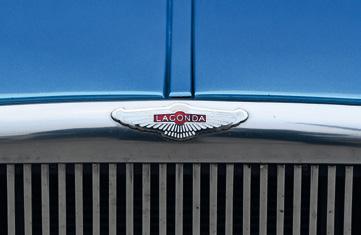


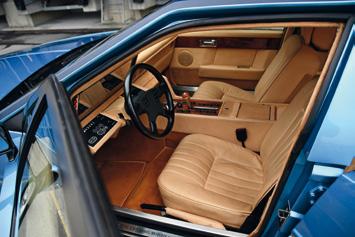
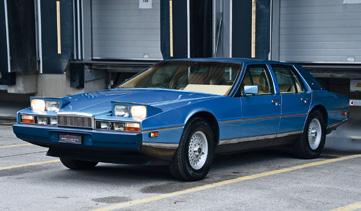
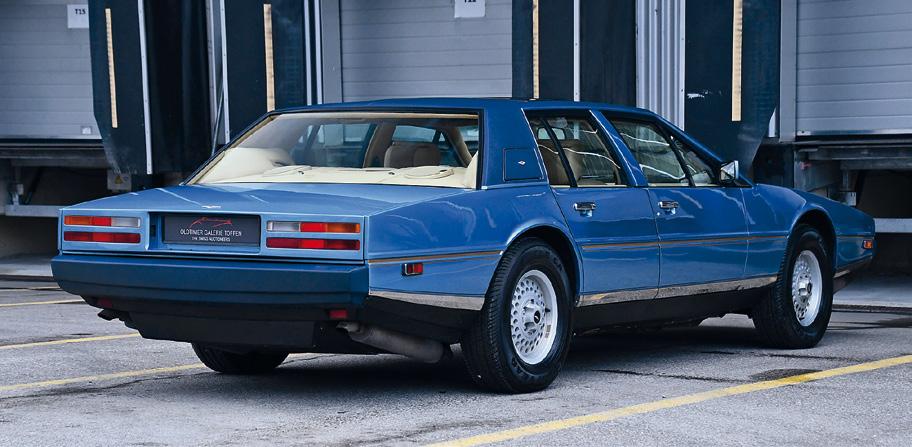

91

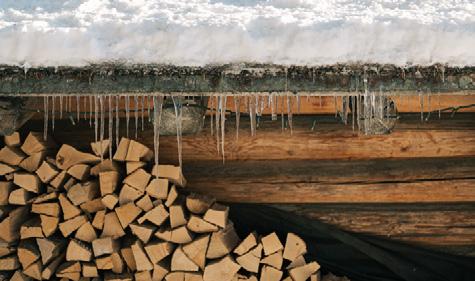

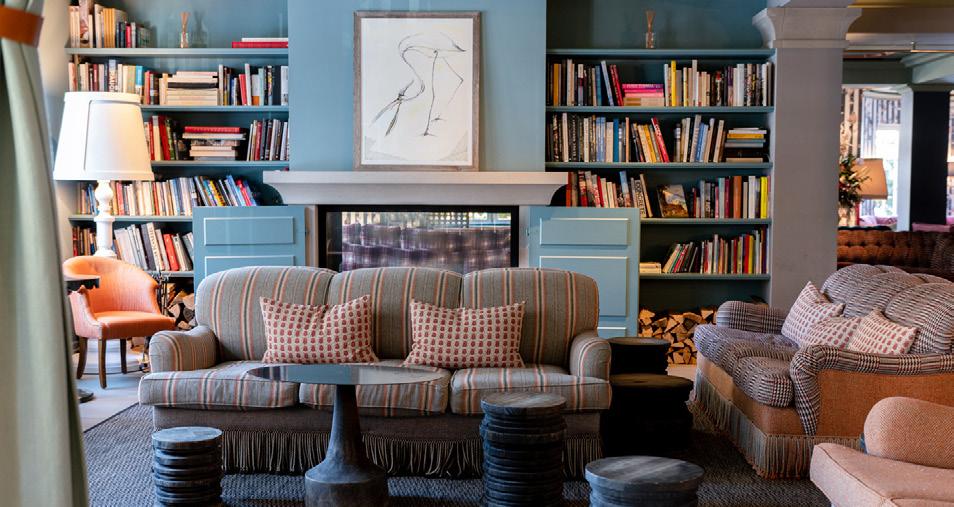


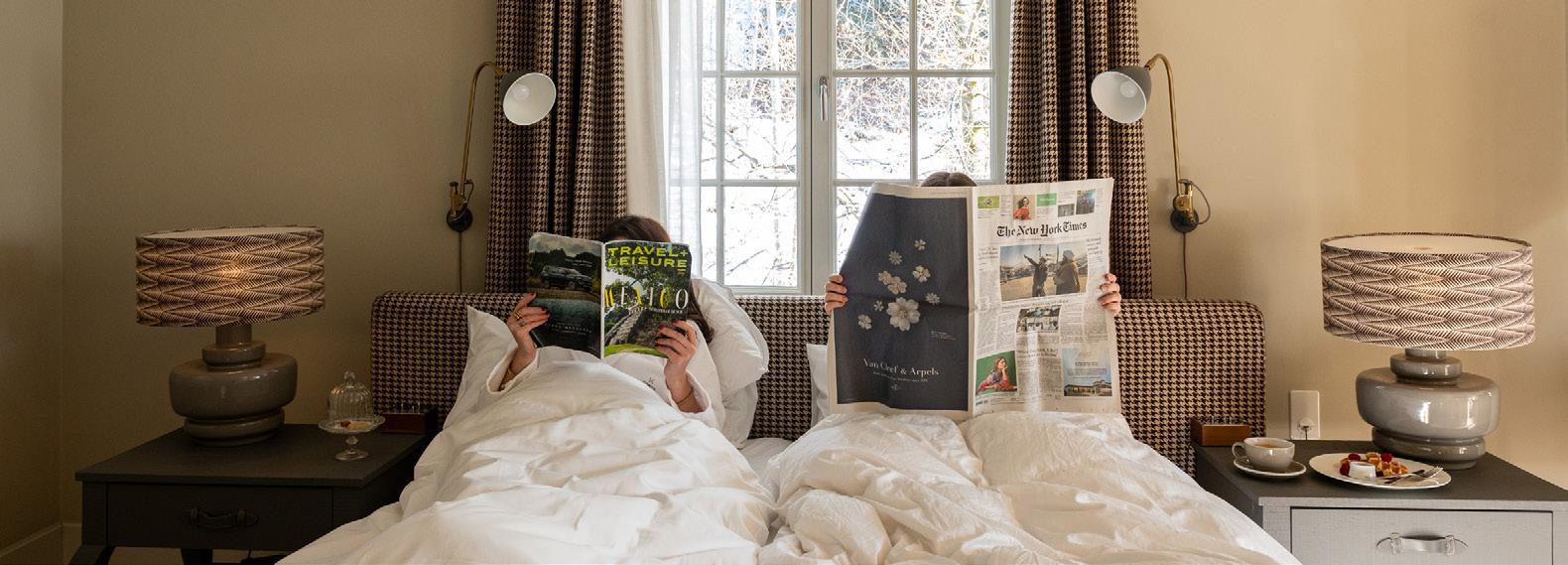





92 www.TheSwissAuctioneers.swiss
1988 Rolls-Royce Corniche II Convertible
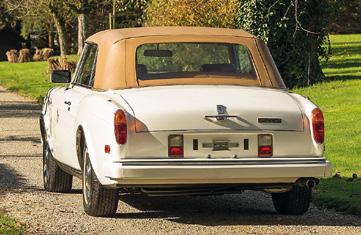
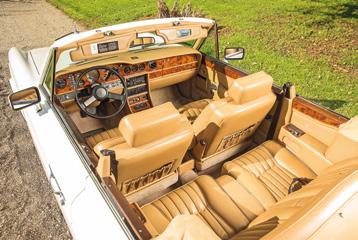


The majority of the 1’226 Corniche II cars built were exported to the USA, including this example. In November 1988, the beautiful cabriolet was handed over to the writer Boris Schreiber by the Carriage House Motor Cars in New York. After Schreiber’s passing in 2008, the car remained with the family and was eventually imported into Switzerland, at the time showing 16’000 miles. After arrival on our shores the Corniche received a thorough makeover costing around 50,000 Swiss francs with Bentley Geneva. In February 2014, the Rolls Royce was finally added to the vendor’s family collection. In susequent years the elegant cabriolet was used sparsely but maintained as required as documented with a number of maintenance receipts. In 34 years, the car has only covered 17’900 miles and is in very good condition, ready and perfectly suited to be thoroughly enjoyed during future summer days. The last Veteran MOT was completed in October 2019 and the most recent service was completed in May 2020, barely 100 miles ago.
Wie so viele der 1‘226 gebauten Corniche II, wurde dieser Rolls-Royce in die USA ausgeliefert. Im November 1988 wurde das schöne Cabriolet durch Carriage House Motor Cars in New York an den Schriftsteller Boris Schreiber übergeben. Auch nach Schreibers Tod 2008 verblieb der
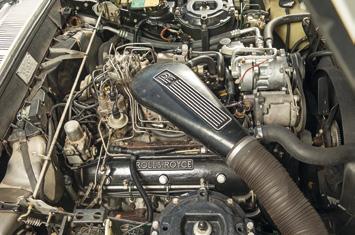
Wagen in der Familie und wurde 2012 mit damals erst 16‘000 gefahrenen Meilen mit in die Schweiz gebracht. Hier angekommen erhielt der Corniche für rund CHF 50‘000.- eine umfangreiche Aufbereitung durch Bentley Genf. Im Februar 2014 schliesslich, fand der Rolls-Royce in der Sammlung der Einliefererfamilie sein bisher letztes zuhause. In den folgenden Jahren wurde das elegante Cabriolet nur wenig gefahren jedoch, wie die vorhandenen Unterhaltsbelege zeigen, stets gut gewartet. In 34 Jahren hat das Fahrzeug nur gerade 17‘900 Meilen gefahren und befindet sich in sehr gutem Zustand, perfekt um damit die kommenden Sommertage zu geniessen. Die letzte MFK als Veteranenfahrzeug erfolgte im Oktober 2019 und der letzte Service wurde im Mai 2020, vor nicht einmal 100 Meilen, durchgeführt.
La majorité des 1‘226 Corniche II construites ont été exportées aux Etats-Unis, y compris cet exemple. En novembre 1988, le magnifique cabriolet a été remis à l‘écrivain Boris Schreiber par la Carriage House Motor Cars de New York. Après le décès de Schreiber en 2008, la voiture est restée dans la famille et a finalement été importée en Suisse, affichant à l‘époque 16‘000 miles. Après son arrivée sur nos côtes, la Corniche a reçu un service complet coûtant environ 50‘000 francs suisses chez Bentley Genève. En février 2014, la Rolls Royce a finalement rejoint la collection familiale du vendeur. Au cours des années suivantes, l‘élégant cabriolet a été peu utilisé mais entretenu comme il se doit, comme en témoignent de nombreux reçus d‘entretien. En 34 ans, la voiture n‘a parcouru que 17‘900 miles et est en très bon état, prête et parfaitement adaptée pour être pleinement appréciée lors des futurs jours d‘été. La dernière expertise vétéran a eu lieu en octobre 2019 et le service le plus récent a été effectué en mai 2020, il y a à peine 100 miles.

93
Chassis # SCAZD02A1JCX23574
Lot 147 1‘226 cars V8 6‘747 cc 215 hp at 4‘300/min Estimate CHF 80‘000 - 100‘000
Photos Daniel Reinhard
1939 Talbot-Lago T 150 C Competition
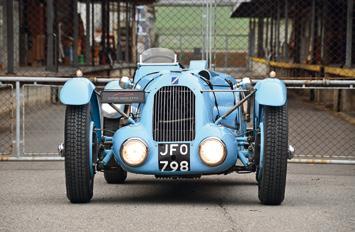

Chassis # 90086
The Great Depression of the 1930s had a devastating effect on many businesses, and for the French Talbot factory in Suresnes outside Paris, crippled their financial prospects. Among the reasons for its demise, were the haphazard technological developments, outdated styles, and a dizzying array of models. Depleted of liquidity by the end of 1933. The banks closed the company credit line and the managing director Owen Clegg cabled SunbeamTalbot in London that Talbot in France was facing closure and liquidation. An individual named Anthony Lago was sent to France in a last-ditch effort to save the ailing company. Miraculously, he succeeded. Superfluous model variations were dropped, engines and drivetrains were improved, the entire Talbot line was revamped, and the Wilson pre-selector gearbox - for which he held the patents - was introduced to the line.
Anthony Lago was an Italian trained engineer and, after serving in the Italian Army where he rose to the rank of major during World War I, began his automotive career selling Isotta-Fraschinis in London. Up to that time, the Isotta-Fraschini was the finest Italian car ever produced, with world-class craftsmanship, style, and engineering. This quality and attention to detail made a lasting impression on Lago and would be a hallmark of his career. Major Lago later worked in a series of automotive engineering apprenticeships throughout London, including Sunbeam. While working at Wilson, he had assisted in the final development of the preselector gearbox, later leading to the acquisition of foreign distribution rights to the Wilson gearbox. Along with using it in his own cars, other firms such as Daimler, Alvis, Crossley, Lanchester, MG, Invicta, Standard, Armstrong-Siddeley, Isotta-Fraschini, and Talbot were using Wilson gearboxes. With a passion and fascination for motorsports, Anthony Lago accepted a position on the Armstrong-Siddeley
works team in 1932 and competed at that year‘s Alpine Trials. Later in the year, he joined the ailing SunbeamTalbot-Darracq firm. From there he was sent to France, and soon the Rootes company acquired the English side of Sunbeam-Talbot-Darracq, and Lago, who had acquired considerable financial support, assumed control of the French Talbot concern.
An engineer named Walter Brecchia was hired by Lago and together they created the first Talbot-Lago based on a Talbot-Darracq three-liter Type K78. From there, using the seven main bearing six-cylinder K78 block, displacement was increased to four liters, and a new cylinder head was added to improve volumetric efficiency and breathing. The hemispherical head design had valve gears actuated by a low set camshaft with crossed pushrods acting through both long and short rocker arms. With the help of twin Solex carburetors, the new six-cylinder unit developed 140 horsepower at 4‘200 RPM.

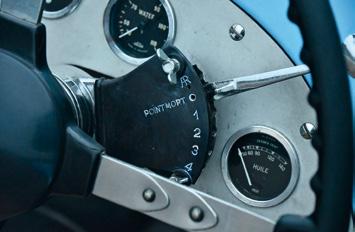

94 www.TheSwissAuctioneers.swiss
Lot 148 one of a kind in-line 6 cylinder 3‘996 cc 152 hp at 3‘900/min Estimate CHF 300‘000 - 400‘000
conceptcarz.com
With solid engineering footing, Lago was able to persuade French racing great René Dreyfus to manage his new Talbot-Lago race team, resulting in all three TalbotLagos finishing in the top ten at the 1936 French Grand Prix at Montlhéry, even contesting the Bugattis for top
Story
Photos Oldtimer Galerie
positions before mechanical problems forced the slow near the ned.

The following year, at the French Grand Prix, TalbotLagos placed first, second, third, and fifth. Additional victories followed, including at Tourist Trophy races at Donnington Park, and a first place in the 1938 Monte Carlo Rally. They scored many class victories against much more powerful opponents, relying on durability and fuel economy, and proving the old racing adage ‚to finish first, first you must finish‘.
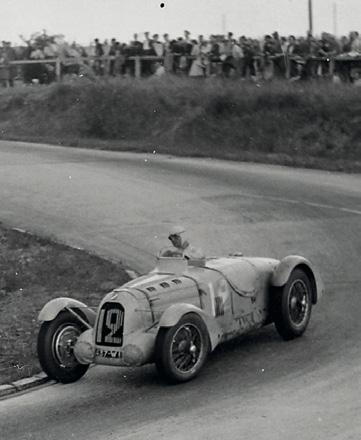

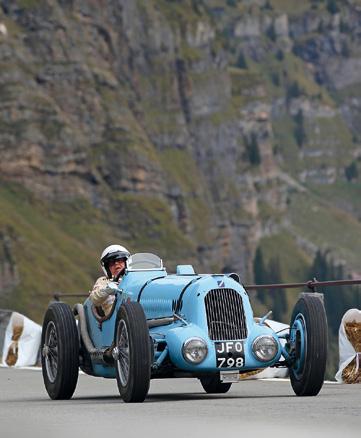
gaser. Nachdem der Wagen 1995 fertiggestellt war, wurde er oft durch Robert Heelis, dessen Sohn Toby und Peter Swete bei historischen Anlässen wie Le Mans Historique, Spa Francorchamps, Brooklands, Silverstone, Donington Park und anderen mehr eingesetzt. 2007 schliesslich, wurde der Talbot-Lago von der Familie des Einlieferers erworben, in die Schweiz importiert und hier zugelassen. Auch der neue Besitzer nützte den T 150 unter anderem für die Teilnahme am Klausenrennen Memorial 2013.
Der tolle Renner befindet sich in gutem bis sehr gutem Zustand, die Karosserie weist eine leichte Patina auf, der Motor funktioniert einwandfrei und das Wilson Vorwählgetriebe schaltet schnell und gut. Dieser Rennwagen mit Strassenzulassung wird mit einem FIA-HTP Wagenpass vom Juni 2017 und der letzten MFK im Mai 2022 an einen neuen Besitzer übergeben.
This beautiful racing car started life as a long wheelbase saloon. In around 1990, the chassis with its matching numbers engine was acquired by Roy Sevier from Belgium and marque specialist Bill Barrett was commissioned to build an exact replica of the 1937 works racing car. To be able to fabricate an accurate copy, Ron Smith’s winning car of the 1937 French Grand Prix was disassembled, allowing all the necessary measurements to be taken. The chassis was shortened to T150 C dimensions, the track adapted and an exact copy of Ron Smith’s racing car coachwork was built. The only deviation from the original was the installation of a hydraulic breaking system from a post war Talbot together with a choke-mechanism for the carburettors. After completing the car in 1995, it was regularly driven in historic racing at Le Mans historic, Spa Francorchamps, Brooklands, Silverstone, Donington Park and others by Robert Heelis, his son Toby and Peter Swete. In 2007 finally, the Talbot Lago was acquired by the vendor‘s family and imported and registered in Switzerland. The new owners continued competing with the T150, among others entering it at the Klausenrennen Memorial in 2013. The great and impressive racer is in good to very good condition with the coachwork showing a light patina, and the engine as well as the Wilson preselector gearbox are working perfectly. This racing car with a road registration (!) will be sold with a FIA-HTP Passport issued in June 2017 and its last MOT dating from May 2022.
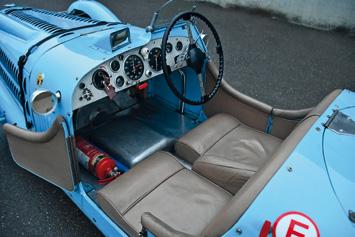


Dieser wunderschöne Rennwagen startete sein Leben als Limousine mit langem Radstand. Circa 1990 wurde das Chassis mit seinem Matching-Numbers Motor von Roy Sevier aus Belgien gekauft und anschliessend zum Markenspezialisten Bill Barrott gebracht, um daraus eine Replica des 1937er Werksrennwagens zu bauen. Um eine möglichst genaue Kopie anfertigen zu können wurde Ron Smith’s Siegerfahrzeug des 1937er Grand Prix von Frankreich zerlegt und vermessen. Das Chassis wurde auf T 150 C Abmessungen eingekürzt, die Spurweite wurde angepasst, und es wurde eine exakte Kopie der Karosserie von Smith’s Rennwagen hergestellt. Die einzigen Änderungen gegenüber dem Original waren der Einbau einer hydraulischen Bremsanlage aus einem Nachkriegs-Talbot und die Montage eines Choke-Mechanismus für die Ver-
Cette magnifique voiture de course débute sa vie en tant que berline à empattement long. Vers 1990, Roy Sevier a acquis le châssis et le moteur au numéros correspondant en Belgique. Bill Barrett, spécialiste de la marque, a été chargé de construire une réplique exacte de la voiture de course de 1937. Pour pouvoir fabriquer une copie exacte, la voiture gagnante du Grand Prix de France 1937 de Ron Smith a été démontée, ce qui a permis de prendre toutes les mesures nécessaires. Le châssis a été raccourci aux dimensions de la T150 C, la piste adaptée et une copie exacte de la carrosserie de la voiture de course de Ron Smith a été construite. La seule déviation par rapport à l‘original était l‘installation d‘un système de freinage hydraulique provenant d‘une Talbot d‘après-guerre, ainsi qu‘un mécanisme de starter pour les carburateurs. Après avoir terminé la voiture en 1995, elle a été régulièrement conduite dans des courses historiques au Mans historique, à Spa Francorchamps, Brooklands, Silverstone, Donington Park et autres par Robert Heelis, son fils Toby et Peter Swete. En 2007 enfin, la Talbot Lago a été acquise par la famille du vendeur, importée et enregistrée en Suisse. Les nouveaux propriétaires ont continué à concourir avec la T150, l‘inscrivant entre autres au Mémorial de Klausenrennen en 2013. Ce superbe bolide est en bon à très bon état, la carrosserie présentant une légère patine, et le moteur ainsi que la boîte de vitesses à présélecteur Wilson fonctionnent parfaitement. Cette voiture de course avec une immatriculation routière (!) sera vendue avec un passeport FIA-HTP de juin 2017 et la dernière expertise datant de mai 2022.
95
Communication Technology from a single source
Kilchenmann AG stands for many years of expertise in the field of media and communication technology coupled with a proactive approach focussing on partnership. Benefit from customised solutions from a single source for all your communication challenges. www.kilchenmann.ch

Kilchenmann International AG is your partner for Global Solutions in Media and Communication Technology. We are an international provider for Pro Audio, Visual and Collaboration Technology; we complement your IT and offer services from a single source with the highest and most consistent quality – worldwide. We manage the deployment and the operation of your systems with Swiss Quality and Swiss Precision. www.kilchenmann.ch/international

96 www.TheSwissAuctioneers.swiss
Berne | Basel | Lausanne | Saint-Gall | Zurich
·
TERMS AND CONDITIONS OF AUCTION
Any participation in our auction is the recognition and unconditional acceptance of the present Terms & Conditions.
1. BIDS
· Placing a bid corresponds to a binding offer. Bidders remain tied to their bid until the same is either outbidden or rejected by the auction’s management. The auction’s management is entitled to reject bids of unknown parties.
· Individuals who are not present may communicate their bids in writing to the auction’s management. Suchlike bids are regarded highest bids without any premiums, VAT, and/or tariffs. Any changes to bids submitted in writing must be in writing, too, and have to be submitted no later than the night before the auction. Bidding by telephone is also possible. If you request to place your bids in writing or by telephone, please make use of the respective form provided on the auction catalog’s last page!
· Online bidding is possible on www.invaluable.com and www.swissauctioncompany.com, please register in time on the relevant site!
2. AUCTION ITEMS
ITEMS ARE OFFERED AND SOLD ON BEHALF AND ACCOUNT OF THE CONSIGNOR OR OF THE COMPANY‘S OWN STOCK!
· Neither Oldtimer Galerie International GmbH (OG) nor the sellers assume any liabilities regarding age, origin, state, and quality of the items offered and sold within the scope of the auction. Items are sold in their state as of the time of their acceptance. Unless explicitly agreed otherwise, mileages are regarded to be free from any guarantee.
· For post auction sales the terms and conditions of auction are also applied.
Unless expressly stated otherwise, all items are to be inspected within the scope of the exhibition preceding the auction and will be published in good time on our website www.oldtimergalerie.ch.
It provides the opportunity of gaining information and insight on their respective state and value.
· Item descriptions are based on our most recent state of information and the best of our knowledge and belief. OG assumes no liabilities whatsoever for any obvious and/or latent defects.
· All vehicles that are offered as from Motor Vehicle Control Office (MFK) and are not yet inspected at the time of acceptance will be checked after the auction on account of the seller. For suchlike vehicles, OG ensures «free parking» until MFK has been performed.
3. ACCEPTANCE / OWNERSHIP
· Items are allocated to the best bidder. Items will not be supplied to the purchaser before their full payment.
· The acceptance of a bid can be subject of a conditional sale. I.e., OG will consult the respective seller and inform the bidder within 10 days. Until then, the bid remains binding for the bidder!
In the event of any differences between two or more bidders, the same object may be re-offered.
· Complaints submited after acceptance of a bid will be rejected.
4. HAMMER PRICE / COSTS
· All auctioned items are subject to payment of a 12% premium, added to the hammer price.
5. PAYMENT OF AUCTION ITEMS
· Any payment of purchased items has to be done within five days as from auction day, in Swiss francs or by banker’s draft. All purchasers will be requested to pick up their auction invoices and documents at the auction’s office before leaving the auction rooms.
If the purchaser is not present, the formalities (invoice + pick-up instructions) will be sent to him, if possible, the following day in advance by e-mail and by post.
6. DELIVERY / PICK-UP OF AUCTION ITEMS
Purchased items will be delivered after the auction’s end and full payment.
· Vehicles ready for delivery at the time of the auction/allocation have to be picked up at the auction site until Saturday, December 31st 2022 at noon.
Items / vehicles not picked up in due time will be taken to the Oldtimer Galerie Toffen on the purchaser’s account. This will incur costs amounting to CHF 350,00 per item for transportation, plus storage fees of CHF 15,00 plus VAT per day and item (starting from January 9th, 2023).
· Vehicles offered with Motor Vehicle Control (MOT to be completed after the auction, have to be picked up at the Oldtimer Galerie International GmbH, Guerbestrasse 1, CH-3125 Toffen, when the MOT is passed.
The buyer will be informed when the MOT has been passed to discuss the picking up.
7. LEGAL MATTERS / LIABILITY
· OG reserves the right to apply changes and notes to the item’s catalog description before and/or during the exhibition or up to the time of allocation. Any notice of defects will have to be brought forth before the item’s allocation.
OG acts on its own or on the sellers’ account. According to Sub-paragraph 2, any liability for defects shall be excluded.
Agents and/or employees of OG are generally not entitled to grant any guarantees whatsoever.
The auction’s management shall be entitled to offer lots deviating from the numerical order and/or to unite, separate, or cancel catalog numbers.

Any participation in auctions shall be at the participant’s own risk. For damage to exhibited items, the respective cause shall be liable.
Any removal of auctioned items is associated to individual expenses and risk, even if it is performed by third parties.
· Invoices for auctioned items are to be paid as set forth under Subparagraph 5 hereof. If the purchaser fails to do so, the auctioneer shall be entitled to demand the sales contract’s fulfillment by charging 1% default interest per month on the hammer price, plus a premium and the costs for collection.
However, the auctioneer shall also be entitled to withdraw from the sales contract by canceling allocation and hammer price, and to subsequently sell the item independently. In suchlike cases, the successful bidder shall be liable for any and all damage and loss arising from late or non-payment, in particular for possibly reduced proceeds. Any advance payment made shall be credited to respective damage and loss.
The auction as well as any and all disputes arising therefrom or in relation thereto shall be subject to Swiss law and the judgment of Bernese jurisdiction. The aforesaid shall apply under the provision of forwarding respective cases to the Swiss Federal Court in Lausanne and independent of the legal domicile of the parties involved.
· With respect to the judgment of disputes, the German language version of the present Terms & Conditions of Sale or Auction Terms and Conditions shall prevail.
Bern in Switzerland shall be place of jurisdiction.
8. GENERAL
·
The Terms and Conditions for Auction and Sale shall be disclosed to all interested parties and are published prior to the auction on www.oldtimergalerie.ch as well as they are displayed in the auction room during exhibition and auction.
· Bidding for and purchasing items requires registration (name, address, signature). The registration serves as bidding authorization.
· It shall be within the purchaser’s responsibility to effect insurance coverage in due time in order to protect itself against risks such as loss, theft, damage, and/or destruction of items.
Toffen/Gstaad December 29th 2022
97
AUKTIONSBEDINGUNGEN
Die Teilnahme an der Auktion erfolgt mit der Anerkennung und vorbehaltsloser Annahme vorliegender Auktionsbedingungen.
1. GEBOTE
· Die Abgabe eines Gebotes bedeutet eine verbindliche Offerte.
Der Bieter bleibt an sein Gebot gebunden, bis dieses entweder überboten oder von der Auktionsleitung abgelehnt wird.
Gebote Unbekannter können von der Auktionsleitung zurückgewiesen werden.
· Nicht anwesende Personen können der Auktionsleitung Steigerungsgebote schriftlich mitteilen. Diese Gebote gelten als maximale Gebote ohne Aufgeld, MwSt und Zoll. Aenderungen eines schriftlichen Gebotes bedürfen der Schriftform; sie müssen spätestens am Vorabend des Auktionstages vorliegen.
· Online mitbieten ist auf www.invaluable.com und www.swissauctioncompany.com möglich, bitte registrieren Sie sich rechtzeitig auf der entsprechenden Plattform!
2. VERSTEIGERUNGSOBJEKTE
· DIE OBJEKTE WERDEN IM NAMEN UND AUF RECHNUNG DER EINLIEFERER ODER AUS EIGENBESTAND ANGEBOTEN UND VERKAUFT !
Sowohl die Oldtimer Galerie International GmbH (OG) als auch die Verkäuferschaft lehnen jede Gewährleistung für Alter, Herkunft, Zustand und Qualität der zur Versteigerung gelangenden Objekte ab. Die Objekte werden in dem Zustand verkauft, in welchem sie sich zum Zeitpunkt des Zuschlages befinden. Tacho-Stände gelten, soweit nicht ausdrücklich anders vereinbart, als nicht garantiert. Für Nachverkäufe kommen ebenfalls die Auktionsbedingungen zur Anwendung.
Sämtliche Objekte sind, soweit nicht ausdrücklich anders angegeben, an der vorausgehenden Ausstellung in Toffen zu besichtigen und werden frühzeitig auf unserer Website www.oldtimergalerie.ch publiziert. Es besteht die Möglichkeit, sich über deren Zustand und Wert ins Bild zu setzen und zu informieren.
· Die Beschreibung der Objekte erfolgt auf Grund des letzten aktuellen Kenntnisstandes nach bestem Wissen und Gewissen.
Die OG haftet nicht für offene oder verdeckte Mängel.
· Sämtliche Fahrzeuge, welche ab Motorfahrzeugkontrolle (MFK) angeboten werden und die zum Zeitpunkt des Zuschlages noch ungeprüft sind, werden nach der Auktion zu Lasten der Einlieferer geprüft.
3. ZUSCHLAG / EIGENTUM
Das Objekt wird dem Meistbietenden zugeschlagen. In jedem Fall wird das Objekt erst nach vollständiger Bezahlung an den Käufer übergeben. Der Zuschlag kann unter Vorbehalt erfolgen: d.h. die OG kann Rücksprache mit dem Einlieferer nehmen und den Bieter bis spätestens innerhalb von 10 Tagen über sein Gebot informieren. Bis zu diesem Zeitpunkt bleibt das Angebot für den Bieter bindend! Bei Differenzen zwischen zwei oder mehreren Bietern kann das Objekt noch einmal ausgeboten werden. Ist der Zuschlag erfolgt, werden keine Beanstandungen mehr zugelassen.
4. ZUSCHLAGPREIS / KOSTEN
Auf jedes ersteigerte Objekt ist ein Aufgeld von 12 % auf den Zuschlagspreis zu entrichten.
5. BEZAHLUNG DER STEIGERUNGSOBJEKTE
· Die Bezahlung der ersteigerten, geprüften oder ungeprüften Fahrzeuge muss innert 5 Tagen, in Schweizer Franken oder mit Bankcheck, ab Auktionstag gerechnet, erfolgt sein.
Jeder Käufer wird vor dem Verlassen des Auktionssaales gebeten, im Auktionsbüro die entsprechenden Formalitäten in Empfang zu nehmen. Nicht anwesenden Käufern werden die Formalitäten (Rechnung+Instruktionen zur Abholung), nach Möglichkeit, am Folgetag vorab per E-Mail sowie auf dem Postweg zugestellt.
6. AUSLIEFERUNG / ABHOLUNG DER STEIGERUNGSOBJEKTE
· Die Auslieferung der ersteigerten Objekte erfolgt erst nach der Auktion und nach vollständiger Bezahlung.
· Die zum Zeitpunkt der Auktion, resp. des Zuschlages, auslieferungsbereiten Fahrzeuge sind bis Samstag 31. Dezember 2022 mittags am Auktionsort abzuholen.
Nicht fristgerecht abgeholte Objekte / Fahrzeuge werden zu Lasten des Käufers in die Oldtimer Galerie nach Toffen transportiert. Hierbei fallen Kosten in Höhe von CHF 350.00 pro Objekt für den Transport, zuzüglich einer Lagergebühr von CHF 15.00 plus MwSt Tag und Objekt an (ab 9. Januar 2023).
· Fahrzeuge welche nach der Auktion zu Lasten des Einlieferers geprüft werden, sind nach erfolgter Motorfahrzeugkontrolle in der Oldtimer Galerie International GmbH, Gürbestrasse 1, CH-3125 Toffen, abzuholen.
Der Käufer wird nach erfolgter Motorfahrzeugkontrolle kontaktiert um die Abholung abzusprechen.
7. RECHTSFRAGEN / HAFTUNG
· Die OG behält sich das Recht vor, Aenderungen und Hinweise bezüglich der Katalog-Beschreibung der Objekte, vor und während der Ausstellung oder bis zum Zuschlag hin, anzubringen. Sobald der Zuschlag erfolgt ist, können keine Mängelrügen mehr zugelassen werden.
Die OG, als Verkaufskommissionärin gemäss Artikel 425 ff OR, handelt für Rechnung des Einlieferers. Jede Haftung für Mängel ist nach Massgabe von Ziff.2 wegbedungen. Allfällige Mängelrügen, Wandelungs- oder Minderungsansprüche sind direkt an den Einlieferer als Verkäuferschaft zu richten. Kein Vertreter bzw. Angestellter der OG ist legitimiert, davon abweichende Garantien abzugeben.
Die Auktionsleitung kann ohne Begründung ausserhalb der numerischen Reihenfolge Lots anbieten sowie Katalognummern vereinigen, trennen oder zurückziehen.
· Jede Teilnahme an der Auktion erfolgt auf eigenes Risiko. Bei Beschädigung ausgestellter Objekte ist der Verursacher haftbar.
· Jede Wegschaffung der ersteigerten Objekte, auch durch Dritte, ist mit eigenen Kosten und Risiken verbunden.
· Die Rechnung der ersteigerten Objekte ist gemäss Ziffer 5 zu bezahlen. Wird dies versäumt, kann der Versteigerer wahlweise die Erfüllung des Kaufvertrages unter Verrechnung eines Verzugszinses von 1% monatlich auf den Zuschlagspreis plus Aufgeld und der Kosten für das Inkasso verlangen. Er kann aber auch ohne Fristansetzung oder sonstige Mitteilung unter Annullierung des Zuschlages vom Kaufvertrag zurücktreten und das Objekt freihändig veräussern. Der Ersteigerer haftet in diesem Fall für alle aus der Nichtzahlung oder Zahlungsverspätung entstehenden Schäden, insbesondere für einen Mindererlös. Eine eventuell geleistete Anzahlung wird auf den Schaden angerechnet.
· Die Versteigerung und sämtliche daraus resultierenden Streitigkeiten unterliegen dem Schweizer Recht und der Beurteilung durch die Bernische Gerichtsbarkeit, unter Vorbehalt des Weiterzuges an das Schweizerische Bundesgericht in Lausanne. Dies gilt ungeachtet des Rechtsdomizils der beteiligten Parteien.
Für die Beurteilung von Streitigkeiten ist die deutsche Fassung vorliegender Verkaufsbedingungen, resp. Auktionsbedingungen massgebend.
Der Gerichtsstand ist Bern.
8. ALLGEMEINES
· Die Versteigerungs- und Verkaufsbedingungen werden jeder interessierten Person bekannt gemacht und sind sowohl vor der Auktion auf www.oldtimergalerie.ch publiziert, sowie während der Ausstellung und Auktion im Auktionssaal angeschlagen.
· Zum Mitbieten und Ersteigern eines Objektes sind Formalitäten, Name und Adresse des Käufers erforderlich. Das Registrieren berechtigt zum Bieten.
· Es ist Sache des Käufers, sich gegen Risiken von Verlust, Diebstahl, Beschädigung und Zerstörung der betreffenden Objekte durch Abschluss einer Versicherung rechtzeitig zu schützen.
Toffen/Gstaad, 29. Dezember 2022
98 www.TheSwissAuctioneers.swiss
CONDITIONS DES VENTES AUX ENCHÈRES
La participation à la vente aux enchères implique l’acceptation inconditionnelle des présentes conditions de vente.
1. LES OFFRES
· L’enchérisseur est lié par l’offre qu’il formule. Il le demeure, jusque ce que son offre soit dépassée par celle d’un autre enchérisseur ou refusée par le responsable de la vente.
Les offres émanant de personnes inconnues peuvent être refusées par le responsable de la vente.
· Les personnes qui ne peuvent être présentes lors de la vente peuvent communiquer par écrit à la direction de la vente aux enchères des ordres d’achat.
Les prix mentionnés dans ces ordres constituent le prix maximum d’adjudication, sans frais, TVA et frais de douane. La modification d’un ordre d’achat écrit doit revêtir la forme écrite et être déposée au plus tard la veille au soir du jour des enchères.
· Enchérir en ligne est possible sur www.invaluable.com et www.swissauctioncompany.com, veuillez vous inscrire à temps sur la site correspondante!
2. LES OBJETS DE LA VENTE
· TOUS LES OBJETS SONT OFFERTS ET VENDUS AUX RISQUES ET PÉRILS DU FOURNISSEUR OU DU STOCK!
· Oldtimer Galerie International GmbH (ci-après OG) et les propriétaires des objets soumis aux enchères déclinent toute garantie concernant l’âge, la provenance, l’état et la qualité des véhicules et objets offerts en vente.
Ceux-ci sont vendus dans l’état où ils se trouvent au moment de l’adjudication. Les indications fournies parles tachymètres ne sont pas garanties, sauf convention contraire exprèsse.
· Les conditions des ventes aux enchères s‘appliquent également aux ventes ultérieures.
· Sauf indication contraire expresse, tous les objets peuvent être vus lors de l‘exposition précédente et seront publiés en temps utile sur notre site internet www.oldtimergalerie.ch. Les intéresses auront la possibilité d’examiner tous les objets mis en vente ainsi que de se renseigner sur leur état et leur valeur actuelle.
· La description des objets est fournie de bonne foi en tenant compte des dernières connaissances actuelles. La OG n’assume aucune responsabilité aussi bien pour les défauts visibles que pour les défauts cachés.
· Les véhicules qui sont offerts expertisés mais ne l’ont pas encore été au moment de l’adjudication le seront par le service cantonal des automobiles aux frais du vendeur. OG offre gratuitement à l’acheteur d’un véhicule qui doit être expertisé une place dans sa galerie jusqu’à l’expertise.
3. ADJUDICATION / PROPRIÉTÉ
· L’adjudication est faite au plus offrant. L’objet adjugé ne sera transféré à l’adjudicataire qu’après complet paiement du prix.

· L’adjudication peut avoir lieu sous réserve: cela signifie que OG peut reprendre contact avec le propriétaire de l‘objet mis en vente et aviser l‘adjudicataire au plus tard dans les 10 jours de la position adoptée par le propriétaire concernant le montant offert par l’adjudicataire. L´offrant est lié par son offre jusqu‘à l‘expiration de ce délai! En cas de litige entre deux ou plusieurs enchérisseurs, l’objet contesté sera immédiatement remis aux enchères.
· Il ne sera admis aucune réclamation une fois l’adjudication prononcée.
4. LE PRIX D’ADJUDICATION / LES FRAIS
· Il est perçu de l’adjudicataire une surtaxe de 12 % en sus du prix d’adjudication de chaque lot.
5. LE PAIEMENT DES LOTS VENDUS
· Le paiement des véhicules vendus, expertisés ou non, doit intervenir dans les 5 jours dès la date des enchères.
· Il doit s’effectuer au comptant ou par chèque bancaire. Avant de quitter la salle de vente, chaque acheteur est prié de passer au bureau pour régler les formalités administratives. Si l‘acheteur n‘est pas présent, les formalités (facture + instructions
pour l‘enlèvement) lui seront envoyées, si possible, le jour suivant à l‘avance par e-mail et par courrier.
6. LIVRAISON DES OBJETS ADJUGÉS
· La remise des objets vendus aux enchères est faite seulement après les enchères et après le règlement complet de la facture.
· Les véhicules prêts à être remis lors des enchères, respectivement lors de l´adjudication, doivent être enlevés sur le lieu des enchères jusqu´au samedi 31 décembre 2022 à midi.
· Tout objet/véhicule qui n´est pas enlevé selon les délais, sera transporté jusqu´à la Oldtimer Galerie de Toffen aux coûts de l´acheteur. Les coûts de transport s´élèvent à CHF 350.00 par objet, plus une taxe d´entrepôt de CHF 15.00, TVA exclue (calculée à partir du 9 janvier 2023).
· Les véhicules mis en vente avec l´expertise du véhicule par le Service des automobiles faite après la vente, doivent être enlevés chez l‘Oldtimer Galerie International GmbH, Gürbestrasse 1, CH-3125 Toffen, quant l‘expertise a été effectuée. L‘acheteur sera informé dès que l‘expertise est faite pour discuter l‘enlèvement.
7. QUESTIONS DE DROIT / RESPONSABILITÉ
La OG se réserve le droit d’apporter des modifications et des indications complémentaires concernant la description de l’objet qui figure dans le catalogue, cela avant et pendant l’exposition précédant les enchères ou jusqu’à l’adjudication. Plus aucun avis des défauts ne pourra être accepté une fois l’adjudication intervenue.
· OG agit en qualité de commissionaire chargée de la vente conformément aux articles 425 ss CO pour le compte du vendeur. Elle décline toute responsabilité pour les défauts conformément au chiffre 2 ci-dessus. D’éventuels avis des défauts et prétentions en résiliation ou en diminution du prix doivent être adressées directement au vendeur. Aucun représentant ou employé de la OG n’est autorisé à délivrer une garantie en dérogation à ce qui précède.
· La direction des enchères a le pouvoir discrétionnaire d’offrir des lots sans suivre la numérotation de ces derniers, ainsi que de joindre, séparer ou retirer des lots figurant dans le catalogue.
· Chaque personne participant aux enchères le fait à ses risques et périls. La personne endommageant des objets exposés sera responsable du dommage causé.
· Tout adjudicataire qui fait expédier le lot acquis, même par l’entremise d’un tiers, le fait à ses frais et à ses propres risques.
· Le prix des objets adjugés doit être réglé conformément au chiffre 5 ci-dessus. Si tel n’est pas le cas, la direction des enchères peut soit exiger l’exécution du contrat de vente en calculant un intérêt d’un pour cent par mois sur le prix d’adjudication et la surtaxe ainsi que les frais d’encaissement. Elle peut également sans fixation de délai ou autre communication à l’adjudicataire annuler l’adjudication, se départir du contrat de vente et vendre l’objet de gré à gré. Dans ce cas, l’enchérisseur répond de tous dommages résultant du non paiement ou du retard dans le paiement, en particulier d’une différence du prix de vente. Un éventuel acompte versé sera imputé au montant du dommage.
· Les enchères et tous litiges en résultant sont soumis au droit suisse et à la juridication bernoise, sous réserve de recours au Tribunal fédéral, à Lausanne, cela quel que soit le domicile des parties intéressées. En cas de litige, le texte allemand des présentes conditions de vente fait foi. Le for est à Berne.
8. GÉNÉRALITÉS
· Les conditions d’enchères et de vente seront communiquées à toute personne intéressée et ils sont publiées sur la site internet www.oldtimergalerie.ch avant la vente. Ils sont aussi affichées dans la salle des ventes pendant l‘exposition et la vente aux enchères.
· Les personnes intéressées donneront à OG leur nom et adresse. Leur enregistrement leur donnera le droit de participer aux enchères.
· Il appartient à l’acheteur de se prémunir contre les risques de perte, vol et dommages des objets concernés en contractant à temps une assurance.
Toffen/Gstaad, 29 décembre 2022
99
Guerbestrasse 1 | CH-3125 Toffen/Berne Phone +41 (0)31 8196161 | Fax +41 (0)31 8193747 Mail: info@oldtimergalerie.ch
Written bid | schriftlicher Kaufauftrag | ordre d’achat
Telephone bidding | telefonische Gebote | miser par téléphone
CLASSIC CAR AUCTION - December 29th 2022 in Gstaad
Mandatory / Auftraggeber / mandant: Address / Anschrift / adresse: Tel. / FAX: E-Mail: Phone-No. during the auction day: Tel. für telefonische Gebote: No. pour miser par téléphone:
Place / Ort / lieu: Mobile: Homepage:
In case of a written bid the indicated price is taken as maximum offer excluding the 12 % buyer’s premium. So the knocking down may also be at a lower price. With the indication of a written offer or the order for bidding by telephone the conditions of auction are accepted. The written bids and orders for telephone bidding are accepted with complete filled in form until December 28th 2022 at 8:00pm by the Oldtimer Galerie International GmbH, AUCTION, CH-3125 Toffen.
Bei schriftlichen Geboten gilt der angegebene Preis als Höchstgebot, ohne Aufgeld. Der Zuschlag kann somit auch zu einem niedrigeren Preis erfolgen. Mit der Angabe der/des bindenden Gebote(s) bzw. der Anmeldung telefonischer Gebote werden die Auktionsbedingungen des Auktionshauses anerkannt. Die schriftlichen Aufträge und Anmeldungen für telefonische Gebote werden bis zum 28. Dezember 2022, 20.00 Uhr, in der Oldtimer Galerie International GmbH, AUKTION, CH-3125 Toffen, entgegengenommen und bei vollständig ausgefülltem Talon registriert.
Les prix mentionnés sur les ordres d’achat sont des prix maximums d’adjudication sans surtaxe. Par conséquent, il se peut que, parfois, le prix d’adjudication soit plus bas. La participation à la vente aux enchères, par écrit ou par téléphone, implique l’acceptation inconditionnelle des présentes conditions de vente de l’organisateur de la vente aux enchères. Les offres écrites ainsi que les demandes pour miser par téléphone doivent parvenir à l’Oldtimer Galerie International GmbH, VENTE, CH-3125 Toffen, jusqu’au 28 décembre 2022 à 20 heures.
Lot No. Description | Beschreibung
Maximum offer in CHF Höchstgebot in CHF Prix maximum en CHF
Date | Datum: Signature | Unterschrift:
Send to | einsenden an | envoyer à to: Oldtimer Galerie International GmbH, AUCTION, Guerbestrasse 1, CH-3125 Toffen oder by e-mail to | per E-Mail an | ou par e-mail à: info@oldtimergalerie.ch

100 www.TheSwissAuctioneers.swiss

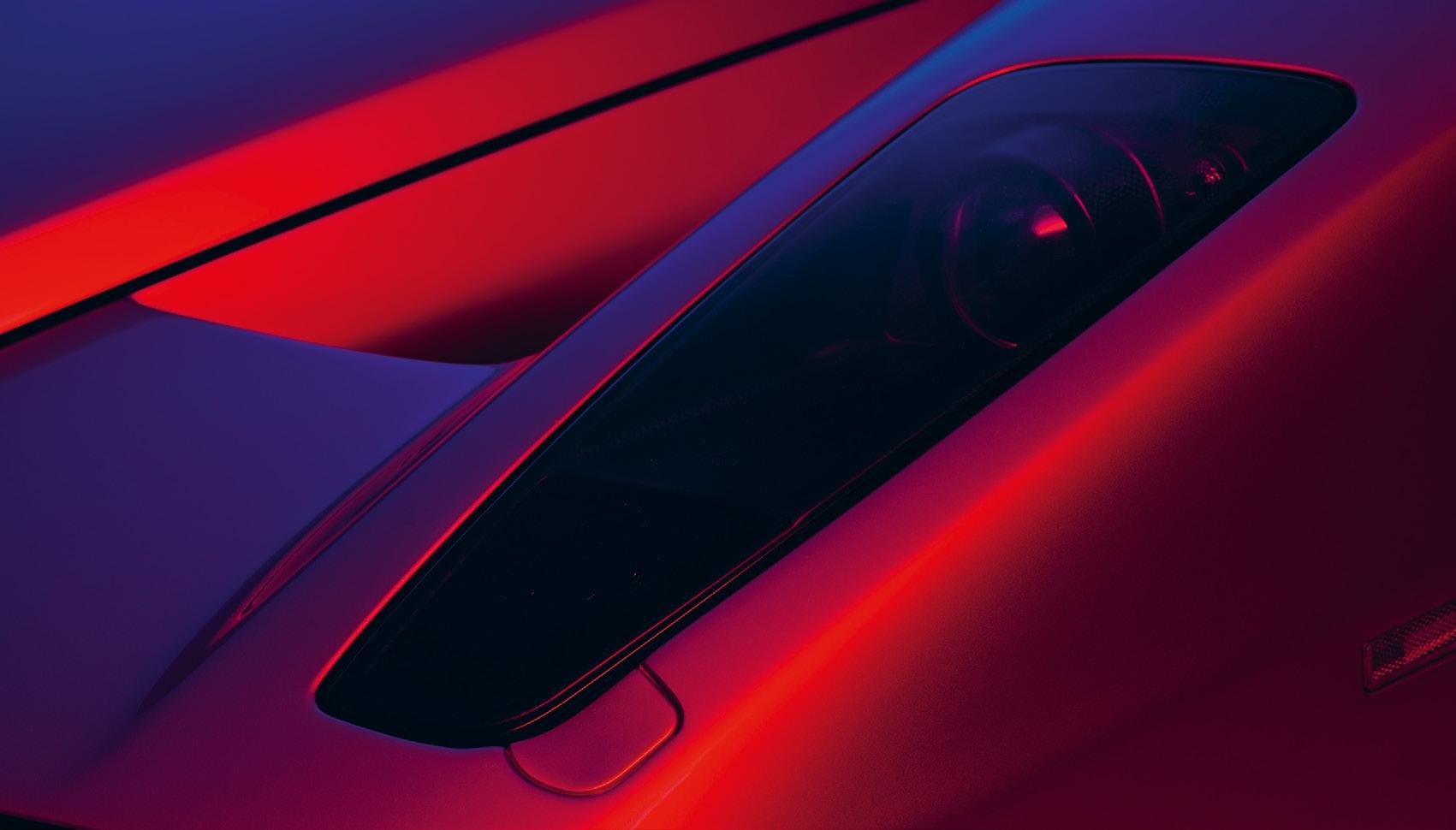 Luxury Beyond Cars bicollection.ch
Luxury Beyond Cars bicollection.ch

I NFO@PALACE.CH PALACE.CH Winter Season: 20th December 2022 - 12th March 2023 IT’S NOT A FAIRY TALE. IT’S REAL.

























































































 Chassis # SALLDVA586A719299
Chassis # SALLDVA586A719299











 Chassis # SAJJHALD4AJ600716
Chassis # SAJJHALD4AJ600716



















































 Chassis # FV357163
Chassis # FV357163




























































 Chassis # WPOZZZ99ZGS189687
Chassis # WPOZZZ99ZGS189687
























 Chassis # DBSV8/10124/RC
Chassis # DBSV8/10124/RC



























































































 Chassis # SCBZB25E01CX63561
Chassis # SCBZB25E01CX63561






























































































 Chassis # BC74LBY
Chassis # BC74LBY


























 Chassis # UD1S23085
Chassis # UD1S23085





























 Chassis # WACZZZ8CZRZ000131
Chassis # WACZZZ8CZRZ000131










 Chassis # SCFDL01S9ETL13354
Chassis # SCFDL01S9ETL13354










































 Luxury Beyond Cars bicollection.ch
Luxury Beyond Cars bicollection.ch
